Through his two-year SOURCE fellowship, Jaggena will work with both Professor Aaron Mohammed and Professor Todorova to study mercury contamination in waterways.
Studying Mercury Contamination in Waterways: Charan Jaggena ’28
Syracuse University’s Institute for Sustainability Engagement Awarded $600,000+ in USDA Grants to Expand Rural Initiatives in Waste Management and Water Infrastructure
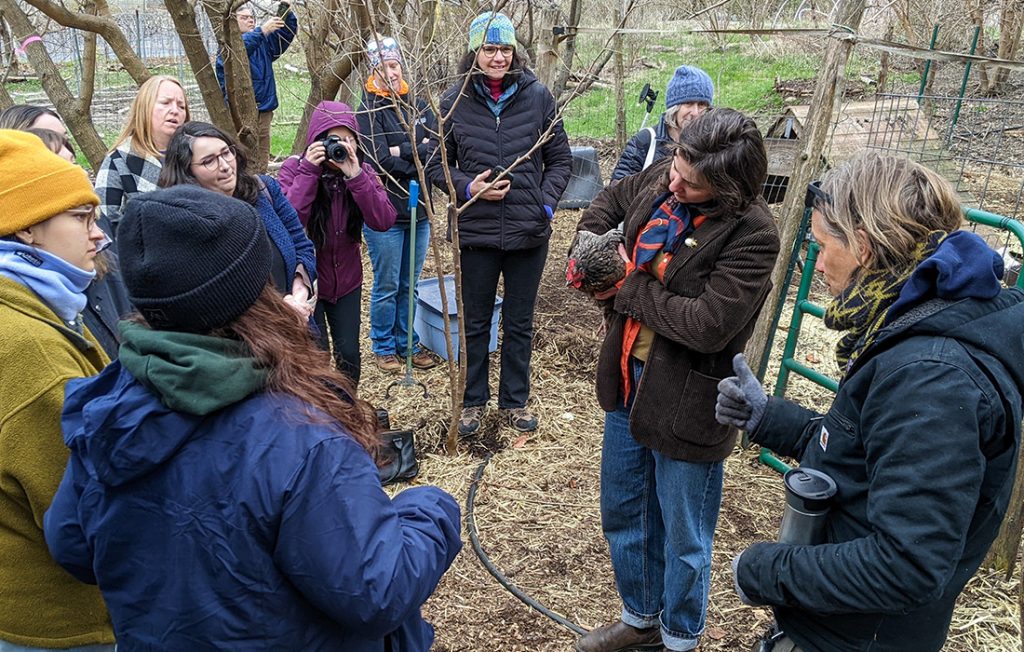
The Institute for Sustainability Engagement (ISE) at Syracuse University is pleased to announce it has been awarded over $600,000 in funding through two separate grants from the U.S. Department of Agriculture (USDA) for FY 2025. The grants— Technical Assistance and Training (TAT) Grant and Solid Waste Management (SWM) Grant—will support rural communities in New York State (NYS) and Puerto Rico (PR) with the resources and expertise needed to expand access to clean water and sustainable materials management.
Ensuring the success of these sectors is crucial to protecting public health and rural livelihoods. Many rural communities are on the frontlines of today’s most pressing sustainability challenges—from a rapidly retiring workforce, aging infrastructure, and increasingly frequent storms and weather emergencies. Waste combustion and landfilling are the primary methods to manage solid waste in both NYS and PR, despite the fact that within the next two decades, both regions will deplete the remaining capacity of their active landfills, according to state and jurisdiction data.
ISE’s Environmental Finance Center (EFC), which has served as a pillar of the institution for over three decades, continues to play a historic and foundational role in ISE’s partnership with the USDA and other supporting entities.
Alvin Montana II, Chief Operator at Herkimer County Sewer Authority, has partnered with the institute for over two years, and this partnership will continue through the TAT grant. Located along the southern edge of NY’s Adirondack Park, Herkimer County protects critical water resources that are vital to the region’s tourism, recreation, and agricultural sectors.
“ISE’s Environmental Finance Center has been a critical partner in advancing our capital planning—from refining priorities to helping us take projects out to engineering. Their support has helped us turn long-term water infrastructure goals into the development of shovel-ready solutions for Herkimer County,” Montana said.
ISE Director Melissa Young stated, “We are honored to receive support from the USDA to continue this important work.” She continued, “Rural areas serve as the backbone of agriculture, adventure, our water supplies, and our continued connection to nature, and it’s crucial they receive the support they need to thrive.”
All projects will kick off in October 2025.
About the USDA Grants
Solid Waste Management (SWM) – $434,000
The SWM Grant will help rural communities in NYS and PR address challenges related to solid waste, promoting innovative solutions for waste reduction, reuse, recycling, and more.
Through the SWM grant, ISE is committed to diverting a total of at least 10 tons of
materials from the waste stream through a variety of strategies and initiatives, most
notably; ISE’s long-running Sustainable Materials Management (SMM) Stewardship
Programs (in NY and PR) and its Recycle Right NY campaign; a community SMM collection
hub to address illegal dumping; a compost use event to improve soil health; and an
assortment of workshops, webinars, facility tours, and summits.
“To help shift away from waste combustion and landfilling, ISE is working to improve
recycling systems, establish reuse and repair initiatives, develop composting programs,
and more,” shared ISE Assistant Director Jesse Kerns. “All of which will cycle valuable
resources back into rural communities.”
Technical Assistance and Training (TAT) Grant – $172,000
The TAT Grant will help rural communities in NYS, PR, and eight Native Nations build
resiliency, secure funding, and navigate the complexities of providing safe, clean water.
ISE’s EFC will continue to lead the way to answer the difficult “how-to-pay” component of
environmental protection and improvement, while also facilitating training opportunities
on infrastructure financing, operations, and planning; university-student applied learning
opportunities with local governments and partners; and distribution of bilingual resources.
Partnerships
These awards also represent ISE’s deep-rooted commitment to community engagement through strong partnerships across disciplines.
Committed partners assisting ISE in executing USDA funded projects for FY 2025 include:
New York State Association for Reduction, Reuse, and Recycling (NYSAR3)
New York State Department of Environmental Conservation (NYDEC)
The New York State Water Resources Institute at Cornell University
The Center for Sustainable Materials Management (CSMM) at SUNY ESF
Puerto Rico Composta
Basura Cero Puerto Rico
Sierra Club de Puerto Rico
Feria Calle
About the Institute for Sustainability Engagement (ISE)
The Institute for Sustainability Engagement (ISE), formerly known as the Center for
Sustainable Community Solutions, is housed at the Syracuse University College of
Engineering and Computer Science, and works with communities to support their
sustainability and climate adaptation in areas of sustainable materials management
and water infrastructure. ISE engages with community members at all levels,
providing coordination and expertise in communications, policy, and science to help
them make informed decisions that foster economic well-being, environmental
stewardship, and social equity. The Syracuse University Environmental Finance
Center (EFC) is a pillar in this mission that facilitates the development of
sustainable and resilient communities throughout US EPA Region 2 (New Jersey,
New York, Puerto Rico, the US Virgin Islands, and eight Native Nations) and
nationally.
Civil and Environmental Engineering Professor Yizhi Liu Receives Foundational Research in Robotics Award from National Science Foundation
Yizhi Liu, Assistant Professor in the Department of Civil and Environmental Engineering (CEE), has been awarded a grant from the National Science Foundation (NSF) to design an AI-enabled robot that can conduct safe, efficient roof inspections.
Syracuse University Libraries’ Special Collections Research Center Awards Civil and Environmental Engineering Professor Svetoslava Todorova as the 2026-27 Faculty Fellow
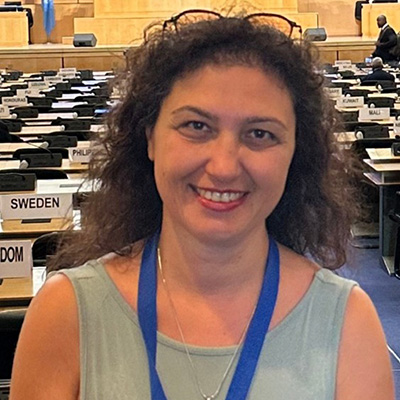
Syracuse University Libraries’ Special Collections Research Center (SCRC) recently chose its Faculty Fellow for the 2026-27 academic year. Svetoslava Todorova, professor of Civil & Environmental Engineering and director of the Environmental Engineering Program, was selected by a committee of librarians, curators and educators. Todorova will participate in a 2026 summer residency at SCRC that includes workshops on handling special collections materials, teaching students how to research within and across collections, and designing hands-on, creative and critically-minded inquiry with rare materials, to apply what she learned and the materials from SCRC to teach her courses the following year. Jana Rosinski, SCRC Instruction and Education Librarian, is looking forward to this unique opportunity to engage students in the civil and environmental engineering program with special collections and archives. Rosinski explains, “The ability to understand the historical frameworks that have affected where humanity finds itself currently—socially, culturally, politically and ecologically— is an essential way of thinking to create conscious change for the future.”
Todorova will rework two Science, Technology, Engineering and Math (STEM) courses to integrate SCRC archival materials about Onondaga Lake to create a dynamic interdisciplinary learning experience that connects technical content with historical, societal and ethical dimensions. Todorova describes how her two courses will apply historical material to their contemporary scientific practice, “In Environmental Chemistry and Analysis (CEE 471/671), a traditional laboratory exercise on alkalinity in the Onondaga Lake watershed will be transformed into a project-based learning module. Students will engage with archival materials from two former SU Faculty members in the Department of Civil and Environmental Engineering who played an important role in initiating the cleanup of Onondaga Lake. By analyzing historical documents and extracting environmental data from these documents, students will examine the legacy of industrial pollution and connect early efforts to current water quality challenges. In The Role of Science in Environmental Governance (HNR 360), students will examine rare books and archival materials related to mercury contamination in Minamata Bay, Japan.” Todorova’s goal is “to help students develop deeper critical thinking and draw parallels in global environmental crises and local contamination issues in Onondaga Lake, which will enhance their understanding of environmental governance, public health, and scientific responsibility.”
Syracuse University Libraries’ SCRC Faculty Fellows Program aims to support innovative curriculum development and foster new ideas about how to transform the role of special collections in University instruction. Each fellow is awarded $5,000 along with guidance on how to provide students with a unique opportunity to research, analyze and interpret SCRC’s primary source materials in their class, and pedagogical support.
George Bain G’06, a member of the Library Associates, and William F. Gaske ’72, a member of the Libraries Advisory Board, provided generous gift funding towards the SCRC Faculty Fellows Program. Original funding for the program was made possible through the Gladys Krieble Delmas Foundation, which promotes the advancement and perpetuation of humanistic inquiry and artistic creativity by encouraging excellence in scholarship and in the performing arts, and by supporting research libraries and other institutions that transmit our cultural heritage.
To learn more about the Faculty Fellows Program or teaching with SCRC, contact Jana Rosinski at jrosinsk@syr.edu. For more information about how to financially support a Faculty Fellow for the upcoming academic year and beyond, contact Dean David Seaman at 315.443.5533 or via email dseaman@syr.edu.
Civil and Environmental Engineering Professor Baris Salman Receives National Academies of Sciences, Engineering, and Medicine Grants
Salman and his research team have received two grants from the National Academies of Sciences, Engineering, and Medicine. These grants will allow them to help the state Departments of Transportation (DOTs) improve how highways, bridges, and other infrastructure are built and managed. The team will focus on identifying best practices as well as developing new approaches to contribute to the field of civil engineering and better meet state DOTs’ specific needs.
Professor Shobha Bhatia and Professor Shikha Nangia Awarded NSF Grant to Study Biopolymer-Mineral Interactions
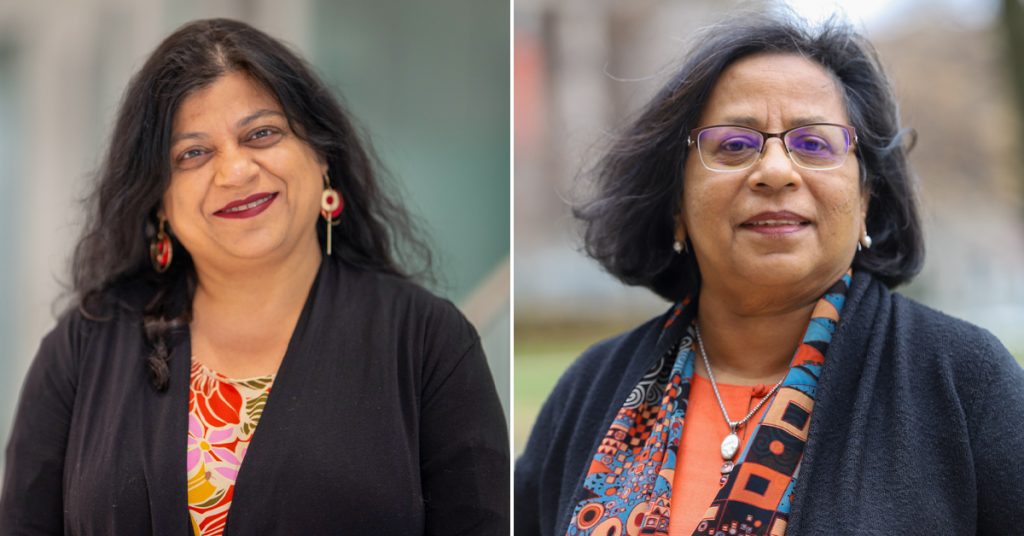
Civil and Environmental Engineering Professor Shobha Bhatia and Biomedical and Chemical Engineering Department Chair Shikha Nangia have been awarded a new collaborative National Science Foundation (NSF) research grant to study biopolymer–mineral interactions through a complementary blend of experimental and computational approaches. Biopolymers are polymers produced by living organisms, which are naturally occurring, biodegradable, and environmentally benign materials.
This interdisciplinary project, totaling $750,000 over three years, is being conducted in collaboration with University of Tennessee Civil and Environmental Engineering Professor Angel Palomino. Together, the research team aims to advance environmentally responsible alternatives to synthetic polymers currently used in geotechnical construction and mining.
To understand how biopolymers function, the team will integrate laboratory experiments with molecular-level computer simulations. Their goal is to identify which biopolymers perform best under varied environmental conditions—such as changes in acidity or salt levels—commonly encountered in mining operations.
Beyond research, the project will provide students with hands-on learning opportunities and support the development of new classroom materials. The long-term aim is to foster safer, more sustainable solutions for construction and mining—while training the next generation of scientists and engineers to lead this transition.
“Driven by recent mine tailings failures, we are pursuing innovative solutions, and I am eager to work with my collaborators on a cutting-edge experimental–molecular modeling approach,” said Bhatia.
“This is about designing smarter materials that are better for the planet—and it starts with understanding how they work from the molecule up,” added Nangia.
Environmental Engineering
The environmental engineering minor allows students to learn about the scientific, engineering, and social foundations of the field. It prepares them to incorporate sustainable best practices and apply responsible management of natural resources into their future careers. Students enrolled in this program have the option to focus on one specific discipline or explore several areas of environmental engineering.
Admission Requirements
The Environmental Engineering minor is available to all University students who have the necessary prerequisites to take the courses accepted for the minor and have a cumulative GPA of 2.50 or above. To be admitted to the program, students must submit a Declaration of Minor form signed by their academic advisor, the environmental engineering minor coordinator, and the academic dean of their home school/college.
Humanitarian Engineering
The Humanitarian Engineering minor program offers students an enriching educational journey dedicated to enhancing the human condition and supporting underserved communities both locally and globally. Through a blend of engineering fundamentals and social consciousness, students are equipped with the tools and mindset to tackle complex global and community challenges. From designing sustainable infrastructure to implementing innovative solutions for healthcare access, students engage in hands-on projects with community and institutional partners to develop innovative systems that directly impact the lives of underserved populations. By emphasizing collaboration, cultural sensitivity, reflection, and ethical considerations, graduates emerge ready to address pressing humanitarian needs while promoting sustainable development and social equity. With a focus on holistic problem-solving and community engagement, this program prepares students to make a tangible and lasting difference in the world.
One-on-One with Environmental Engineering Alum Ananya Chandra ’24

Ananya Chandra’s academic journey demonstrates her commitment to engineering that makes a lasting impact (Chandra uses both she/they pronouns). In the summer of 2023, they interned at Haley & Aldrich, an engineering and environmental consulting firm, where she visited local communities to promote cleanups, conducted soil tests, and used environmental justice mapping tools. She also connected with leaders to support innovative cleanup designs.
Chandra attended the Minamata Convention on Mercury in Geneva, Switzerland, as part of a class trip, where she gained insights into international climate negotiations and the role of academia in building consensus for global thresholds.
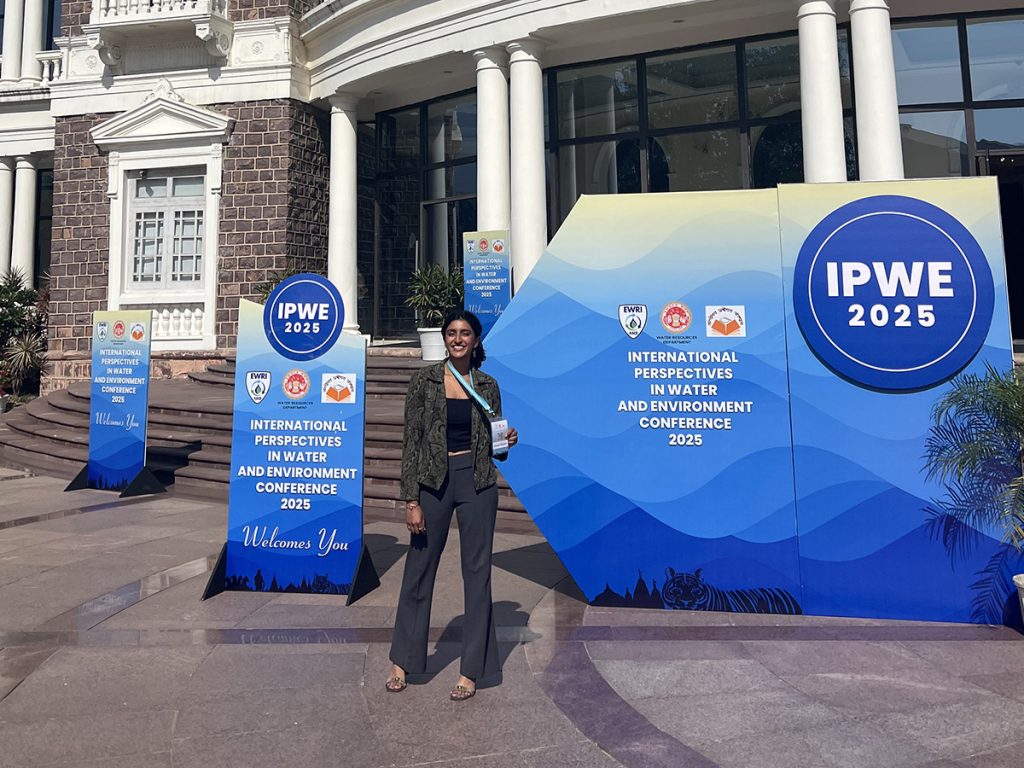
They have also worked with the US Forest Service, the Climate Hazards Research Team at SU, and FEMA (the Federal Emergency Management Agency). She was a member of the American Society of Civil Engineers (ASCE), an alum of Young Voices of Science, and has authored articles for the American Indian Foundation (AIF) on environmental livelihoods and sustainable water infrastructure.
Chandra has also been recognized for her strong academics and has held leadership roles across Syracuse University. Currently, she is a BIF Fellow at the Nehru Foundation for Development, VIKSAT in Ahmedabad, Gujarat, where she researches and documents climate-smart agriculture practices in dry areas in India and other countries. Her work has culminated in a climate-smart agriculture manual pending publication. In this one-on-one interview, Chandra discusses her research interests, experience in the environmental engineering program, and her career path.
Tell us about yourself!
I was a dual major at Syracuse University, so I was enrolled in the College of Engineering and Computer Science and the Maxwell School of Citizenship and Public Affairs. I studied environmental engineering and environment, sustainability, and policy, and I’m a very social science-oriented STEM person. I was also in the honors program, and my thesis was in geography. I love art, trying new recipes, and spending time outside.
What sparked your interest in coming to Syracuse University?
I was a Coronat Scholar! It was an incredible opportunity I couldn’t give up. It’s four years of tuition, funded research and study abroad, and Syracuse was a place that was big enough for me to explore options.
What do you enjoy about environmental engineering?
I love how you can tangibly see the impact of your work. As a hands-on person, that means a lot to me. I was a research assistant with professors Chris Johnson and Liz Carter. One thing I’m thankful for at Syracuse University is its diverse array of experiences and resources. Just by showing interest and speaking to people, a conversation often led me to an exciting opportunity.
What are your research interests?
My research focus presently is climate-smart agriculture, an approach to making farming sustainable and resilient in the face of climate change. I’m also interested in water infrastructure and the policy side of engineering. I took Professor Svetla Todorova’s course titled “Role of Science in Environmental Governance” and attended the COP-5 of the Minamata Convention on Mercury as an academic ambassador.
Broadly, I’m passionate about water systems and making them accessible to all, as well as improving water infrastructure. As engineers, a lot of our work is humanity-facing infrastructure, which inherently impacts marginalized communities, so I’m interested in how we can do better.
What was your experience in the environmental engineering program like?
Professors go the extra mile to give experiential learning. We used local data in research and in our environmental chemistry lab, such as samples from Onondaga Creek. I switched into engineering after my freshman year, only after understanding at Syracuse University how diverse the field is.
Where do you see yourself in the future?
I would enjoy being at the intersection of policy and engineering. I like engineering roles where I can integrate the social impacts of our work, and I’m really enjoying doing things locally in my current role. I see myself continuing this and working in a place that allows me to engage with communities regularly. In the future, I want to work specifically in urban climate resilience, equipping cities with the infrastructure to withstand the impacts of climate change.
Also, doing high-level engineering while interweaving social impacts in my work. I’m really interested in the participatory processes, how we can work with communities to design projects, and how it can function for their needs.
Do you have any advice for students?
I would tell students to approach networking with curiosity about what opportunities could look like and what the landscape of their field will look like in the future. Even if it’s a conversation that results in you realizing you don’t want to do something, it can be useful. I think you can learn the most from people and their experiences!
Fabrizio Sabba
Degrees:
Ph.D., Civil and Environmental Engineering – University of Notre Dame, 2017
M.Sc., Environmental and Industrial Biotechnology – Sapienza University of Rome, Italy, 2010
B.Sc., Biotechnology for Processes and Products Innovation – University of Bari, Italy, 2007.
Areas of Expertise:
- Sustainable biological wastewater treatment
- Resource and energy recovery from waste
- Microbial nitrogen and phosphorus cycling
- Biofilms and biofilm reactors
- Mathematical modeling of bioprocesses
Our group focuses on advancing sustainable biological wastewater treatment by integrating microbial ecology, process engineering, and systems modeling. We investigate microbial nitrogen and phosphorus cycling, with an emphasis on enhancing nutrient removal performance and stability. One area of interest is biofilms and biofilm reactors, which offer opportunities for treatment intensification and selective enrichment of functional microbial communities. We develop and apply mathematical models to connect microbial population dynamics with reactor performance, enabling predictive and data-informed decision-making. Our research also explores strategies for energy and resource recovery from waste streams, helping for the development of a circular and climate-resilient water infrastructure. By bridging fundamental microbial insights with applied engineering solutions, our group aims to design and optimize next-generation treatment systems that are efficient, robust, and environmentally responsible. Through close collaboration with utilities, industry, and academic partners, we seek to accelerate the translation of research into impactful solutions for water sustainability.
Honors and Awards:
AEESP Distinguished Service Award, 2024
40 under 40 Award – American Academy of Environmental Engineers and Scientists, 2022
Postdoc Professional Development Award, 2019
Best presentation at WWTmod Conference, Annecy (France), 2016
Selected Publications:
Downing, L., Farmer, M., Bhattarai, B., Penn, M., Kozak, J., Grabowy, J., Sabba, F. (2025), Making waves: Rethinking our mission for N2O emissions at WRRFs, Water Research X, 28:100320 | DOI: 10.1016/j.wroa.2025.100320
Sabba, F., Kassar, C., Zeng, T., Mallick, S., Downing, L., McNamara, P. (2025), PFAS in landfill leachate: Practical considerations for treatment and characterization, Journal of Hazardous Material, 481:136685| 10.1016/j.jhazmat.2024.136685
Sabba, F., Farmer, M., Dunlap, P., Qin, C., Barnard, J., Wells, G., Downing, L. (2025), Unlocking the potential of sidestream EBPR: exploring the coexistence of PAO, GAO and DGAO for effective phosphorus and nitrogen removal, Water Science & Technology, 91:5, 469-481 | DOI: 10.2166/wst.2025.038
Cecconi, F., Pifer, L., Sabba, F., Downing, L. (2024), Improving carbon management through maximizing hydrolysis and fermentation at water resource recovery facilities, accepted in Frontiers in Environmental Engineering, 3:1378621 | DOI: 10.3389/fenve.2024.1378621
Sabba, F., Redmond, E., Ruff, C., Ramirez, M., Campbell, P., Young, M., Downing, L. (2024), Exploring community and kinetic shifts in nitrifying microbial communities in low dissolved oxygen activated sludge facilities for energy-efficient biological nitrogen removal, ES&T Water, DOI: 10.1021/acsestwater.3c00715
Farmer, M., Sabba, F., Jia, Z., Dunlap, P., Barnard, J., Qin, D., Straka, L., Kozak, J. A., Downing L., Wells, G. (2023), Confronting assumptions of phosphorus-accumulating organisms and glycogen-accumulating organisms: peaceful coexistence in a carbon-limited sidestream EBPR demonstration, ES&T Water, 3:8, 2384–2394 | DOI: 10.1021/acsestwater.3c00083
Sabba, F., Farmer, M., Jia, Z., Di Capua, F., Dunlap, P., Barnard, J., Dongqi Qin, C., Kozak, J. A., Wells, G., Downing, L. (2023), Impact of operational strategies on a sidestream enhanced biological phosphorus removal (S2EBPR) reactor in a carbon limited wastewater plant, Science of The Total Environment, 857:159280 | DOI: 10.1016/j.scitotenv.2022.159280
Sabba, F., Farmer, M., Barnard, J., Dunlap, P., Marroquin, S., Giefer, R., Budsberg, D., Downing, L. (2022), Enhancing resource recovery via cranberry syrup waste at the Wisconsin Rapids WRRF: an experimental and modeling study, Journal of Environmental Management, 323:116190 | DOI: 10.1016/j.jenvman.2022.116190
Michael Ammoury
Degrees:
· Ph.D. in Civil Engineering (GPA: 4.0/4.0), Syracuse University, 2025
· Certificate of Advanced Study in Public Infrastructure Management and Leadership (GPA: 4.0/4.0), Syracuse University, 2021
· Certificate of Advanced Study in Public Administration (GPA: 4.0/4.0), Syracuse University, 2021
· M.S. in Civil and Environmental Engineering (Graduated with Distinction), Lebanese American University, 2017
· B.E. in Civil Engineering, Lebanese American University, 2010
Areas of Expertise:
Construction Engineering and Management
Infrastructure Asset Management
Sustainable and Resilient Infrastructure Systems
Digital Transformation
Dr. Ammoury specializes in sustainable and resilient infrastructure systems. His expertise centers on developing data-driven frameworks and decision-support tools that support technology adoption, digital transformation, and performance-based planning in public infrastructure. His research on advancing airport sustainability and resilience was nationally recognized through the prestigious Airport Cooperative Research Program Graduate Research Award. He has contributed to applied research projects in collaboration with academia, industry, and public agencies, including the New York State Department of Transportation, Federal Aviation Administration, and Central New York Regional Transportation Authority. His work spans a range of topics, including infrastructure digitalization, accelerated wastewater pipeline construction, transit ridership recovery, geospatial/NLP integration for asset management, BIM, amd agent-based modeling of bid selection methods,. He brings seven years of construction project management experience and taught civil engineering courses at the Lebanese American University. He interned with international organizations such as the UN, ICAO, and the engineering firm Mead & Hunt.
Honors and Awards:
· Graduate Student Speaker, ECS Convocation, Syracuse University, 2025
Selected by faculty and the Graduation Committee to deliver the graduate address in recognition of outstanding achievements, leadership, and service to the graduate community.
· Outstanding Graduate Student in Civil and Environmental Engineering, Syracuse University, 2025
Awarded annually to one doctoral student for excellence in research and contributions to the department. Recognized in the Convocation booklet and commemorated on a departmental plaque.
· Li Fellowship Award, Syracuse University, 2024–2025
Competitive fellowship awarded to one exceptional graduate student in the College of Engineering and Computer Science.
· Mambu Alphan Kawa Memorial Award, Syracuse University, 2023–2024
Presented annually for academic excellence and impactful contributions to the Civil and Environmental Engineering community.
· Graduate School Summer Fellowship, Syracuse University, 2023
University-wide competitive fellowship supporting outstanding Ph.D. research.
· Graduate Research Award, Airport Cooperative Research Program (ACRP), TRB, 2021–2022
Prestigious national award administered by the Transportation Research Board (TRB) and sponsored by the Federal Aviation Administration (FAA). Selected through a competitive process based on a submitted research proposal, the award supported applied research focused on advancing sustainability and resilience through technology adoption at airports. It included a $12,000 stipend and the opportunity to present findings to ACRP leadership and aviation industry professionals at the TRB annual meeting.
· Outstanding Teaching Assistant Award, Syracuse University, 2021
Conferred to the top 4% of TAs for exceptional teaching and mentorship across the university.
· Syracuse University Ph.D. Fellowship, Syracuse University, 2019–2022
Prestigious multi-year fellowship combining academic merit-based support with research and teaching assistantships.
Selected Publications:
Almalki, M., Salman, B., Salem, O., & Ammoury, M. (2025). A decision-support framework for accelerated wastewater pipeline construction: Integrating economic, social, environmental, and technical criteria. ASCE Journal of Construction and Engineering Management. [In press]
Ammoury, M. & Salman B. (2024). Advancing Sustainability and Resilience of Airports Through Deployment of New Technologies in the Aftermath of COVID-19 Pandemic. ASCE OPEN: Multidisciplinary Journal of Civil Engineering. 2(1). doi: 10.1061/AOMJAH.AOENG-002
Ammoury, M. & Salman B. (2023). Incorporating Emerging Technologies at U.S. Airports to Improve Sustainability and Resilience. Presented at the 102nd Transportation Research Board (TRB) Annual Meeting, National Academies of Sciences, Engineering, and Medicine, Washington, D.C.
Ammoury, M. & Salman, B. (2023). Sustainable Solutions and Practices Implemented at U.S. Airports in the West. Proc., ASCE The International Conference on Transportation and Development. Austin, TX. doi: 10.1061/9780784484883.001
Ammoury, M. & Salman, B. (2023). The Use of Advanced Solutions Towards COVID-19 Recovery at Airports in Eastern U.S.A. Proc., ASCE Construction Research Congress (CRC). Des Moines, Iowa. doi: 10.1061/9780784485279.049
Ammoury, M., Salman, B., Caicedo Bastidas, C. E., & Kumar, S. (2022). Impacts of COVID-19 on Bus Ridership and Recovery Trends in Syracuse, NY. ASCE Journal of Transportation Engineering, Part A: Systems, 149 (2), 05022009-1 – 05022009-14. doi: 10.1061/JTEPBS/TEENG-7498
Awwad, R., & Ammoury, M. (2019). Owner’s perspective on the evolution of bid prices under various price-driven bid selection methods. ASCE Journal of Computing in Civil Engineering, 33(2). doi: 10.1061/(ASCE)CP.1943-5487.0000803
Awwad, R., & Ammoury M. (2013). Surveying BIM in the Lebanese construction industry. Proc., IAARC 30th International Symposium on Automation and Robotics in Construction and Mining: Building the Future in Automation and Robotics (ISARC 2013), Montréal, Canada. doi: 10.22260/ISARC2013/0105
Professor Emeritus Shobha K. Bhatia Receives Robert M. Koerner Award from Geosynthetics Materials Association
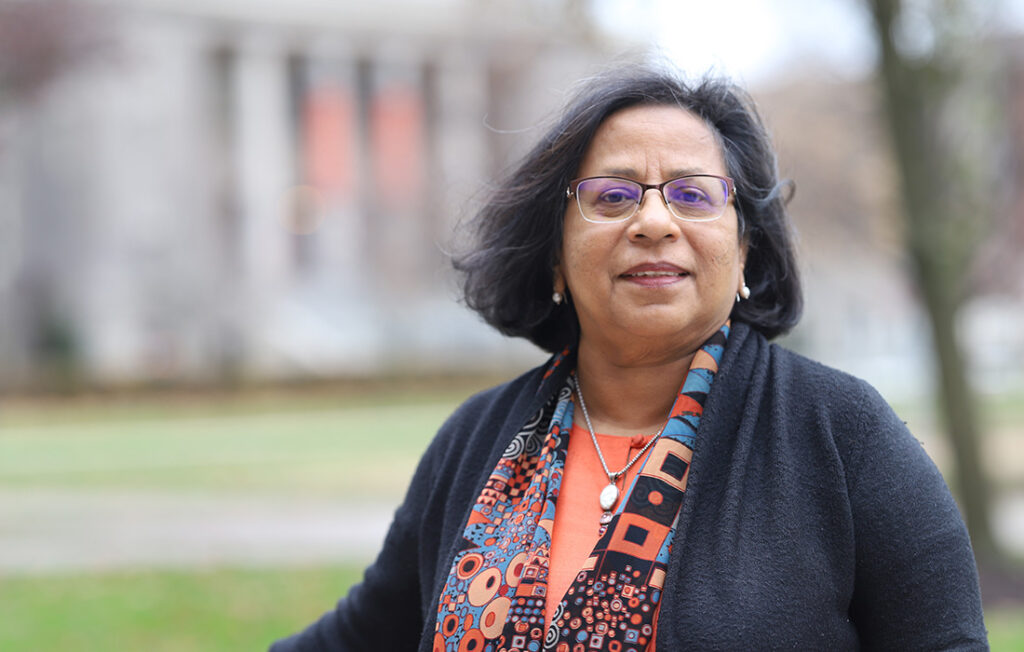
Professor Emeritus in Civil and Environmental Engineering (CEE) Shobha K. Bhatia was honored with the Robert M. Koerner Award from the Geosynthetics Materials Association (GMA). This prestigious award was established by the GMA in 2016 to honor renowned civil engineer Robert M. Koerner and recognizes individuals who have made a significant impact on the geosynthetics industry in North America.
As part of this recognition, Bhatia delivered a keynote lecture at the GMA and Geo-Institute’s co-located Geotechnical Frontiers Conference on March 4, 2025, in Louisville, Kentucky. More than 300 participants attended her lecture.
At the Geotechnical Frontiers Conference, Bhatia participated in a high-level Geosynthetics Industry Round Table focused on advancing the role of women in the geosynthetics industry. Joining six other accomplished women leaders from across the industry, she contributed to a discussion aimed at promoting progress through education, mentorship and professional networking opportunities.
Bhatia also presented two technical papers co-authored with her graduate students, Zeru B. Kiffle and Nuzhath Fatema, which showcased ongoing research and innovation in the field of geosynthetics and geotechnical engineering. She is scheduled to deliver keynote lectures at three other major conferences between 2025 and 2027, further extending the reach and impact of her work in the geosynthetics industry.
“Receiving the Koerner Lecture Award is evidence of the significant impact that Dr. Bhatia’s extensive and innovative research has had on the field of geotechnical engineering. It further reinforces the influence that Dr. Bhatia has had across all facets of her career and her meaningful contributions to improving the lives of others through her research and outreach,” says CEE Department Chair Andria Costello Staniec.
“It is one of the greatest honors of my career to receive the Koerner Lecture Award,” says Bhatia. “This award recognizes the research contributions made by my students and me, and the measurable impact of our work on the geosynthetics industry in North America.”
Pivotal Research on Aquatic Ecosystems

Stretching more than 5 million acres, the Adirondack Park is one of the largest protected areas in the United States. The region is home to over 3,000 lakes, diverse wildlife and habitats, making it an ideal location for research on different ecosystems. For the past two semesters, environmental engineering graduate student Amos Bungei has been conducting research in this unique environment, focusing on dissolved organic carbon and its effects on the Adirondack Lakes.
Dissolved organic carbon, also known as DOC, is organic matter, such as plants and soil, that is broken down and can be found in aquatic ecosystems. It plays a crucial role in the movement of carbon throughout the planet and is a main food source for aquatic animals. However, when the amount of DOC in a lake is high, it can impact the effects of solar radiation, increase the differing water temperatures within the lake, and decrease oxygen levels in the lake water. DOC can also increase the cost of the water treatment process since it impacts water quality.
Bungei’s research focuses on identifying the causes behind the increasing concentration of DOC in the lakes that have been observed in the Northeastern regions of the United States and Northern Europe. “We’ve been seeing a rise in concentration of dissolved organic carbon in the Adirondacks since 1982,” says Bungei. “My goal is to determine the drivers of this increase in dissolved organic carbon to support appropriate measures.”
To explore potential causes, Bungei has been running machine-learning models combining data from 48 lakes in the Adirondack region, watershed data from the U.S. Geological Survey, and other factors such as rain and temperature. He then assesses the results against the results for carbon quality, and he’s found that DOC primarily comes from wetlands.
“Lakes in watersheds that have huge proportions of wetlands tend to have higher concentrations of DOC,” he says. “Increases in dissolved organic carbon are primarily supported by a rise in pH, which has been observed across the Adirondack since the passing of the Clean Air Act of 1970. The Act led to the reduction of sulfur dioxide emissions, which contributed to acid rain. Over the years, the reduction in system acidity has facilitated easier mobilization of organic matter from land to the lakes, and that is why we are observing increases.”
Bungei attended the American Geophysical Union 2024 Conference, the largest annual Earth science conference in the world, where he presented his research, catching the attention of several attendees. He also connected with faculty, students, and professionals who share similar research interests, gaining insights into the latest developments in the field.
“It was a great experience,” he says. “You discuss your results, you gain new insights and get interesting takes on what you’re looking into.”
Bungei hopes to develop a machine learning model that can predict the patterns of organic carbon concentration in various lakes and regions across the globe. “This research will be crucial to the future of Earth science, and I look forward to contributing to these efforts.”
Civil and Environmental Engineering Professor Cliff Davidson Presents at Universal Peace Federation’s World Summit 2025
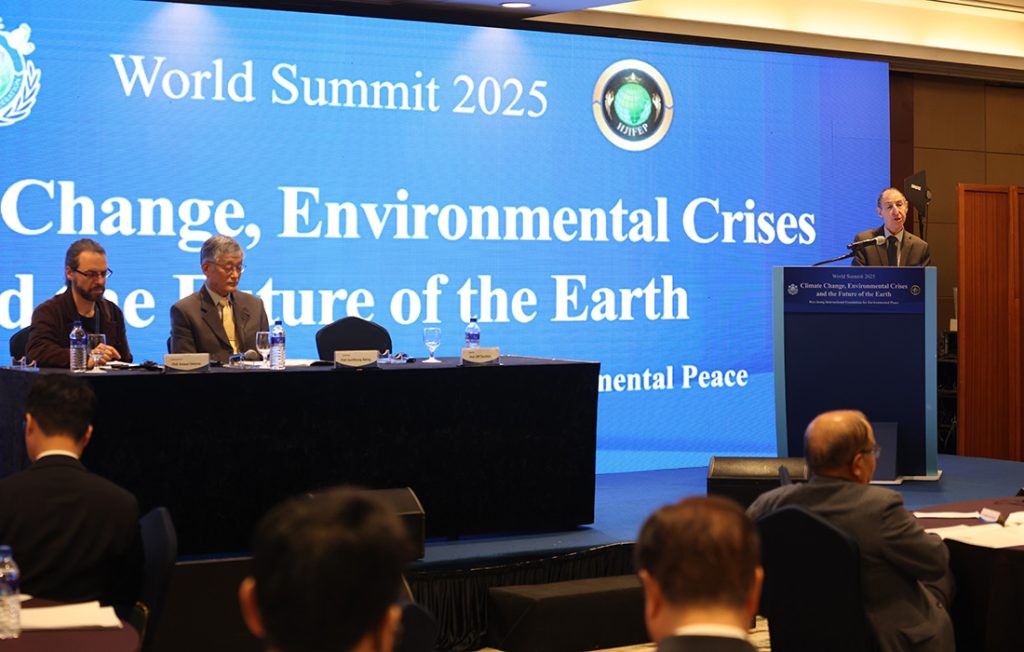
Civil and Environmental Engineering Professor Cliff Davidson was recognized by the Hyo Jeong International Foundation for Environmental Peace and Universal Peace Federation for his outstanding leadership, valuable contributions and investment in environmental engineering and education. Davidson was invited to speak at the Universal Peace Federation’s World Summit 2025.
The summit’s main theme was “Global Crisis Response and a Sustainable International Peace Alliance.” Davidson delivered a 20-minute presentation on the topic, “Advances in Science and Technology and the Demand for a New Worldview,” giving an overview of significant scientific and technological approaches that address environmental issues. The speech was followed by an open discussion.
The summit was held in Seoul, Korea, on April 10-14. Political and religious leaders, and experts from a variety of other fields from 117 nations were in attendance.
Civil and Environmental Engineering Student Teams Win First Place in the American Society of Civil Engineers (ASCE) Competition

Civil and environmental engineering student teams participated in the American Society of Civil Engineers (ASCE) Sustainable Solutions and Steel Bridge competitions during the 2025 Upstate New York-Canada Student Symposium, winning first place in the Sustainable Solutions competition. The symposium was held at the United States Military Academy in West Point, New York.
The ASCE Student Symposium challenges students to explore and implement sustainable solutions, allowing them to apply their skills and knowledge to real-world challenges. Competitions such as Sustainable Solutions encourage students to deepen their understanding of sustainability and learn how to integrate sustainable solutions into everyday engineering problems.
“We presented a redevelopment proposal focused on transforming a vacant office complex into a vibrant, sustainable, and affordable housing community. The design incorporated green roofs, passive solar design, greywater recycling, and community-oriented amenities such as a public garden, amphitheater and small local businesses,” says environmental engineering student Brooklyn Toller ’27.
The Steel Bridge competition challenges students to design and build a scale-model steel bridge. During the fall semester, students create a design based on specifications provided by the ASCE and draft plans for the construction of a 20-foot scale model. The goal is to minimize the bridge’s weight while ensuring it can support a load of 2,500 pounds.
The student team took first place for cost estimation, a category in the Steel Bridge competition, and came in 6th place overall.

“It was intriguing to look at the other teams’ designs and construction processes. Seeing new and different intricacies from the other schools really allowed me to start thinking about ways that our bridge could be improved, which will help us improve our bridge design and construction process for years to come,” says civil engineering student Evan Garcia ’28.
The ASCE Syracuse student chapter also participated in the Mead Paper competition, where students tackle complex issues about engineering ethics, allowing them to examine and communicate the purpose and responsibilities of a civil engineer.
“I was elected by my chapter to enter into the Daniel W. Mead Student Prize Paper Competition. This opportunity allowed me to practice both my written and oral communication skills. I am very proud of the work that I put forth and am a better public speaker because of it,” says civil engineering student Shannon O’Kane ’28.
The Sustainable Solutions team will participate in the ASCE’s national championships. The competition will be held June 27-29 at California Polytechnic State University, San Luis Obispo.

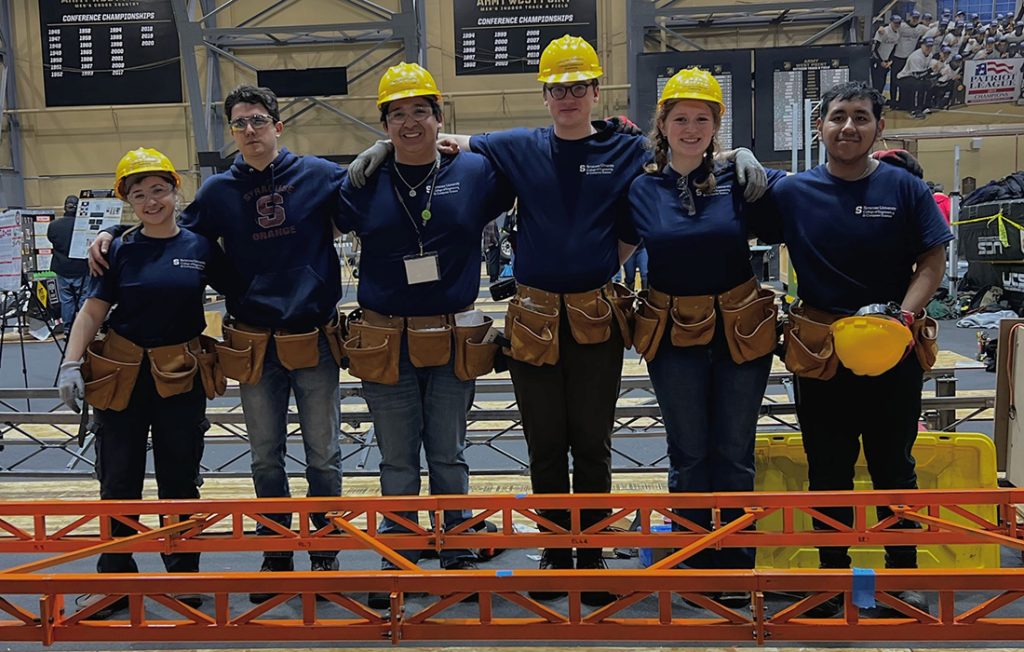
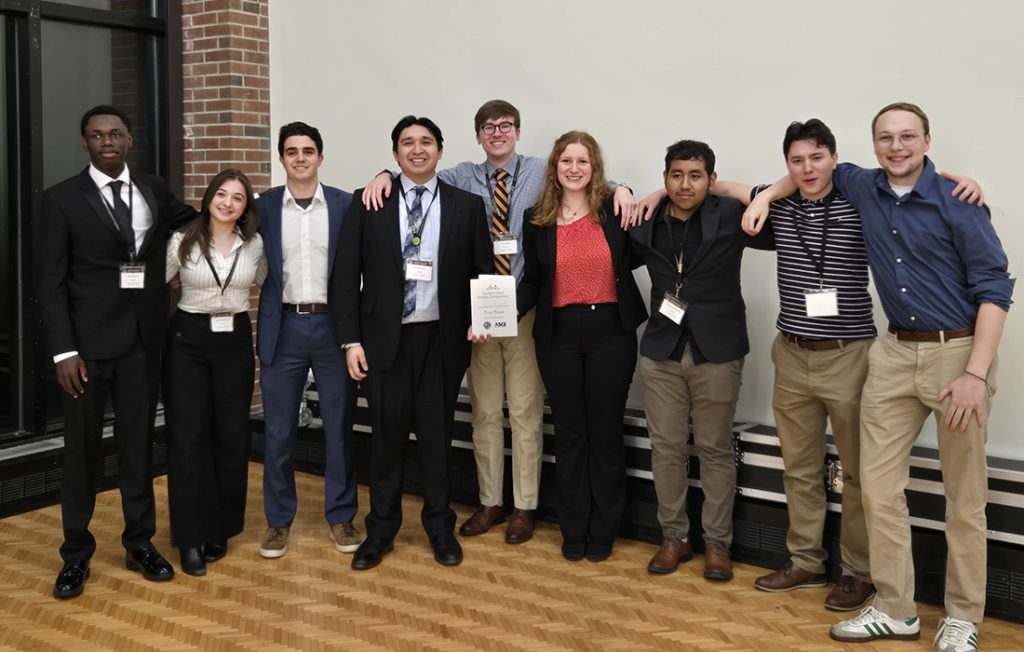
Exploring the Toughness of Bamboo Skin Through Artificial Intelligence
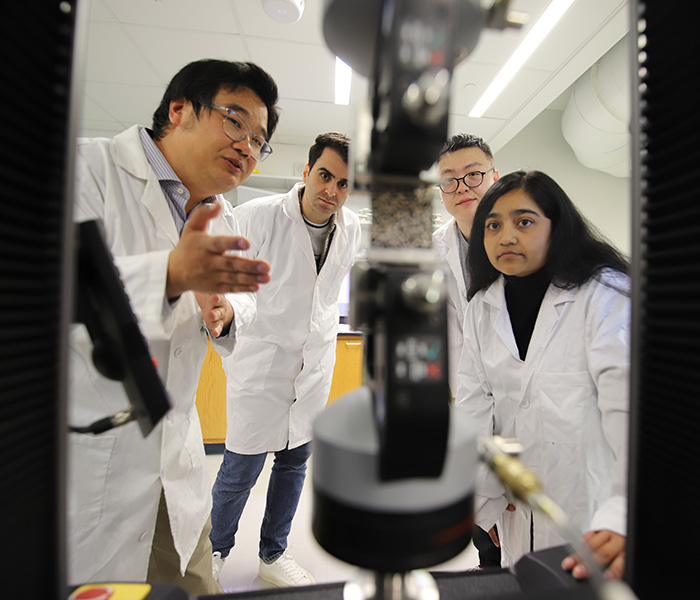
Bamboo is a fast-growing and renewable plant that has important environmental benefits. It grows in many different climates, captures carbon and its root system improves soil health while preventing soil erosion. Bamboo’s natural strength and flexibility have also made it a great alternative to timber and metals for buildings, scaffolding, and many other manufacturing uses.
Studies have shown that bamboo’s outer layer is actually stronger than its inner layers. Known as the epidermis, bamboo’s outer layer is smooth and dense, containing cellulose fiber and silica particles, which contribute to the plant’s functionality and durability. Silica particles in particular may strengthen and help plants like bamboo withstand environmental stresses.
For decades, researchers have been attempting to understand how the low amount of silica particles helps strengthen the outer layer of bamboo and prevent the inner fibers from splitting. To explore this concept, Zhao Qin, assistant professor in civil and environmental engineering, combined theoretical analysis, experimental imaging, generative artificial intelligence (AI) and 3D printing to study how the arrangement of silica particles affects bamboo.
“There are individual particles embedded in the matrix material of bamboo skin,” says Qin. “We realized in the microscopic images of bamboo skin, we see when there are cracks. These cracks will be captured by the silica particles because they are harder and stiffer than the matrix. So, the crack will not propagate straight through the bamboo, but instead, it gives you the zig-zag pathway to dissipate more energy.”
When studying the structure of bamboo skin, Qin found that it’s a composite material, meaning bamboo skin is made from two or more materials with different properties. This material includes soft cellulose fibers and rigid silica particles that are arranged differently in various directions. This arrangement makes the bamboo skin tougher and more durable.
“The silica particles are very ordered in the direction that is perpendicular to the bamboo fiber bundles, with dense areas located where the bundles meet,” says Qin. “Since fiber splitting is the main way bamboo fails under different stresses, such as buckling, bending, and twisting, the silica particles at the fiber junctions help increase the material’s toughness and prevent cracks from spreading. However, their distribution along the fiber is highly disordered.”
To understand how this arrangement affects the toughness of bamboo skin, Qin input his findings into generative AI and created a model based on the structure of bamboo skin. The AI model not only looks similar to actual bamboo skin but also breaks and withstands force in the same way. This research helps us understand the mechanics of bamboo skin better, discover ways to create materials similar to bamboo, or improve the strength of bamboo materials for sustainable development.
“Understanding how the bamboo epidermis works at the microscopic level can help us connect the beginning of mechanical cracks in bamboo with larger issues like buckling and splitting when under extreme pressure,” says Qin. “This understanding is essential for making bamboo products more durable. Additionally, insights gained from the bamboo epidermis can guide the design of composites by defining particle distribution in fiber-reinforced composites, which is important for sustainable construction and manufacturing techniques.”
Kun-Hao Yu
Institute Affiliation: BioInspired Institute
Areas of Expertise:
- Solid Mechanics
- Polymers
- Engineered Living Materials
- Sustainable Infrastructure Materials
- Advanced Manufacturing and 3D Printing
Dr. Yu’s research focuses on the development of sustainable engineered living materials, integrating living cells with synthetic materials to create functional materials with properties such as self-healing, self-growing, and dynamic environmental responsiveness. His research sits at the intersection of Solid Mechanics, Materials Science, Biology, and Advanced Manufacturing, with a focus on designing next-generation materials for infrastructure applications. His work aims to tackle critical global challenges in civil and environmental engineering, such as reducing greenhouse gas emissions, improving clean water access, advancing renewable energy solutions, and enhancing the resilience of structural materials. Through innovative material design, advanced manufacturing techniques (e.g., 3D printing), and fundamental mechanics studies, Dr. Yu seeks to develop materials that mimic biological functions while enabling greater control and manipulation of engineered living materials, ultimately contributing to a more sustainable built environment.
Honors and Awards:
- SES Future Faculty Symposium (FFS) travel award
- NAMRC/MSEC NSF Student Support Award
- EMI-MIMB student paper competition Award
- USC CEE Outstanding Research Assistant Award
Selected Publications:
Ketian Li, Kunhao Yu, Yanchu Zhang, Haixu Du, Constantinos Sioutas, Qiming Wang, Unveiling the mechanism secret of abrasion emissions of particulate matter and microplastics, Scientific Reports, 14, no. 1 : 23710, 2024.
So Hee Nah, Yunchan Lee, Kun‐Hao Yu, Yinding Chi, Hyemin Lee, Baohong Chen, Mohit Patel, Kunyu Wang, Shu Yang, Moisture Absorbing and Water Self-Releasing from Hybrid Hydrogel Desiccants, Advanced Functional Materials, 2313881, 2023
Kunhao Yu, Zhangzhengrong Feng, Haixu Du, Kyung Hoon Lee, Ketian Li, Yanchu Zhang, Sami F. Masri, Qiming Wang, Constructive adaptation of 3D-printable polymers in response to typically destructive aquatic environments, PNAS Nexus, 2022, Vol. 1, No. 3.
Kunhao Yu, Zhangzhengrong Feng, Haixu Du, Qiming Wang, Mechanics of Photosynthesis Assisted Polymer Strengthening, Journal of the Mechanics and Physics of Solids, 151, 104382, 2021.
Kunhao Yu, Zhangzhengrong Feng, Haixu Du, An Xin, Kyung Hoon Lee, Ketian Li, Yipin Su, Qiming Wang, Nicholas X Fang, Chiara Daraio, Photosynthesis Assisted Remodeling of Three-Dimensional Printed Structures, Proceedings of the National Academy of Sciences, 118 (3), 2021.
Kunhao Yu, Haixu Du, An Xin, Kyung Hoon Lee, Zhangzhengrong Feng, Sami F. Masri, Yong Chen, Guoliang Huang, Qiming Wang, Healable, Memorizable, and Transformable Lattice Structures Made of Stiff Polymers, NPG Asia Materials, 12, 26, 2020.
An Xin, Kunhao Yu, Runrun Zhang, Bingyuan Ruan, Allyson L. McGaughey, Zhangzhengrong Feng, Kyung Hoon Lee, Yong Chen, Amy E. Childress, Qiming Wang, Bone-Inspired Healing of 3D-Printed Porous Ceramics, Materials Horizons, 2020.
Kunhao Yu, An Xin, Zhangzhengrong Feng, Kyung Hoon Lee, Qiming Wang, Mechanics of Self-Healing Thermoplastic Elastomers, Journal of the Mechanics and Physics of Solids, 137, 103831, 2020.
Kunhao Yu, An Xin, Haixu Du, Ying Li, Qiming Wang, Additive Manufacturing of Self-Healing Elastomers, NPG Asia Materials, 11, 7, 2019.
Kunhao Yu, An Xin, Qiming Wang, Mechanics of Light-Activated Self-Healing Polymer Networks, Journal of the Mechanics and Physics of Solids, 124, 643-662, 2019.
Kunhao Yu, An Xin, Qiming Wang, Mechanics of self-healing polymer networks crosslinked by dynamic bonds, Journal of the Mechanics and Physics of Solids, 121, 409-431, 2018.
Kunhao Yu, Di Wang, Qiming Wang, Tough and Self-Healable Nanocomposite Hydrogels for Repeatable Water Treatment, Polymers, 10, 880, 2018.
Kunhao Yu, Nicholas X. Fang, Guoliang Huang, Qiming Wang, Magnetoactive Acoustic Metamaterials, Advanced Materials, 1706348, 2018.
Staying Ahead of the Game

Liesel Odden ’24 G ’25 knows all too well the challenges of being a student-athlete. One minute she’s in the research labs of Link Hall, the next minute, she’s boarding a bus for an away game in a different state. As the co-captain of Syracuse University’s women’s soccer team and a student in the College of Engineering and Computer Science (ECS), Odden juggles these responsibilities much like she juggles soccer balls on the field.
“One of the hardest parts about being a student-athlete is traveling. In the fall semester, over the course of 9 days, I was in Texas, Virginia and Florida,” says Odden. “But I’ve learned a lot more about time management since being in college.”
Playing soccer for as long as she can remember, Odden was thrilled to learn that Syracuse University’s team was in the Atlantic Coast Conference (ACC), widely recognized as the top conference for women’s soccer. And the chance to play her favorite sport while pursuing her research interests was appealing.
“My coaches made this place feel like home, and treated me like family,” she says. “I also saw Syracuse had environmental engineering and that, along with research opportunities, was exciting.”
Odden is enrolled in the 4+1 accelerated program for environmental engineering, a combined degree where students complete both their bachelor’s and master’s at the same time in five years, though she will complete both degrees early. She credits Civil and Environmental Engineering Professor Cliff Davidson with helping her discover this accelerated program and though the courseload is rigorous, it’s also been helpful. Online lectures make catching up on work much easier, especially when she’s on the road.
As a research assistant, Odden collaborates with Professor Davidson to analyze survey data on how different organizations respond to extreme weather events caused by climate change. Using information gathered from survey data, they’re attempting to find patterns between locations, organizations and strategies to respond to extreme weather events.
“With climate change, we’re going to be seeing a lot more flooding, droughts, heat waves and other extreme weather events so we need to have better ability to respond. I think that we can be prepared and respond better if we know how different people and organizations strategize.”
Displaying leadership qualities both on and off the field, Odden has traveled to Mixco, Guatemala for several summers, leading volunteer teams for Hogars Helping Hands, a non-profit organization founded by her parents. The non-profit focuses on supporting orphaned children and the local community, with volunteer groups building stoves, installing concrete floors, and painting village homes among other tasks.
With the help of professors Elizabeth Carter and John Trimmer, Odden also aims to establish a student chapter of Engineers Without Borders at Syracuse University. The organization develops sustainable engineering solutions for underprivileged communities.
“One of the biggest things I’ve learned from Dr. Carter and Dr. Trimmer is engineering in low-resource settings. We spent time looking into socioeconomic inequities in Dr. Carter’s class which I’ve really enjoyed and got even more passionate about.”
As Odden continues balancing her life as a student-athlete, she relies on her strong support system to achieve her goals and stay ahead of the game.
“I’ve always felt very encouraged by Dr. Davidson. He’s been an incredible mentor to me and I feel like I’ve learned a lot from him. Dr Trimmer and Dr. Carter have also both been super supportive of me as a student-athlete,” says Odden. “In ECS, I have felt very supported and love how much I’ve grown as a student and my passions have been fueled and cared for. After I’m done playing soccer, I’ll have a great environmental engineering background that I can have a career in.”
Syracuse University Research Highlights Puerto Rico’s Grassroots Climate Response Efforts
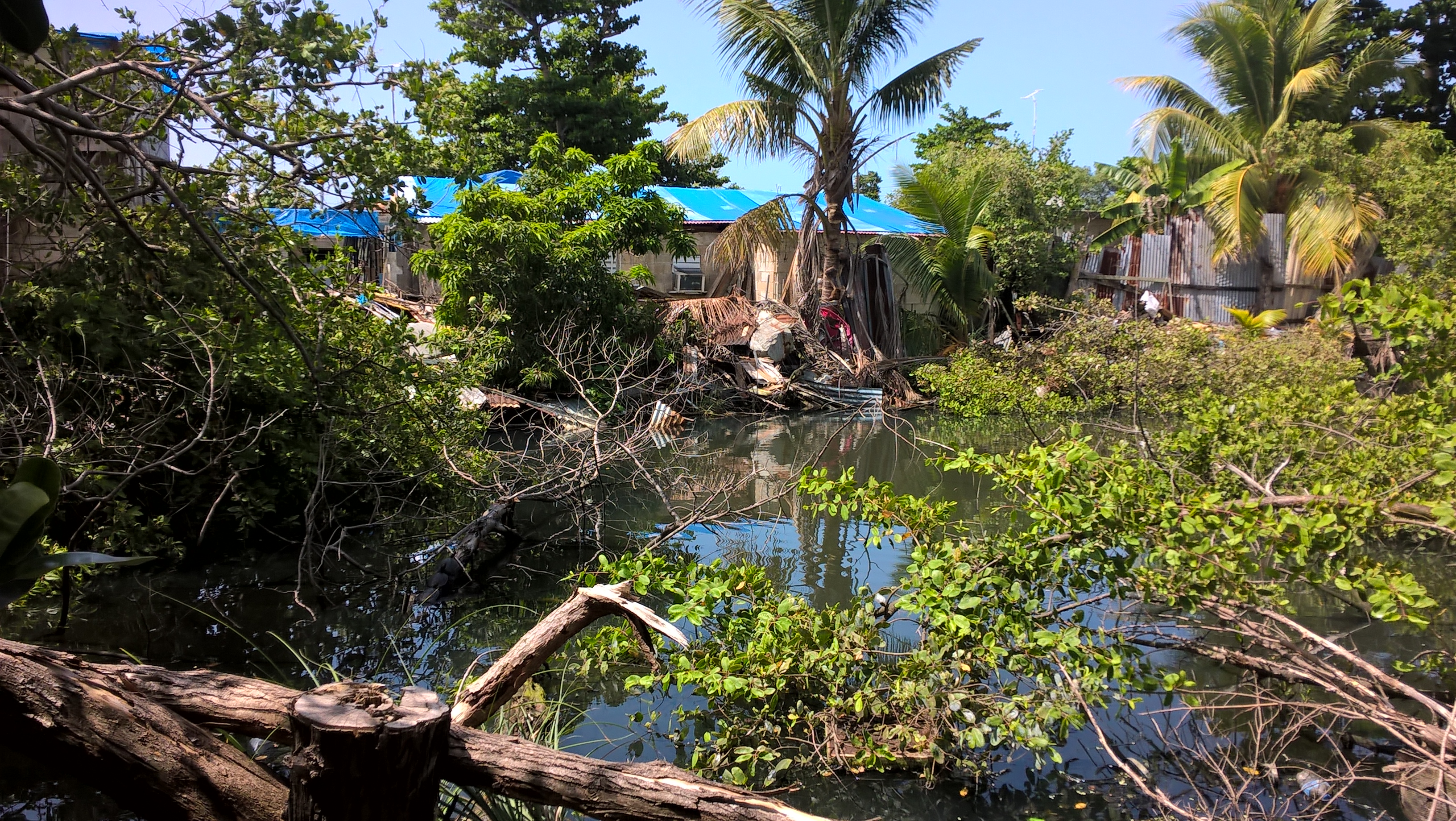
The diverse landscape of Puerto Rico — which encompasses coastal lowlands, mountain ranges, and a tropical rainforest — necessitates an equally if not more diverse range of tools and community action to support its residents and ecosystems living in harmony. Amid hurricanes, landslides, and other weather-related crises magnified by climate change, understanding Puerto Rico’s vulnerabilities and ability to adapt to evolving climate risks is essential to its long-term prosperity. The Institute for Sustainability Engagement (ISE) continues to support the Caribbean Island’s mission to achieve greater climate resiliency through the center’s recent research project funded by the National Oceanic and Atmospheric Administration’s Climate Program Office (NOAA CPO).
The ISE’s NOAA CPO Adaptation Sciences (AdSci) program FY23 competition project, “Beyond first response: investigating how Puerto Rico’s community-based organizations drive local climate action”, will support Caribbean climate adaptation by co-producing new research on Community-Based Organizations (CBOs), which are an important and understudied pillar of Puerto Rico’s climate-response system. By the end of this $300,000 two-year research project, ISE will advance the dialogue on the role CBOs play in climate adaptation efforts in island communities, contributing to the larger discussion about how policymakers can engage and integrate CBOs into a larger climate adaptation strategy.
CBOs have stepped up as Puerto Rico’s first line of defense against an increasing bombardment of environmental stressors due to a rising global climate. Through their hyper-local leadership, mediation, and implementation, these groups of largely informal, volunteer, not-for-profit civilian teams have established themselves as a vital and trusted resource in the face of climate emergencies, compared to the suboptimal role played by state and federal authorities. Most recently, CBOs were a critical part of a faster and more effective recovery response after Puerto Rico’s Hurricane Maria and Hurricane Ernesto.
“Receiving minimal support in the face of steadily worsening challenges, Puerto Rico is often referred to as an ‘underserved’ population, but this idea does not capture the whole picture,” explained Kaira Fuentes, ISE’s CoPI for the AdSci project. “As an island territory, Puerto Rico’s climate-related risks are exacerbated by a 120-year-long colonial legacy. Those who engage in CBOs are self-determined and proud to serve in their neighborhoods, and their peers trust them to step up where their governments have not. As these groups are critical to driving local action, understanding their function, impact, and opportunities to organize can only strengthen their ability to succeed.”
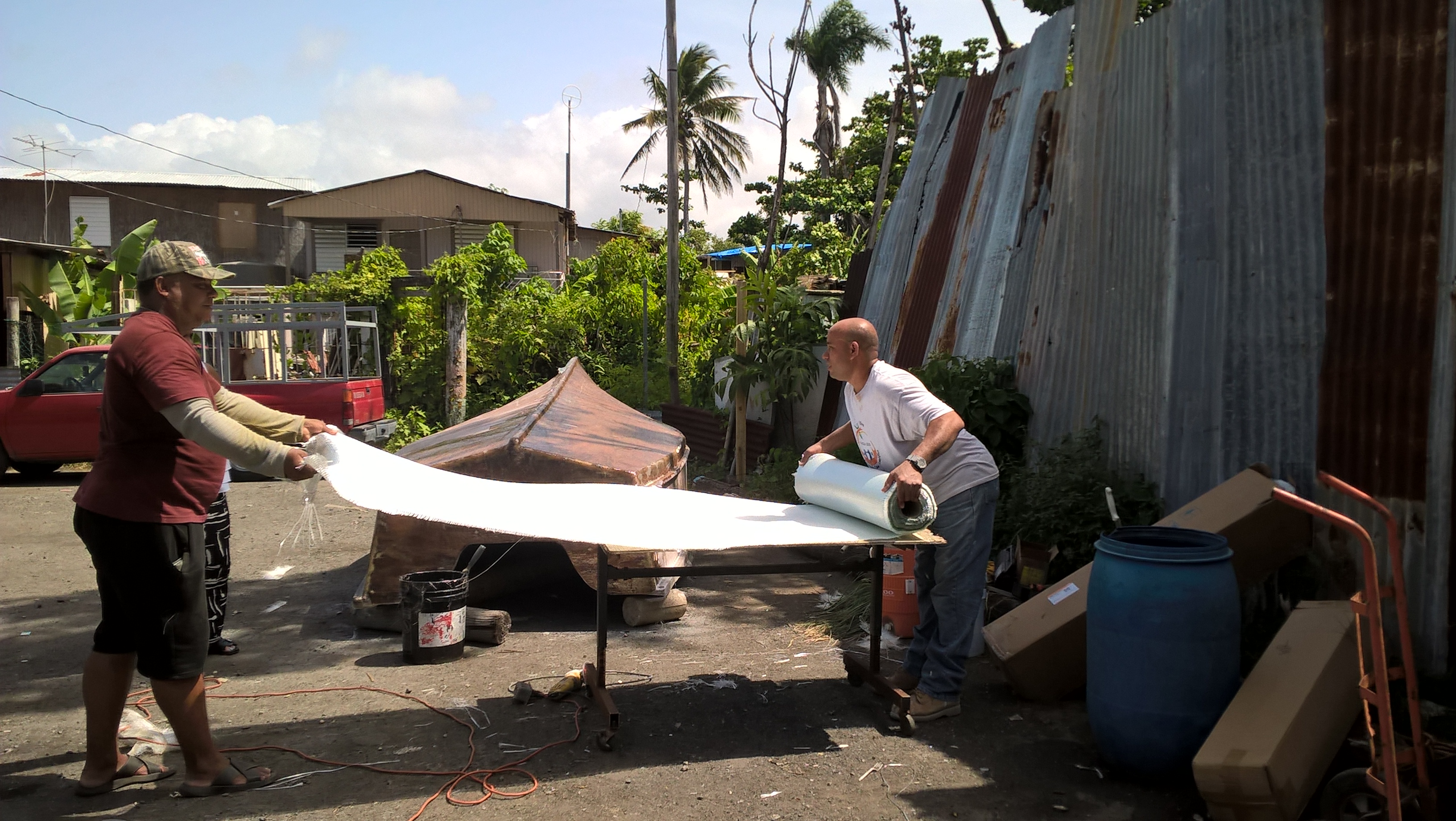
While Puerto Rican CBOs have become experts in emergency response, the ways in which they facilitate “climate adaptation” (creating a means to deal with future stressors) outside the disaster-response period is less clear. This project will provide new insights into the strategies, tools, barriers, and adaptive capacities of CBOs to drive local climate actions in Puerto Rico through the following interdisciplinary and participatory adaptation research methods:
- Exploratory case study development
- Establishment of a Community Advisory Committee
- Culminating regional presentations and a final report
In addition to identifying and describing how CBOs facilitate climate adaptation in Puerto Rico, this project aims to:
- Develop recommendations for policy-makers that define strategies and additional areas of study for drawing CBOs more centrally into climate adaptation efforts
- Develop a framework for integrating participatory research methods in climate adaptation inquiries
- Support knowledge exchange, amplify local stories and voices, and strengthen the Caribbean community of practice.
This research project is strengthened by the perspectives of its two Puerto Rican Co-Principal Investigators, Fuentes (ISE) and Professor Juan E. Marcano, University of Puerto Rico Humacao (UPRH), who have each contributed significant research on local perceptions of conservation in Puerto Rico and the role of community-based groups in disaster recovery. As institutions, ISE and UPRH provide a breadth of applied and community-based research experience that will strengthen the completion of this project.
The NOAA CPO AdSci program received 27 proposals in Fiscal Year 2023 (FY23), and of these 11 projects were selected for funding, totaling $3,140,372.00 in grants.
Institute for Sustainability Engagement (ISE) at Syracuse University
ISE is a nonprofit organization working at the intersection of sustainability communications, policy, and science to foster economic well-being, environmental stewardship, and social equity by engaging community members at all levels to provide the coordination and knowledge needed to make informed decisions that support sustainability, resiliency, and climate adaptation. The Syracuse University Environmental Finance Center (EFC), operated by ISE, is a pillar in this mission that facilitates the development of sustainable and resilient communities throughout US EPA Region 2 (New Jersey, New York, Puerto Rico, the US Virgin Islands, and eight Native Nations) and nationally.
“Managing Mass Timber: From Forest to Future” Exhibition Comes to Syracuse University
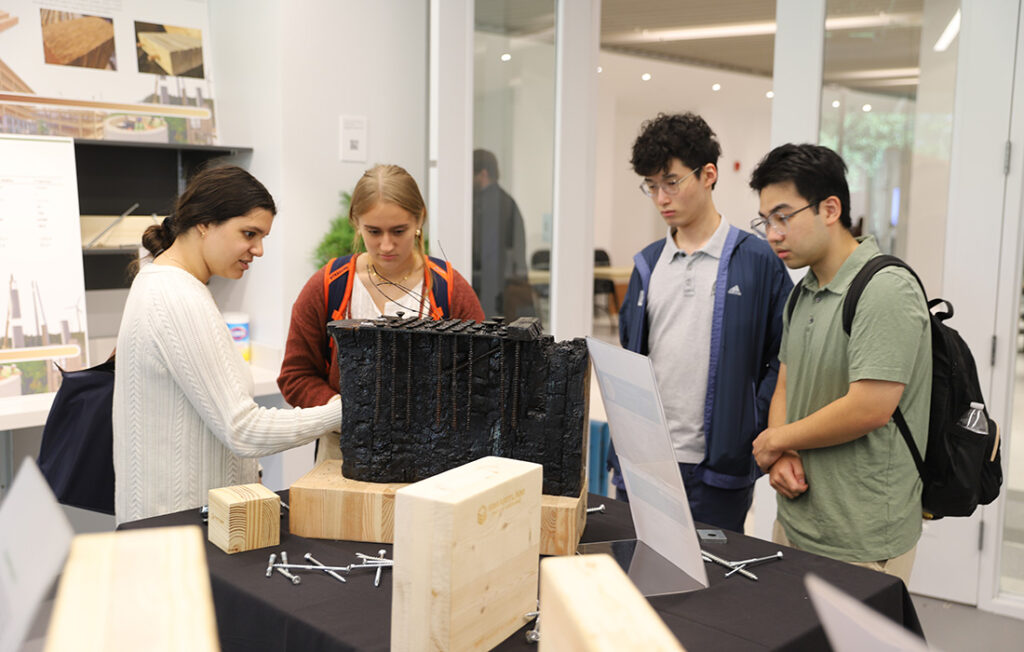
When it comes to sustainable construction materials, there’s no contest: mass timber buildings require less heavy equipment, save on labor costs, and take less time to install than concrete and steel. By utilizing mass timber, the construction industry can utilize green building practices without compromising efficiency.
That was the message of “Managing Mass Timber: From Forest to Future,” a lecture delivered by Dr. Anthony Mirando and Dr. Lameck Onsarigo of Kent State University. Presented on September 30 at the College of Engineering and Computer Science, the lecture was part of a national tour showcasing Dr. Mirando and Dr. Onsarigo’s research at Kent State University’s College of Architecture & Environmental Design.
Mass timber refers to a class of engineered wood products (EWPs) that are often used for wall, roof and floor construction. Because commercial-scale mass timber construction projects are on the rise across the United States, Professors Mirando and Onsarigo highlighted the importance of educating the next generation of professionals about these green building materials.
The lecture featured data from one of the tallest mass timber buildings in the United States: INTRO in Cleveland, Ohio. A mixed-use structure with 300 apartment units and ground-floor commercial space, the project was uniquely efficient because of the use of mass timber materials such as Glued-Laminated Timber (GLT) beams and columns, as well as Cross-Laminated Timber (CLT) slabs. The real estate developer reported that construction time was about 25 percent faster than typical concrete or steel construction.
“Managing Mass Timber: From Forest to Future” also included a weeklong exhibit in Link Hall where students could examine real-life examples of mass timber building materials, including dowel laminated timber, nail laminated timber, and connections and assemblies used in mid- and high-rise construction projects. The “Managing Mass Timber: From Forest to Future” national exhibit tour is funded by the Softwood Lumber Board (SLB) headquartered in Portland, Oregon. Dr. Andria Costello Staniec, Department Chair of Civil and Environmental Engineering, and Mr. Reed Kelterborn, Director of Education for SLB, delivered welcoming and opening remarks.
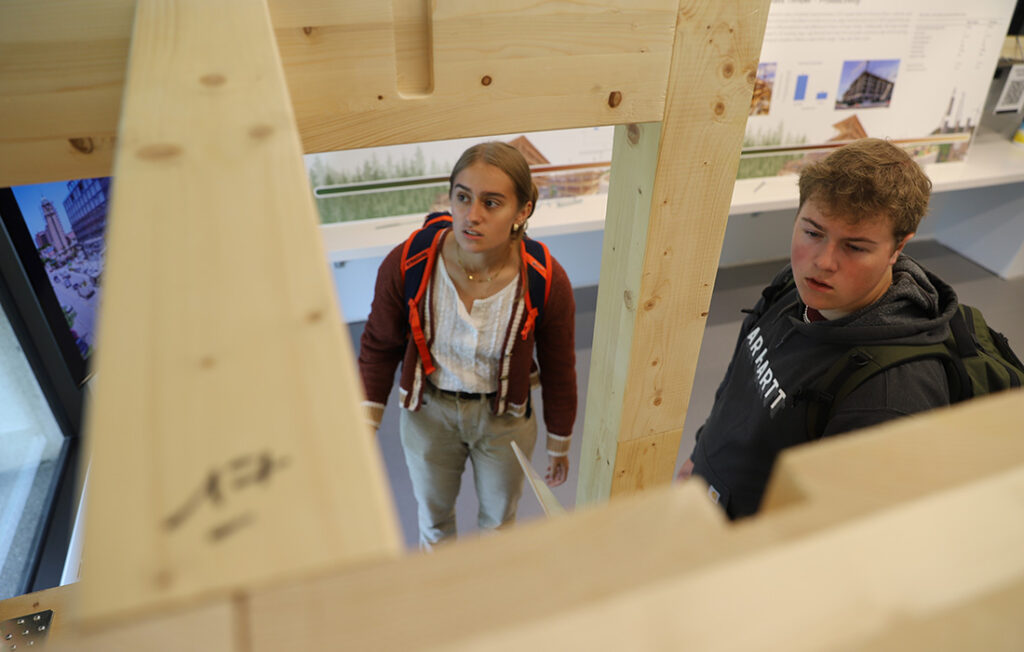
The visit from Kent State University faculty was organized by Yilei Shi, Associate Teaching Professor and Undergraduate Civil Engineering Program Director, and Cliff I. Davidson, Civil and Environmental Engineering Professor Emeritus. “We were thrilled to host Drs. Mirando and Onsarigo’s national touring exhibition on the construction management aspects of the mass timber building industry, and to highlight the benefits of mass timber as a sustainable construction material to the Engineering, Architecture, and Construction (EAC) community here in Central New York,” says Professor Shi. “Interest in mass timber buildings is rising rapidly throughout the country. Skilled labor and seasoned professionals are in great demand. This state-of-the-art exhibition and lecture can help bring our students up to speed and get them ready for the next generation’s EAC industry.”
“In addition, we are training students to design and build more sustainable and resilient infrastructure to approach the immense challenges of climate change and natural disasters,” Professor Davidson adds. “Mass timber can be one of the most effective construction materials to meet these challenges.”
Students in engineering, architecture and other disciplines who are interested in the topic of sustainable building materials may also want to register for the 2025 New York State Green Building Conference, which will be held in Syracuse this coming March.
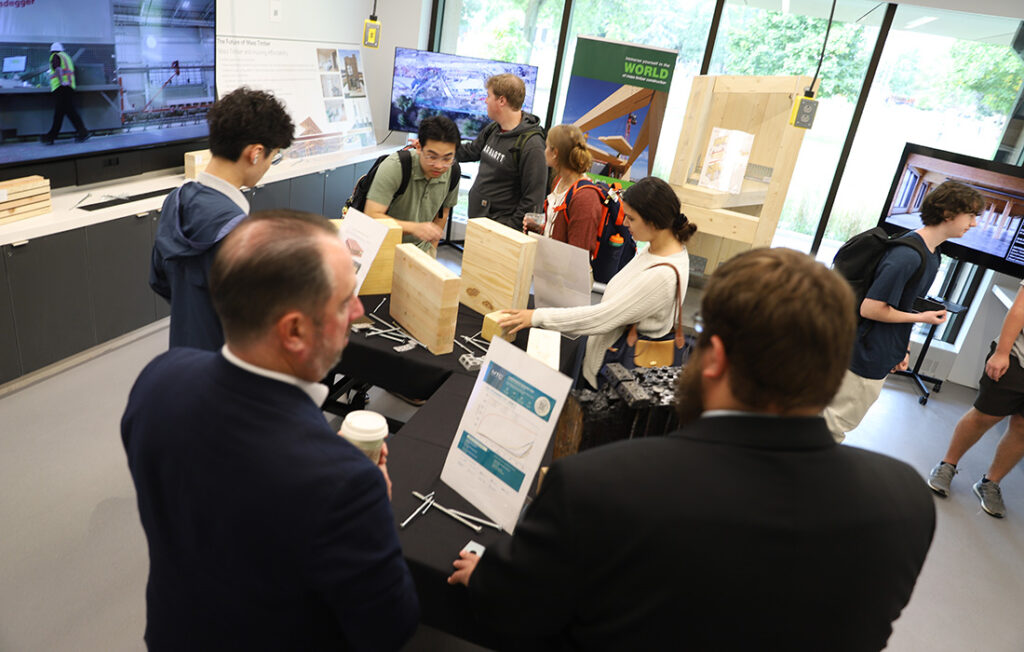
Flood Forecasting
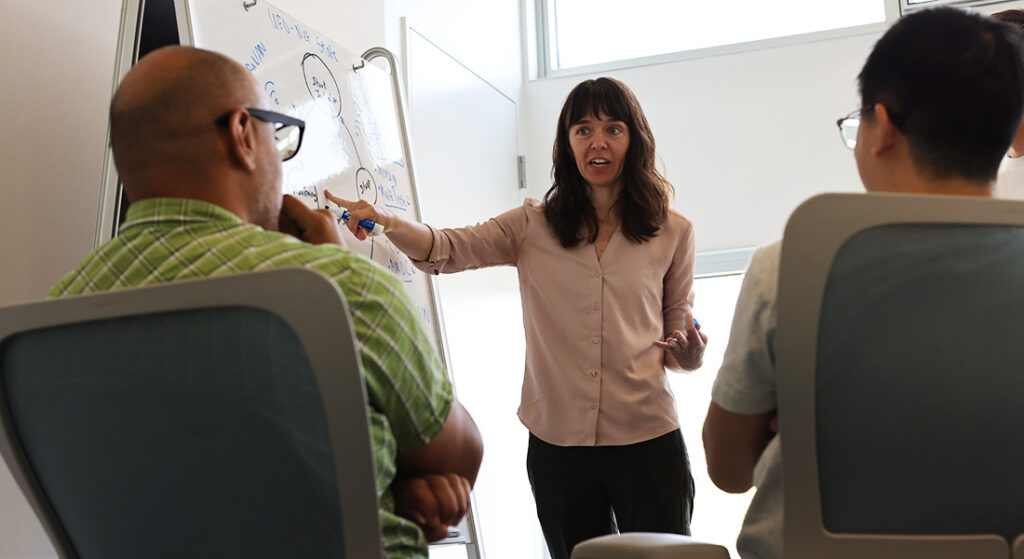
After Hurricane Katrina ravaged the southern coastline of the United States in 2005, Elizabeth Carter found herself on the Gulf Coast following the tropical storm’s aftermath. Witnessing the devastating impact of the hurricane on infrastructure and communities, she decided to place her undergraduate education on hold and join the efforts to rebuild – an experience that would be the catalyst for her future research.
“It was pivotal a time in U.S. history. It exposed a lot of the ways that structurally our publicly funded infrastructure is shunting risk down socioeconomic gradients,” Carter says. “As a young person figuring out what I wanted to do in the world, I didn’t think I could walk away from something like that and retain my humanity.”
Ignited with a passion for the environment, Carter returned to school and received her bachelor’s degree in soil science, a master’s in environmental information science and a Ph.D. in environmental engineering with a concentration in water resources. Now working as an assistant professor in civil and environmental engineering with a joint appointment as an assistant professor in earth and environmental sciences in the College of Arts and Sciences, Carter is a computational hydrologist who studies the movement of water from space. Using data from satellites, these observations of water movement allow her to develop ways to respond to natural disasters and manage water resources.
She and her research team at Syracuse University have received a water resource grant from the United States Geological Survey (USGS) to develop a sensor network that measures flooding. This sensor network will help predict different types of flooding caused by natural disasters, particularly flooding in areas where people live, which is referred to as urban flooding. This project is known as the Urban Flood Observing Network.
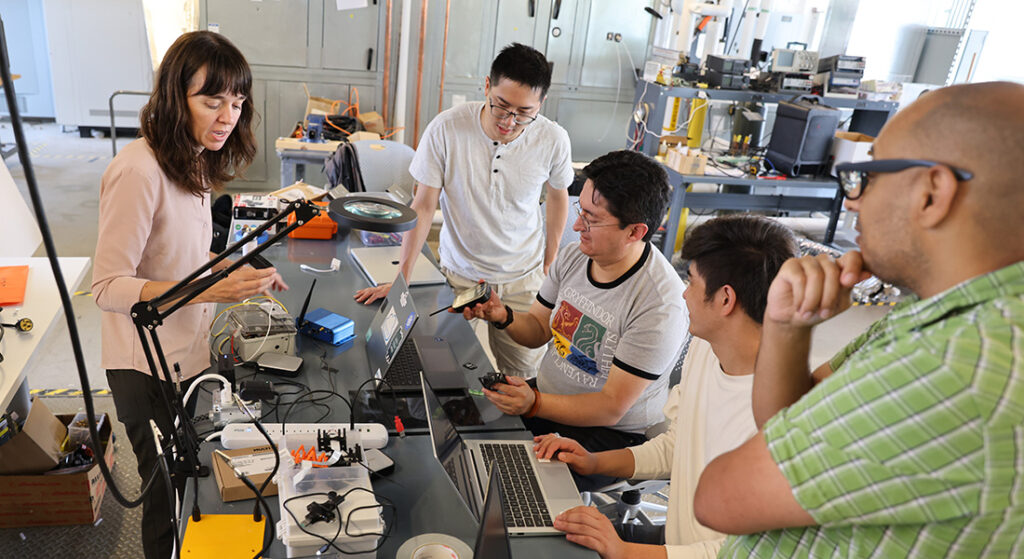
“We’re hoping to build a sensor network for better urban flood response and labels for satellite images so they can map urban flooding everywhere,” says Carter.
Fatemeh Rezaei G‘25 (environmental engineering), Huantao Ren G’21, Ph.D. ‘27 (computer science), Manu Shergill ‘24 (computer science) Nhy’ere Scanes, Ike Unobhaga, Kaitlyn Gilmore and Sharif Jafari are students from Syracuse University and Onondaga Community College (OCC) who have helped with the development of the Urban Flood Observing Network. Collaborators on the project include electrical engineering and computer science professor Senem Velipasalar and associate professor at the School of Information Studies, Carlos Caicedo.
“It’s been a great way to engage a lot of different students from different backgrounds and stages in their careers in hardware design, 3d printing, algorithm design, and photogrammetry,” says Carter.

Shergill is the primary developer leading the project and has been working on the sensor network since 2021. During a summer internship in his freshman year at OCC, he assembled the initial version of the water sensor camera. He’s also been working on adding higher-quality sensors, wireless communications, machine vision, and other features to the water sensor camera, hoping to install it on the roof of Syracuse’s Center of Excellence for testing.
“The next thing I’m tackling is a remote start function, so we can trigger continuous data collection when a storm is moving into the area the sensor is monitoring,” says Shergill.
Carter has hopes the USGS will install these sensor networks in different locations where quick responses to flood events are needed which can help manage future flood events.
“It’s been great to collaborate with different students on this project and make an impact on tackling natural disasters that are a result of climate change,” Carter says.
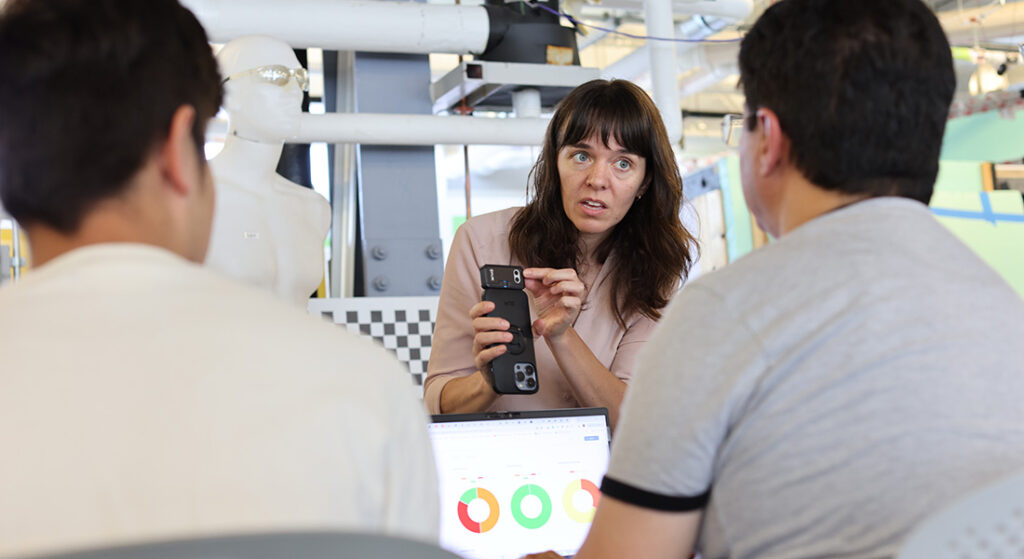
Engineering an Orange Legacy
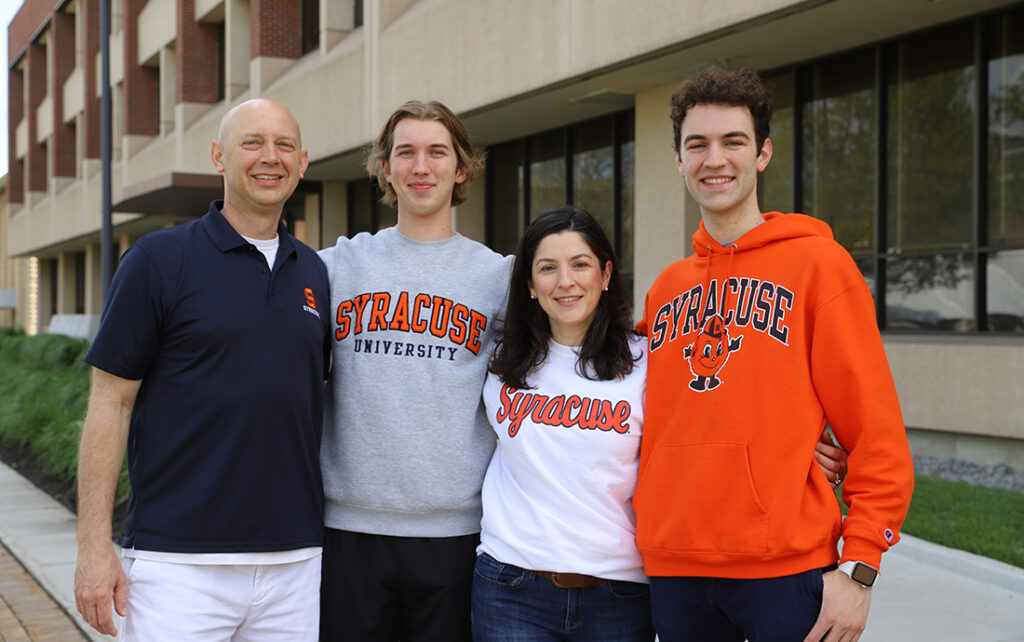
Andrew ‘25 and John ‘27 Vanderwege come from a family that bleeds Orange. Not only have several relatives attended Syracuse University, but their parents, Maureen ‘97 and Mike ‘96, are graduates of the College of Engineering and Computer Science. The University also happens to be the place where their parents would meet for the first time.
“We were floor mates the second half of my junior year at DellPlain Hall. Maureen and my roommate, who was also a sophomore engineering major at the time, knew each other,” their father, Mike recalls. “We only met at the end of the year. Our hometowns are only 20 minutes apart and we got to know each other that summer.”
Growing up, Andrew and John loved watching SU sports with their parents and frequently visited campus to attend home games at the Dome. So, when it came time to choose colleges to apply to, Syracuse was an easy choice. “[My parents] played a big role in my decision since both of them went to Syracuse and both studied engineering,” says John. “I also felt at home whenever I would visit the campus or go to a basketball or football game.”
Both Andrew and John are pursuing degrees in environmental engineering, with Andrew’s interest lying in climate change. He’s also a member of the Combustion and Energy Research (COMER) Laboratory and interning with the sustainable engineering company Ramboll as part of a soil remediation group for the summer. “I knew that I wanted to go into engineering and climate change has always been something that interested me,” says Andrew. “Environmental engineering seemed to give me the best chance at making a positive impact on the climate.”
John’s research interests include carbon capture, storage technology, and ocean acidification, areas he’s been able to explore through the civil and environmental engineering department’s comprehensive programs. He’s also considering other potential areas of study such as chemical engineering. “I wanted to do engineering since I enjoy hands-on activities as well as the math and science aspect of it,” says John. “I took an AP environmental class in high school which I enjoyed and made me realize that there are many different areas of the environment that can be studied.”
The two brothers’ passion for the environment goes beyond the classroom and they enjoy staying active as much as they love the outdoors. In their free time, the boys compete in Syracuse intramural sports like soccer and basketball and spend time hiking, biking, and backpacking. Since high school, John has also enjoyed playing ultimate frisbee and found Syracuse’s “Doom Ultimate Frisbee Club” the perfect place to get active and meet new people. “My favorite thing about Syracuse University is the opportunities available and the different majors on campus. It leads to the student body being comprised of people from all over and I really enjoy meeting others” says Andrew.
Mike and Maureen’s trips to Syracuse for sporting events and visiting their sons take them back to a time when they were students attending the University. “I remember falling in love with the campus and feeling a sense of belonging when I stepped foot on the Quad,” says Maureen.
“The campus is very much the same, and that’s a good thing. It feels like home,” says Mike.
Maureen, who currently works for her local school district as the Central Treasurer, received her bachelor’s in civil engineering and reflected on her experiences founding the Syracuse University chapter of Alpha Omega Epsilon, a professional and social sorority for women interested in STEM. “The experience of starting a chapter was difficult but rewarding and I’m so happy to see that the Zeta chapter is flourishing.”
One of her favorite things about Syracuse was the smaller, personalized classes in ECS. “I got to know our professors and classmates well. My first-year ECS class for undecided engineers was with Dr. [Samuel] Clemence. He showed us an airport in Osaka Bay that was built on an artificial island, and I was instantly hooked on civil engineering.”
Mike, who received his bachelor’s in mechanical engineering, works as a Senior Manager of Mechanical Engineering for L3Harris. He loved that Syracuse University had a wide variety of programs and opportunities outside of engineering. He initially leaned towards aerospace, then civil but eventually chose mechanical engineering as his major.
“Realizing aerospace engineering may have a limited job market in western NY, combined with my enjoyment of the Mechanics of Materials class, I declared as a civil engineer after my sophomore year,” he says. “However, I had a mechanical engineering internship that summer in a manufacturing plant and I enjoyed the work they gave me along with the manufacturing culture. I therefore switched to mechanical engineering upon return to school at the start of my junior year.”
The parents couldn’t be more proud of their sons as they embark on the college experience and fully immerse themselves into Syracuse’s campus community. Keeping up with their traditions of attending SU sports games, they truly showcase a family united by their Orange pride.
“I could fill pages and pages with memories and stories of my time at SU,” Mike says. “Picking a favorite would be difficult. I will share this more recent memory…We were at a football game, with Andrew and John in the student section and Maureen and I in the upper level above them. Watching them cheer on the Orange, combined with knowing they are in the classrooms of Link, walking the Quad, going to Marshall Street, and experiencing all that is SU… it brought my love for the university to an indescribably higher level.”
Interdisciplinary Engineering Group Designs Smart Water Box for U.S. Environmental Protection Agency’s P3 Program
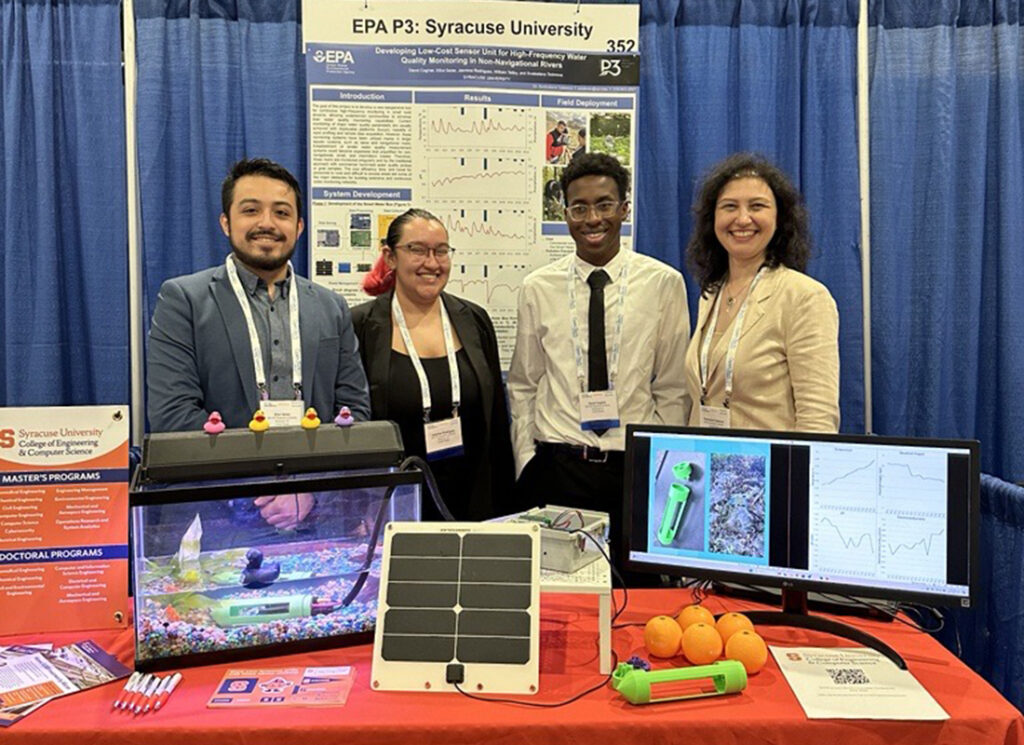
Civil and environmental engineering professor Svetoslava Todorova, retired electrical engineering and computer science professor William Tetley, engineering students David Coghiel ‘24 (civil engineering), Elliot Salas ‘24 (electrical engineering) and Jasmine Rodriguez ‘25 (mechanical engineering) participated in the TechConnect World Innovation Conference and Expo in Washington, DC from June 17-19. The group was a recipient of the U.S. Environmental Protection Agency’s (USEPA) People, Prosperity and the Planet (P3) competitive program grant.
The EPA’s P3 program is a competition where undergraduate/graduate student teams design sustainable solutions to real-world environmental challenges. Todorova, Tetley, Coghiel, Salas and Rodriguez showcased their Smart Water Box, a low-cost sensor unit designed to monitor water quality in small rivers, in a 90-second sales pitch and answered questions in a booth where they displayed their sensor unit.
“The TechConnect World Innovation Expo was a great opportunity that I utilized to network with other student researchers, government agencies, and private companies,” says Rodriguez. “As one of the few student attendees, it was easy to stand out and make better connections with the professionals I interacted with. The P3 National Student Design Competition also gave me valuable insight into what other universities are researching and what issues are at the forefront of people’s concerns when it comes to our environment.”
“Our project stood out as a cost-effective, low-maintenance, solar-powered alternative to traditional water quality monitoring systems. I assisted with the development of the unit and fieldwork to ensure its continuous operation,” says Coghiel. “I was able to connect with different universities and companies to share experiences, knowledge, and accomplishments. Furthermore, introducing our project in an elevator pitch and a booth in the conference hall gave us valuable presentation experience that is bound to help us in our careers.”
P3 has a two-phase program where teams receive $25,000 for a one-year award. The expo concluded phase 1 of the EPA P3 award cycle and the group will compete for the second round of funding in phase 2 during the fall.
“The experience of presenting our project to other schools and EPA representatives was incredibly rewarding,” says Salas. “I was also thrilled to support my team and celebrate their achievements, like David’s impressive elevator pitch and Jasmine’s unique 3D prints, which are integral to our project. While I served a significant role in this project, I must acknowledge the collective effort of our group and the guidance of our mentors, Svetla and William. The time spent in DC was enjoyable and inspiring, and I eagerly anticipate the future improvements our group will make to the water quality monitoring box.”
“Although we discuss the need of using a multifaceted approach in solving contemporary issues, at college level students are often taught in silos. This design project stimulated interdisciplinary collaboration and creativity by bringing together students from three different engineering departments,” says Todorova. “I am extremely proud of their motivation, team spirit, and drive for success. The team stood out with their 90-seconds sales pitch. Everyone came to congratulate us. We are thankful to Linda Hartsock, Strategic Advisor at SU Libraries, for her invaluable guidance and tips in developing a strong sales pitch.”
Lance S. Ketcham
Areas of Expertise:
- Over 30 years experience in the engineering field
- Civil Engineering
- Environmental Engineering
- Geotechnical Engineering
Mr. Ketcham has over 30 years of engineering experience including subsurface/remedial investigation, feasibility study, design, and construction management/ inspection. Duties have included preparing proposals, negotiating contracts, financial management, staffing, project development, engineering alternatives evaluations, construction administration, project management, directly interacting with clients/regulators, and strategic planning. His experience also includes serving as a project manager for the design and construction management of large remediation/construction projects. Mr. Ketcham served as Arcadis’ Technical Knowledge and Innovation (TKI) lead. He provides knowledge sharing throughout the company on the practice of construction design. He provides technical and constructability reviews on construction designs. He carries all this expertise into the classroom to educate the next generation of engineers for their next steps in the world.
Honors and Awards:
- SU Alumni
- 20+ years teaching for the Senior Civil & Environmental Engineering Capstone Class (CEE 475)
- Master’s Degree from SU in Geotechnical Engineering
- Licensed Professional Engineer
Syracuse University Joins Team in $650K National Science Foundation Award to Accelerate Drinking Water Solutions for Small Communities

With funds sub-awarded through the U.S. National Science Foundation’s (NSF) Convergence Accelerator program, Syracuse University’s Center for Sustainable Community Solutions (CSCS) will help develop more accessible pathways for small communities to develop and maintain safe drinking water infrastructure. This collaborative project will focus on communities in Puerto Rico, with the ultimate goal being to use this case study as a framework that can be replicated in other U.S. locations and beyond. The project officially kicked off in February 2024.
Access to clean drinking water is a right for all that is threatened by the looming climate crisis. In 2022, 2.2 billion people lacked safely managed drinking water; and 2 billion people lacked a basic hand washing facility, according to the National Institutes of Health.
Many of those without access are communities of less than 10,000 people who face their own unique obstacles. In Puerto Rico, challenges for these small communities include limited economic resources and severe natural disaster risk, which is amplified by climate change. Unless viable and proactive solutions are developed, this lack of access will prevail.
This $650,000 research project, named VersaWater by its team, is funded by the NSF Convergence Accelerator Program and led by Cornell University in partnership with CSCS; Interamerican University of Puerto Rico’s Center for Environmental Education, Conservation and Research; and AguaClara Reach.
Through the Convergence Accelerator Program, the water research team will use a multidisciplinary, collaborative approach to accelerate the science and community engagement practices around Puerto Rico’s safe drinking water technology using three convergent focus areas: governance and financing, community education and workforce training, and resilient water system technologies.
“The Center for Sustainable Community Solutions (CSCS), which operates the Environmental Finance Center (EFC), has been a leader in environmental finance for over 30 years,” shared CSCS Director and the water project’s Co-Principal Investigator Melissa Young. “Ensuring that funding is not only available for investments like this but that it is also accessible is crucial to making everlasting change for the health and welfare of small communities.”
She continued, “We’re proud to be a part of the esteemed NSF Convergence Accelerator Program, which importantly prioritizes community-focused research and social impact.”
CSCS aims to identify how small communities can better access federal funding made available through the Bipartisan Infrastructure Law (BIL) — a law that authorized billions of dollars for federal investment, including significant financial support for water infrastructure in small communities — and the barriers they experience in doing so. CSCS leverages over three decades of community-based work in EPA Region 2 (which includes New York, New Jersey, Puerto Rico, the U.S. Virgin Islands, and eight Native Nations.)
Cornell Engineering is leading VersaWater (formerly called WaterSAVerS), bolstered by its ties to the non-profit AguaClara Reach, who have together been developing open-source sustainable water treatment technologies specifically for small and very small communities in the Global South over the past 20 years, according to Ruth Richardson, the water project’s Principal Investigator representing Cornell.
“The AguaClara technology aims to create gravity-powered water treatment plants specifically for small and very small communities. Innovations in automated dosing, water movement, and hydraulics create treatment plants that ease operation and maintenance demands since labor is a major cost for [these communities],” Richardson said.
What’s ahead
CSCS and team are currently in Phase 1 of the NSF Convergence Accelerator Program. Over the course of nine months, the water team will develop their initial idea into a proof of concept, identify new team members and partners, and participate in the NSF Convergence Accelerator’s Phase 1 innovation curriculum, which provides fundamentals in human-centered design; team science; use-inspired research; early-stage prototyping; and communications, storytelling, and pitching.
At the end of Phase 1, the water team will participate in a competitive formal NSF pitch and proposal process, which is used in selecting teams for Phase 2. Teams selected for Phase 2 will continue accelerating their solutions toward impact. By the end of the Convergence Research phases, solutions are expected to impact societal needs at scale and be sustainable beyond NSF support.
The Center for Sustainable Community Solutions (CSCS) at Syracuse University
CSCS is a nonprofit organization working at the intersection of sustainability communications, policy, and science to foster economic well-being, environmental stewardship, and social equity by engaging community members at all levels to provide the coordination and knowledge needed to make informed decisions that
support sustainability, resiliency, and climate adaptation. The Syracuse University Environmental Finance Center (EFC), operated by CSCS, is a pillar in this mission that facilitates the development of sustainable and resilient communities throughout US EPA Region 2 (New Jersey, New York, Puerto Rico, the US Virgin Islands, and eight Native Nations) and nationally.
U.S. National Science Foundation
The U.S. National Science Foundation (NSF) is an independent federal agency that promotes the progress of science by investing in research to expand knowledge in science, engineering, and education across all 50 states and territories. NSF supports nearly 2,000 colleges, universities, and other institutions through competitive grants aimed at advancing science with broad impacts across the nation and its people. Learn more at nsf.gov.
About the NSF Convergence Accelerator
Launched in 2019, the NSF Convergence Accelerator—a TIP program—builds upon NSF’s investment in basic research and discovery to accelerate solutions toward societal and economic impact. The program’s multidisciplinary teams use convergence research fundamentals and innovation processes to stimulate innovative idea sharing and development of sustainable solutions. For more information about the program, visit new.nsf.gov/funding/initiatives/convergence-accelerator.
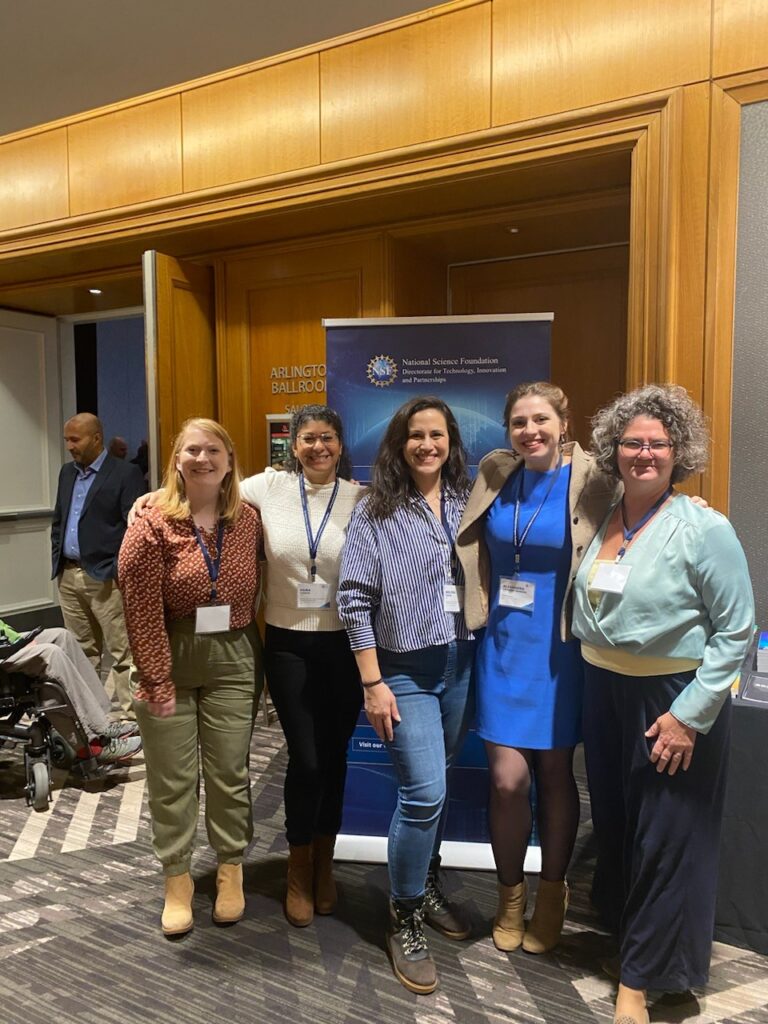
Civil and Environmental Engineering Research Group Wins 2024 Best Case Study Award from Environmental and Water Resources Institute
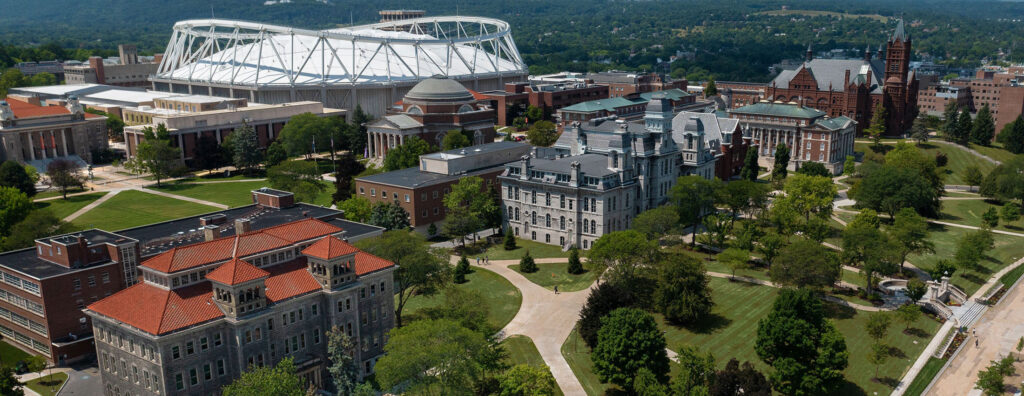
A civil and environmental engineering research group has won the 2024 Best Case Study Award in the Journal of Sustainable Water in the Built Environment. The paper was written by graduate student Lucie Worthen G’19 along with Assistant Professors Christa Kelleher from the College of Arts and Sciences and Cliff Davidson from the College of Engineering and Computer Science (ECS). The award is nominated and selected by the Environmental and Water Resources Institute (EWRI) editorial board.
The research group was awarded for their work on “A Diagnostic Analysis of Low-Impact Development Simulations with Stormwater Management Model (SWMM).” The paper compares the results of the SWMM of the U.S. Environmental Protection Agency with measurements of stormwater runoff from the green roof of the Nick Pirro Convention Center owned by Onondaga County.
Worthen, Kelleher, and Davidson will be recognized at the 2024 American Society of Civil Engineers (ASCE) Convention during the awards and lectures presentation.
The Road to Sustainable Infrastructure

As the construction industry faces challenges in infrastructure maintenance, Syracuse University has established the Infrastructure Institute to develop new approaches to address these issues. Under the leadership of Min Liu, the institute strives to develop talent, conduct research, and educate the public to ensure a sustainable, collaborative future in infrastructure.
“The biggest issues we see right now are public safety, the environmental impact of infrastructure, and a long-term shortage of skilled laborers,” says Liu. “My vision for this institute is to build a platform to facilitate different people from different sections to work together.”
Liu earned her Ph.D. in engineering project management from the University of California, Berkeley in 2007. She then worked as an assistant and later associate professor at North Carolina State University until 2022. During her tenure, she conducted research on construction engineering and management, collected large amounts of empirical data, and used modeling programming to analyze the data and improve productivity.
Additionally, Liu worked with the North Carolina Department of Transportation and the Construction Industry Institute. She also became Chair of the ASCE Construction Research Council from 2020 to 2021. In 2022, Liu joined Syracuse University as the Abdallah H. Yabroudi Endowed Professor in Sustainable Civil Infrastructure and the director of the Infrastructure Institute, bringing years of experience to her respective roles.
The Infrastructure Institute is developing academic programs, research opportunities, and internships for students and educational programs for public officials and professionals. The institute also collaborates with a wide range of professionals, including information technology experts, data analysts, architects, environmental design professionals, journalists, and business professionals.
Min’s goal is to create a platform that consists of three main pillars: the public, private, and student and faculty sectors. Since building infrastructure requires funding from the government, the union labor association serves as the workforce to construct infrastructure, and students are the future of the industry, collaboration between these three sectors is integral for the success of the institute.
“Public authorities provide the direction and funding for infrastructure. Universities and faculty provide education to students. Students will then become the fresh blood for the public authorities and construction industry. These three sectors are crucial and it’s important they work together.”
Liu has organized various events to integrate the different disciplines within the institute. They held a reception attended by nine different departments and centers at the University. During the event, lightning talks were hosted, and attendees discussed their vision for the future and ongoing research. This event also provided an opportunity for people to socialize and get to know each other.
“With the support of the Office of Research and collaborating with the School of Architecture, the institute developed a request for proposal to encourage and facilitate collaboration across the SU campus to improve infrastructure policy and delivery based on the I-81 project,” says Liu.
Liu has also taught a capstone course that included various students across the college with the goal of helping them prepare for their roles in infrastructure project management and delivery.

Civil and Environmental Engineering Students Participate in Sustainable Solutions and Steel Bridge Competition
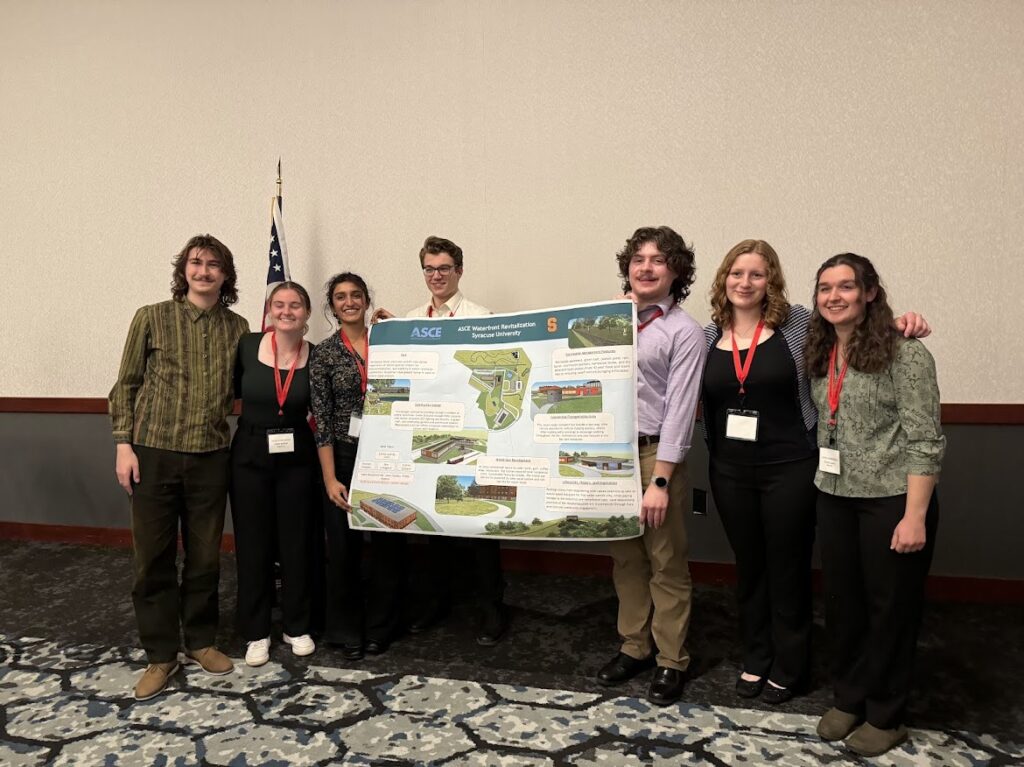
Four civil and environmental engineering students in the College of Engineering and Computer Science (ECS) won first place in the regional American Society of Civil Engineers (ASCE) Sustainable Solutions Competition. The competition took place at the Upstate New York-Canada ASCE Student Symposium at Rensselaer Polytechnic Institute (RPI) in mid-April, and the team consisted of Emma Liptrap ’24, Ananya Chandra ’24, Sam Livingston ’24, and Caitlin Spillane ’24. Liptrap served as team captain.
The ASCE competition challenges students to understand and implement sustainable solutions and the primary goal of the team’s project was to reinvigorate a fictional city’s waterfront. They designed a community center, a mixed-use development, a commercial area, and a waterfront park with pedestrian pathways and a bus loop with accessibility throughout the site. The waterfront’s innovative design also utilized green infrastructure to manage stormwater and mitigate flooding. The design exceeds the “Superior” level of the Institute of Sustainable Infrastructure’s ENVISION framework.
Additionally, a group of seven civil and environmental engineering students participated in the Student Steel Bridge Competition at RPI and the student team consisted of Patrick Alberga ‘25, Henry Bievenue ‘24, Henry Long ‘25, Sumit Mistry ‘24, Maxwell Pozar ‘25, Aaron Shinn ‘25 and Arturo Venegas ‘25. Shinn served as team captain.
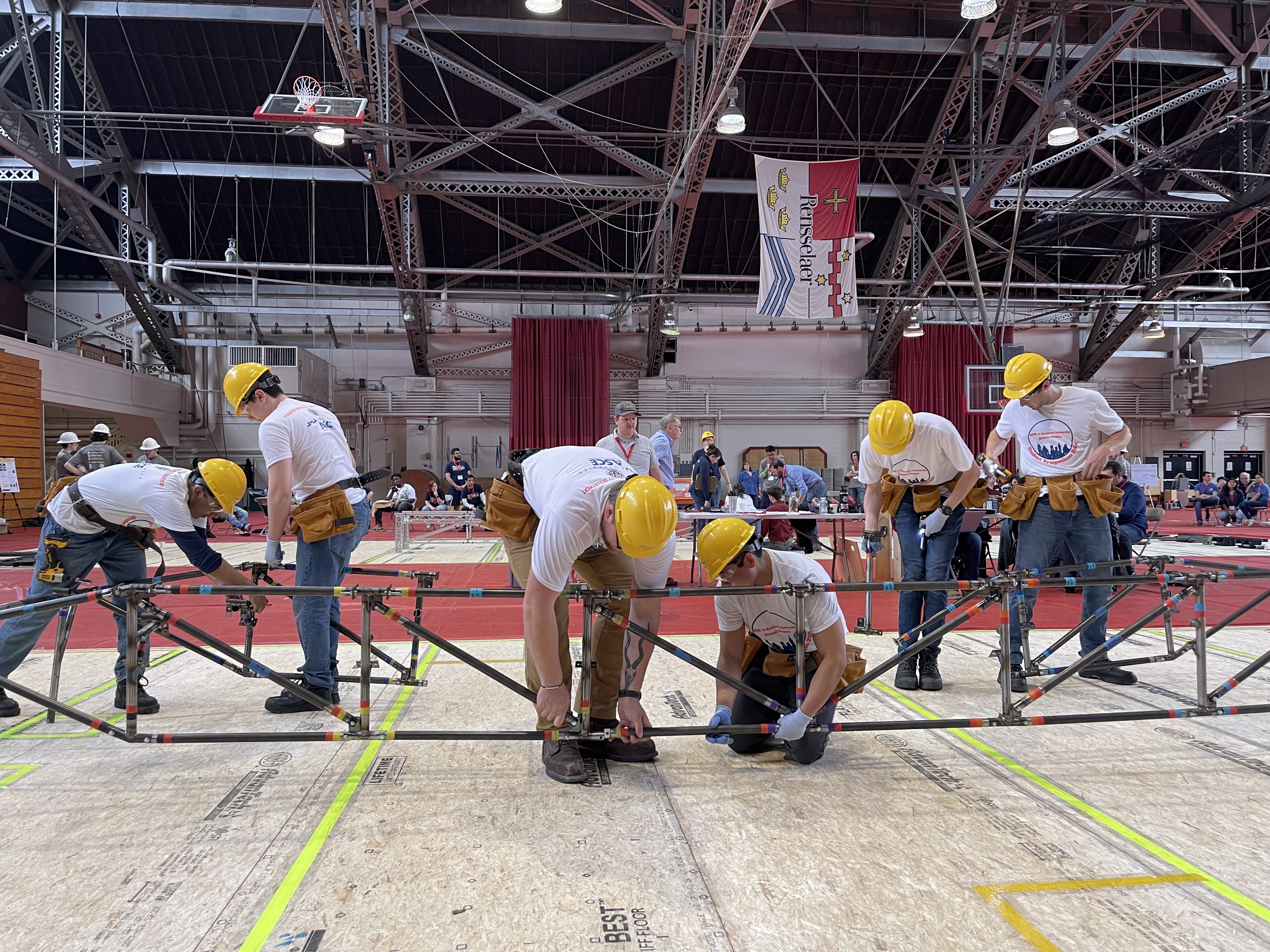
The Steel Bridge Competition challenges students to create a scaled-model steel bridge. The team designed, fabricated, and constructed a 150 lb. and 21-foot-long steel bridge in segments and assembled the segments into a fully functional bridge within a time limit. The bridge was then subjected to various geometry and loading tests during the competition.
The Sustainable Solutions team has received an official invitation to compete at the 2024 ASCE Student Championships at Brigham Young University in June and is preparing for the national competition.
Professor Shobha K. Bhatia Receives Chancellor’s Citation for Excellence Lifetime Achievement Award

The College of Engineering and Computer Science (ECS) is proud to announce Professor Shobha K. Bhatia as the recipient of the Chancellor’s Citation for Excellence Lifetime Achievement Award. From research and teaching to diversity, equity, and inclusion initiatives, her outstanding contributions have made her a leading figure within her fields of study and ECS. As Bhatia prepares to retire, she leaves a legacy of inclusion, empowerment and environmental justice, inspiring hundreds of students and colleagues to do the same.
“The Chancellor’s Award means a lot. The greatest honor is that my colleagues took time to nominate me,” says Bhatia. “My students [at Syracuse] and colleagues from around the country and abroad wrote beautiful letters. I’m thrilled to receive this award.”
Bhatia completed both her bachelor’s and master’s degrees in civil engineering at IIT Roorkee, India in 1971 and 1973. She went on to earn her Ph.D. as a Commonwealth Scholar at the University of British Columbia, Vancouver in 1980. While searching for a job, she initially didn’t consider the College of Engineering and Computer Science as an option. However, when her husband, Tej Bhatia, became a faculty member at Syracuse University’s Languages, Literatures and Linguistics (LLL) Department, she decided to join him.
Aside from the chilly weather, Bhatia wasn’t sure what to expect when she first arrived at Syracuse University. She was the only female faculty member in ECS at the time and the only full female professor in the engineering college until 2008. This experience defined her approach to supporting colleagues and students.
“Syracuse University made me feel like this was my university, my work – my voice meant something. I want to give the same feeling to my students – it’s their university, their department, their lab.”
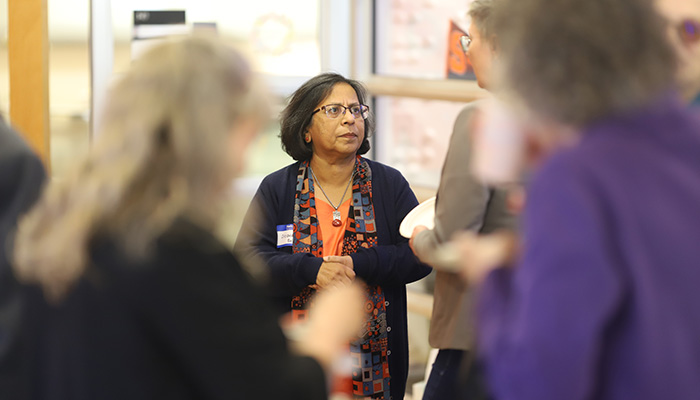
Infusing environmental justice and sustainability in her research goals, Bhatia is an influential figure in geotechnical engineering. Her research on geotextile tubes has critical applications in containment systems and filters. She also developed the Bubble Point technique, which more accurately evaluates geotextile filters used in roads and landfills. The American Society for Testing Materials (ASTM) recognized the increased efficiency and accuracy of the Bubble Point technique and has adopted it as a standard test method.
Bhatia has published over 150 articles and book chapters covering topics that range from soil materials and erosion control to road and building construction and the protection of water quality. She has taught many courses at Syracuse University, as well as guest lectures and seminars in the United States, Mexico, India, Singapore, and the United Kingdom among others. Bhatia also served as a consultant with the U.S. Army Corps of Engineers Waterways Experiment Station on the dynamic analysis of the 340-foot-high Folson dam.
In addition to her impactful research and contributions, Bhatia has been instrumental in creating programs to support undergraduate students in their academics within the University. As co-director of Women in Science & Engineering (WiSE), she developed a learning community designed for first-year women in STEM. She has worked with the WiSE leadership team to establish the WiSE Future Professoriate Program for graduate students and the WiSE undergraduate Women of Color Career Preparation Program (WWoC), both of which provide support for women pursuing STEM degrees.
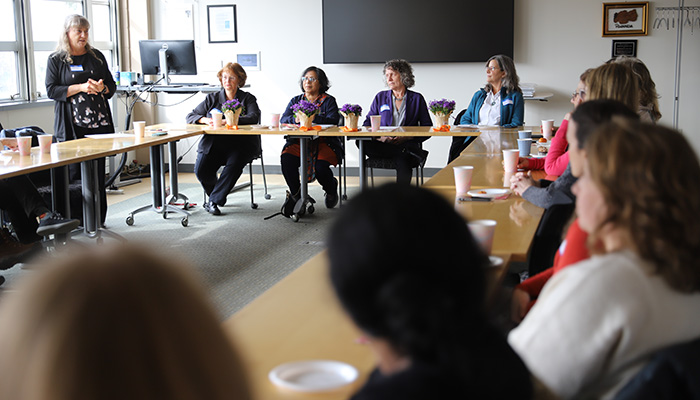
When reflecting on her work, Bhatia does not focus on what she has given to the University, but rather on what Syracuse University has given to her. “When I think about the times, I was the happiest working, it was with my students and colleagues. Working with them has always been a highlight. The Syracuse community has been wonderful, and I’ve been able to make lifelong friends.”
Bhatia has also received the 2024 USUCGER Diversity, Equity, and Inclusion (DEI) Award for her efforts toward improving DEI initiatives in geotechnical engineering and the 2025 Robert M. Koerner Award for her contributions to the geosynthetics industry.
She will continue her work at Syracuse University as a research faculty member for two additional years, working on several collaborative research projects in the U.S. and India. ECS will not be the same after Bhatia’s retirement, but her legacy of collaboration, innovation, and revolutionary research will benefit the university for years to come.
“People have been asking me how I feel but I’ve never retired before, so I don’t know what I feel. It’s a new experience for me,” Bhatia says. “It’s an interesting time for me to reflect because we don’t often take time to reflect…When I think about my accomplishments, it’s not about the number of papers I’ve published. It’s the people I’ve worked with and what we’ve been able to accomplish together.”
Lifelong Learning: Paul Ossenbruggen ‘63

When it comes to lifelong learning, there’s no better example than Paul Ossenbruggen ‘63. With several decades of experience as a professor, and an engineering career spanning over 40 years, he continues to publish new research papers to this day. However, the journey towards settling into his teaching role took some time. With so many different things he enjoyed learning, it made choosing a specific career difficult.
“I never seem to settle in anything. Some people got involved with one thing and that’s what they do,” he says. “That’s not me – I jump around from one thing to the next.”
Graduating from Brooklyn Tech High School in 1959, Ossenbruggen was uncertain about his career path. Though he began studying civil engineering at Syracuse University, he remained open to exploring other options. At one point, he even considered becoming an airline pilot. It was only during his internship at an energy technology company, Babcock and Wilcox, that he finally discovered his passion for nuclear engineering.
“Babcock and Wilcox make huge boilers,” he says. “Even though I was a civil engineering student, I was getting more involved with nuclear engineering. It was challenging but interesting and I loved every second of it.”
After completing his undergraduate studies at Syracuse in 1963, he continued pursuing his interest in nuclear engineering when working at General Dynamics Electric Boat, where he helped build nuclear submarines. Yet, a part of him wanted to continue learning and exploring other options.
“I loved my job at Electric Boat. They designed and constructed the first nuclear-powered submarine, the U.S.S. Nautilus,” he says. “But I felt there was so much more I wanted to learn so I decided to go to grad school at the University of Connecticut in 1967 and later Carnegie Mellon University for my Ph.D. in 1970. I like learning new things.”
Initially planning to return to Electric Boat, Ossenbruggen became interested in higher education and decided to pursue teaching instead. He began teaching at Northeastern University in Boston, and later in 1975, he moved to the University of New Hampshire where he taught for 34 years. He also taught at the University of California, Berkeley from 2000-2003.
Teaching not only allowed him to mentor and guide students but also explore new engineering concepts, which he found fulfilling. During his tenure as a professor, he also wrote a textbook in 1984 titled “Systems Analysis for Civil Engineers.” The book combined the fundamentals of engineering economics and civil engineering systems and garnered critical acclaim at the time of its publication. It was also translated into Chinese.
“It was a cutting-edge book. Civil engineers didn’t usually write this kind of textbook,” he says. “And one of the great things about it is that it’s still being read to this day.”
Nowadays, Ossenbruggen has settled down, returning to Syracuse where he sees a bright future for the University and the city. He’s been particularly excited about Micron’s plans to invest an estimated $100 billion into Central New York as well as the community grid in downtown Syracuse.
“I’m excited to be in Syracuse now to see this transformation happen. Micron is going make a big difference,” he says. “I’ve been to every meeting, and it looks promising to me. This area turned into a rust belt but hopefully, it’ll become stainless steel.”
Ossenbruggen also looks forward to the Operations Research and System Analytics Master’s Program, which he believes will bring immersive learning to the college’s forefront and fuel students’ passion for learning and discovery.
“I’ve been interested in operations research since I was a grad student at Carnegie Mellon. It had just got off the ground when I was completing my Ph.D. I even proposed a similar course while I was at the University of New Hampshire.
“I’m glad ECS is committed to introducing this program. It’s interdisciplinary, which I like very much. The course selection is great and offers a nice variety of courses that can be tailored to meet a student’s interests. Syracuse University is in a great position.”
Civil and Environmental Students Apply Science to Litigation in Mock Trial Exercise
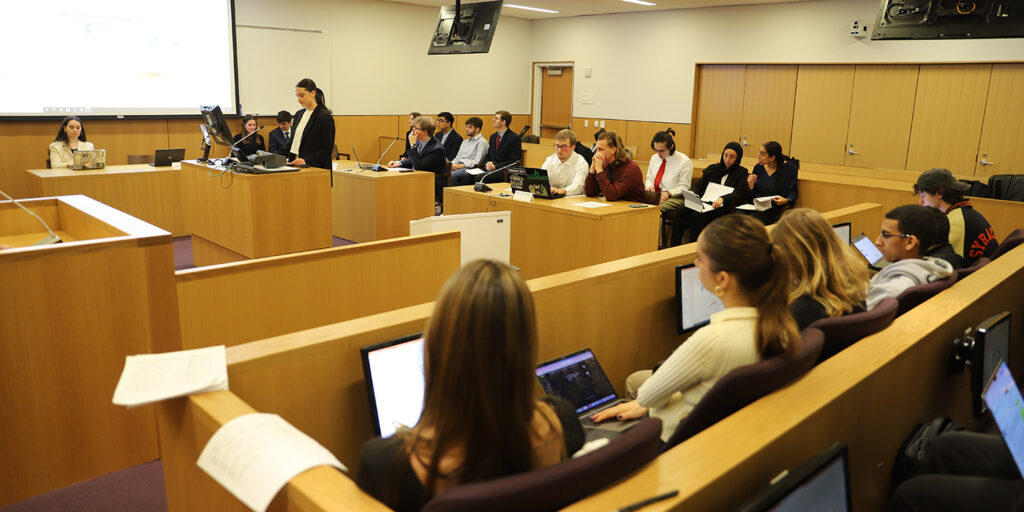
In December 2023, students in Professor Svetoslava Todorova’s course CEE 341 “Introduction to Environmental Engineering” served as expert witnesses and lawyers in a mock trial. In this simulated trial, they learned the importance of scientific accuracy and engineering judgment in litigation practice.
Using real data from a contamination case in Europe, students were split into three groups representing different companies accused by the city of contaminating its groundwater pumping wells. For three weeks, they worked with their groups to analyze chemical and hydrological data, considered toxicological exposure, and government regulations to provide their engineering interpretation of the issue to their fictional company’s CEO.
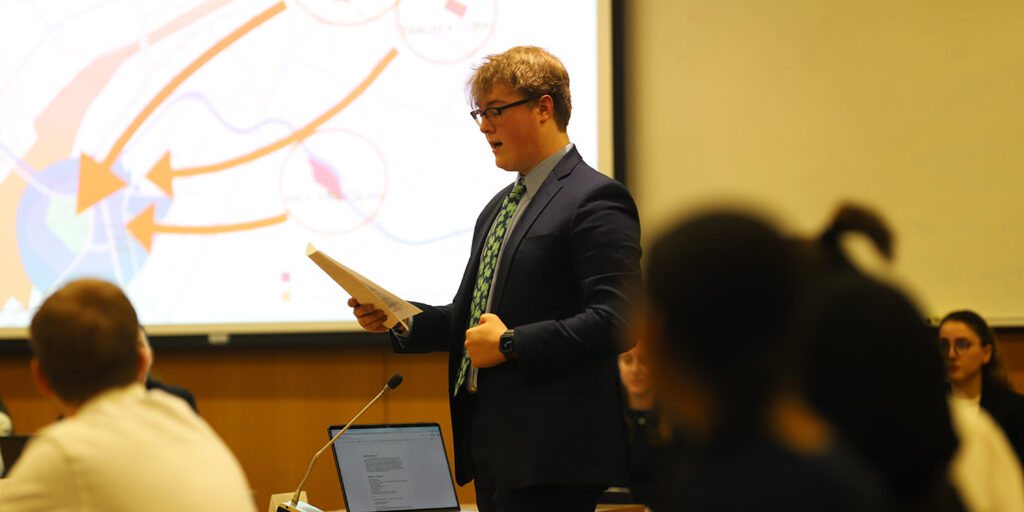
“Our group worked hard over the weeks leading up to the trial and were trying to look at all possible directions that the trial could go. We chose two of our witnesses to be expert witnesses in the fields of groundwater flow and toxicology, with our last witness being an employee from another company,” says civil engineering student Kana Wong ‘25.
After weeks of preparation, students from CEE 341 and students from ECS 101 “Introduction to Engineering,” taught by civil and environmental engineering professor, Peter Plumley, came together in the School of Law’s courtroom. CEE 341 students served as legal professionals and witnesses and the ECS 101 students served as the jury. A legal professional from the local community also served as the judge while Plumley served as the court bailiff.

“The concept of upper-division students role-playing as legal professionals and witnesses and entry-level students as jurors adds a great dimension to the student learning experience. Professor Todorova’s [project] effectively recreates the atmosphere and components of a real-world civil trial,” says Plumley.
“From the lawyers who smiled coyly after nailing a speech or debate with their witnesses, to being yelled at by the other passionate jurors when voting, it made me truly feel like I was in a political court case. I was a little worried I wouldn’t be able to interpret any of the law terms, but after the first trial I sat through, being the foreperson in the second trial was a breeze,” says environmental engineering student Natahlia Hammond ‘27.
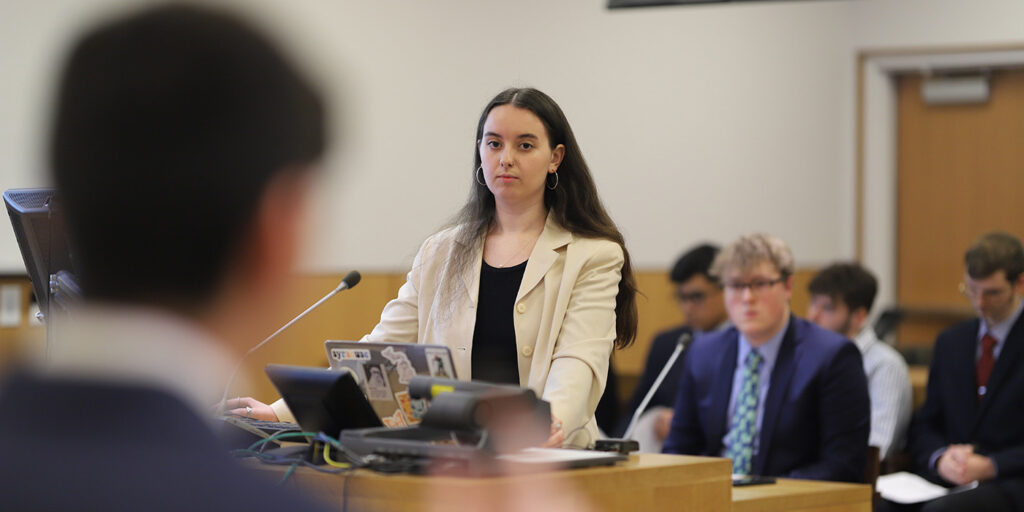
Plumley and the judge kept track of time during all legal proceedings, which included opening statements, questioning witnesses, cross-examining opposing witnesses, and closing statements.
“I served as the expert witness employed by my company to show our findings. I was questioned by my company’s lawyers and cross-examined by [opposing counsel]. The roles we played were done in the hopes that we could [shift the focus onto] the other companies rather than the one we were chosen to represent,” says environmental engineering student Emma Crandall ‘25.
“As one of the lawyers from my group, it was important to have a good grasp of all of my company’s data and what may play to our strengths and weaknesses in our defense, but to also know how the procedures worked overall when cross-examining witnesses,” says civil engineering student Noah Ialongo ‘25.
“As the faculty member providing the jurors, I especially appreciate that the outcome of each trial depends so much on the defense and delivery of the expert witnesses and the cross-examination by the associated company attorneys,” says Plumley. “Svetla and I are also particularly thankful for the School of Law for allowing our engineering students to experience the inner workings of a courtroom.”
“It was absolutely captivating to see how junior engineering students applied the knowledge they gained in class, managed to build a defense plan, and utilized expert witnesses, detailed maps, and cross-examination to defend and deflect the prosecution,” says Todorova. “Developing a solid scientific argument in support of, or against the presented evidence is critical.”
Civil and Environmental Engineering Staff Spotlight: Weisi Liu

Name: Weisi Liu
Title: Budget Manger
Tell us about your role at ECS:
I oversee all budget and financial operations and provide financial guidance to ensure the financial stability and smooth functioning of the department. Work closely with faculty and staff on the grants proposal and awards management.
What is your favorite part of working here at ECS?
Working with a team of diverse backgrounds and innovative minds. By providing support, guidance and leadership regarding all budget and financial aspects to the faculty and students, I am happy to see they obtain more research funding and exceptional educational experience.
Students Witness International Environmental Policy Negotiations at Minamata Convention on Mercury

From October 28 to November 4, 2023, 11 students accompanied by civil and environmental engineering professor, Svetoslava Todorova, attended the 5th Conference of the Parties (COP5) of the Minamata Convention on Mercury held in Geneva, Switzerland. This trip was part of the Role of Science in Environmental Governance course where students explored how scientific, political, social, and economic views shape environmental policy.
At the conference, students observed delegates discussing the environmental impact of mercury pollution, which has become a public health issue due to its harmful effects on the nervous, digestive, and immune systems and lack of biodegradability. Participation in these ongoing negotiations helped students understand the complexity of reaching international agreements.
“No matter the preparations made in the classroom and on our own, being an observer at COP5 showed me that there is no replacement for experiencing the negotiations firsthand. It was interesting to see how many moving pieces go into these conventions, and increased my appreciation for the work they do and what they can accomplish,” says environmental engineering student Brady Hartnett ’24.
The students witnessed several key decisions being made, including the establishment of new timelines for phasing out products containing mercury, recognizing the disproportional impact of mercury pollution on Indigenous communities in the Arctic and Amazon regions, and coming to an agreement on the threshold for mercury waste.
“I think one of the most challenging aspects of the COP-5 negotiations was getting all the countries to agree on particular topics. This became evident when the threshold for the mercury levels in waste was being discussed. It took the delegations seven years to finally agree on this threshold. I am very glad that I had the privilege of witnessing this history being made,” says civil engineering student Caitlin Spillane ’24.
Students also had the opportunity to meet with delegates, non-government officials, and UNEP representatives from several different countries.
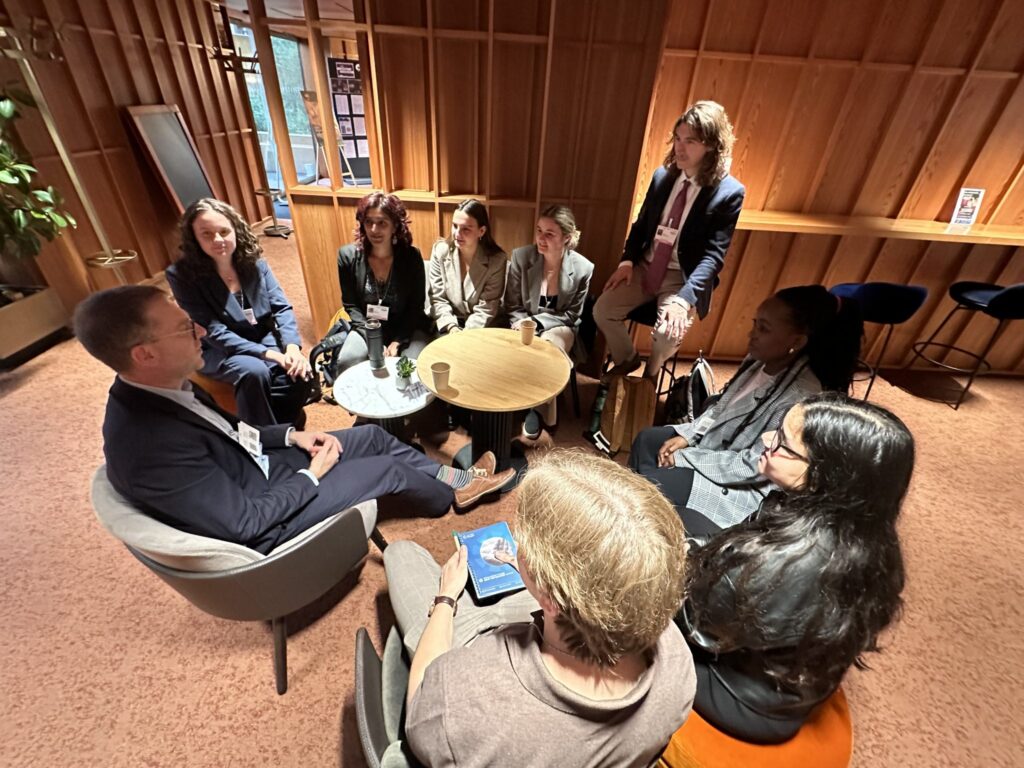
“We had a networking opportunity with Ken Davis, a former Peace Corps Volunteer and EPA employee who works for UNEP, as part of the Minamata Secretariat,” says environmental engineering student Ananya Chandra ’24. “He gave valuable insights about the importance of international negotiations, the mechanisms of the Minamata Convention, and his career path.”
Todorova and her students also visited CERN, one of the world’s largest centers for scientific research on fundamental particle physics, and received a special in-depth tour of the particle accelerator. This was made possible by Syracuse University professor Marina Artuso and Bolek Pietrzyk from CERN.
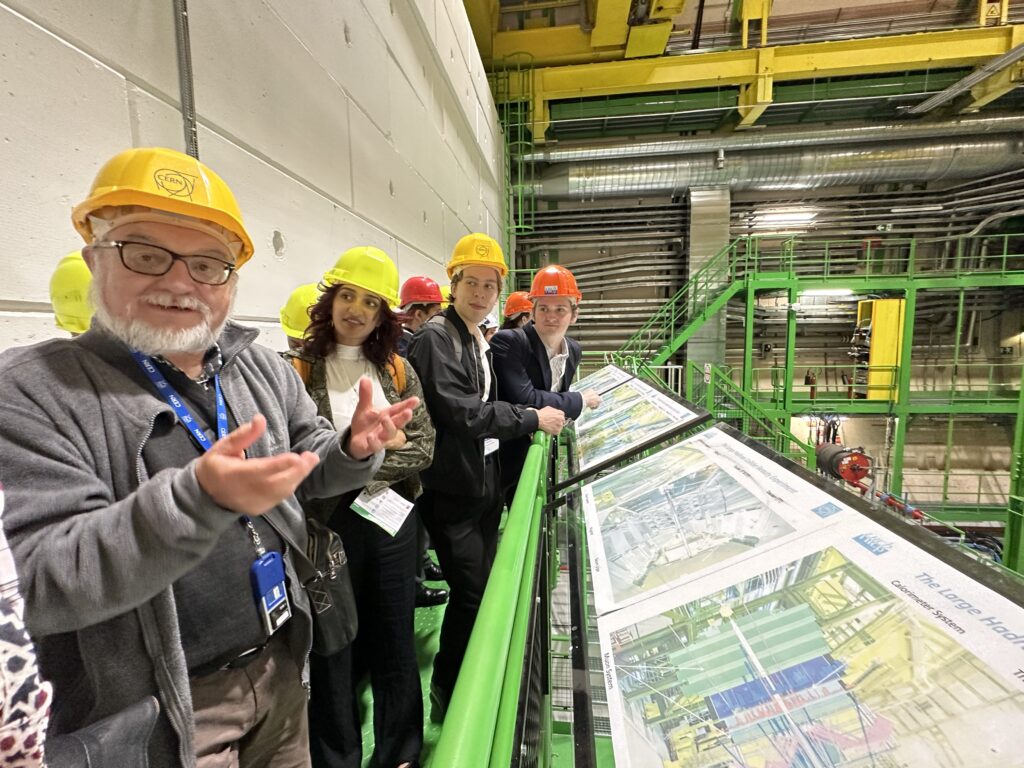
“It was so interesting to be touring places that not only hold global significance but are places that people work every day,” says civil engineering student Julia Johnson-Milstein ’25. “Walking through those hallways, I knew that I was passing some of the brightest minds in the world.”
On their final day in Switzerland, they visited a cheese and chocolate factory, ending their memorable trip with a fun tour.
“The trees and villages I saw on the bus to the factories are the same trees and villages that are impacted by environmental regulations that are decided on in rooms much like those I sat in. It was watching the mountains protect the nature underneath that showed me how important the work of the last week was, and I will be forever grateful for this experience,” says psychology student Gary Shteyman ’26.

When Todorova and her students returned to Syracuse, the class held their own intergovernmental negotiations. Acting as delegates representing different countries and regions, they developed a new mercury treaty.
“This is experience-based learning at its best because it trains students by immersing them into an authentic situation,” Todorova says. “It was also rewarding to see them apply the negotiation techniques we discussed in class as well as to replicate the dynamics they observed during the real convention.”
Humanitarian Work in Water Systems
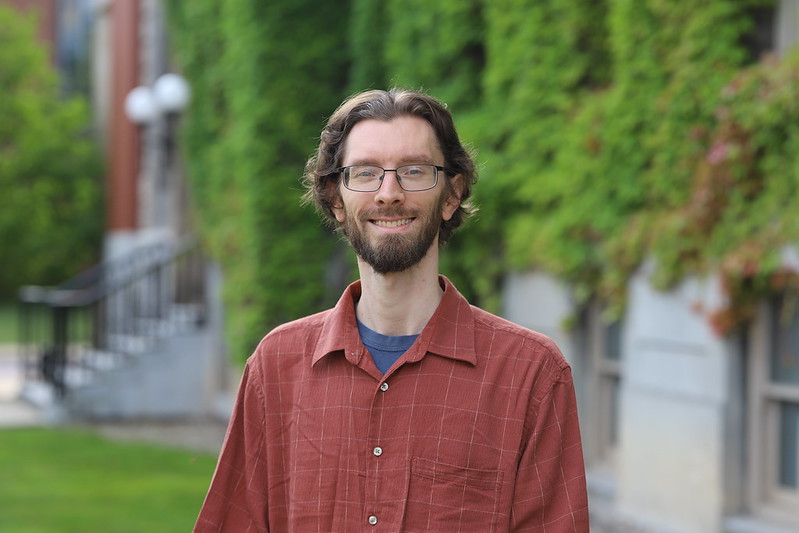
From the drylands of Kenya to the rainforests of Suriname, civil and environmental engineering professor John Trimmer has dedicated his career to making a difference. After a service-learning trip to Nicaragua, where he helped with construction projects, Trimmer was inspired to pursue humanitarian engineering and improve the well-being of others. With a core research focus on water systems, sanitation, and resource recovery, he strives to promote sustainable living.
As an undergraduate at Bucknell University, Trimmer was able to work with a few non-governmental organizations (NGOs). In addition to his trip to Nicaragua, he collaborated with a Peace Corps volunteer in Suriname, South America, stationed in a remote village and working on a rainwater collection system. After graduation, Trimmer continued working with the Peace Corps and spent three years in Uganda working with an NGO that specialized in constructing water tanks, latrines, classrooms, and other structures.
After completing his Ph.D., which included working in Uganda on innovative approaches to sanitation systems, Trimmer joined the Aquaya Institute on their mission to improve global health through safe water and sanitation access. His work at the Aquaya Institute largely focused on research and he found himself based in Nairobi, Kenya, interacting with pastoral communities in dry regions of the country.

“Though the communities were nomadic, it seemed like they were also looking to settle, and they were open to permanent infrastructure,” Trimmer says. “It was very qualitative. We focused primarily on asking questions regarding their current water systems and what they do for sanitation. We also did interviews and discussion groups to understand what these communities wanted and needed.”
While working with the Aquaya Institute, Trimmer also researched the effectiveness of a program that aimed to provide more durable infrastructure to vulnerable households in northern Ghana. Since unstable soil is an issue that impacts certain areas, they wanted to ensure the structures they built would last.
“If you dig a traditional pit latrine, it may collapse because the soil is unstable. Since the locals in the area didn’t have the means for a more durable structure, we were looking at different ways those systems could be supported financially,” Trimmer explained. “UNICEF funded the project so durable structures could be installed.”
As Trimmer has traveled to different countries, he’s loved working with young researchers and found it rewarding to help them develop their skills and witness their growth. This passion for mentoring younger researchers would translate to his position as a Syracuse University professor, giving him a chance to continue guiding and supporting students.
While teaching courses at the University, Trimmer plans to collaborate with NGOs he’s previously worked with on upcoming projects. He hopes to collaborate with colleagues to develop a platform that models sanitation systems to implement them as a teaching and research tool in the classroom. This will enable him to share the knowledge he’s gained from his humanitarian work and educate future researchers to do the same.
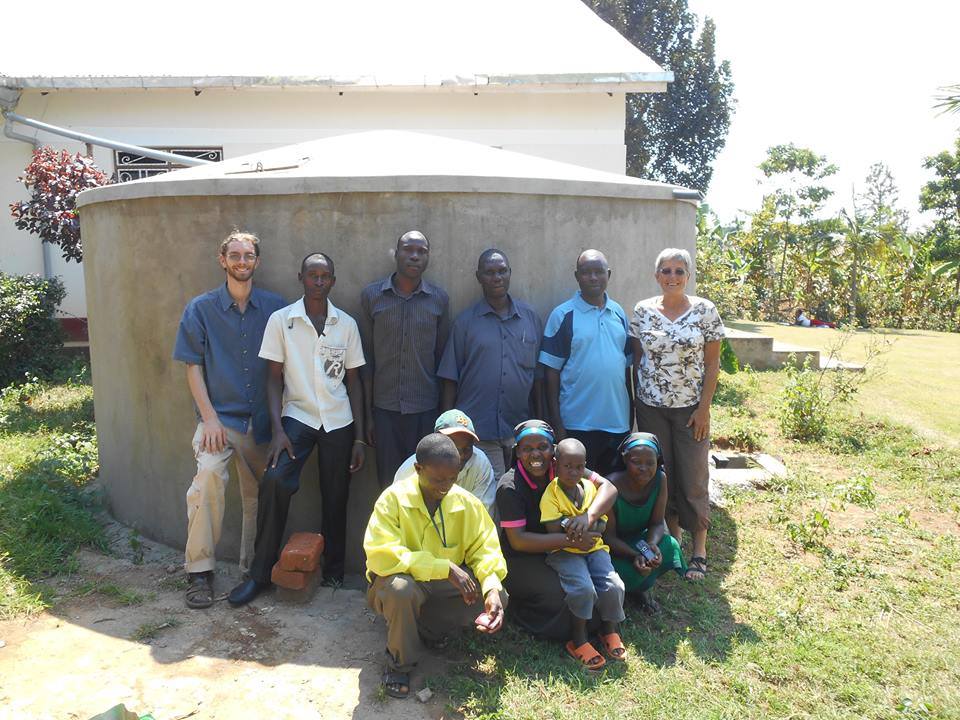
Yizhi Liu
Degrees:
- PhD Architectural Engineering, Penn State University
- MS Robotics, Columbia University
- MS Electrical Engineering & Computer Science, Penn State University
- MS Construction Engineering & Management, University of Michigan
- BS Construction Management, Tianjin University
Research Interests:
- Construction robotics;
- Human-robot interaction;
- Robotic teleoperations;
- Robot path planning;
- Computer vision and machine learning algorithms for seamless human-robot collaboration;
- Physiological sensing for workers’ health and safety
Selected Publications:
Liu, Y., Habibnezhad, M., and Jebelli, H. (2021). “Brain-computer interface for hands-free control of construction robots,” Automation in Construction, Elsevier, 123, 103523. https://doi.org/10.1016/j.autcon.2020.103523.
Liu, Y., Habibnezhad, and Jebelli, H. (2021). “Brainwave-driven human-robot collaboration in construction” Automation in Construction, Elsevier, 124, 103556. https://doi.org/10.1016/j.autcon.2021.103556.
Liu, Y., Habibnezhad, M., Shayesteh, S., Jebelli, H., and Lee, S. (2021). “Paving the Way for Future EEG Studies in Construction: Dependent Component Analysis (DCA) for Automatic Ocular Artifact Removal from Brainwave Signals,” Journal of Construction Engineering and Management, ASCE. https://doi.org/10.1061/(ASCE)CO.1943-7862.0002097.
Liu, Y., Ojha, A., Shayesteh, S., and Jebelli, H. (2022). “Robotic Sensing and Perception in Construction: Generative Adversarial Networks (GANs) based Physiological Computing Mechanism to Enable Robots to Perceive Workers’ Cognitive Load” Canadian Journal of Civil Engineering, Canadian Science Publishing. http://doi.org/10.1139/cjce-2021-0646.
Ojha, A., Liu, Y., Shayesteh, S., Jebelli, H., and Sitzabee, W., (2022). “Affordable Multiagent Robotic System for Same-level Fall Hazard Detection in Indoor Construction Environments,” Journal of Computing in Civil Engineering, ASCE. https://ascelibrary.org/doi/10.1061/%28ASCE%29CP.1943-5487.0001052
Sam Clemence
Civil and Environmental Engineering Professor Sam Clemence Receives Legend Award from the Deep Foundations Institute

The Deep Foundations Institute (DFI) recognized Civil and Environmental Engineering Professor Sam Clemence as a recipient of a DFI Legends Award on November 2, 2023. This award was established to honor practitioners that have made significant contributions and advancements to the research, design, construction, manufacturing and use of deep foundations.
Clemence was recognized for his 40 years of comprehensive research on the design and behavior of helical foundations. He is credited with shaping the modern use of helical piles and tiebacks, which advanced to a widely implemented foundation tool and robust business industry. He was a founding member and chair of DFI’s Helical Piles and Tiebacks Committee.
Matthew Conte ’06, principal at the Conte Company, introduced Clemence at the DFI Awards ceremony and provided this tribute to Clemence’s accomplishments, innovation and leadership.
“If you work in the helical pile industry, you have Sam Clemence to thank. The modern use of these deep foundations was shaped by Sam. His research has created one of the most comprehensive data collections of torque-to-capacity and helix plate analysis in the industry. The use of helical piles and tiebacks advanced into a widely implemented foundation tool and robust business industry. Serving as the first Chair of the DFI Helical Pile and Tiebacks Committee, Sam made it known that these foundations have their place in design standards.
As an Assistant Operations Officer in the US Navy Civil Engineer Corps, Sam completed projects in some of the most remote locations in the world. Installing deep foundations into crystallized coral and constructing bridges using elephants probably would not surprise you if you were familiar with his creative approach to engineering.
With a career close to 50 years as an educator, Sam developed a unique way to both relate to young engineers while also preparing them for the industry ahead. He didn’t have to tout his accomplishments; you could recognize them in how he taught. When I meet other Syracuse University engineering alumni, we always share a fun story about our time with Professor Clemence. A legend always leaves a lasting impression on those they meet. The contributions of Sam Clemence have made impressions on the current deep foundation industry and will continue to do so in the contributions of the students he has taught.”
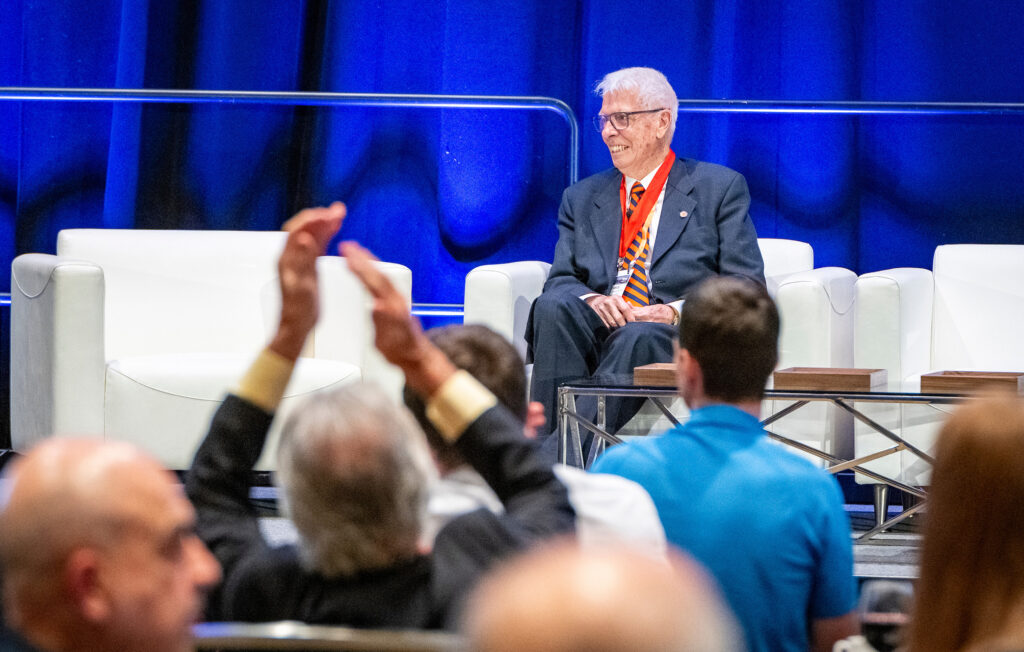
Charting a Pathway to Renewable Energy
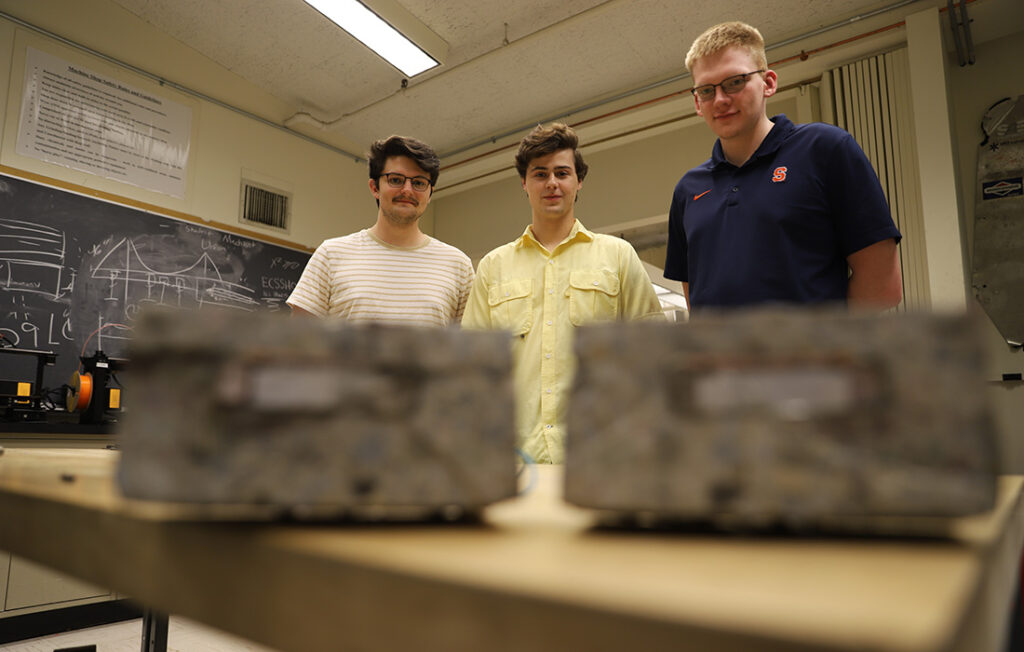
Imagine a city where streetlights and crosswalks no longer rely on electric grids for power. Instead, they draw their energy from the construction material that makes up several buildings and sidewalks: concrete. While it sounds far-fetched, three College of Engineering and Computer Science students, Ian Storrs, Brendan Murty, and Ryan Mussaw, are working to make this a reality. Through research and testing, their discoveries have the potential to be a new commercial technology that harnesses an overlooked source of energy and makes an impact on sustainability.
Their invention, ConCurrent, relies on the principles of thermodynamics, a field of physics that involves energy, temperature, and heat. Concrete on its own can’t generate electricity. But heat can – and construction materials like concrete and asphalt can soak up a large percentage of the sun’s heat. With a huge amount of heat being absorbed into the concrete, the engineering trio discovered an ingenious way to transform this wasted energy into a power source by turning heat absorbed by concrete into electricity. This began their journey into the world of renewable energy research.
Originally a pitch for Invent@SU, their prototypes were concrete blocks fused with a thermoelectric generator, which transforms heat absorbed by the block into electricity when one side of the block is hot, and the other side is cool. The temperature difference between each side is crucial to generating electricity—the greater the temperature difference, the more electricity can be generated.
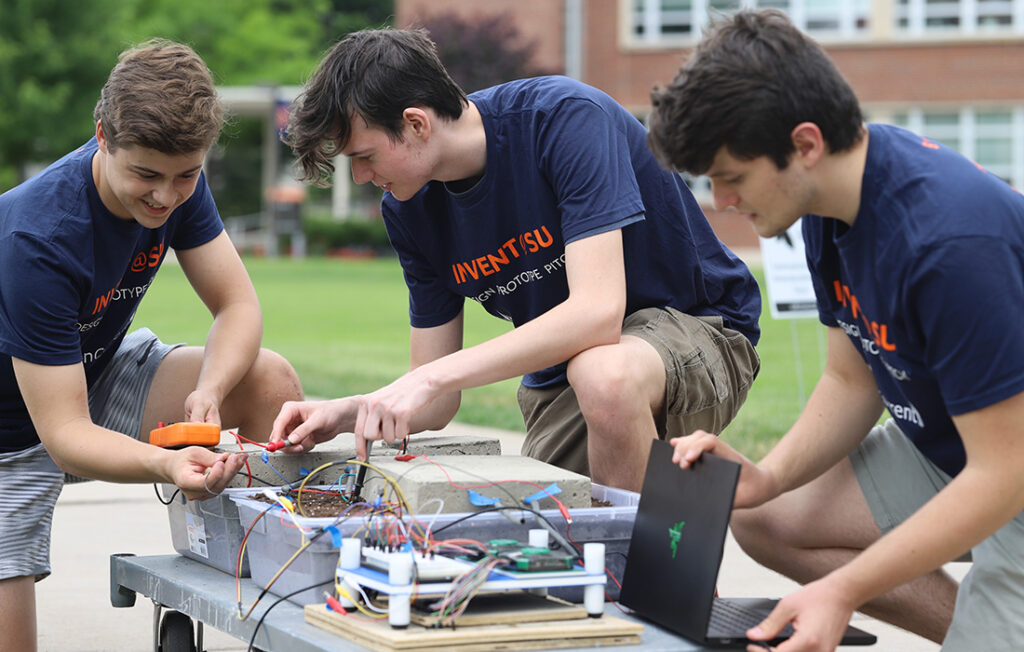
“We were thinking our invention could power things in close proximity to roadways and illumination for sidewalks like embedded lights, kind of like what you’d see at movie theatres when you’re walking down the aisle,” Murty said.
However, a single concrete block isn’t enough to generate power for crosswalks or streetlights, so they’ll need a considerable number of these devices to achieve this. These blocks have been helpful in exploring the concept of heat, concrete, and electricity and they’ve included other materials in their prototypes to amplify the temperature difference on each side of the block.
“We included a copper plate on top to absorb heat and pull it down from the surface of the concrete,” Storrs said. “The aluminum plate pulls heat from the bottom to try to cool it. The sides are also wrapped in foam insulation to reduce heat escaping. And on the bottom, we have a heat pipe, a copper tube with fluid that’s good for moving heat.”
While some may think ConCurrent is solar power with extra steps, there are some differences. Solar power relies on sunlight. ConCurrent relies on solar radiation or the heat absorbed from the sun’s radiation. This means even when the sun goes down, their invention can continue functioning since concrete absorbs and retains heat.
“It’s a resource that hasn’t really been tapped in a real effective way. We have solar, which harnesses the sun’s energy but this specific realm hasn’t been focused on,” Murty said.
The research aspect of the project was by far the most interesting part to the engineers. They would be able to continue research on ConCurrent when offered a position at the Industrial Assessment Center (IAC) at the start of fall 2022. At the assessment center, Storrs, Murty, and Mussaw assisted manufacturing companies in conserving energy by suggesting changes in lighting and other power sources. Funded by the assessment center, their work also helped them when it came to research and they spent the summer reading other academic papers and building different iterations of the design.
“It’s a relatively small research area,” Storrs said. “We did find other projects that were doing similar things like a solar collector, but those projects focus on asphalt road surfaces. They’re also different since they have pipes underneath roads that circulate water and air to collect heat.”
ConCurrent’s function heavily relies on temperature difference, so the engineers have explored ways to reduce energy loss. They’ve considered filling the empty space of their thermoelectric generator with insulation materials and conducted experiments to test the effectiveness of covering pavement with absorbent black paint, as this could help increase solar radiation absorption. Their research has also allowed them to delve deeper into understanding heat absorption in asphalt pavements. Even with their many triumphs, however, the engineers did encounter some issues along the way.

“Since we’re a self-guided research team, we’ve had to narrow the scope and direction of our project as we did our literature review,” Storrs said. “This was initially overwhelming, but we were able to meet with the engineering librarian Jaun Denzer who was enormously helpful in pointing us in the right direction.”
Despite being a self-guided group belonging to different programs within ECS, the engineering trio is far from a ragtag bunch – they’re a dream team. Whether it be Storrs’s mechanical engineering knowledge or Murty’s previous experience using modeling software in his aerospace engineering course, each member has contributed something noteworthy to the project to make it what it is today.
Mussaw, who joined the group after Invent@SU, and his electrical engineering expertise also came in handy for ConCurrent’s electrical components, something the group initially struggled with during the competition. He discussed some things he desired to achieve with this invention.
“We’re hoping to have multiple temperature sensors throughout the prototypes we’re using,” he explained. “We’re also hoping to pull weather data from Syracuse Airport so we can compare weather data from stations – there will be a lot of data analysis to paint a better picture of what’s going on.”
Matthew Brewster, a civil engineering student who exited the group after Invent@SU, was credited with designing how their invention would look and even suggested using thermoelectric generators while ConCurrent was in its early stages of development.
“One of the ideas I had initially suggested when brainstorming was developing some type of solar sidewalk where the solar cells could be laid out and pressed into wet concrete,” Storrs said. “Matthew suggested using thermo-electric generators, which I had never heard of before. We essentially just ran with it from then on.”
What began as an Invent@SU pitch has now evolved into a research project where every member, current and former, has contributed to the project’s success. And though they didn’t place in the competition, their collective drive to make a positive impact on the environment has led to the creation of innovative solutions for renewable energy. With support from the ECS faculty and their experience at the assessment center, these engineers are paving the way for clean energy solutions and revolutionizing the way we consume power.
Center for Sustainable Community Solutions and Environmental Finance Center Announces New Director
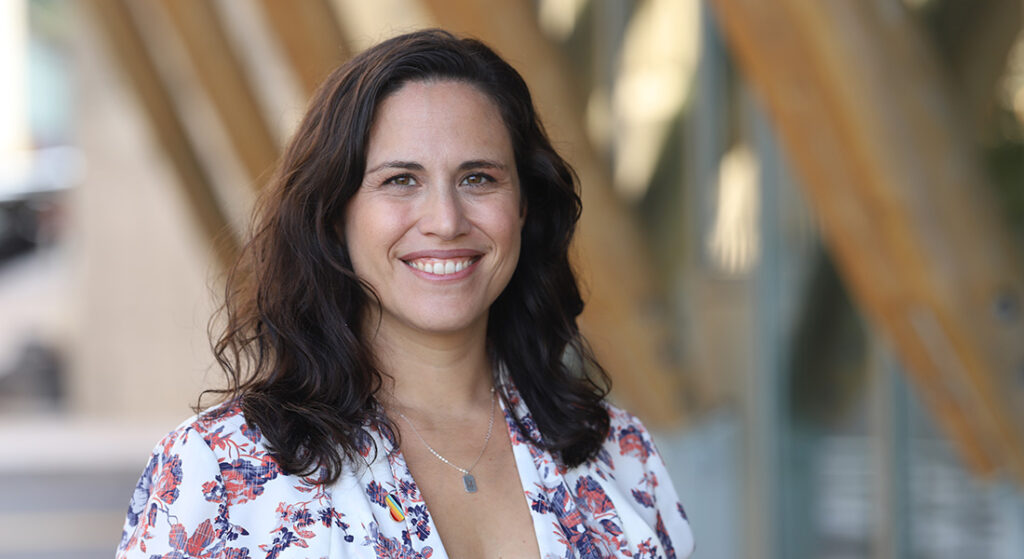
The College of Engineering and Computer Science is pleased to announce the transition of Melissa Young into a new role as Director of the Center for Sustainable Community Solutions – Environmental Finance Center (CSCS-EFC) at Syracuse University. CSCS-EFC is housed within the Department of Civil and Environmental Engineering. With her extensive leadership experience and dedication to sustainability, Young is poised to build upon the Center’s long and successful history and to continue developing impactful programming for the communities it serves.
Young has been an integral part of the CSCS-EFC team since 2008, previously serving as Director of Resource Conservation Initiatives. Throughout her career, she has played a pivotal role in public engagement, outreach, education, and technical assistance initiatives. Her programmatic effort was previously focused on sustainable materials management, encompassing crucial aspects such as waste reduction, reuse, and recycling. In her new position, Young will expand her scope to include initiatives related to water and wastewater infrastructure, particularly for rural and underserved populations, which she had worked on when she was first hired at Syracuse University.
The shift in leadership comes as CSCS-EFC celebrates its 30th year anniversary in 2023. Since 1993, CSCS-EFC has used a unique community-based approach to assist hundreds of municipalities across EPA Region 2, which includes New York, New Jersey, Puerto Rico, the U.S. Virgin Islands, and eight Native Nations. CSCS-EFC provides essential training and brings together a variety of governmental and nonprofit actors to collaborate on sustainability issues, including water infrastructure management, water equity, climate resiliency, resource conservation, and sustainable materials management. Since 2015, CSCS-EFC has been awarded $15.75 million in federal, state, and local grants to support communities by providing tools, technical assistance, outreach and education, research, and more.
“This is an exciting time for Syracuse University’s CSCS-EFC as it continues to lead the way in developing solutions for communities across EPA Region 2,” says J. Cole Smith, dean of the College of Engineering and Computer Science. “Melissa’s background and track record of proven results and positive impact will be essential to taking CSCS-EFC to even greater heights.”
“I am honored and deeply committed to lead our organization’s efforts to catalyze positive change and foster environmental stewardship, while engaging deeply with communities across our region and beyond,” says Young. “Together with our dedicated team and partners, we will continue to innovate and expand our impact, working to create a more sustainable and resilient future for all.”
Reducing Plastic Pollution
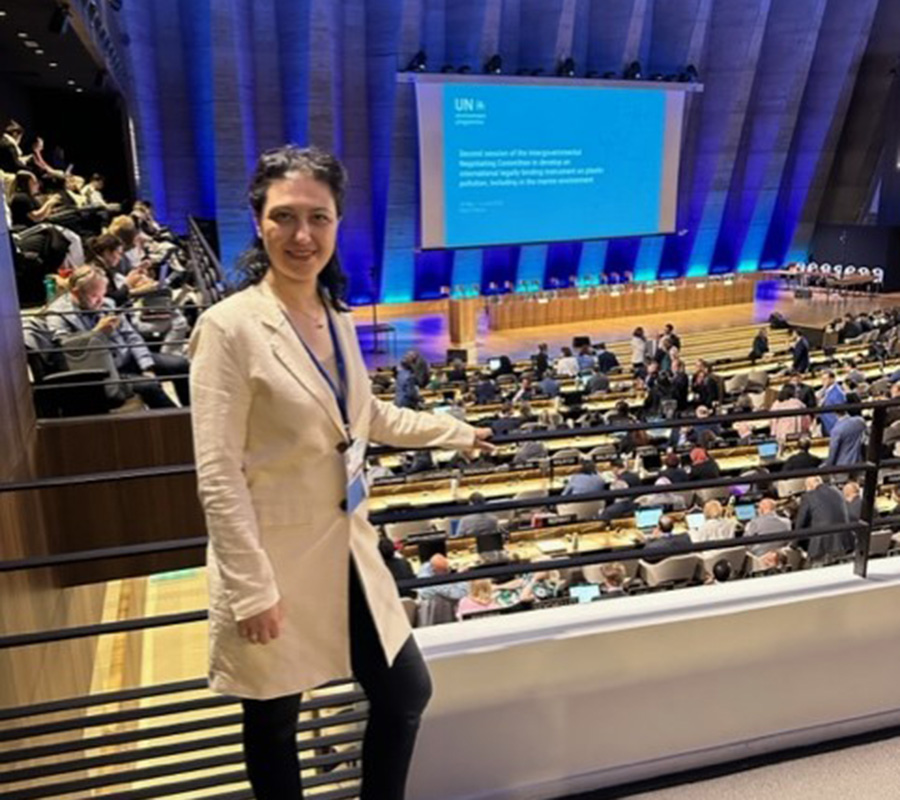
Civil and Environmental Engineering Professor Svetoslava Todorova attended the second session of the United Nations (UN) Intergovernmental Negotiations Committee on Plastics during the summer of 2023 in Paris, France.
Todorova joined representatives from UN member states, regional economic integration organizations, UN agencies and intergovernmental agencies in an attempt to develop an international legally binding instrument on plastic pollution, including in the marine environment. Unfortunately, the committee was unable to come to an agreement on a draft at the second session.
The next meeting of the committee will be held in November 2023 in Nairobi, Kenya. The committee has the goal of delivering a final agreement by the end of 2024.
“Overconsumption of plastics in a throw-away society generates a lot of waste. Much of it is not easily degradable and can persist in the environment. Single-use plastics visibly accumulate on the streets and in our waterways. I had hoped that the high visibility of problems connected to plastics pollution would make intergovernmental negotiations easier,” says Todorova. “Unfortunately, during the second session of the Intergovernmental Negotiations Committee, the delegates were locked in extensive discussions on basic principles and missed engaging in more substantive topics. This shows how difficult these negotiations will be and how challenging it will be to overcome divergent interests and opposition to progress in reducing plastics waste.”
Digging Deep into Soil Analysis
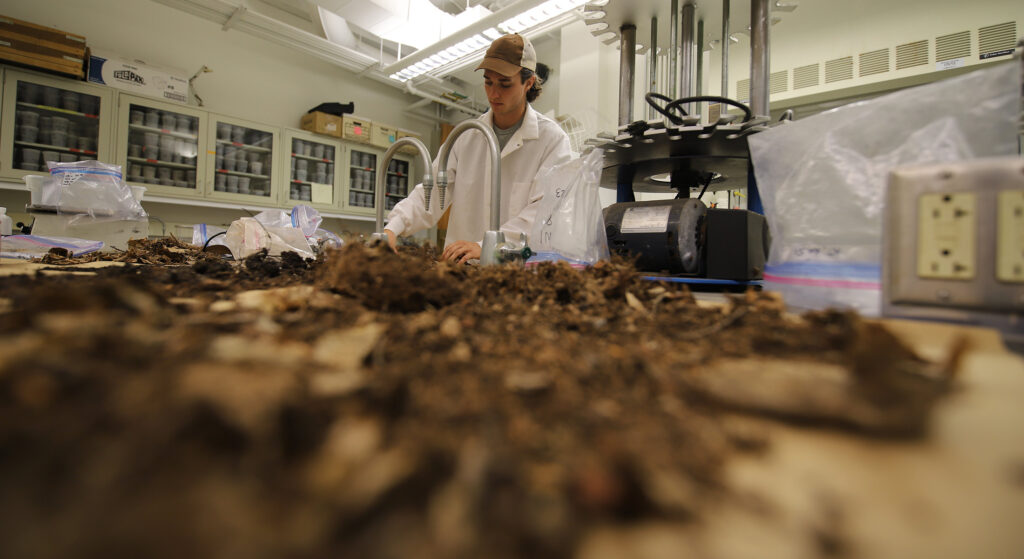
Whether he’s exploring rocky quarries, mountain biking on winding trails, or training for club gymnastics, Trygve Moler prefers the outdoors. Growing up in Montana, he spent his childhood playing in open fields and poking around the wilds, instilling in him a deep appreciation for nature.
“My family camped a lot when I was younger,” he said. “I grew up living on the edges of town with fields and ditches to explore. Even as I’ve gotten older, I’ll take any excuse to be outside.”
His strong connection to the outdoors also made him aware of the current climate crisis that’s affecting Montana. Soaring temperatures, blazing wildfires, and winters that rival Syracuse’s chilly seasons have wreaked havoc on his home state.
“It’s not hard to notice highly irregular snowfall, extreme forest fires, and smoke when I’m living through them. Right now, Montana is experiencing a serious heat wave,” he said. “Winter is also unpredictable. Sometimes we barely get snow, but other times we get more than expected.”
These experiences ultimately shaped Moler’s decision to pursue environmental engineering at Syracuse University and further explore his fascination with the natural world. “There really was never a question about it,” he said. “I knew I wanted to be an engineer when I saw environmental was an option. It was an immediate choice.”
With an internship under civil and environmental engineering professor, Chris Johnson, Moler has gained experience in environmental lab and field work while considering possible career paths. Alongside fellow interns in Johnson’s biogeochemistry laboratory, he’s spent his summer in New Hampshire and Link Hall analyzing phosphorus in soil samples.
Phosphate, a naturally occurring form of the element phosphorus, plays a crucial role in plant growth and development, providing the essential nutrients required for root growth, seed formation, and winter survival. When there’s a sufficient amount of phosphate in the soil, plants can grow to be healthier and stronger. But when there isn’t enough phosphorus, plant growth can be slow.
The soil samples are collected from the Hubbard Brook Experimental Forest in the White Mountains of New Hampshire. For decades, scientists have conducted research in the area to better understand the environment and forest ecosystems, making it an ideal spot for analyzing the role of soil phosphorus in forest health.
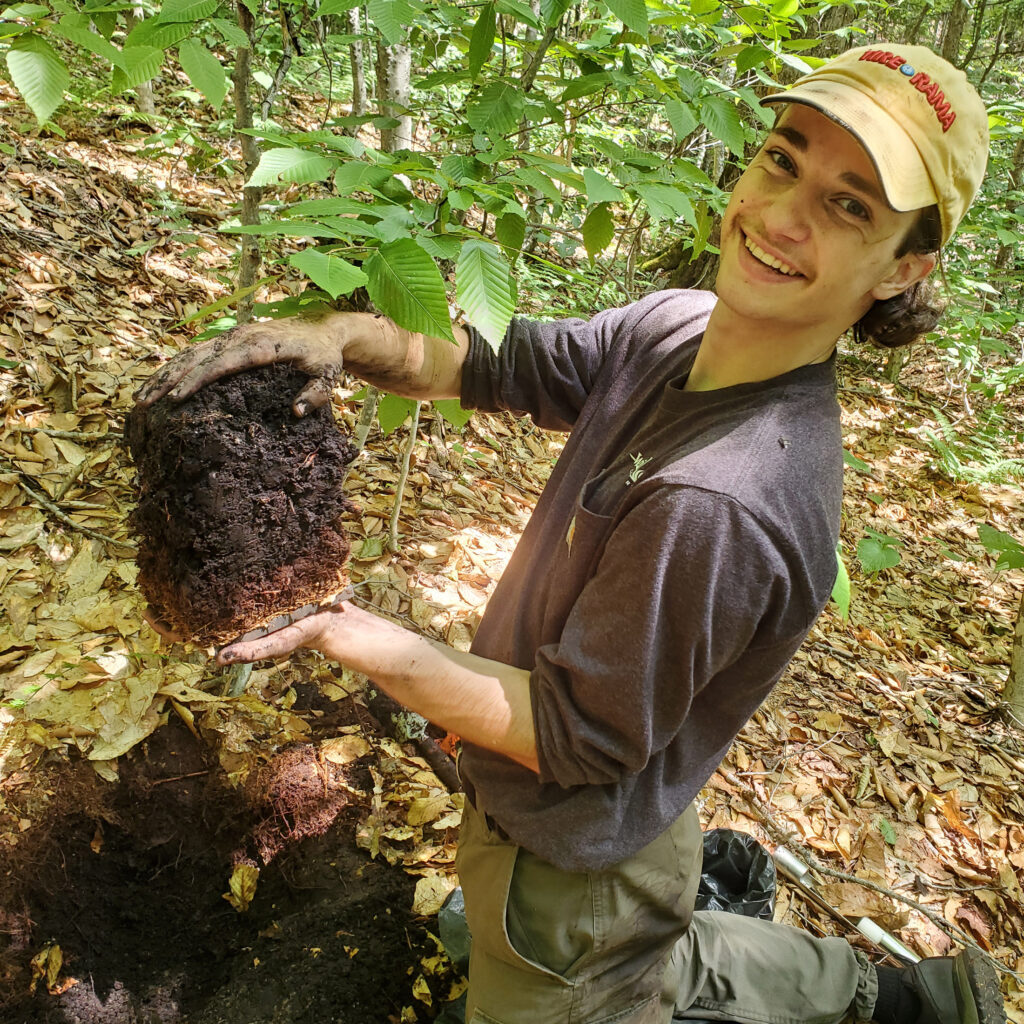
“Hubbard Brook has a unique history, as some of the most interesting experiments in terms of soil, water, atmosphere, and wildlife took place there,” Moler explained. “It also has some of the longest-running data sets in those fields, as it was founded in the 1960s. For the purposes of my group, Hubbard Brook has the perfect climate to slow the decomposition of organic matter in the soil to a matter of years rather than months, which allows us to study how phosphorus, and many other important nutrients, cycle through the soil.”
Moler’s trip to Hubbard Brook was an amazing opportunity for fieldwork. He and the team stayed in a cabin and journeyed through the wilderness on days it wasn’t raining. Trekking through lush green terrain and flowing brooks, the group used a watershed map with a grid as their guide.
In certain locations, there would be markers on the ground and on the map which would indicate the areas to collect soil samples from. The soil would be dug from the ground, placed into individual bags, and the size and volume of the soil sample would be recorded. On a typical day, each group would collect samples at between eight and 15 sites.
After collecting the samples at Hubbard Brook, Moler and his group returned them to the lab for analysis. He and another intern would take turns preparing the samples to extract various forms of soil phosphorus. The process involved weighing soil samples, mixing acids and bases, shaking them to promote the extraction, and centrifugation to separate the solids from the liquid. The extract solutions were then analyzed for phosphate and total phosphorus.
A segmented flow analyzer was used to analyze phosphate and total phosphorus concentrations in the extract solutions. This device utilizes spectrometry to measure light attenuation or transmittance to determine phosphate concentrations. Before running samples through the machine, the solution must be adjusted to a specific acidity level by adding acids and bases until the sample changes color. Once the solution reaches the desired acidity level, samples can be analyzed by the segmented flow analyzer to determine phosphate concentration in the soil.
“I really enjoy my research,” Moler said. “My coworkers and the lab space are great, and I think this experience will be invaluable in the coming years. This is the most involved work I’ve ever been a part of.”
While interning at the biogeochemistry laboratory, Moler was introduced to a field he never knew existed and soon discovered the vastness of environmental research. Something as seemingly simple as soil had extensive research and analysis. Even nutrients found within the soil like nitrogen also had entire papers and in-depth studies, which he found fascinating.
“All the chemistry I’m learning is new. I didn’t even know biogeochemistry crossed over,” Moler said. “That entire area was unknown to me, and I was shocked about how deep every component of it was, including all the elements in the soil. You can read so much about it and all the experiments people have conducted. It was interesting to discover.”
When Moler isn’t working at the segmented flow machine, he’s somewhere in the wilderness or participating in physical activities. He’s expressed interest in joining the university’s Outing Club, a pack of outdoor enthusiasts whose adventures consist of weekly trips, ranging from hiking trails to spelunking caves – there couldn’t be a more perfect club for him to join.
However, his adventurous spirit goes beyond internships and extracurricular activities. He intends to study abroad in Santiago, Chile, which will allow him to immerse himself in a new culture, explore unfamiliar places, and practice his Spanish.
“Chile was an easy choice for me. In my fourth year of Spanish, I reported on the culture, history, environment, and current affairs of Chile, so I’m already fairly invested in the country,” he said. “I think it’ll be a cool place to study and explore. I’ve also been studying Spanish for four years, so I would love to make the leap to complete fluency.”
Moler considers these experiences to be vital and encourages Syracuse students to seize every opportunity to enhance their college experience through internships, extracurricular activities, and study abroad programs. Such experiences have helped him gain clarity about his future goals and career aspirations.
“For jobs and internships, just get moving,” he said. “I struggled for my first semester to find any opportunities, but it just takes some time and continuous applied effort. Talk to your professors, send emails, ask questions, check on different options, apply regardless of the requirements, and things will happen, especially here in Syracuse.”
“On the other hand, never take yourself too seriously,” he added. “It’s easy to get wrapped up in these big leaps and bounds that college allows us to make. But always remember to take time to have fun and play like a kid.”
John Trimmer
Areas of Expertise:
- Water and sanitation in resource-limited settings
- Resource recovery from sanitation
- Sustainability analysis of water, sanitation, and resource systems
- Social-ecological systems
John Trimmer is an Assistant Teaching Professor in the Department of Civil and Environmental Engineering. He is interested in sustainable water and sanitation in resource-limited settings, as well as the possibilities associated with resource recovery from sanitation systems. He employs an interdisciplinary perspective to explore how these and other resource systems interact with economics, agriculture, ecology, and socio-cultural contexts to impact people and the environment. He has spent several years working on these topics throughout Africa, first as a Peace Corps Volunteer in Uganda and more recently in Nairobi, Kenya with The Aquaya Institute, a non-profit research organization focused on water, sanitation, and health.
Honors and Awards:
Environmental Science & Technology: Best Paper on Environmental Policy in 2020
Paul V. Roberts/AEESP Outstanding Doctoral Dissertation Award (2020)
AAEES/AEESP William Brewster Snow Award (2015)
Selected Publications:
Trimmer, J.T., Qureshi, H., Otoo, M., & Delaire, C. (2023). The enabling environment for citywide water service provision: Insights from six successful cities. PLOS Water, 2(6), e0000071.
Trimmer, J.T., Kisiangani, J., Peletz, R., Stuart, K., Antwi-Agyei, P., Albert, J., Khush, R., & Delaire, C. (2022). The Impact of Pro-Poor Sanitation Subsidies in Open Defecation-Free Communities: A Randomized, Controlled Trial in Rural Ghana. Environmental Health Perspectives, 130(6), 067004.
Li, Y., Trimmer, J.T., Hand, S., Zhang, X., Chambers, K.G., Lohman, H.A.C., Shi, R., Byrne, D.M., Cook, S.M., & Guest, J.S. (2022). Quantitative sustainable design (QSD) for the prioritization of research, development, and deployment of technologies: a tutorial and review. Environmental Science: Water Research and Technology, 8, 2439-2465.
Poulin, C., Trimmer, J.T., Press-Williams, J., Yachori, B., Khush, R., Peletz, R., & Delaire, C. (2022). Performance of a novel machine learning-based proxy means test in comparison to other methods for targeting pro-poor water subsidies in Ghana. Development Engineering, 7, 100098.
Echevarria, D., Trimmer, J.T., Cusick, R.D., & Guest, J.S. (2021). Defining Nutrient Colocation Typologies for Human-Derived Supply and Crop Demand to Advance Resource Recovery. Environmental Science & Technology, 55(15), 10704–10713.
Trimmer, J.T., Byrne, D.M., Houser, S.A., Lohman, H.A.C., Jjuuko, F., Katende, D., Zerai, A., Banadda, N., Miller, D.C., & Guest, J.S. (2020). Navigating multidimensional social-ecological system tradeoffs across sanitation alternatives in an urban informal settlement. Environmental Science & Technology, 54(19), 12641-12653.
Trimmer, J.T., Miller, D.C., Byrne, D.M., Lohman, H.A.C., Banadda, N., Baylis, K., Cook, S.M., Cusick, R.D., Jjuuko, F., Margenot, A.J., Zerai, A., & Guest, J.S. (2020). Re-envisioning sanitation as a human-derived resource system. Environmental Science & Technology, 54(17), 10446-10459.
Trimmer, J.T., & Guest, J.S. (2020). GIVE: A framework of assumptions for constructive review feedback. Environmental Science & Technology, 54(19), 11648-11650.
Trimmer, J.T., Miller, D.C., & Guest, J.S. (2019). Resource recovery from sanitation to enhance ecosystem services. Nature Sustainability, 2(8), 681-690.
Trimmer, J.T., Margenot, A.J., Cusick, R.D., & Guest, J.S. (2019). Aligning product chemistry and soil context for agronomic reuse of human-derived resources. Environmental Science & Technology, 53(11), 6501-6510.
Trimmer, J.T., & Guest, J.S. (2018). Recirculation of human-derived nutrients from cities to agriculture across six continents. Nature Sustainability, 1, 427-435.
Trimmer, J.T., Cusick, R.D., & Guest, J.S. (2017). Amplifying progress toward multiple development goals through resource recovery from sanitation. Environmental Science & Technology, 51(18), 10765-10776.
Trimmer, J.T., Nakyanjo, N., Ssekubugu, R., Sklar, M., Mihelcic, J.R., & Ergas, S.J. (2016). Estimation of Ascaris lumbricoides egg inactivation by free ammonia treatment of ash-amended UDDT vault products using stored urine in Uganda. Journal of Water Sanitation and Hygiene for Development, 6(2), 259-268.
Trimmer, J.T., Nakyanjo, N., Ssekubugu, R., Sklar, M., Mihelcic, J.R., & Ergas, S.J. (2016). Assessing the promotion of urine-diverting dry toilets through school-based demonstration facilities in Kalisizo, Uganda. Journal of Water Sanitation and Hygiene for Development, 6(2), 276-286.
Lohman, H.A.C., Trimmer, J.T., Katende, D., Mubasira, M., Nagirinya, M., Nsereko, F., Banadda, N.E., Cusick, R.D., & Guest, J.S. (2020). Advancing sustainable sanitation and agriculture through investments in human-derived nutrient systems. Environmental Science & Technology, 54(15), 9217-9227.
In Civil Engineering We Truss

The Jesús Izcoa Moure Bridge in Puerto Rico perfectly shows how looks can be deceiving. While it may appear free of noticeable damage when driven over, standing on the bridge reveals that it moves more than expected. This is due to its design as a cable-stayed bridge, where cables play a crucial role in balancing tensions and compressions while distributing weight to the piers and beams. However, the bridge has some cracks in its structure and moves slightly more than it should.
Rest assured, the bridge isn’t on the verge of collapse, but it is structurally deficient. This term is used by engineers to describe structures that aren’t in the best shape but still safe to use. And it’s more common than you think. In fact, more than a third of bridges in the United States are structurally deficient as of 2022. However, recent investments in construction aim to tackle the problem of aging infrastructure throughout the country.
Assisting in efforts to improve infrastructure, civil engineering student Alex Torres is currently spending the summer in his home country Puerto Rico gaining structural engineering experience. With the Carrasquillo Engineering Service Group, they’re on a mission to repair the Jesús Izcoa Moure Bridge and other structures in Puerto Rico to ensure their safety.
Wearing a helmet, vest, and steel-toe boots, Torres and the service group inspect cracks underneath the bridge, focusing on the beams, which act as the bridge’s support. Using scaffolding to get a better view and make their way around the structure, they also close lanes to restrict the flow of traffic as they scrape and refill areas of the bridge. This is all to balance tension and distribute weight to prevent the bridge from accumulating more pressure and collapsing.
“The bridge is divided into 6 spans and each span is subdivided into 4 squares. The spaces that need to be scrapped or refilled along the bridge are being identified,” Torres explained. “The purpose is that the bridge ends up as leveled as possible and with the most reasonable slope.”
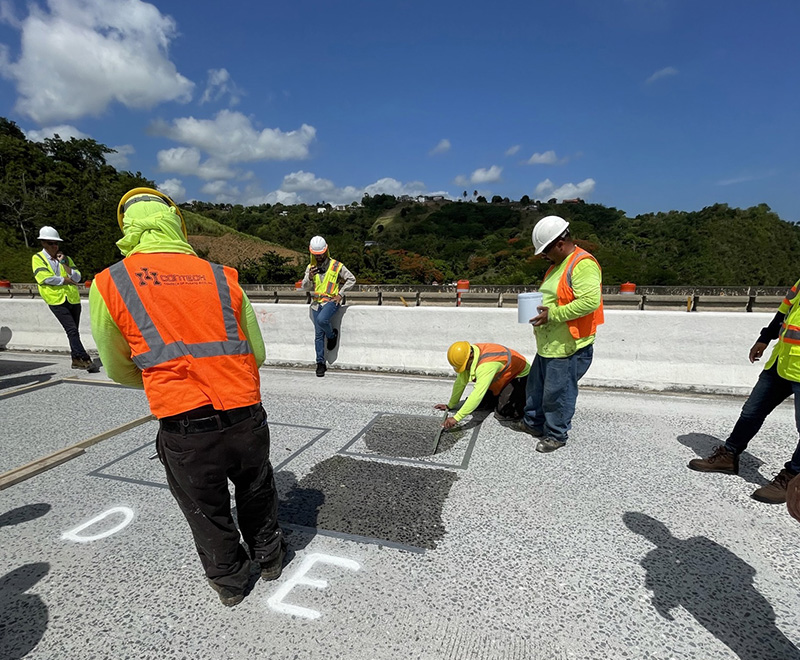
Torres uses a device called Ground Penetrating Radar to avoid damaging crucial structural areas of the bridge. This device sends frequencies to the ground that bounce back when they detect iron rods in the concrete that support the bridge. The frequency data is then passed to a computer, which analyzes wavelengths and shows the highest points. This process determines the depth of any cables, wire tubes, or important structures beneath the concrete, and with this information, Torres can determine the amount of scraping required for the bridge repair that won’t cause damage to crucial areas.
“The highest point in the wavelengths determines how close under the surface the rod is. Therefore, with this you can calculate the maximum clear cover which tells you how deep you can scrape without touching the rods” Torres said.
Bridges aren’t the only infrastructures Torres has been inspecting. He also got the chance to collect data at a structurally deficient parking garage. Using ZipLevel, a tool that measures elevation with pressure through gravity, the multilevel garage was a great opportunity for him to see other structures in need of repair and devices civil engineers utilize in the field. Torres noticed that engineers could get creative with tools, seeing firsthand how experienced engineers would use devices for different purposes.
“I noticed how the engineers were analyzing ways to gather data in the field. When discussing how to approach certain repairs, one of them would come up with the idea to use a tool or device that no one else would’ve thought of using for that specific task. Sometimes you can adapt a device you used previously to something else and make it work perfectly for what you need.”
Despite hours spent in the tropical heat, Torres is excited to be working on location. The opportunity to collect data and gain practical experience is invaluable to him – he’d much rather do this than input information in an air-conditioned office. He also had the chance to view a construction plan for the bridge, which provided him with more exposure to the intricacies of civil engineering – an experience he would’ve never had if he weren’t on site.
“I saw a detailed plan of how the bridge was going to be built, including the materials and all the other details. It was interesting because each project has a plan like this. It’s what everyone follows when the project begins,” Torres said. “Seeing one firsthand was fascinating. When I become an engineer and start my own projects, I’ll also have to follow a plan like that. It was an amazing experience. Being able to read one so early on is a blessing.”
Torres enjoyed applying lessons learned from his Engineering and Computer Science courses, like ECS 101, to his current work. Understanding bridge tensions, compressions, and force dynamics helped him make connections between his work experience and classroom education. Additionally, his familiarity with AutoCAD, a software program used by architects and engineers to create model structures, proved useful during the bridge repair process.
When the service group isn’t collecting data or repairing damaged areas, Torres chats with the other engineers about their experiences, which provides him with an opportunity to explore different career paths within civil engineering. With the vast array of options available in this field, he’s narrowed his focus to structural and construction engineering as possible career choices after graduation.
“I think it’s good to have a sense of what you would be working on after you graduate,” Torres said. “It’s motivated me to study harder in school. I’m grateful for what I’ve learned at ECS and this experience.”
Torres also encouraged students to participate in various activities to make the most of their time at ECS. He emphasized the importance of pursuing one’s interests and being a part of the community. Not only has his experience allowed him to gain more exposure in civil engineering but it’s also allowed him to build a future for himself.
Civil and Environmental Engineering Professor Charles Driscoll Selected for the 2023 Clarke Prize in Water Science

Civil and Environmental Engineering Professor Charles Driscoll has been selected to receive the 2023 Athalie Richardson Irvine Clarke Prize for Outstanding Achievement in Water Science and Technology from the National Water Research Institute. Driscoll is the University and Distinguished Professor of Environmental Systems Engineering in College of Engineering and Computer Science.
The Clarke Prize is considered one of the most prestigious awards pertaining to water science. It is awarded to thought leaders in water research, science, technology, or policy in the United States. Past honorees have included some of the most significant figures in civil and environmental engineering; the water, biological, physical, chemical, health, and political sciences; and public planning and policy.
Driscoll’s research largely involves characterization and quantifying the impacts of air pollution, such as acid rain and mercury, changing climate, and land and water disturbances on the structure and function of ecosystems, and pathways of ecosystem recovery. Much of his work has focused on forests and associated aquatic resources, including long-term studies at the Hubbard Brook Experimental Forest, NH and the Huntington Forest in the Adirondacks, NY. Recent work has included strategies for the decarbonization of sectors and achieving net zero greenhouse gas emissions.
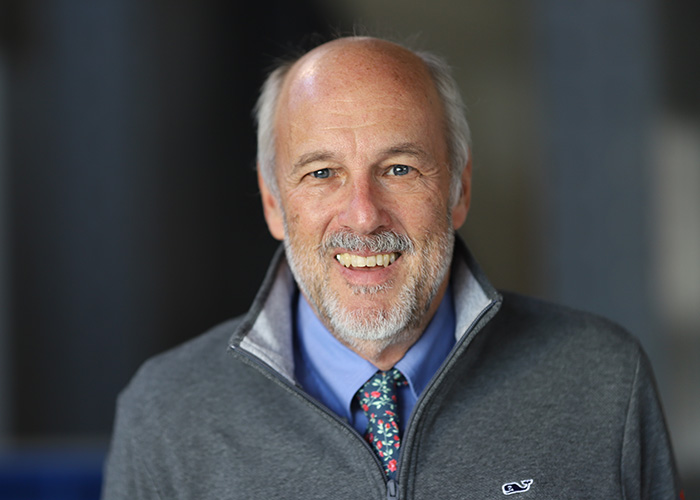
Over the past 40 years, Driscoll has advanced new analytical techniques, established and maintained long-term measurements and experiments, and developed a series of research and predictive models that simulate transformations of major chemical elements in forest vegetation, soil and surface waters in response to air pollution, climate and land disturbance. Beyond theory, he is interested in testing ‘in situ’ strategies to reverse the damaging effects of acid rain and mercury contamination, eutrophication, urbanization, and climate change. Driscoll has testified at US Congressional and state legislative committee hearings, and provided briefings to government agencies, industry and stakeholder groups on environmental issues. He has served on local, national and international committees pertaining to environmental management and policy.
Driscoll will receive the award and give a lecture in Irvine, California, on October 21, 2023. For information about attending the event, fill out the form on the Clarke Prize page.
Aaron Mohammed
Areas of Expertise:
Cold regions hydrology and hydrogeology
Permafrost thaw
Numerical modeling of hydrological processes
Coastal hydrogeology
Aaron Mohammed is an Assistant Professor in the Departments of Earth and Environmental Sciences and Civil and Environmental Engineering. His research focuses on the hydrology and hydrogeology of environments undergoing rapid changes due to climate warming and increased development. He is interested in the movement of water, energy, and chemicals through landscapes, and their interacting effects on hydrologic processes such as permafrost thaw, groundwater recharge, seawater intrusion, and contaminant transport. His research aims to improve our understanding of, and ability to predict, hydrological processes in a changing climate, and develop management strategies to enhance the resiliency of water and ecosystem resources.
Selected Publications:
Mohammed, A.A., Kurylyk, B.L., Cey, E.E., & Hayashi, M. (2018). Snowmelt infiltration and macropore flow in frozen soils: Overview, knowledge gaps, and a conceptual framework. Vadose Zone Journal, 17(1), 1-15.
Mohammed, A.A., Pavlovskii, I., Cey, E.E., & Hayashi, M. (2019). Effects of preferential flow on snowmelt partitioning and groundwater recharge in frozen soils. Hydrology and Earth System Sciences, 23(12), 5017-5031.
Mohammed, A.A., Bense, V.F., Kurylyk, B.L., Jamieson, R.C., Johnston, L.H., & Jackson, A.J. (2021). Modeling reactive solute transport in permafrost‐affected groundwater systems. Water Resources Research, 57(7), e2020WR028771.
Guimond, J.A., Mohammed, AA., Walvoord, M.A., Bense, V.F., & Kurylyk, B.L. (2021). Saltwater intrusion intensifies coastal permafrost thaw. Geophysical Research Letters, 48(19), e2021GL094776.
KarisAllen, J.J., Mohammed, A.A., Tamborski, J.J., Jamieson, R.C., Danielescu, S., & Kurylyk, B.L. (2022). Present and future thermal regimes of intertidal groundwater springs in a threatened coastal ecosystem. Hydrology and Earth System Sciences, 26(18), 4721-4740.
Mohammed, A. A., Guimond, J. A., Bense, V. F., Jamieson, R. C., McKenzie, J. M., & Kurylyk, B. L. (2022). Mobilization of subsurface carbon pools driven by permafrost thaw and reactivation of groundwater flow: a virtual experiment. Environmental Research Letters, 17(12), 124036.
Civil and Environmental Engineering Professor Zhao Qin Recognized as International Association of Advanced Materials Fellow

Zhao Qin, assistant professor of civil and environmental engineering in the College of Engineering and Computer Science (ECS), has been selected as an International Association of Advanced Materials (IAAM) Fellow in recognition of his contribution to the Advancement of Materials to Global Excellence. He will deliver an IAAM Fellow Lecture in the Advanced Materials Lecture Series 2023.
Founded in 2010, IAAM has been the leading advocate for advancements in advanced materials science, engineering, and technology. With its focus on social implications, the non-profit scientific organization encourages scientists to consider the broader impact of their work and aims to foster open and informed conversations in science, engineering and technology.
The primary aim of the organization is to optimize the resourcefulness of the world of science to improve the quality of human life by conducting high-quality research. Boasting a roster of over 7,500 scientists and invited speakers from over 100 countries, IAAM’s Advanced Materials Lecture Series hosts talks by renowned scientists, promoting innovation and sustainability for an eco-friendly world.
“I am deeply honored to be named as an IAAM Fellow,” Qin said. “This recognition is a testament to our group’s dedication and hard work on material innovation studies by integrating multi-scale computational modeling and experiments. It is also a reflection of the exceptional support and commitment of my students and colleagues. I would like to express my heartfelt gratitude to my students, whose enthusiasm and eagerness to learn have constantly inspired me to strive for excellence in my teaching and mentorship.
“Their inquisitive minds and unwavering determination have been instrumental in shaping my approach as an educator. Additionally, as a junior faculty member, I am incredibly grateful to my colleagues in my department and school for their invaluable collaboration, guidance, and encouragement throughout this journey. Their expertise and unwavering support have fostered an environment of growth and innovation, enabling me to reach new heights in my research endeavors.”
Civil and Environmental Engineering Professor Sam Clemence to Receive Deep Foundations Institute Legends Award
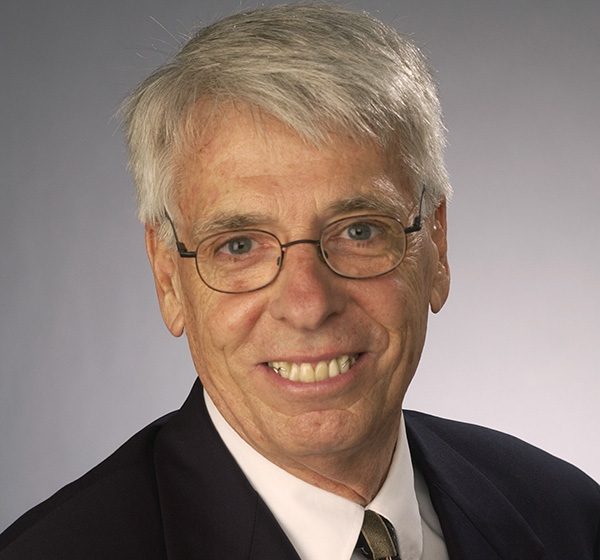
The Deep Foundations Institute (DFI) and the DFI Educational Trust Legends Committee has chosen Civil and Environmental Engineering Professor Sam Clemence as a recipient of one of the DFI Legends Awards for 2023. This award was established to honor practitioners that have made significant contributions and advancements to the research, design, construction, manufacturing and use of deep foundations.
The following criteria were considered by the committee:
· Impact, value and sustainability of achievements
· Legacy
· Pioneering contributions
· Exceptional industry leader; visionary, mentor
· Technological ingenuity, innovation and/or application of advancements of design, construction or equipment
· Steadfast professionalism, character and integrity
· Ingenuity of design and construction techniques
· Broad impact on industry
Clemence has more than 40 years of teaching experience at Syracuse University in the College of Engineering and Computer Science. His academic work focuses on geotechnical engineering, soils and foundation design, and history of technology. Selected as a Laura J. and L. Douglas Meredith Professor of Teaching Excellence in 1996, Clemence has received several teaching and professional honors, and has numerous publications.
“I am honored to receive this wonderful award. My research and design work has always been a team effort with invaluable contributions from graduate students, faculty colleagues and industry partners. I am so grateful for the Deep Foundations Institute for this recognition,” says Clemence.
“Sam is a valued member of the department and a beloved colleague and instructor,” says Civil and Environmental Engineering Department Chair Andria Costello Staniec. “I am thrilled to see his research accomplishments and his lifelong work recognized by DFI. I can think of no one more deserving of the Institute’s Legend Award than Sam.”
The award will be presented during the DFI’s 48th Annual Conference in Seattle from October 31-November 3, 2023.
Spring 2023 Engineering and Computer Science Academic Department Awards

The College of Engineering and Computer Science is proud to announce the students who received awards at the end of the 2022-2023 academic year from their academic department.
Biomedical and Chemical Engineering
The Bioengineering Founders Award
Grace Haas
Karen M. Hiiemae Outstanding Achievement Award in Bioengineering
Gabriel Khan
Oren Nagasako Award
Megan Perlman
Outstanding Achievement Award in Chemical Engineering
Adam Klinger
The Allen J. Barduhn Award
Jacob Shellhamer
Outstanding Graduate Student in Biomedical Engineering
Tackla Winston
Outstanding Graduate Student in Chemical Engineering
Robson Schuraca
Civil and Environmental Engineering
Outstanding Achievement Award in Environmental Engineering
Benjamin Cavarra
K.L. Lui Memorial Award
Aymeric Destrée
The John Burch McMorran ’22 Award
Adam Landry
Outstanding Graduate Student in Civil & Environmental Engineering
Joseph Wasswa
Dr. James A. Mandel Prize for Achievement in Civil and Environmental Engineering
Haben Legesse
Samuel P. Clemence Prize for Outstanding Senior Design
Nagdalina Baez
Masson Bruening
Benjamin Cavarra
Kate Kemnitz
Adam Landry
Civil & Environmental Engineering Faculty Awards
Kate Kemnitz
Paige Yamane
Electrical Engineering and Computer Science
The Warren Semon Prize
Ryan M. May
Outstanding Achievement Award in Computer & Information Science
Matthew J. Cufari
Outstanding Achievement Award in Computer Engineering
Kyle D. Maiorana
The Outstanding Achievement Award in Electrical Engineering
Jared W. Welch
Outstanding Graduate Student in Computer Engineering
Sihao Ren
Outstanding Graduate Student in Computer Science
Sai Saran Macha
Outstanding Graduate Student in Electrical Engineering
Nicholas S. Connolly
The IEEE Computer Engineering Award
Mehak Jetly
The IEEE Electrical Engineering Award
Jemma Mallia
IEEE PES Scholarship
Jemma Mallia
Outstanding Graduate Student in Cybersecurity
Kyungrok Won
William Peil Awards
Kyle Maiorana
Julia Pepin
Wyatt G. Bush
Samsondeen Batula
Mechanical and Aerospace Engineering
Outstanding Aerospace Engineering Academic Achievement Awards
Anthony Tricarico
Christian Fitzgerald
Award for Excellence by Aerospace Engineering Senior
Evan Moore
Award for Achievement by Aerospace Engineering Senior
Madeline Phelan
The Richard Heimburg Achievement Award in Aerospace
Zachary Stahl
Charles Libove Memorial Award for Outstanding Aerospace Senior
Melissa Yeung
Award for Excellence by Aerospace Engineering Junior
Sydney Jud
Zachary Haas
Awards for Achievement by Aerospace Engineering Juniors
Isaac Lehigh
Cody VanNostrand
Benjamin Gerard
Ross Evan-Iwanowski Memorial Award
John Michinko
Ellen H. Honnold Memorial Scholarship
William Saueressig
Awards for Excellence by Aerospace Engineering Sophomores
Jonathan Martin
Parker McMillan
Awards for Achievement by Aerospace Engineering Sophomores
Alexander Donato
Kathryn Smith
Kin-Nee Tong Award
Maximillian Lipinski
Awards for Achievement by Aerospace Engineering First Year Students
Quinn Young
Zachary Munkacsy
Jason Reid
Joshua Varkey
William Peil Inventor’s Award
Christian Fitzgerald
Madeline Phelan
Katherine Braun
Outstanding Mechanical Engineering Academic Achievement Award
Joshua Arndt
Award for Achievement by Mechanical Engineering Senior
Nathaniel Slabaugh
Jay Wyner Award for Excellence in Mechanical Engineering
Luyen Duong
Bernard Wood Creative Achievement Award in Mechanical Engineering
Arnaud Buard
Jesse E. Rood Memorial Scholarship
Eric Silfies
Karl Carnevale Memorial Scholarships
Zachary Shuler
Awards for Achievement by Mechanical Engineering Juniors
Honorata Lubecka
Alexander Callo
Hugh C. Dugan Memorial Scholarships
Joseph Capra
Bei Luo
Award for Excellence by Mechanical Engineering Sophomore
Chloe Marie Britton Naime
Awards for Achievement by Mechanical Engineering Sophomores
Nathaniel Paradis
Jeffrey Bernstein
Aidan Bergman
James Melitski
Kin-Nee Tong Memorial Scholarship
Brinley Bruening
Kin-Nee Tong Award
Madeline Scott
Awards for Achievement by Mechanical Engineering First Year Students
Jennifer Mason
Gavin Johnson
William Peil Inventor Awards
Justin Kohan
Connor Norton
Melissa Jane Hiller
Kaelyn Rooney
Renee Allison
Louis N. DeMartini Award for Outstanding Research
Eric Silfies
Outstanding Graduate Student in Engineering Management
Ethan Tracey
Outstanding Achievement Award in Graduate Study
Camila Alexandra Humala Noriega
Outstanding Faculty Award
Professor Shalabh Maroo
Mechanical and Aerospace Engineering Award for Teaching Excellence
Professor Alexander Deyhim
Career Focused: Engineering and Computer Science Class of 2022 Reporting High Placement Rate
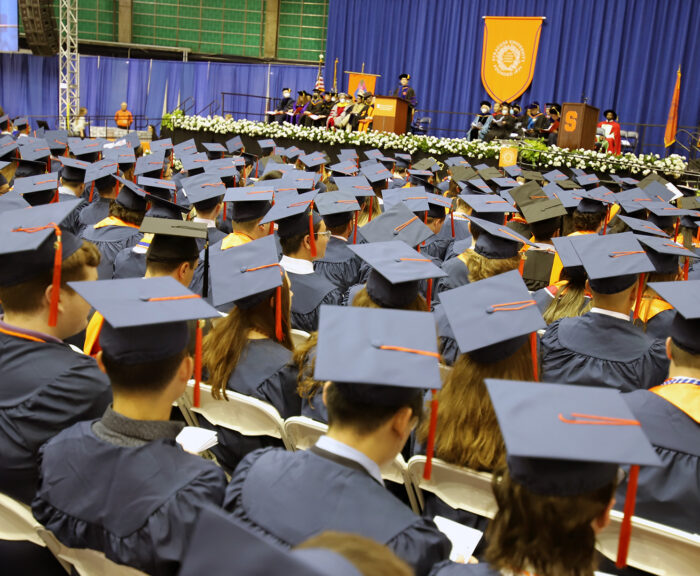
The starting salaries for graduates receiving a Bachelor of Science degree from the College of Engineering and Computer Science (ECS) has grown steadily for the last six years.
The average starting salary for the class of 2022 was $76,679. A total increase of $17,000 since 2016.
The placement rate for the class of 2022 was 93%. More than half of all graduates have started their careers and 33% are pursuing an advanced degree.
The ECS Career Services team provides students with support to reach their professional goals. They help students build their network with connections to industry leaders and alumni through information sessions, company tabling, career fairs, on-campus interviewing and more. Additional support through workshops, seminars, and drop-in advising ensures students have access to development opportunities that give them an edge in today’s job market.
Class of 2022 Top 25 Employers
- Applied Materials
- Boston Scientific
- Brainlab
- Bristol Myers Squibb
- Burns & McDonnell
- Carrier
- Deloitte
- General Dynamics, Electric Boat
- IBM
- Kimley-Horn
- L3Harris Technologies
- Lockheed Martin
- Meta
- Morningstar, Inc.
- National Grid Pfizer, Inc.
- Pratt & Whitney, a Raytheon Technologies Company (RTX)
- Qualcomm
- SRC, Inc
- The Boeing Company
- The Walt Disney Company
- Turner Construction Company
- Weston & Sampson
- Whiting-Turner Contracting Company
- WSP
Class of 2022 Graduate Schools
- Boston University
- Brown University
- Clarkson University
- Columbia University
- Cornell University
- Duke University
- Georgia Institute of Technology
- Icahn School of Medicine at Mount Sinai
- Northwestern University
- Princeton University
- SUNY Binghamton
- SUNY Stony Brook
- Syracuse University
- University North Carolina, Wilmington
- University of Maryland, College Park
- University of Michigan
- University of Minnesota
- University of Southern California
Data reflects information on 281 of 312 undergraduate degree recipients in 2022, representing a 90% knowledge rate.
Advocating for Effective Environmental Action
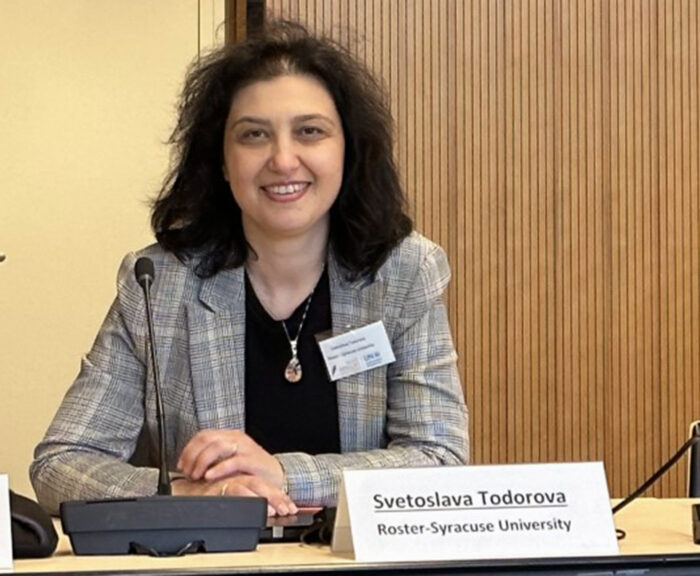
The work of environmental engineers and scientists is governed by regulations. In international negotiations and conventions, governmental representatives make the final decisions, but representatives from non-governmental organizations are sought to inform the process. It is a critical role because input from experts shape the regulations to ensure the best possible outcomes for our environment. Civil and Environmental Engineering Professor Svetoslava Todorova has been involved with the United Nations Environment Programme (UNEP) since 2010. The UNEP is responsible for coordinating responses to environmental issues within the United Nations.
“I have been passionate about participating in international efforts to address environmental issues since a young age. It has been an incredible journey to build and direct my professional life around this cause, and I am excited to make the most of this opportunity,” says Todorova.
Todorova started as a science observer during the UNEP intergovernmental negotiations on mercury. Those negotiations led to the development of the Minamata Convention on Mercury in 2013. The purpose of the convention was to draft an international treaty designed to protect humans and the environment from the release of mercury compounds. Todorova made an important contribution to the treaty and continued her involvement.
“One specific contribution was a sentence in the treaty text that considers the co-benefits of treatment technologies,” says Todorova. “Now, I am part of a scientific group that was formed in 2022 to develop the framework for assessing the Convention’s implementation.”
Todorova’s involvement with the UNEP evolved out of the Minamata Convention. From 2017-2019 she served as a communications liaison for the Fate and Transport group under the Global Mercury Partnership, a scientific advisory body on mercury to the UNEP. In June 2022, she became a member of a working group that was tasked with the development of a framework for a future science-policy panel on the management of chemicals and waste. In October 2022, she was elected to a group tasked with developing a plan to evaluate the effectiveness of the Minamata Convention.
“The group’s mandate is to provide a plan for data analysis and identify any existing gaps in monitoring, which will be presented to the 5th Conference of Parties (COP) of the Convention in October 2023 for discussion and voting,” says Todorova.
The COP is the governing body of the convention that makes decisions for its implementation and evaluation. Todorova’s involvement in the mercury negotiations has enabled Syracuse University to become an accredited observer institution, allowing students and faculty to participate in the COP.
“The accredited observer status given to Syracuse University provides opportunities to contribute to the work of the UNEP,” says Todorova. “Being an accredited observer under one convention allows us to participate in the negotiation and implementation of other Multilateral Environmental Agreements (MEAs), such as the recent negotiations on a new treaty to address global environmental issues on plastics. This ensures that we have a continuous presence and input on the process.”
In November 2019, Todorova brought a group of 11 students to attend COP3 of the of the Minamata Convention as part of an Honors course on environmental science-policy. At the COPs, students have the opportunity to sit amongst policymakers and get a sense of the complexity of negotiating agreements on environmental issues. This fall another group of students will have a similar opportunity.
“I am teaching The Role of Science in Environmental Governance in the fall of 2023. As part of the class, students and I will travel to Geneva, Switzerland to attend COP5 of the Minamata Convention on Mercury,” says Todorova.
Todorova says Syracuse University and ECS have been very supportive of her involvement with the UNEP. Her work embodies the College of Engineering and Computer Science’s commitment to meaningful interaction with the world and positively impacting the public.
“I started attending the negotiations for the Minamata Convention on Mercury while I was still a doctoral student in the civil and environmental engineering department,” says Todorova. “Over the years, my participation has been supported with the financial support of the Graduate Student Organization, the Civil and Environmental Engineering Department, and the Dean’s Office at the College of Engineering and Computer Science.”
Learning Through Research: Hennecys Perez Castro ’25

Hennecys Perez Castro is a sophomore environmental engineering major from the Bronx, NY. In her short time at the College of Engineering and Computer Science (ECS), Hennecys has participated in the Air Force ROTC program, a Marine officer program, she is an active member of the Society of Hispanic Professional Engineers (SHPE), and she is doing paid research relevant to her field of study.
“Doing research creates a great baseline to explore what you want to do. Being at an R1 university means there is a lot of funding and that opens up a lot of opportunity,” says Hennecys.
Hennecys learned about research opportunities through ECS Laboratory Manager and SHPE advisor Mario Montesdeoca. He helped her get started as a trainee in the environmental engineering labs as a first-year student. It gave her an opportunity to ask questions and learn how to apply for a Research Experience for Undergraduates.
Hennecys’ first research project involved measuring CO2 and O2 concentrations from different soil depths to explore soil respiration response and testing new low-cost CO2 sensor technology. During the fall semester of her sophomore year, she presented her research at the Long-Term Ecological Research All Scientists Meeting in California and took second place in a poster competition.
In addition to her ongoing CO2 censor testing, Hennecys is facilitating a lab project under University Professor of Environmental Systems and Distinguished Professor Charles Driscoll. The project involves conducting a sediment core analysis on samples collected from Skaneateles Lake just west of Syracuse. The research is a continuation of a larger project aimed at determining how the lake sediment is evolving due to the environment. Currently, Hennecys and her lab partner Oliver Raycroft are prepping the samples for chemical extraction. Once extracted, they will begin a data analysis to determine the effects of algae blooms, marine life viability, and to measure phosphorus concentration.
“The samples in the sediment cores tell a story. This research is small part of a bigger story,” says Hennecys. “The overall goal is important because this is information people need and can use.”
Research has helped Hennecys build a network and skillsets that will be important for her career development. It’s just one example of how she is utilizing resources available through ECS to prepare for her future. She says the support she has received through the ECS Office of Inclusive Excellence and SHPE, along with participation in several Syracuse University student leadership programs has augmented her education.
“Taking about my research has taught me how to present to a non-engineering audience. Overall, research is helping me learn skills I need to incorporate as I look forward to my career,” says Hennecys. “In addition to being a peer leader and an orientation leader, research helps me connect with others and build my confidence for post-graduation.”
Funding for Hennecys’ research is provided by Collegiate Science and Technology Entry Program, Louis Stokes Alliance for Minority Participation Program, the National Aeronautics and Space Administration (NASA), and the The Syracuse Office of Undergraduate Research and Creative Engagement.
Aerospace and Civil Engineering Students Selected as Goldwater Scholars

Two students from the College of Engineering and Computer Science (ECS) have been selected for the 2023 Goldwater Scholarship, the preeminent undergraduate scholarship awarded in the natural sciences, engineering and mathematics in the United States. Cody VanNostrand, a junior aerospace engineering major, and Jose Arturo Venegas, a sophomore civil engineering major, were the students selected from ECS. Matthew Snyder, a psychology major from the College of Arts and Sciences, was also selected for a Goldwater Scholarship. This is the second consecutive year that Syracuse University has had three scholars selected in one year.
The Barry Goldwater Scholarship and Excellence in Education Program was established by Congress in 1986 to honor U.S. Sen. Barry Goldwater, the five-term senator from Arizona. The purpose of the program is to provide a continuing source of highly qualified scientists, mathematicians and engineers by awarding scholarships to students who intend to pursue research careers in these fields.
The Goldwater Foundation received 1,267 nominations this year from around the country and 413 students were selected for the scholarship.
Each of the Syracuse University Goldwater Scholarship nominees worked with the Center for Fellowship and Scholarship Advising (CFSA) to prepare their application. A faculty committee, headed by James Spencer, professor of chemistry, selected Syracuse’s nominees for the national competition.
Cody VanNostrand
VanNostrand’s drive to study aerospace engineering comes from his desire to benefit society, specifically through improving transportation and aerospace vehicle capabilities. “Whether it be the upcoming urban air mobility industry, fluid-traversing robots or new types of space propulsion, a more mobile society will be able to better collect information and respond to the challenges it will face,” he says. “The aerospace field is one that is forward-looking, always with new ideas, technologies and challenges just around the corner, and I am excited to help create new ideas and solve such challenges.”
His study abroad experience in Florence, Italy, confirmed his intended path of study. “I was able to visit museums in my free time featuring the original instruments of scientists and engineers such as Galilei, DaVinci and even Bernoulli. Seeing the original instruments and how they directly related to the fundamental concepts of my coursework was both humbling and inspiring,” he says.
VanNostrand has seized opportunities for research since his first year in college. In Spring 2021, he joined the Aerospace Computational Methods Lab (ACML) of John Dannenhoffer, associate professor of mechanical and aerospace engineering. That summer, he participated in a Research Experience for Undergraduates (REU) program in which he and a partner remotely coded and developed two models of balsa planes. In Summer 2022, as part of an REU program, he joined the Combustion and Energy Research Lab (COMER) of Jeongmin Ahn, associate professor of mechanical and aerospace engineering, where he learned how to design and make a testing procedure for solid oxide fuel cells (SOFCs). He is second author on a paper published in the Proceedings of the Nineteenth International Conference on Flow Dynamics. Last year, he was selected to participate in the L’SPACE NASA workforce development program. The experience he has gained in writing proposals, using quad charts, science traceability matrices, solicitation reviews and team-based research has helped to prepare him for a career in the space industry.
VanNostrand is currently working on his Honors thesis project investigating the fin oscillations of the manta ray via a model of his design, under the mentorship of Kasey Laurent, assistant professor of mechanical and aerospace engineering. He plans to obtain a Ph.D. in aerospace engineering and pursue research and development in aerospace robotics at NASA’s Jet Propulsion Laboratory or in the private space industry.
“The Goldwater Scholarship is an amazing opportunity that will not only financially support the beginning of my career, but will also open me up to a network of scholar alumni that offer mentoring and advice; this will be immensely useful as I begin looking at graduate school,” he says. “I am incredibly honored to have been selected for this scholarship, and I am thankful for all the guidance I’ve received from the mechanical and aerospace engineering department and CFSA, and especially for continuous support from my friends and family.”
Jose Arturo Venegas
Venegas’ long-term goal is to aid as many people as possible while improving the conditions of the natural environment. “Civil engineering provides me with an avenue to improve the natural integration of infrastructure and utilities we use on a daily basis, while incorporating my passion for sciences, math and sustainability. I appreciate the career flexibility and hands-on field work that civil engineering allows,” he says.
Even before getting to the Syracuse University campus, Venegas began conducting research in the multiscale material modeling lab of Zhao Qin, assistant professor of civil and environmental engineering. He developed an independent research project focused on verifying whether a structurally complex fiber-reinforced composite expressed a real-world negative Poisson’s ratio during compression. Through this research, Venegas has used classical lamination theory to identify a baseline of mechanics for composite structure variations. He has also utilized computer-aided modeling and finite element analysis to support the elastic data predicted in in-situ imaging experiments.
Venegas gained additional research experience participating in a National Science Foundation REU program in materials science research at the University of California-Irvine in Summer 2022. He worked on two projects–one in an all-solid-state battery lab and another in a grain boundary (GB) characterization lab. “Each project provided me with insights into electrochemistry and materials science,” he says. Venegas was a part of the Strasbourg Center: Engineering program in fall 2022.
Venegas plans to earn a Ph.D. in civil engineering and pursue research on ecologically sound building material composites, with the goal of revolutionizing sustainable infrastructure in the U.S.
“The Goldwater Scholarship supports my commitment to materials research to expand energy infrastructure globally. I’m also excited to get involved in the Goldwater Ambassadors program to provide STEM mentorship to other students. I am honored to be recognized and could not have done it without the support of my research mentor, Dr. Zhao Qin, the Center for Fellowship and Scholarship Advising, my family and friends and many more,” says Venegas.
CFSA seeks applicants for the Goldwater Scholarship each fall; the campus deadline is mid-November each year. Interested students should contact CFSA at cfsa@syr.edu.
Environmental Excellence: Eric Gerstenberg ’89
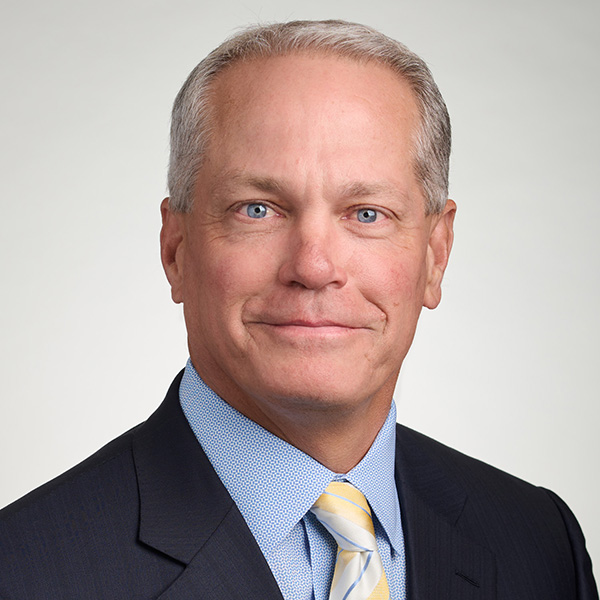
When Eric Gerstenberg started at Clean Harbors, he was about as far from the C-suite as he could be. After graduating from Syracuse University, Gerstenberg landed a job at the company as a field lab technician. He went out in a truck and took care of chemicals or materials that companies in eastern Massachusetts needed to either recycle or dispose of. At the time, Clean Harbors was a relatively small company helping businesses and government agencies but the need for the company’s environmental and industrial services was growing each year.
“I was given the opportunity to excel through advancing with the company,” says Gerstenberg.
Gerstenberg moved into a role running a business unit for Clean Harbors in Natick, Massachusetts and then managing larger facilities in Baltimore and Chicago.
“When I moved into a supervisory role, I learned a lot about the environmental industry,” says Gerstenberg.
Gerstenberg had been an aerospace engineering major at the College of Engineering and Computer Science but found that the fundamental engineering and problem-solving skills he gained at Syracuse University were helping him thrive at Clean Harbors.
“I was applying science and business skills,” says Gerstenberg. “The engineering curriculum got me exposed to the important principles of material science.”
As Clean Harbors continued to grow, so did the opportunities for Gerstenberg. The one-time field lab technician took positions as the president of the environmental, industrial & field services business, vice president of disposal services and executive vice president for environmental services. In 2015, Gerstenberg was named as the chief operating officer for Clean Harbors which had grown into a five billion dollar company with 20,000 employees. On March 31st, Gerstenberg and Clean Harbors chief financial officer Michael Battles will become co-CEOs of the company, succeeding founder Alan McKim.
Gerstenberg is grateful for his time as a student at Syracuse University and what it had to offer. He is especially eager to help engineering and computer science students looking to start their careers or take a step forward.
“Now I get to offer opportunities to talented young engineers who want to grow their career,” says Gerstenberg. “Syracuse is where I made many of my lifelong friends. It created an experience where I was exposed to a diversity of education, diversity of people and many different channels.”
Gerstenberg spends more of his time focused on the overall business operations at Clean Harbors than hands-on engineering but his Syracuse University degree is still proving its worth.
“An engineering education helps people be better problem solvers using methodical approaches. They can think through problems, understand the details and dig deep. It helps you analyze a problem and have that process,” says Gerstenberg. “I can use these skills in recycling and disposal as well as revenue growth and business operations.”
Gerstenberg sees a bright future for current engineering and computer science students and hopes they can learn from the adaptability he has shown over his career.
“Be open-minded in your approach to what opportunities you look at,” says Gerstenberg. “Be willing to travel and willing to relocate – you can do so many things with an engineering degree.”
Fall 2022 Engineering and Computer Science Dean’s List

In recognition of superior scholarship, the following students have been entered on the Engineering & Computer Science Dean’s List for Fall 2022.
To be eligible for Dean’s List recognition, the minimum semester grade point average must be 3.40 or higher, must have earned a minimum of 12 graded credits and must have no missing or incomplete grades.
Aerospace Engineering
Dean Nasri Abdel-Aziz
Allyson Almeida
Brady Joseph Arruda
Jonah Oliver Blanchard
Richard L Bruschi
Mathew Carpio
Curtis James Cline
Bryan Collins
Thomas James Condon
Paolo Pio Coppola
Michael Alexander Donato
Justin Ryan Esposito
Mark Gannon Ezaki
Benjamin David Faasse
Christian Scott Fitzgerald
Darren Finn Forschino
Victoria Elizabeth Forsyth
Zachary Ryan Freyman
John M Gauthier
Benjamin Daniel Gerard
Alexandre J Gill
Zachary William Haas
David Leo Hadley
Benjamin Matthew Hassett
Ryan Benjamin Hirsch
Aidan Hoff
Jiaji Hu
Paula Cristina Ibelings
Nicholas John Jacobs
Joseph Manuel Javier
Sydney F Jud
Harrison Kayton
Myat Min Khant
Trevor Anthony Knight
Thalia Patience Lee
Isaac Alan Lehigh
Emma Lee Levenson
Dante Alexander Liotta
Maximillian Lipinski
Nathaniel Fox Lipset
Jacob Eric Long
Ava Katherine Lough
Powers Craig Lynch
Brendan Michael Marquis
Elsa Adrianna Martin
Jonathan Henry Martin
William Armstrong Martin
Jason W McElhinney
Parker Byrne McMillan
John P Michinko
Kendra Teresa Miller
Evan Gregory Moore
Zachary Thomas Munkacsy
Brendan Pierce Murty
Tatiyyanah Queen-Asia Hope Nelums
Madeline G Phelan
Logan D Prye
Kazi Golam Rafee
Jason Patrick Reid
Nicholas Christopher Richard
Andrew Douglas Rockafellow
William J Saueressig
Winston James Schaumloffel
Zachari Whitaker Sekyi-Williams
Garrett Clifton Sickmon
Gregory C Slodysko Jr
Kathryn Amber Smith
Zachary Michael Stahl
Jaime S Sued Jr
Yiyuan Sun
Marco Svolinsky
Rory Lloyd Taylor
Richard A Tedeschi
Carter Alexander Thompson
Theodore Todorov
Anthony Robert Tricarico
Sasha Valitutti
Sarah Grace Vallejo
Cody Joseph VanNostrand
Joshua John Varkey
Toby Thomas Webber
Mason Alexander Weber
Owen James Weisenberger
Ethan H Weiss
Kana Li Wong
Cameron M Woodbury
Melissa Yeung
Bioengineering
Anthony Drew Acierto
Jason Bae
Mathieu Kenji Barthelemy
Paige Bencivenga
Zeynep Sue Cakmak
Evan A Campbell
Jade Ashlee Carter
Ryan Sean Clarke
Dominic Thomas Clinch
Lukas Cook
Shane A Corridore
Samirah Lamoni Crawford
Beatriz De Melo Palma Fernandes
Michael James Dreyer
Catherine Jean Durkin
Sophie Faith Grady
Grace Haas
Lauren Elizabeth Hamilton
Brenna Henderson
Maxima Camryn Zahra Herbert
James T Hrdy
Madeline Jones
Gabriel Khan
Olivia Lynne Kmito
Jakub Aleksander Kochanowski
Emily Labour
Quinn Patrick Langdon
Sara Anne Leonardo
Isabelle S Lewis
Joshua Edwin Nana Limjuico
Alejandra Eugenia Lopez
Ethan L Masters
Aelish McGivney
Caitlin R Mehl
Sadie Shaula Meyer
Katherine Grace Monroe
Aizhan Moore
Hannah V Murphy
Jonathan Ngo
Kerrin Anne O’Grady
Luiza Awuor Owuor
Alyssa Pape
Mia Dian Paynton
Megan Perlman
Ayanna Riley Peterson
Michael Steven Presunka
Lillian Kilmer Rhuda
Ruben Rojas Betanzos
Isabella M Rosales
Amira Salihovic
Alyssa Shelburne
Bridget Yong Sides
Katherine Anne Southard
Justin N Stock
Elizabeth Tarami Su
Danny Vu
Carly J Ward
Nathaniel Wellington
Haven M Wittmann
Lauren Margaret Woodford
Rui Xie
Yougang Xue
Ahlam Zokari
Julian Marcus Smucker Zorn
Samantha Yvonne Zysk
Chemical Engineering
James William Bailey
Elizabeth R Carchia
Alex Michael Castagliuolo
Olivia R Conlin
Dennis Dao
Emily C Fittante
Edward Coleman Fluker
Mia Angela Goldberg
Hannah Grossman
Avery Gunderson
Christopher Max Hansen
Lucas Joseph Heffler
Aiden A Jacobs
Natalia Jarmain
Hope Irene Johnson
Sonia Julius
Emma Grace Klein
Adam J Klinger
Eden Tess Leavitt
Gabe Lipsitz
Annika Daphne Meyers
Cole Parker Nordby
Erin Marie Odonnell
Eli Irvin Paster
Isabella Noelani Perkins
Riley Madison Schmerber
Jacob Matthew Shellhamer
Jason Tan
Maria Jose Velez
Seojun Yu
Jackson Richard Yuen
Civil Engineering
Juan Pablo Arosemena Graziadei
Henry C Bievenue
Leila Christine Boughton
Masson Bruening
Zoya Bukhari
Alexander Burrows
Daniel Thomas Caraceni
Isabel Cardoso
Olivia Carmella Cross
Aymeric Pierre Alexis Robert Destree
Brendan Dwyer
Marlee Ann Ecton
Xuanjie Fan
Jacob C Hotchkin
Kristen Caroline Huddleston
Julia Ann Johnson-Milstein
Rhitwik Karmakar
Rachel Katz
Jakob Lamond Keller
Kate Astrid Kemnitz
Alexander Gregory Klee
Adam Paul Landry
Evangelia Birget Larson
Haben Legesse
Emma Marie Liptrap
Emilija Alise Lizins
Lucas James Meiers
Sumit Harshad Mistry
Trevor Robert Napoli
Abigail Micah Neitch
Justin Wayne Pettit
Maxwell Robert Pozar
Benjamin Joseph Putrino
Kaylin Janet Richards
Lesley S Rojas
Keisha Zefanya Rorimpandey
Anthony K Schnaufer
Aaron Presley Shinn
Samuel Paul Smith
Caitlin Jane Spillane
Alex Gabriel Torres
Jose Artuto Venegas
Zhou Wang
Christian E Ward
Sarah Wong
Paige H Yamane
Garrett J Zito
Computer Engineering
Adekunle J Akinshola
Chikeluba K Anierobi
Jackson Thomas Bradley
Ryan Joseph Brennan
Samanta S Correa
Wenhan Cui
Nathan James Czarnecki
Lyn El Sayed Kassem
Melvin Ruben Escobar Gonzalez
Elizabeth A Fatade
Gabriel Akinloluwa Babatunde Fatade
Ralph Lawrence Graham
Alexander Joseph Hai
Aidan Robert Harrington
Ashton Jeter Hernandez
Kasey Jackson
Cedrik Jethro Jean-Baptiste
Benjamin N Johnson
Jessica K Lat
Tyler Alexander Lavaway
Matthew B Leight
Jiaxiong Li
Joseph Anderson Lodato
Kyle Maiorana
Aksel James Malatak
Jacob Stephen Masrouri
Isabel M Melo
Pierce Austin Neubert
Jayden Ahamefula Okorougo
Jose L Olivera
Adedeji Nathaniel Oyefeso
Ellie Grace Parkes
Alexander C Perez
Jessica A Reslan
Anel Rizvic
Kevin Robertson
Brian Rodriguez
Samuel M Rosenthal
Mia Elizabeth Russo
Jared Anthony Santiago
Alexander Segarra
Thomas John Vitarelli
Declan Wavle
Manling Yu
Computer Science
Bamidele Benjamin Adeyemo
Aaron Alakkadan
Sajjad Abdullah Albadri
Joseph Algerio
Anas Abdallah Hussein Alkhashroom
Brianna Danielle Anthony
Ian Edward Asbury
Fiona Asungedib Azumah
Garret W Babick
Giovanna Elizabeth Barsalona
Niloy Basak
Sophia Anne Basile
Samantha E Bastien
Maxwell Robert Beam
Anas Ahmed Benhamida
Duncan Anthony Benitz
Luke S Bonenberger
Joshua Jordan Boucher
Brian Michael Bourne
Amanda Leigh Bowdren
Spencer H Bradkin
Nathan Thor Brekke
Bryan Bladimir Bueno Reyes
Kelly Jane Burke
Andy Daniel Cai
Jonathan David Callahan
Benjamin Elliott Canfield
Andrew Miles Champagne Jr
Lawrence Chen
Daniel Chmielewski
Nicholas Chopliani
Season Chowdhury
Noah John Cirks
Rahnaya T Clarke
Ta’Nasia Zhara Coleman
Miguel Angel Cruz Flores
Matthew John Cufari
Lucas John Czarnecki
Ryan Matthew Czirr
Akosua Danso
Philippe Alexandre Daubert
Nicholas Davis
Aidan Christopher DeGooyer
Julian Joseph Delucia
Christian Despecci
Lucille Jennifer Disalvo
Russell Carl Doucet
Annica Claudia Dubert
Theodor Dan Dumitru
Christopher Edmonds
Curtis Ryan Edwards Jr
Braimah Bolade Eleshin Jr.
Ryan Siebe Elsinga
Neha Eregodu Laxminarayana
Evan J Espina
Spencer Evans-Cole
Matthew J Faiola
Bennett Ferrari
Francisco Emiliano Franco Leon
Ruihong Gao
Kelly Jane Geiwitz
Aren Sevag Gharibian
Brianna S Gillfillian
Justin Gluska
Meagan Anessa Gonzalez
John Martin Gorman
Aicha Gory
Nolan Pasquale Groothuis
Avery T Gump
Jessica Gabriela Gutierrez
Alexander Peter-Anthony Haas
Talal Hakki
Ashley Marie Hamilton
Jillian Elizabeth Handrahan
Liam Gordon Hannah
Alisha Hassan
Karen Herrera
Richard Ho
Isaiah J Hollensworth-Wooten
Laurel Howell
Noah Thomas Howell
Jacob Howlett
Helou Huang
Xuanye Huang
Eda Imer
Chengyi Jiang
Tianyiming Jing
Frederick Jackson Jones
Alan Jos
Lauren Keona Kaaiakamanu
Brunon Donovan Kaminski
Xiaoya Kang
Matthew Keenan
Nicolas Walter Ketterer
Ekaterina Kladova
Joshua Jayvant Zachary Koshy
Matthew Peter Kovalcik
Polina Kozyreva
Vivien E Latt
Maya J’Nai Lee
Jack M Lefebvre
Andy Li
Modi Li
Yuxuan Li
Daniel Lim
Joshua Lim
Alicia Lin
Sandy Lin
Jing Liu
Joshua Zhou Liu
Yuyuan Liu
Cayden Thomas Lombard
Yiheng Lu
Sophia Luo
Runzhi Ma
Shizhan Ma
Gavin Thomas Macisaac
Mihir Ulhas Mahale
Juliette Eloise Mangon
Ryan M May
Anthony Louis Mazzacane
Philip Anthony Moceri
Thomas J Montfort
Jovanni Nicholas Mosca
Ryan Murphy
Krutartha Nagesh
Christopher Scott Nemeth Jr
Jillienne Judith Ness
Arianna Kassandra Nguyen
John Viet P Nguyen
Joshua Nielson
Olivia O’Hanlon
Cheryl Hadasa Olanga
Adya Aditi Parida
Brian Joseph Pellegrino
John Arthur Peters
Amlan Pradhan
Alexander Lawrence Reid
Boyu Ren
Eric Rodriguez
Andrew Frank Scerbo
Jonathan Lee Schwenk
Sean J Shin
Chad Thom Smith
Megan C Snow
Anthony Logan Solt
Townsend Garner Southard Pantano
Samuel Thomas Stowers
Kevin Sullivan
Nicholas P Sweet
Melissa Li Tang
Andrew Jeffrey Tedesco
Eduardo Torres-Garcia
Winston Tsui
Matthew Alistair Twigg
Zimuzo Somadi Udedibia
Robert Anthony Valliciergo
Kevin Anthony Verdeschi
Christopher Mark Vinciguerra
Guozheng Wang
Zijian Wang
Jacob Wansor
Robert Ward
Samantha Maureen Weir
Ryan Thomas Welch
Daniel Z Whelan
Lauren Rae Wilson
Sarah Grace Wlodkoski
Brian Matthew Wong
Hassan Wouliyou
Zongxiu Wu
Tianyi Xiang
Yujie Xu
Jishuo Yang
Naomi Lum Yokoo
Mingyan Zhang
Rixiang Zhang
Ruihao Zhang
Weiwei Zhang
Junjie Zheng
Mochen Zhou
Yiming Zhou
Yitao Zhou
Yi Zhu
Engineering Undeclared
Hunter Bertucci-Bissonnette
Gulliver Finn Brower
Fernando De Oliveira Poli
Brady Utah Denaburg
Nicholas James Harten
Kevin Paul Leger
Juwei Lin
Jacob E Manhardt
Kathleen Rose Meleski
William Matthias Morgan
Nicholas Edward Napalit
Alexander Romanofsky
Santiago Jose Sanabria
Rylee Marie Smith
Sebastian Enrique Velez
Iving Yang
Electrical Engineering
Alston Herve Abobi
Yohaan Matthew Abraham
Minghao Ai
Saul Batista Filpo
Tianle Bu
Kevin E Buciak
Wyatt Glenn Bush
Yushang Cai
Leshui Chen
Mingfu Chen
Ellison How-Sheen Chiang
Brian Sylwester Chudzik
Timothy Nehemias De Leon De La Rosa
Kevin James Donnelly
Henry C Duisberg
Anthony John Giovannini
Davis Hood
Xingtai Huang
Myles Hudson
Hayden Huy Le
Davis James Lipetzky
Jemma Mallia
Liam Fuller Marcato
Ryan Mussaw
Zixun Nian Nian
Gabriel Brian Noble
Jayson V Okhman
Julia Pepin
Savion Vernon Pollard
Gilberto E Ruiz
Gabriel E Ruoff
Harrison James Skilling
Jenna Mei Stapleton
Jared William Welch
Sierra Lauren Yang
Environmental Engineering
Jack Arnstein
Mark Bauerschmidt
Maren Behnke
Jasper Matthew Blake
David Michael Brodsky
Benjamin R Cavarra
Hollygrace Chamberlain
Ananya P Chandra
Emma Lauren Cloud
Emma Crandall
William Robert Croteau
Eleanor Elizabeth Gettens
Elisabeth Haggerty
Brady E Hartnett
Naomi Rebecca Imhoff
Muhammad Atekul Islam
Emma Charlotte Kaputa
Morgan Jean Kingdeski
Hunter Cordes Kline
Samuel Robert Livingston
Henry David Long
Molly M Matheson
Trygve Owen Moler
Connor Joseph Moulton
Matthew Edward Nosalek
Michael Joseph O’Connor
Liesel Marie Odden
Brinda Hetal Parikh
Ella Hope Phipps
Oliver D Raycroft
Audrey Elizabeth Recko
Marisol Allegra Russo
Mary H Schieman
Noah Michael Sherman
Evelyn Junting Tang
Gabriella Terry
Husna Myaza Tunje
Jacob M Tyler
Andrew Michael Vanderwege
Madeline Rose My Vo
Emily Jean Vogel
Sydney Elizabeth Youngs
Qiuyu Zhou
Reilly Zink
Mechanical Engineering
Arfeen Armaghan
Joshua Carl Arndt
Rachael O Beresford
Aidan Paul Bergman
Jeffrey Trent Bernstein
Chloe Marie Britton Naime
Renee Allison Brogley
Brinley Bruening
Alexander Joseph Callo
Joseph Timothy Capra
Massimo Casciaro
Robin Amelia Cesario
Jun Chen
Kaifeng Chen
Giancarlo D’Amore
Joanna Eilleen Delacruz
Colby John Doane
Troy Bradley Drummond
Luyen Duong
Gabriel Emilio Rangel Purnhagen
Andrew J Esposito
Griffin Thomas Estes
Thomas John Fabiano
Luke Samuel Fink
Elan Fullmer
Cameron Joseph Galloway
Xumeng Ge
Charles James Germosen
Samuel Ryan Getman
Derrick Edward Goll
James Brady Goodreau
Laura Pandora Graziosi
Daniel Robert Greene
Alec Michael Grogan
Jack T Hassett
Meagan Emily Hernandez
Melissa Jane Hiller
Elliott J Holdosh
Yue Hu
Jeffrey Huang
Jiayuan Huang
Gavin Johnson
Dong Myeong Kang
Macauley J Kastner
Teagan L Kilian
Cherry Kim
Justin Kohan
Savannah Mae Kreppein
Jasmine Anne Lin
Honorata Lubecka
Bei Luo
Matthew Macfarlane
Ryan Patrek Martineau
Jennifer Alana Mason
Ian Walter McCollom
Michael J McElroy
Kalhaku D McLester
Ryan A Melick
James Patrick Melitski
Andrew Charles Moreno
Wiley Robert Moslow
Beau M Norris
Michael John Palmer
Nathaniel Ryan Paradis
Patrick Limsuksrikul Phanichyakarn
Emma Tiffany Platten
Regina Ann Reisig
Kaelyn R Rooney
Jeremy Vinton Rosh
Teagan Isabella Marie Rowland
Michael Patrick Rzasa
Sidarth Umrith Sarathy
Madeline Celia Scott
Zachary Ryan Shuler
Eric Silfies
Dionysios Skaltsas
Nathaniel Paul Slabaugh
Daniel Michael Stich
Ian Storrs
Kittapas Tulananda
Evan R Tulsky
Alexandra Rose Vaida
Griffin Riley Vollers
Nicholas Eric Waller
Xu Wang
Michael David Wehrle
Taj Asim Whitney
Thomas Chandler Williams
Michael Wong
Zhihan Zhou
Syracuse University Environmental Finance Center Receives Multi-Million Dollar Environmental Protection Agency Grant to Support Underserved Communities

The Syracuse University Environmental Finance Center (SU-EFC) was selected by the United States Environmental Protection Agency (EPA) to serve as a regional Environmental Finance Center (EFC) to help communities access federal infrastructure funds, and continue supporting environmental and financial challenges in the communities that need it most. SU-EFC will continue serving EPA Region 2, which includes New York, New Jersey, Puerto Rico, US Virgin Islands, and eight Native Nations, and is one of 29 Environmental Finance Centers awarded to support states, local governments, and Native Nations as they work to protect the environment and public health over the next five years.
“Our team is honored to continue working with the EPA in providing a range of services, products, and local community engagement that have proven highly successful in helping communities improve their environmental quality, integrate sustainability concepts in decision making, and cultivate collaborative networks and relationships with other federal, state, and local agencies and private sector partners,” says Melissa Young, director, Resource Conservation Initiatives.
“The unprecedented nature of the funding SU-EFC has received from the EPA to provide technical assistance to underserved communities demonstrates a real commitment to ensuring safe, affordable, and reliable water for every household in the country,” says Khristopher Dodson, director, Water Resiliency Initiatives. “SU-EFC is proud to be part of the national network of EFCs who will be providing these services, in some cases as teams, across the country.”
SU-EFC will be awarded $1,084,000 for the first year, and then at least $950K annually over the remaining four years. The Center will serve as both a Regional Multi-Environmental Media EFC and a Regional Water Infrastructure EFC to provide no-cost technical assistance to local municipalities, states, and Native Nations to build capacity and support equitable infrastructure investments. As a Regional Water Infrastructure EFC, SU-EFC will also work with communities to improve accessibility to Bipartisan Infrastructure Law funds in order to support clean and safe water access across EPA Region 2.
Community leaders who are looking for ways to access federal funds authorized by the Bipartisan Infrastructure Law are encouraged to contact SU-EFC staff or visit their website for more information on free upcoming events.
Professor Cliff Davidson Selected for Association of Environmental Engineering and Science Professors Distinguished Lecturer Tour
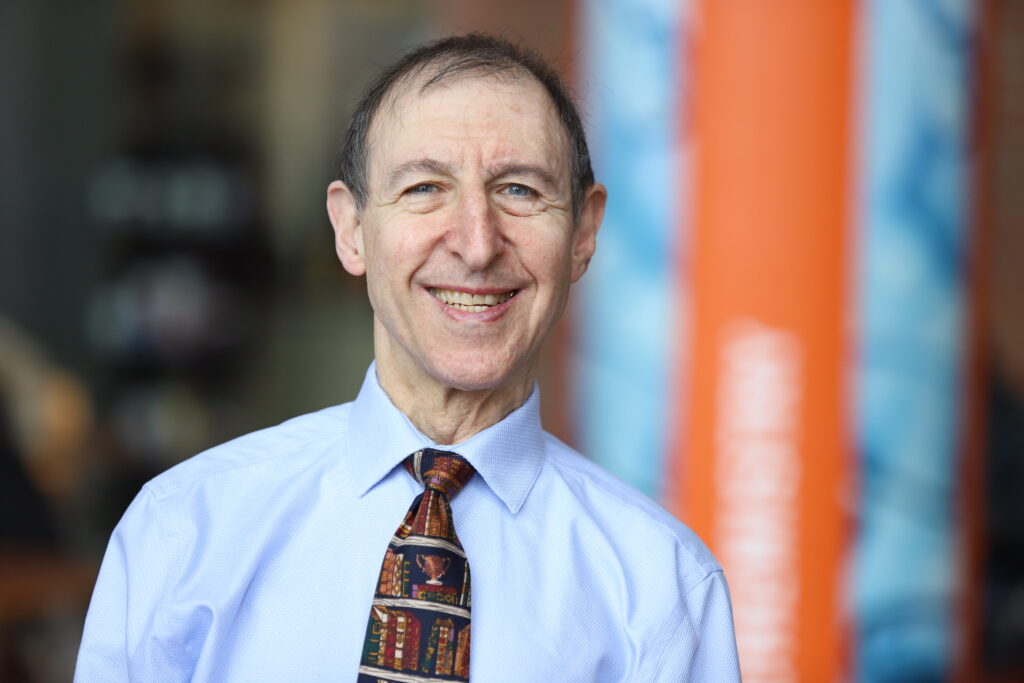
Civil and environmental engineering Professor Cliff Davidson was selected as the featured lecturer for the Association of Environmental Engineering and Science Professors Foundation (AEESP) 2022-2023 Distinguished Lecture Series.
Davidson is the Thomas and Colleen Wilmot Professor of Engineering at Syracuse University. He also serves as Director of Environmental Engineering Programs, and Director of the Center for Sustainable Engineering. He will be presenting two different lectures during the tour. The first lecture is titled “The Green Roof as a Complex System” and will focus on how the performance of a green roof can be modeled and measured in an effort to understand its benefits in built-up urban areas, using the instrumented extensive green roof on the Onondaga County Convention Center in Syracuse. The second lecture is titled “The Interactions of Airborne Particles with Surfaces” and will examine the many ways in which atmospheric particles interact with surfaces of all kinds – natural vegetation, agriculture crops, landscaping, bare soil, water, snowfields, and urban hardscape surfaces.
The AEESP tour will bring Davidson to Washington University in St. Louis, Northeastern University, Drexel University, the University of Illinois at Urbana-Champaign, University of Texas-El Paso, Carnegie Mellon, Georgia Tech, University of Colorado – Boulder, the University of Toronto in fall 2022. The tour schedule for spring 2023 is still being developed.
“This is a great opportunity to meet with colleagues at other schools and learn about how they are coping with the challenges of research, teaching, and advising in the uncertain world we find ourselves in,” said Davidson.
Min Liu Appointed Abdallah H. Yabroudi Endowed Professor in Sustainable Civil Infrastructure

The College of Engineering and Computer Science is proud to introduce Dr. Min Liu as the Abdallah H. Yabroudi Endowed Professor in Sustainable Civil Infrastructure at Syracuse University.
Her research centers on developing innovative approaches and generating knowledge on how to integrate the human and engineering aspects of construction planning to improve productivity and project performance. She has published over 40 articles in top-ranked construction engineering and management journals. Her recent research on using an information theory approach to quantify information exchange effectiveness in construction planning won the 2021 American Society of Civil Engineers (ASCE) Thomas Fitch Rowland award. Her work also received the Best Paper Award from the 2018 International Group of Lean Construction Conference and from the 2017 Lean and Computing in Construction Congress. She has been recognized with “Thank a Teacher” awards in 2011, 2017, and 2018 from North Carolina State University.
Liu was the Chair of ASCE Construction Research Council (CRC) from 2020 to 2021. The CRC has over 400 members worldwide from construction faculty and is recognized as the premier forum for construction engineering and management research. Liu has also served as the associate specialty editor for the ASCE Journal of Management in Engineering since 2016 and the assistant specialty editor in labor and personnel Issues for the ASCE Journal of Construction Engineering and Management since 2009. She was selected as the outstanding reviewer by the ASCE Journal of Construction Engineering and Management in 2015 and 2017 and she co-founded Carolina’s Lean Construction Community of Practice in 2009.
Abdallah H. Yabroudi ’78, G’79is chief executive officer of Dubai Contracting Co. (DCC), headquartered in Dubai, United Arab Emirates. He has been associated with DCC since 1980. Yabroudi also serves as general manager of a development and contracting company in Chile and a development and construction company in Lebanon. He is director of the Dubai Construction Co. in Jordan and Saudi Arabia.
Yabroudi is a member of the American Society of Civil Engineers; the Chartered Quality Institute (formerly the Institute of Quality Assurance); Chi Epsilon, a U.S. civil engineering honor society; and Tau Beta Pi, the nation’s oldest engineering honor society and second oldest collegiate honor society.
Yabroudi earned a bachelor’s degree in civil engineering, with honors, in 1978 and a master’s degree in industrial engineering and operations research a year later, both from Syracuse University’s College of Engineering and Computer Science. He also earned a bachelor’s degree in business administration from Haigazian University in Beirut, Lebanon.
Yabroudi serves on the Board Facilities Committee as a Life Trustee participant. He served as a Voting Trustee from 2009-2021. His Syracuse University service includes membership on the College of Engineering and Computer Science Dean’s Leadership Council He is a 2018 recipient of the George Arents Award, the University’s highest alumni honor, and has been named a Tau Beta Pi Distinguished Alumnus.
He and his wife, Maha Abou Gazale, have provided lead gifts for the establishment of the Abdallah H. Yabroudi Chair in Civil Engineering Endowed Fund; the Hasan Abdallah Yabroudi Middle East Center Endowed Fund; the Yabroudi CIE Faculty Support Fund; the Yabroudi CIE Renovation Fund; and the Yabroudi, Bitar and Ghazaleh Endowed Scholarship Fund. They have supported other initiatives in Engineering and Computer Science, Middle Eastern studies and study abroad.
They reside in Dubai and are the parents of Hasan, Ghada, Faisal and Omar.
Peter Plumley
Education:
- State University of NY at Albany, Geology B.S. 1974
- Western Washington University, Geology M.S. 1980
- University of California, Santa Cruz, Earth Science Ph.D. 1984
Lab/ Center/ Institute affiliations:
- Director of the Central New York Science & Engineering Fair (CNYSEF)
- Director for the NASA NYS Space Grant Consortium for Syracuse University
Areas of Expertise:
- Earth Scientist with an extensive background in computers and technology
- Research has been in the areas of plate tectonics and application of paleomagnetic techniques to regional tectonics
- Active research is focused on educational issues of secondary students related to motivation and the Science of Learning
- Designed, built and marketed a Super-Sensitive Horizontal Translation Beam Curie Point Balance
- Primary investigations concern application of paleomagnetic techniques to regional tectonic and structural problems, plate tectonics, and strain analysis.
- Design, edit and create exhibits for science and engineering subjects.
Honors and Awards:
- 2003 College Educator of the Year, by the Technology Alliance of Central New York
- 2008 SU Gearup
- 2011 The Post Standard-Achievement Award
- 2015 Technology Alliance of Central New York, Science & Technology Outreach
- 2019 Partners for Education & Business, Inc., Career Spark Award
Selected Publications:
Plumley, P. W., Coe, R. S., T. Byrne, M. Reid, and J. C. Moore, 1982, Paleomagnetism of volcanic rocks of the Kodiak Islands indicates northward latitudinal displacement, Nature, v. 300, p. 50-52.
Moore, J.C., T. Byrne, P.W. Plumley, M. Reid, H. Gibbons, and R. Coe. 1983, Paleogene Evolution of the Kodiak Islands, Alaska: Consequences of Ridge-Trench Interaction in a more Southerly Latitude, Tectonics, V. 2, N 3. P. 265-293.
Plumley, P. W. 1987, Paleomagnetism and Displacement of Alaskan Terranes,” Syracuse Scholar (1979-1991): Vol. 8: Iss. 1, Article 4.
Plumley, P. W., M. S. Vance, and G. Milazzo, 1989, Structural and paleomagnetic evidence for Tertiary bending of the eastern Brooks Range flexure, Alaska, in; Deep structure and past kinematics of accreted terranes, ed J.W. Hillhouse, A.G.U. Geophysical Monograph/I.U.G.G., v. 5. Union Monograph, p. 127-150.
Pair, D. L., Muller, E. H., & Plumley, P. W., 1994, Correlation of Late Pleistocene glaciolacustrine and marine deposits by means of geomagnetic secular variation, with examples from northern New York and southern Ontario, Quaternary Research, 42, 277-287.
Four Engineering and Computer Science Faculty Receive NSF CAREER Awards in the 2021-2022 Academic Year

College of Engineering and Computer Science Professors Sara Eftekharnejad, Ferdinando Fioretto, Zhao Qin and Teng Zeng received CAREER awards from the National Science Foundation (NSF) Faculty Early Career Development program during the 2021-22 academic year.
The highly competitive NSF Faculty Early Career Development (CAREER) program supports early-career faculty who have the potential to serve as academic role models in research and education and to lead advances in the mission of their department or organization. Activities pursued by early-career faculty should build a firm foundation for a lifetime of leadership in integrating education and research.
Eftekharnejad and Fioretto are members of the Department of Electrical Engineering and Computer Science. Qin and Zeng teach in the Department of Civil and Environmental Engineering.
Eftekharnejad’s project, “Modeling and Quantification of the Interdependent Power Grid Uncertainties,” examines how conditions impact the U.S. electric power grid and looks at developing better methods of predicting grid disruptions. She is using statistical modeling of power grid failures to help predict power outages within rapid timeframes. Another focus is modeling power-generation uncertainties from various types of energy supplies, including those that are weather dependent. She and her team are working on using system measurements of grid status and condition uncertainties to find a dynamic model that adjusts in real time to help predict power outages before they occur.
In his project, “End-to-End Constrained Optimization Learning,” Fioretto is researching new models for solving computer optimization problems by accelerating data-driven learning. In that effort, he and his research team are approximating near-real-time integration of constrained optimization principles into machine learning algorithms. Optimized algorithms can improve an array of computer-based processes used in industrial applications that affect everyday life, such as meeting electricity demands efficiently, matching organ donors with receivers, scheduling flights and finding a nearby driver at a ride-sharing service.
Qin’s project, “Multiscale Mechanics of Mycelium for Lightweight, Strong and Sustainable Composites” seeks to reveal the fundamental principles that govern the multiscale mechanics of mycelium-based composites and integrate research into an educational program. Mycelium, produced during mushroom growth as the main body of fungi, plays an essential role in altering soil chemistry and mechanics, enabling a suitable living environment for different plant species.
Inland lakes in the northeastern United States have shown inconsistent trends of browning, a shift toward darker water color. Many of these lakes also receive inputs of organic contaminants originating from human activities within the lake watersheds. For “Impacts of Lake Browning on the Photochemical Fate of Organic Micropollutants,” Zeng is studying the sunlight-driven transformation of organic contaminants in the context of browning. The project is a collaboration with a volunteer lake monitoring and education program. He plans to develop new data and knowledge that will support development of adaptative lake monitoring programs and water treatment practices.
A total of nine Syracuse University faculty members received CAREER awards during the 2021-22 academic year. This is the largest number of the prestigious NSF awards earned in a single year.
Syracuse University’s Center for Sustainable Community Solutions and Environmental Finance Center Announces New Directors

The Syracuse University College of Engineering and Computer Science has announced two new directors at the Center for Sustainable Community Solutions – Environmental Finance Center (CSCS-EFC). Melissa Young takes on the title of director, resource conservation initiatives at CSCS-EFC, while Khristopher Dodson takes on the title of director, water resiliency initiatives. Each director brings more than 15 years of experience managing teams of environmental professionals and are experts in their respective fields of sustainable materials management and water resource management.
As it approaches its 30th year anniversary in 2023, Syracuse University’s CSCS-EFC is poised for growth. Since 1993, CSCS-EFC has used a unique community-based approach to assist hundreds of municipalities across EPA Region 2, which includes New York, New Jersey, Puerto Rico, the U.S. Virgin Islands, and eight Native Nations. CSCS-ESC acts as both a training center and a bridge, bringing together various governmental and nonprofit actors to collaborate on sustainability issues, including water infrastructure management, water equity, climate resiliency, and resource conservation, including waste reduction, reuse, recycling, and sustainable resource management. Since 2015, CSCS-EFC has managed more than $10 million in federal, state and local grants to support its municipal and county government partners.
“We are excited for Syracuse University’s CSCS-EFC to continue growing under the leadership of its two new directors,” says J. Cole Smith, Dean of the College of Engineering and Computer Science. “Our mission includes serving communities by bringing our research and technical abilities to assist in crafting new and innovative solutions. CSCS-EFC is a critical component of how we fulfill that mission. The continued growth of their team reflects the value of how we help empower local leaders to drive change in their communities.”
Melissa Young previously served as an assistant director at CSCS-EFC, where she has worked since 2008. In that role, Young led public engagement, outreach and educational programs, resource development, and technical assistance related to sustainable materials management, including waste reduction, reuse, and recycling. In 2010, she spearheaded development and launch of the Center’s Sustainable Materials Management (SMM) Stewardship program, which to date has engaged hundreds of college students and thousands of K-12 students and teachers across New York, Puerto Rico, and U.S. Virgin Islands, educating them about waste reduction, reuse, recycling, and composting and empowering them to conduct local outreach projects. In 2015, she helped develop the first NYS Organics Summit and helped NYSAR3 receive an Environmental Champion Award from the USEPA for her work co-leading the Re-Clothe NY Campaign. “We are at a critical turning point right now in EPA Region 2,” says Young. “Local leaders and communities are realizing the need and value of transitioning their materials management operations into a system that’s based on waste prevention, resource conservation, the highest and best use of materials, and circular economics, all of which help to benefit the social, environmental, and economic wellbeing of their local communities. I’m proud of the work our team has done in leading sustainable materials management initiatives and I look forward to what we can accomplish as we continue expanding our services in Puerto Rico, the U.S. Virgin Islands, New Jersey, and here in New York State.”
Khris Dodson previously served as an associate director at CSCS-EFC, managing a team of professionals to assist rural communities and other underserved populations on water and wastewater infrastructure challenges, and connecting the Syracuse University EFC with the national EFC network. “As our team continues to grow, we are excited to bring on new talent and find new ways to support our local leaders,” said Dodson. “We are committed to supporting every community in EPA Region 2 with technical assistance and continuing to work with our many national and statewide partners. We recently added new staff with cultural competency to support Native Nations, we’re planning to hire more staff to meet new demand for our services especially on climate resiliency, and we’re evaluating new ways to continue integrating our work with other institutes and academic centers across Syracuse University and at SUNY College of Environmental Science and Forestry, like the Center for Native Peoples and the Environment.”
For both Dodson and Young, key reasons to increase programming include investments at the state and federal levels. At the state level, the NYSDEC has invested more than $6 million towards the new NYS Center for SMM, of which CSCS is a major partner in the development of the center and in conducting all public engagement, education, and outreach activities. At the federal level, the Bipartisan Infrastructure Law (BIL) passed in 2021. Over the next five years, the law will provide the U.S. Environmental Protection Agency with more than $100 billion in funds that can be awarded to states to support clean water infrastructure and climate resiliency. This year in New York State alone, $426 million is available for local municipalities and Native Nations to address climate resiliency and long-overdue upgrades to public infrastructure. “There is a tremendous amount of funding on the table right now,” says Dodson. “Our mission is to work with our partners at EPA and state agencies to make sure underserved communities have the training and skills they need to access new funds. Climate, water, and resource conservation issues are quickly becoming priorities for governments at all levels. The Center for Sustainable Community Solutions here at Syracuse University is well-positioned to convene groups working on these important issues and will ensure that this historic funding is distributed in a way that’s equitable and just.”
Interdisciplinary team of Engineering and Computer Science Students Wins 2022 Invent@SU Competition
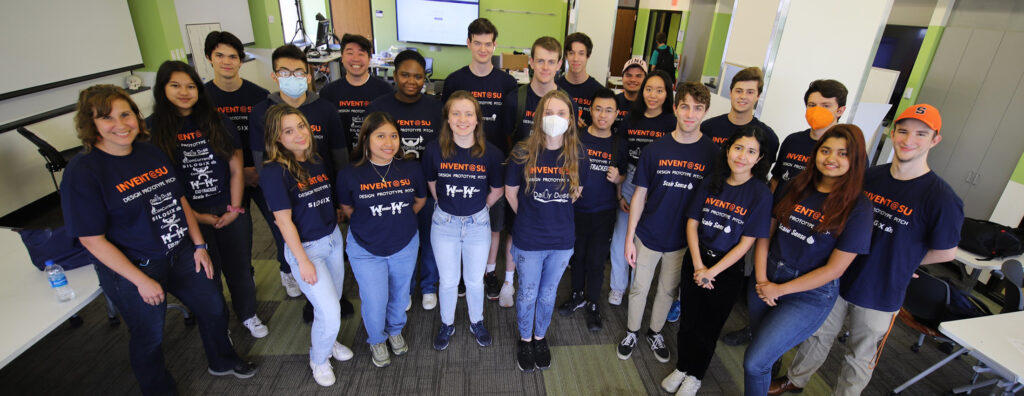
When searching a burning building for people who may be trapped inside, smoke and debris can cause firefighters to work in zero visibility conditions. They are attached to ropes but it is easy for them to become disoriented. This makes it difficult to navigate their way back to safety.
Environmental engineering student Oliver Raycroft ’25 heard about the problem from a firefighter during his first year at the College of Engineering and Computer Science and started thinking about ideas.
“I thought the problem was interesting and there was a clear need,” said Raycroft. “I wanted to help and find a solution.”
At the beginning of the six week Invent@SU program, Raycroft presented the problem to his teammates biomedical engineering student Alejandra Lopez ’22 and computer science student Adya Parida ’25. Both were interested in seeing if they could use their science and engineering skills to design a practical solution that would help firefighters orient themselves during rescue operations.
“If we could solve this problem, we could save the lives of firefighters and billions in damages,” said Parida.
During Invent@SU, student teams design, prototype and pitch new inventions with help from engineering and communications faculty. Each student receives a $2200 stipend and teams have a $1000 budget for prototyping materials. Teams spend six weeks developing their ideas during summer session one and each week a panel of Syracuse University alumni and friends evaluate the progress of their five-minute pitches.
“It was a combination of experimentation and feedback. This program taught me skills I can apply anywhere,” said Parida.
“I got better and better at presenting and communicating what we were working on,” said Lopez.
“The fact firefighters liked it so much made it worth it,” said Parida.
On the final Thursday of the program, all seven teams in Invent@SU pitched their inventions to a panel of alumni judges. Raycroft, Lopez and Parida’s team named “Scale Sense” took first place and a $1500 prize.
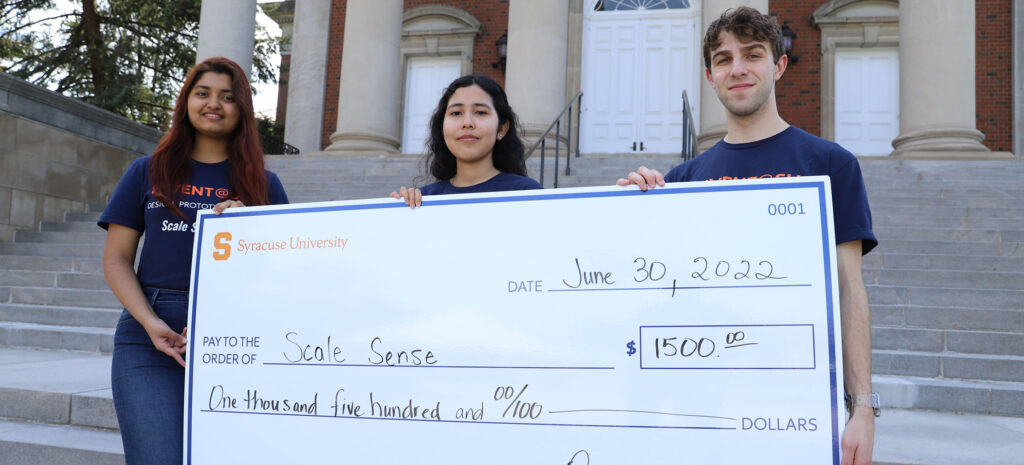
Second place went to team “Wonder Walker” who designed a mobility assistance device for children with special needs.
Third place went to team “Silogix” – who designed a device to provide farmers with a way to prevent dangerous grain blockages in silos.
“It was a ride, it was fun, challenging and rewarding,” said Parida.
Several Invent@SU teams plan to work with the Blackstone Launchpad in Bird Library to explore business plans and patents.
Invent@SU was made possible by program sponsors Syracuse University Trustee Bill Allyn G’59 and Janet “Penny” Jones Allyn ’60 and Michael Lazar G’65. The 2022 team sponsors were Matthew Lyons ’86, Haden Land G’91 and Cathy Jo Land and Ralph Folz ’90. For more information on the program, visit invent.syr.edu.
Civil and Environmental Engineering Professor Zhao Qin Receives NSF CAREER Award to Support Mycelium Research

The future of construction materials may exist just inches below the surface of a typical lawn. In between the rocks and soil, a vast microfiber network is constantly assimilating wood chips along with plant waste. You may not see the network building, but you do see what it produces once mature – mushrooms.
“When temperature and humidity produce the right conditions, mushrooms grow out of the mycelium network that has existed beneath the ground,” says civil and environmental engineering Professor Zhao Qin.
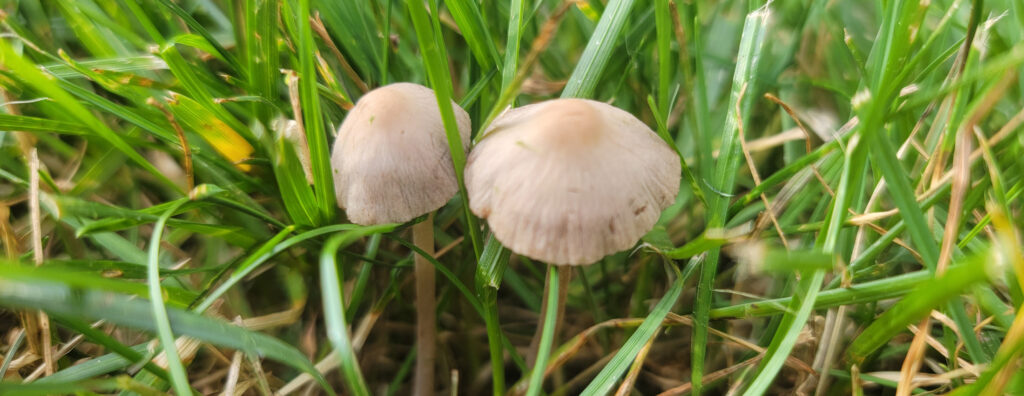
Qin has been researching the structure of mycelium and the potential for it to be used in other adhesive applications. He sees it as an interface between material science, civil engineering and environmental engineering.
“It is like a glue that integrates wood chips and waste material and then assimilate all these pieces together,” says Qin. “Around cliff areas, people are looking to stabilize the soil. Mycelium is doing this all the time.”
Qin received a National Science Foundation (NSF) CAREER Award for his project, “Multiscale Mechanics of Mycelium for Lightweight, Strong and Sustainable Composites.” He seeks to reveal the fundamental principles that govern the multiscale mechanics of mycelium-based composites and integrate research into an educational program. Mycelium, produced during mushroom growth as the main body of fungi, plays an essential role in altering soil chemistry and mechanics, enabling a suitable living environment for different plant species.
He and his research team are building a computational model to show how mycelium blends wood chips and waste into complex microfiber structures.
“Once we have a computational model we can optimize the process,” says Qin. “We plan to generate the culture for Mycelium to grow in the lab. Then we generate conditions like temperature or pressure so we can characterize the strength of the material.”
Eventually, Qin wants to take these natural materials into the lab to see if it can be processed into a composite for infrastructure uses.
“A composite version of mycelium could require less energy to produce and be biocompatible,” says Qin. “It could be used for construction – think about similar properties to medium-density fiberboard but integrated by a mycelium network rather than an adhesive. We want to see what is possible once we know how the mycelium achieve these mechanical properties.”
Qin says Syracuse University is the perfect environment for his research. He will be collaborating with Professors Daekwon Park and Nina Sharifi from the School of Architecture. Their project was initially funded by a CUSE Grant.
“This is a fantastic research institution. My colleagues here in Engineering and Computer Science and the School of Architecture are very supportive, we have excellent facilities and outstanding graduate students,” says Qin. “Once we set the recipe for these materials, we can apply that to real world applications in construction and architecture.”
“Our department is thrilled to see Dr. Qin’s work recognized by the NSF,” says civil and environmental engineering department chair Andria Costello Staniec. “His work is significant for modeling of bioinspired materials and will contribute to the development of eco-friendly composite materials that have wide applications in civil engineering and beyond.”
As part of the NSF grant, Qin is involving K-12 students in research and also plans to develop an educational exhibit related to mycelium study at the Museum of Science and Technology in downtown Syracuse.
“We will design educational programs that will help aspiring young engineers and scientists to learn by playing,” says Qin.
“Dr. Qin’s research is an outstanding example of the kind of research that ECS seeks to grow,” said College of Engineering and Computer Science Dean J. Cole Smith. “He is showing how to leverage his foundational excellence in science and engineering to construct effective composite materials. Furthermore, he is engaged in deep collaborations with some of our truly fantastic colleagues in the School of Architecture. I am so personally excited to see Dr. Qin recognized for the promising and innovative researcher that he is.”
Spring 2022 Engineering and Computer Science Dean’s List

In recognition of superior scholarship, the following students have been entered on the Engineering & Computer Science Dean’s List for Spring 2022.
To be eligible for Dean’s List recognition, the minimum semester grade point average must be 3.40 or higher, must have earned a minimum of 12 graded credits and must have no missing or incomplete grades.
Aerospace Engineering
Allyson Almeida
Brady Arruda
Curtis Cline
Bryan Collins
Nicholas Crane
Brian Cronin
Christopher Doherty
Michael Donato
Sean Edelman
Nadia Elsaeidy
Benjamin Faasse
Christian Fitzgerald
Victoria Forsyth
Benjamin Gerard
Alexandre Gill
Jacob Gomez
Zachary Haas
David Hadley
Alyssa Henley
Aidan Hoff
Paula Ibelings
Nicholas Jacobs
Joseph Javier
Sydney Jud
Benjamin Kane
Harrison Kayton
Trevor Knight
Isaac Lehigh
Stephen Leung
Emma Levenson
Maximillian Lipinski
Jacob Long
Powers Lynch
Brendan Marquis
Noah Martel
Elsa Martin
Jonathan Martin
Maxwell Martin
William Martin
Jason McElhinney
Mariana McManus
Parker McMillan
Alexander Metcalf
Romeo Michelson
John Michinko
Kendra Miller
Evan Moore
Matthew Murino
Mark Namatsaliuk
Tatiyyanah Nelums
Randall Osborn
David Pham
Madeline Phelan
Logan Prye
Matthew Qualters
Mykhaylo Rafalskyy
Samantha Riedel
Brandon Riley
Tracey Rochette
Alyssa Rote
Daniela Ruano-Pinos
Gregory Ruef
Michael Saksa
William Saueressig
Fred Schaffer
Winston Schaumloffel
Justine John Serdoncillo
Kanya Shah
Vraj Shah
Prabha Singh
Gregory Slodysko Jr
Zachary Stahl
Christopher Stawarski
Ethan Stocum
Yiyuan Sun
Marco Svolinsky
Tiffany Tang
Anthony Tricarico
Cody VanNostrand
Diego Villegas
Mason Weber
Timothy Wiley
Kana Wong
Cameron Woodbury
Melissa Yeung
Bioengineering
Anthony Acierto
Ashraf Alnatour
Bianca Andrada
Jason Bae
Eric Benaroch
Colby Black
Anna Brunson
Zeynep Cakmak
Britnie Carpentier
Lukas Cook
Tessa Decicco
Mia-Marie Fields
Tessa Galipeau
Jennifer Gonzalez
Skyla Gordon
Jenna Grutzmacher
Grace Haas
Lauren Hamilton
Victoria Hathaway
Brenna Henderson
Madeline Jones
Gabriel Khan
Jakub Kochanowski
Emily Labour
Quinn Langdon
Sara Leonardo
Isabelle Lewis
Alejandra Lopez
Ethan Masters
Aidan McCarthy
Aelish McGivney
Ian McHugh
Caitlin Mehl
Lindy Melegari
Katherine Monroe
Hannah Murphy
Alexander Musselman
Jonathan Ngo
Mark Nicola
Nicole Nielsen
Kerrin O’Grady
Mia Paynton
Megan Perlman
Connor Preston
Michael Presunka
Mark Ransbottom
Lillian Rhuda
Isabella Rosales
Brandon Salazar
Amira Salihovic
Juliana Sepulveda
Bridget Sides
Katherine Southard
Justin Stock
Elizabeth Su
Kimberly Tlayaca
Zhuoqi Tong
Danny Vu
Nathaniel Wellington
Maximillian Wilderman
Haven Wittmann
Lauren Woodford
Rui Xie
Julian Zorn
Samantha Zysk
Chemical Engineering
Daud Abdullayev
Paige Adebo
Lilly Basgall
Sandy Cao
Karley Chambers
Dennis Dao
Gabriela Duarte Saadia
Samantha Esparza
Emily Fittante
Edward Fluker
Mia Goldberg
Brent Gosselin
Avery Gunderson
Christopher Hansen
Oduduabasi Isaiah
Aiden Jacobs
Natalia Jarmain
Hope Johnson
Sonia Julius
Sayf Karim
Laxmi Khatiwada
Adam Klinger
Simran Dharmendra Lakhani
Caroline Leduc
Steven M Axelsen
Haonan Ma
Rawia F A M Marafi
Annika Meyers
Erin Odonnell
Sean O’Toole
Eli Paster
Fabiana Perez
Isabella Perkins
Nora Prosak
Riley Schmerber
Jacob Shellhamer
Jason Tan
Elizabeth Wall
Murphy Waters
Jackson Yuen
Civil Engineering
Shalom Acheampong
Juan Pablo Arosemena Graziadei
Maxwell Bell
Lucas Bellandi
Henry Bievenue
Ryan Bourdeau
Shalamar Brown
Alycia Bruce
Masson Bruening
Brett Carney
Vanessa Chica
Alejandro Correa
Aymeric Destree
Brendan Dwyer
Jack Dwyer
Marlee Ecton
Maraea Garcia
Matthew Hauser
Julia Johnson-Milstein
Joshua Kaufman
Kate Kemnitz
Alexander Klee
Adam Landry
Evangelia Larson
Abigail Laschalt
Haben Legesse
Emma Liptrap
Emilija Lizins
John Mazza
Jessica McGowan
Lucas Meiers
Sumit Mistry
Salma Mohamed
Amira Mouline
Trevor Napoli
Marissa Nicole
Jenifer Pena
Joseph Penta
Brian Perez
Justin Pettit
John Pham
Maxwell Pozar
Gabriel Prepetit
Anthony Privitera
Benjamin Putrino
Kaylin Richards
Cassie Saracino
Ethan Schulz
Aaron Shinn
Caitlin Spillane
Erin Splaine
Jose Venegas
Christian Viola
Christian Ward
Angelina Wong
Isabelle Wong
Paige Yamane
Charles Zeitoune
Garrett Zito
Computer Engineering
Adekunle Akinshola
Chikeluba Anierobi
Graciela Avila
Jackson Bradley
Collin Chamberlain
Dynasty Chance
Ibrahima Diallo
Lyn El Sayed Kassem
Melvin Escobar Gonzalez
Xavier Evans
Elizabeth Fatade
Delaney Glassford
Aidan Harrington
Ethan Hensley
Kasey Jackson
Mehak Jetly
Virkin Jimenez
Fundi Juriasi
Bikash Khatiwoda
Jessica Lat
Tyler Lavaway
Matthew Leight
Jiaxiong Li
Kyle Maiorana
Aksel Malatak
Jacob Masrouri
Jas Moreno
Benjamin Murray
Pierce Neubert
Jose Olivera
Jessica Reslan
Anel Rizvic
Samuel Rosenthal
Hongyi Ruan
Mia Russo
Hanna Salem
Alexander Segarra
Ryan Wolff
Renjie Xu
Andy Zheng
Computer Science
Aaron Alakkadan
Sajjad Albadri
Huda Ali
Christian Alves-Patterson
Garret Babick
Julia Barucky
Samantha Bastien
Anas Benhamida
Luke Bonenberger
Joshua Boucher
Brian Bourne
Ella Brink
Brandon Brushwyler
Bryan Bueno Reyes
Bryce Cable
Liam Calnan
Omar Camara
Megan Campbell
Benjamin Canfield
Jackie Chen
Lawrence Chen
Siyu Chen
Yixing Chen
Daniel Chmielewski
Season Chowdhury
Konstantinos Chrysoulas
Bram Corregan
Miguel Cruz Flores
Matthew Cufari
Ryan Czirr
Salvatore DeDona
Aidan DeGooyer
Alpha Diallo
Lucille Disalvo
Christopher Edmonds
Georges Elizee
Yassin Elsharafi
Ryan Elsinga
Matthew Faiola
Xueyan Feng
Bennett Ferrari
Lucas Fox
Mason Freer
Ruihong Gao
Brianna Gillfillian
Justin Gluska
John Gorman
Alexander Haas
Athanasios Hadjidimoulas
Talal Hakki
Ashley Hamilton
Jillian Handrahan
Liam Hannah
Nicholas Hoffis
Laurel Howell
Jacob Howlett
Xuanye Huang
Chengyi Jiang
Tianyiming Jing
Frederick Jones
Michael Jones
Alan Jos
Xiaoya Kang
Aarya Kaphley
Henry Katchuba
Matthew Keenan
Ekaterina Kladova
Polina Kozyreva
Gaeun Lee
Janet Lee
Justin Lee
Andy Li
Jiashu Li
Rick Li
Yuxuan Li
Daniel Lim
Haochen Lin
Sandy Lin
Zekai Lin
Huangjin Liu
Jiaming Liu
Joshua Liu
Yiheng Lu
Runzhi Ma
Gavin Macisaac
Andrew Markarian
Konnor Mascara
Kanoa Matton
Ryan May
Anthony Mazzacane
Matthew McDaniels
Noah Mechnig-Giordano
Jose Mendoza
Philip Moceri
Thomas Montfort
Jacob Morrison
Jovanni Mosca
Ryan Murphy
Zoe Neale
Christopher Nemeth Jr
Jillienne Ness
Arianna Nguyen
Cheryl Olanga
Carlyn O’Leary
Marissa Orsley
Daniel Pae
William Palin
Xiaofeng Pan
Michael Panighetti
Adya Aditi Parida
Brian Pellegrino
Carlo Pisacane
Daniel Pomerantz
Fiona Powers Beggs
Cheng Qiu
Shane Race
Christopher Rhodes
Eric Rodriguez
Sadikshya Sanjel
Jack Schmidt
William Seeley
Huahao Shang
Nolan Shepherd
Chad Smith
Jeremy Stabile
Kevin Sullivan
Cheng Yu Sung
Nicholas Sweet
Rae Tasker
Dylan Teare
Emmanuel Teferra
Jonathan Thomas
Eduardo Torres-Garcia
Brendan Treloar
Winston Tsui
Randy Vargas
Kevin Verdeschi
Kritika Verma
Bermalyn Maricel Vicente
Christopher Vinciguerra
Ruobing Wang
Xinyi Wang
Zijian Wang
Robert Ward
Jack Willis
Nolan Willis
Brian Wong
Ethan Wong
Tianyi Xiang
Zhuoyi Xiong
Yujie Xu
Jishuo Yang
Yongcan Yang
Stella Yaunches
Elin Yaworski
Yulun Zeng
Liaotianbao Zhang
Mingyan Zhang
Ruihao Zhang
Weiwei Zhang
Junjie Zheng
Liuyu Zhou
Xinqian Zhou
Yitao Zhou
Joseph Zoll
Engineering Undeclared
Luke Lybarger
Kathleen Meleski
James Peden
Emily Schiessl
Electrical Engineering
Minghao Ai
Mohammed Aljohani
Tianle Bu
Kevin Buciak
Wyatt Bush
Yushang Cai
Arianna Cameron
Leshui Chen
Nicholas Connolly
Kevin Donnelly
Henry Duisberg
Randy Galicia
Jose Ginorio
Jemma Mallia
Tyler Marston
Ryan Mussaw
Zixun Nian Nian
Jayson Okhman
Dylan Palmer
Julia Pepin
Matthew Piciocchi
Savion Pollard
Gilberto Ruiz
Gabriel Ruoff
Luis Santin
Jenna Stapleton
Jared Welch
Environmental Engineering
Elexis Jean Bishop
David Brodsky
Benjamin Cavarra
Ananya Chandra
Bessie Chen
Emma Crandall
Eric Fitzgerald
Eleanor Gettens
Allyson Greenberg
Brady Hartnett
Christopher Harvey
Joshua Higgins
Nicholas Kohl
Audrey Liebhaber
Samuel Livingston
Henry Long
Molly Matheson
Matthew Nosalek
Andrew O’Gorman
Ella Phipps
Scott Potter
Joshua Prygon
Oliver Raycroft
Mary Schieman
Noah Sherman
Husna Tunje
Jacob Tyler
Andrew Vanderwege
Maria Antonia Villegas Botero
Emily Vogel
Anna Wojcik
Qiuyu Zhou
Reilly Zink
Mechanical Engineering
Owyn Adams
Richard Andrews
Joshua Arndt
Timothy Arnold
Charles Ball
Erin Beaudoin
Aidan Bergman
Jeffrey Bernstein
Chloe Britton Naime
Brinley Bruening
Arnaud Buard
Alexander Callo
Joseph Capra
Graham Chapman
Talina Chipantiza
Artur Chuvik
Caroline D’Addio
Peter Daniels
Ryan Dileo
Madeline Doyle
Luyen Duong
Griffin Estes
Thomas Fabiano
Charles Germosen
Samuel Getman
Kara Gorman
Laura Graziosi
Jiayuan Huang
Vian Vishal Jain
Jagger Kachmaryk
Finnian Kery
Teagan Kilian
Justin Kohan
Deanna Koppenjan
Trevor Kroells
Harrison Liberto
Cameron Lotfi
Honorata Lubecka
Bei Luo
Lauren Mack
Kalhaku McLester
James Melitski
Leilah Miller
Pablo Morales
Nicholas Papaleo
Nathaniel Paradis
Corey Phung
Nicholas Piano
Scott Reyes
Aidan Riederich
Jasmine Rodriguez
Jeremy Rosh
Nitish Satpute
Justin Sauve
Eric Silfies
Dionysios Skaltsas
Nathaniel Slabaugh
Samuel Slaiby
Ian Storrs
Matthew Swanson
Ethan Tracey
Evan Tulsky
Alexandra Vaida
Nicholas Valentin
Griffin Vollers
Michael Wehrle
Taj Whitney
Michael Wong
Systems & Information Science
Connor Gurnham
Stacy Kim
Sophomore Emma Liptrap Named a 2022 NOAA-Hollings Scholar

Emma Liptrap’s passion for environmental engineering began in a parking lot.
In her junior year of high school, she set up a shadowing experience with a local engineering firm in her hometown of Salem, New Hampshire. Engineers brought her to a parking lot they were redesigning to mitigate stormwater runoff. They explained how water from large storms can become polluted from deposits on the ground and then flow directly into the nearby river.
“I had never thought much about parking lots or impervious surfaces before my shadowing experience, but after learning about their relationship to pollution and flooding I became fascinated—and committed—to learning more about stormwater management,” Liptrap says
Liptrap, a sophomore civil engineering major in the College of Engineering and Computer Science (ECS) and member of the Renée Crown University Honors Program, is a recipient of a 2022 National Oceanic and Atmospheric Administration (NOAA) Ernest F. Hollings Undergraduate Scholarship, which will help support her studies.
Named for Sen. Ernest “Fritz” Hollings of South Carolina, the prestigious award provides tuition support ($9,500 per year) and paid summer internships with NOAA to recipients. The award is designed to support students working in areas related to NOAA’s programs and mission. Students apply as sophomores, do an internship in their junior year, and receive support and mentorship throughout their undergraduate career.
In high school, Liptrap began her environmental and stormwater work by creating a sustainability club. In the first year, she gave presentations about water conservation to elementary school students, organized trash pickups at local parks, distributed water barrels to town residents and led a project planting a garden at a local park to promote wildlife.
She also worked as an intern with an architect who prioritized reusing materials and building for the future. “I loved learning about LEED certification and analyzing how we could make each build more sustainable,” she says. In her senior year, she won the New Hampshire Department of Education’s Work-Based Learning Award for her work in the internship.
Liptrap enrolled at Syracuse because of the University’s civil and environmental engineering program, SOURCE undergraduate research funding program and research focus on the smart management of water systems. “I had also read about how Onondaga Lake used to be one of the most polluted lakes in the country, and the opportunity to learn more about how it is being restored excited me,” she says.
Her coursework involves technical engineering classes along with classes in social sciences to broaden her understanding of climate change. “Through my classes, it has been made clear to me that the work I will do in the future will require cooperation with many stakeholders, including scientists, policymakers and the public. I understand how crucial effective communication will be throughout my career and am developing those skills by learning how to give presentations and engaging in team projects,” she says.
Liptrap is working in the research lab of Cliff Davidson, Thomas and Colleen Wilmot Professor of Engineering in ECS. She is engaged in research using HYDRUS, a computer program that models the movement of water at different levels of saturation. The research is done on the 60,000-square-foot green roof of the Onondaga County Convention Center (ONCenter) in Syracuse, studying its capacity to prevent stormwater from overflowing Syracuse’s combined sewer system.
“Having a reliable program like HYDRUS to model stormwater runoff will help engineers designing green roofs in the future so that they can be built to fit an area’s specific needs,” Liptrap says.
Liptrap also joined the University’s Water Chemistry lab last summer, focusing on determining the rate at which pollutants in the air settle on surfaces in Syracuse. “This project will help provide a blueprint for how to measure dry deposition in urban environments so that these pollutants can be better studied in cities,” she says.
She currently serves as outreach chair for the University’s student chapter of the American Society of Civil Engineers. She is also a member of Engineering Ambassadors, a club that facilitates engineering projects for middle school students to introduce them to key engineering concepts.
In the future, Liptrap wants to design and implement green infrastructure in cities as a civil engineer with a private consulting firm. “Many cities across the United States have plans to become more sustainable, and water management through green infrastructure will be crucial to this work,” she says. “The Hollings Scholarship’s mentorship and internship opportunities will be invaluable in helping me better understand the state of the field and explore career paths.”
Liptrap worked with the Center for Fellowship and Scholarship Advising (CFSA) to apply for the NOAA scholarship. CFSA offers candidates advising and assistance with applications and interview preparation for nationally competitive scholarships. “Emma’s sustained focus on environmental issues, and her specific interest in managing stormwater runoff, made her a terrific candidate for the NOAA-Hollings Scholarship. Her interests and goals are clearly aligned with NOAA’s mission,” says Jolynn Parker, director of CFSA. “We’re thrilled she’s won this award and will benefit from mentorship and internship opportunities through NOAA.”
The 2023 NOAA-Hollings Scholarship application will open in September Interested students should contact CFSA for more information: 315.443.2759 or cfsa@syr.edu.
Kirthiga Reddy G’95 Announced as 2022 College of Engineering and Computer Science Convocation Keynote Speaker
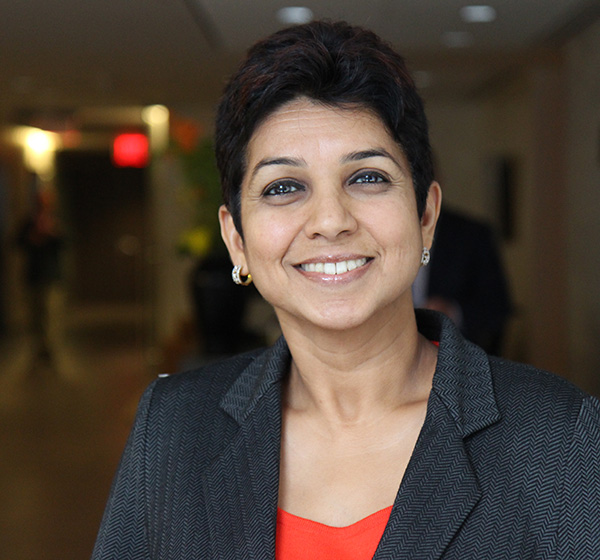
Kirthiga Reddy G’95 has many firsts to her credit. She was the first female investing partner at SoftBank Vision Fund, the first employee for Facebook in India & their Managing Director for Facebook India & South Asia. She is currently the president of Athena Technology II SPAC and a founding investment partner for f7 Ventures. She is on the Board of WeWork and Pear Therapeutics. Reddy received a master’s degree in Computer Engineering in 1995 and the College of Engineering and Computer Science is proud to announce she will be the keynote speaker at the College’s 2022 Convocation on May 14th.
Reddy brings over twenty years of experience leading technology-driven transformations. She is driven by the mantra “When businesses succeed, livelihoods flourish.”
Athena Technology II is an all-women-led SPAC (Special Purpose Acquisition Company) which brings talent and transaction experience to enable access to equity capital markets. The f7 Seed Fund’s mission is “Bold Women Investing in Bold Ventures.” Previously, Reddy was the Investment Partner at SoftBank Investment Advisers, manager of the $100B+ SoftBank Vision Fund where she led a portfolio of $5 Billion-plus. Her focus was fast evolving sectors like quantum computing, additive manufacturing, enterprise, health tech, gaming and crypto. She served on the investment committee of Softbank’s Emerge Program, a global accelerator to provide funding, tools and networks for top companies led by underrepresented founders.
Prior to SBIA, she was the Managing Director of Facebook India and South Asia for over six years, starting as their first employee in India. She started one of the global operations offices that now serves over 3.5B people. She grew the India business to several $100Ms of annual revenue and got investment buy-in for the vision of $1B. Her subsequent experiences at Facebook focused on emerging and high-growth markets including Mexico, Brazil, Indonesia, South Africa and the Middle East.
Reddy is a passionate supporter of Syracuse University’s College of Engineering and Computer Science. She has been an active member of the Dean’s Leadership Council since 2018 and is a member of SU’s Hill Society, a dedicated network of leadership annual donors who share a common goal of supporting Syracuse University’s highest priorities.
The newly established Kirthiga Reddy Graduate Scholarship Fund provides financial assistance to ECS graduate students.
She holds an MBA from Stanford University, where she graduated with highest honors as an Arjay Miller Scholar and has served as Chair of the Stanford Business School Management Board. She acquired her B.E. in Computer Science and Engineering from Marathwada University, India. She has been recognized as Fortune India’s “Most Powerful Women” and as Fast Company’s “Most Creative People in Business” among other recognitions. Her upcoming book, The Opportunity Engine, is about building high-growth, sustainable businesses.
Civil and Environmental Engineering Alumni Profile: Janea D. Russell ’08

As she helps solve some of the most challenging environmental hurdles for transportation infrastructure projects in Southern California, the lessons she learned at Syracuse University are often on the mind of Janea D. Russell ’08. She sees her time as a civil engineering student in the College of Engineering and Computer Science as the reason she has been able to thrive personally and professionally as a principle civil engineering assistant for the County of Los Angeles.
Russell has great memories of her first year in Syracuse and appreciates the guidance she received from civil and environmental engineering Professor Sam Clemence.
“My experiences really helped me to problem solve – to look at the root of an issue and tackle it,” says Russell.
Now Russell works on some of the most important environmental challenges for infrastructure projects in the Los Angeles County area. She is grateful not only for the engineering education she received at Syracuse University but also the connections she made across campus with friends and professors in the other schools and colleges.
“My background has helped me consider engineering challenges from different perspectives,” said Russell. “We look at the effects a project may have on everything around it. From sensitive flora and fauna to broader societal impacts.”
She recommends current students find ways to get involved, take advantage of all the social activities on campus and be a part of the larger Syracuse University community.
“Most of the people I am closest to now, I met at Syracuse,” says Russell.
Saving Lives Through Planning: Eric Letvin ’92, G’94
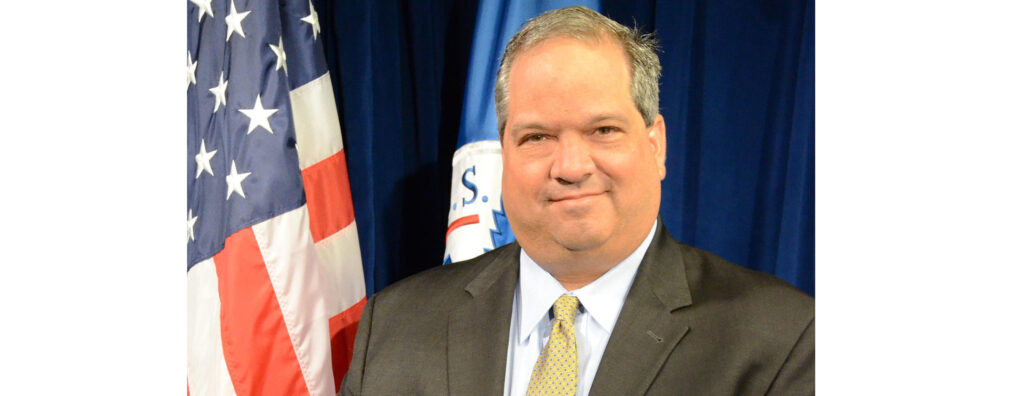
For most people, catastrophic thinking is something they want to avoid. For Eric Letvin ’92, G’94, preparation for disasters has defined his professional career. Letvin is the Deputy Assistant Administrator for Mitigation the Federal Emergency Management Agency (FEMA) and directs FEMA’s pre- and post-disaster mitigation programs that support local level projects intended to avoid or reduce the loss of life and property.
At Syracuse University, Letvin completed both his Bachelor’s and Master’s degrees in environmental engineering while working under the guidance of Civil and Environmental Engineering Professors Charles Driscoll and Chris Johnson. After graduation, he initially worked for engineering consulting firms that dealt with hazard mitigation and risk management.
“I’ve been working in hazard mitigation since my early career, going out after national disasters and seeing how buildings performed,” said Letvin. “How to approach recommendations for rebuilding, what changes could be made to codes and standards to reduce the vulnerabilities to future natural hazards.”
Letvin made the move to public service and was named the Disaster and Failure Studies Program Director within the National Institute of Standards and Technology’s (NIST) Engineering Laboratory under the Department of Commerce. NIST teams assess building and infrastructure performance during natural disasters and evaluate steps that could be taken to improve future construction.
“We conducted an extensive investigation of the Joplin tornados, making recommendations to codes and standards.”
After NIST, Letvin was the Director of Hazard Mitigation and Risk Reduction Policy for the National Security Council. In his role, Letvin coordinated disaster preparation efforts and advised the President and members of Congress on projects designed to protect crucial infrastructure during a disaster.
“We did a lot of work supporting the rebuilding after Superstorm Sandy and I helped write executive orders aimed at increasing resiliency to floods, wildfires and earthquakes,” said Letvin.
After studying the impact of Tropical Storm Allison on Southeast Texas in 2001, Letvin’s office supported mitigation grants which improved flood walls and structural improvements to the Texas Medical Center.
“When Hurricane Harvey hit, that medical complex was operational. The hospitals remained operational during Harvey due to the well-designed flood protection measures.” said Letvin.
Letvin joined FEMA in 2016, overseeing Hazard Mitigation Grant Program, the Pre-Disaster Mitigation Grant Program, the Flood Mitigation Assistance grants, the Floodplain Management component of the National Flood Insurance Program.
Over 22,000 communities across the U.S. participate in the National Flood Insurance Program and they are all responsible for enforcing the minimum standards for building in floodplains.
“Our dollars help promote hazard risk reduction,” said Letvin. “We want to lessen the impacts of future disasters so look at projects and determine if they are effective and feasible. We are always thinking about the next event.”
As part of FEMA’s response to COVID-19, Letvin was asked to think about the future and how different government agencies could coordinate the response mission in a pandemic environment.
“How would we conduct s response in a COVID environment?” said Letvin. “It’s a completely different environment, we exercise for it, we plan for it.”
Letvin believes that COVID-19, like many other challenges facing our society, will require bringing people together with different areas of expertise.
“If we make progress, engineers will play a crucial role but we need to work with the scientists,” said Letvin. “How do we protect the critical infrastructure in our country? We need to work with health care professionals to understand how it operates.”
He sees the interdisciplinary approach at Syracuse University as a strong foundation for his career. Being on a campus with renowned policy, engineering, computer science, management, public health and communications programs reflects the collaborations needed every day in the real world.
“You work with colleagues to solve a larger problem, the critical thinking – that is very applicable after graduation,” said Letvin.
2022 Engineering and Computer Science Research Day Awards

We are happy to announce the winners from the 2022 Engineering and Computer Science Research Day held on March 25th, 2022.
Poster Competition
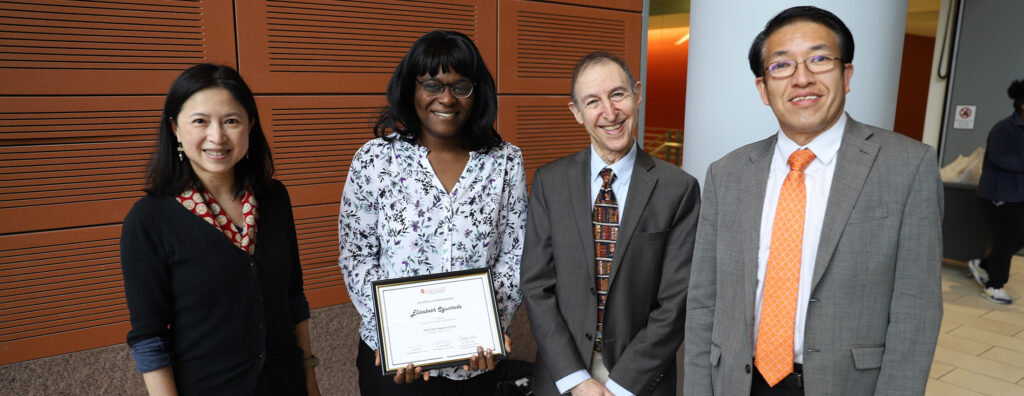
1st Place: Elizabeth Oguntade, PhD student in Bioengineering.
On-Demand Activation of Functional Protein Surface Patterns with Tunable Topography
Suitable for Biomedical Applications. Advisor: Dr. James Henderson
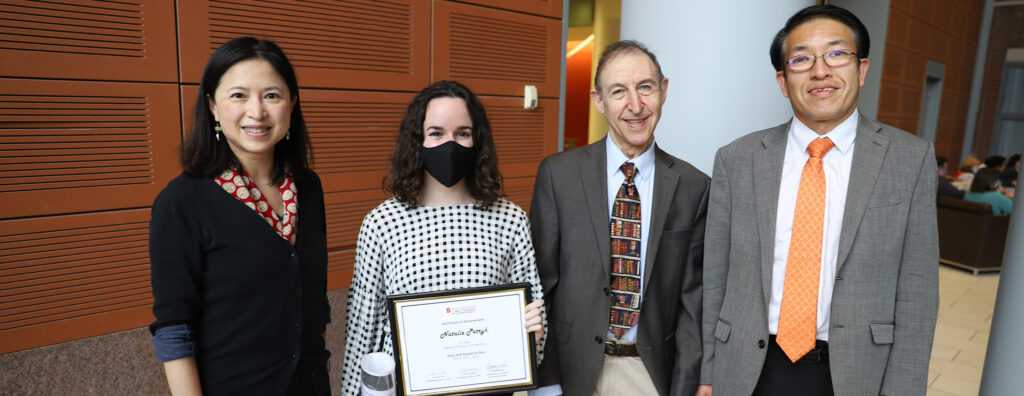
2nd Place: Natalie Petryk, MS student in Bioengineering.
Synthesis of Shape Memory Polymer Foams with Off-the-Shelf Components for Improved
Commercialization. Advisor: Dr. Mary Beth Monroe

3rd Place: Alexander Hartwell, PhD student in Mechanical and Aerospace
Engineering.
Introduction of a Multilayered Cathode for Improved Internal
Cathode Tubular Solid Oxide Fuel Cell Performance. Advisor: Dr. Jeongmin Ahn
Honorable Mention: Saif Khalil Elsayed, MS student in Civil Engineering.
Modeling Self-Folding Hybrid SU-8 Skin for 3D Biosensing Microstructures.
Advisor: Dr. Zhao Qin
Oral Presentation Competition
Communication and Security Session
1st Place: Kai Li, PhD student in Electrical/Computer Engineering. Detect and
Mitigate Vulnerabilities in Ethereum Transaction Pool. Advisor: Dr. Yuzhe Tang
2nd Place: Xinyi Zhou, PhD student in Computer/Information Science. “This is
Fake! Shared it by Mistake”: Assessing the Intent of Fake News Spreaders. Advisor:
Dr. Reza Zafarani
Health and Well-being Session
1st Place: Yousr Dhaouadi, PhD student in Chemical Engineering. Forming
Bacterial Persisters with Light. Advisor: Dr. Dacheng Ren
2nd Place: Henry Beaman, PhD student in Bioengineering. Gas-Blown Super
Porous Hydrogels with Rapid Gelling and High Cell Viability for Cell Encapsulation.
Advisor: Dr. Mary Beth Monroe
Energy, Environment & Smart Materials Session
1st Place: Durgesh Ranjan, PhD student in Mechanical and Aerospace Engineering.
Porous nanochannel wicks based solar vapor generation device. Advisor: Dr.
Shalabh Maroo
2nd Place: Alexander Johnson, PhD student in Civil Engineering. Estimating Dry
Deposition of Atmospheric Particles by Rain Washoff from Urban Surfaces.
Advisor: Dr. Cliff Davidson
Sensors, Robotics & Smart Systems Session
1st Place: Lin Zhang, PhD student in Computer/Information Science. Adaptive
Sensor Attack Detection for Cyber-Physical Systems. Advisor: Dr. Fanxin Kong
2nd Place: Zixin Jiang, PhD student in Mechanical and Aerospace Engineering,
Short-term occupancy prediction driven intelligent HVAC control. Advisor: Dr. Bing
Dong
Syracuse University and the Rochester Institute of Technology Partner to Reduce Wasted Food in New York State
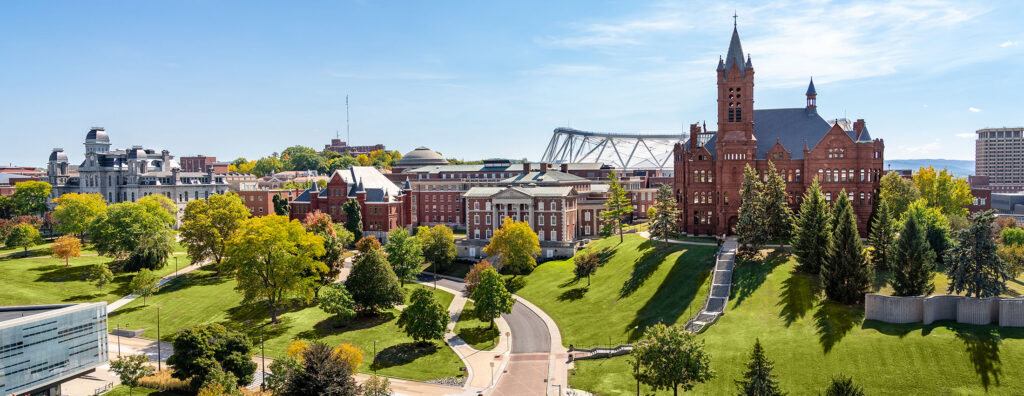
Syracuse University’s Center for Sustainable Community Solutions (CSCS) and the New York State Pollution Prevention Institute (NYSP2I) at the Rochester Institute of Technology are partnering on a grant from the U.S. Department of Agriculture (USDA) to assist communities and stakeholders in New York State with reducing the amount of edible food that goes to waste.
The USDA estimates that approximately 35 percent of food produced in the U.S. goes uneaten, which according to the nonprofit Rethink Food Waste through Economics and Date (ReFED), incurs a nationwide annual cost of more than $400 billion. Wasted food is also a large contributor to global climate change and wastes significant amounts of freshwater, energy, and other agricultural inputs. Perhaps most egregiously, the U.S. is wasting more than one-third of its food supply while Feeding America estimates that 1 in 9 Americans face hunger.
To help mitigate these issues, CSCS and NYSP2I are collaborating to develop a series of workshops, guidance materials, and technical assistance opportunities for New York State community leaders, with a focus on rural areas. These community leaders and other stakeholders will receive guidance, training, and support for the creation of local sustainable organics management plans. Some aspects of the plans will include quantifying and characterizing local food loss, identifying opportunities for food loss reduction, establishing networks for edible food rescue, creating systems for food scraps collection and processing (e.g., composting), and more.
“We are thrilled to team up with NYSP2I to complement each other’s experience and knowledge in reducing wasted food,” says CSCS Assistant Director, Melissa Young. “Our teams will work with communities to develop solutions for getting more edible food to hungry people and diverting more organic materials to be recycled into valuable soil amendment.”
This effort will help expand the benefits of The NYS Food Donation and Food Scraps Recycling Law, which went into effect January 1, 2022, by providing additional support to stakeholders who may or may not be affected by the law. Currently, the law only pertains to certain entities that generate an annual average of two tons or more of food waste per week.
“Creating a better, more sustainable future for our rural communities takes teamwork, and collaboration with all of the stakeholders,” says NYSP2I Director, Charles Ruffing. “NYSP2I is excited to join forces with these communities and CSCS to help reduce edible food waste across the Empire State.”
CSCS and NYSP2I will begin promoting the workshop series in the Spring of 2022 with the goal of facilitating multiple training events throughout the Summer of 2022. If you are interested in receiving updates about the workshop series, or learning more about this program, please contact SU-CSCS Program Manager, Jesse Kerns, at jekerns@syr.edu.
Collaborative Partnership Between Syracuse University and Leading Research Universities Receives Presidential Award

The GEM Consortium, a collaborative partnership between leading research universities and industry to help underrepresented students earn masters and doctoral degrees in STEM fields, received the 2021 Presidential Award for Excellence in Science, Mathematics and Engineering Mentoring.
Syracuse University has been a member of the GEM Consortium for almost 30 years. In the past 5 years, GEM Fellowships have been awarded to graduate students in the School of Architecture, College of Arts and Sciences, College of Engineering and Computer Science as well as the School of Information Studies. The number of GEM Fellowship applications from SU students is now in the top 10 among GEM member universities. Civil and environmental engineering Professor Dawit Negussey is the current Syracuse University representative on the GEM Consortium.
“The award recognizes the contributions of the GEM Consortium in providing a scalable path to STEM careers in academia and industry for underrepresented students,” said Negussey.
“I’m grateful for all of Professor Negussey’s efforts to grow our graduate education pipeline for underrepresented graduate students at Syracuse University,” said Peter Vanable, dean of the Graduate School. “To go from relatively little activity with the GEM Consortium to being a top 10 contributor of GEM applicants is a clear marker of our commitment to increasing the diversity of our graduate student population.”
Over the past 45 years, more than 4000 GEM Fellows have earned MS and PhD degrees in STEM fields. At present, the GEM consortium membership consists of 129 private and public national universities and 61 major corporations and research laboratories.
Building for the Future: Dawn Penniman ’90, G’97

From her first visit to campus and meeting with civil and environmental engineering Professor Sam Clemence, Dawn Penniman ’90, G’ 97 knew Syracuse University was the place for her.
“Sam was so influential to me,” said Penniman. “When I met him, that was the lynchpin for why I wanted to come to Syracuse.”
After finishing her undergraduate degree in civil engineering, she started working at a firm in Syracuse and completed her master’s degree in environmental engineering while working full-time. Those degrees were the beginning of a career in hazardous waste investigation and remediation with Arcadis. Over the past thirty years she has been remediating sites and managing projects related to multiple facets of environmental engineering.
As she looks back at where her career, she sees the Orange roots that made it possible.
“I wanted to give back to the university,” said Penniman. “I am a very proud alum and I want to provide this opportunity to the next generation of engineers and computer scientists.”
Penniman worked with College of Engineering and Computer Science (ECS) development staff to document her planned gift. Once realized, her gift will support scholarships and programs for years to come.
“It was very easy to change the beneficiary on my 401K and the potential for helping others is incredible. I hope this will help encourage more young women to pursue STEM fields.
If you’d like to document a planned gift or bequest with ECS, please contact Amy Gullotta asgullot@syr.edu.
Fall 2021 Engineering and Computer Science Dean’s List

In recognition of superior scholarship, the following students have been entered on the Engineering & Computer Science Dean’s List for Fall 2021.
To be eligible for Dean’s List recognition, the minimum semester grade point average must be 3.40 or higher, must have earned a minimum of 12 graded credits and must have no missing or incomplete grades.
Aerospace Engineering
Lucy Genevieve Adams
Allyson Almeida
Brady Joseph Arruda
Richard L Bruschi
Curtis James Cline
Bryan Collins
Nicholas Daniel Crane
Brian James Cronin
Christopher John Doherty
Michael Alexander Donato
Benjamin David Faasse
Kassidy Fields
Christian Scott Fitzgerald
Victoria Elizabeth Forsyth
Benjamin Daniel Gerard
Alexandre J Gill
Zachary William Haas
Alyssa Henley
Aidan Hoff
Matthew James Holmes
Paula Cristina Ibelings
Nicholas John Jacobs
Sydney F Jud
Hunter John Adam Knarr
Trevor Anthony Knight
Eleanor Jane Lawler
Isaac Alan Lehigh
Emma Lee Levenson
Maximillian Lipinski
Jacob Eric Long
Powers Craig Lynch
Brendan Michael Marquis
Noah Martel
Elsa Adrianna Martin
Jonathan Henry Martin
Maxwell Joseph Martin
William Armstrong Martin
Jason W McElhinney
Mariana C McManus
Parker Byrne McMillan
Alexander Timothy Metcalf
Romeo Michelson
John P Michinko
Kendra Teresa Miller
Evan Gregory Moore
Brendan Pierce Murty
Mark Namatsaliuk
Tatiyyanah Queen-Asia Hope Nelums
Jarod I Okamura
David Dang Pham
Logan D Prye
Nicholas Christopher Richard
Brandon Walker Riley
Tracey Josephine Rochette
Daniela Maria Ruano-Pinos
Michael Chandler Saksa
William J Saueressig
Fred Evan Schaffer
William Arthur Sennett
Justine John A Serdoncillo
Kanya Kiresh Shah
Vraj Shah
Prabha Singh
Gregory C Slodysko Jr
Zachary Michael Stahl
Ethan J Stocum
Jaime S Sued Jr
Yiyuan Sun
Marco Svolinsky
Richard A Tedeschi
Anthony R Tricarico
Cody Joseph VanNostrand
Diego Roman Villegas
Mason Alexander Weber
Kana Li Wong
Cameron M Woodbury
Melissa Yeung
Bioengineering
Anthony Drew Acierto
Ashraf Tariq Alnatour
Bianca Louise Andrada
Jason Bae
Anna Mae Brunson
Britnie Jean Carpentier
Lukas Cook
Tessa Riley Decicco
Mia-Marie Fields
Katherine Ann Gardner
Jennifer Gonzalez
Skyla Gordon
Benjamin Michael Grainger
Jenna Grutzmacher
Grace Haas
Lauren Elizabeth Hamilton
Victoria Li Rui Hathaway
Brenna Henderson
Avinash Jagroo
Madeline Jones
Gabriel Khan
Olivia Lynne Kmito
Emily Elizabeth Labour
Quinn Patrick Langdon
Sara Anne Leonardo
Alejandra Eugenia Lopez
Ethan L Masters
Aidan Theresa McCarthy
Aelish McGivney
Ian G McHugh
Lindy M Melegari
Katherine Grace Monroe
Hannah V Murphy
Alexander Patrick Musselman
Mark Nicola
Nicole E Nielsen
Kerrin Anne O’Grady
Mia Dian Paynton
Megan Perlman
Connor Preston
Michael Steven Presunka
Gavin David Richards
Mia Elizabeth Russo
Amira Salihovic
Juliana Sepulveda
Bridget Yong Sides
Katherine Anne Southard
Justin N Stock
Elizabeth Tarami Su
Zhuoqi Tong
Rochan Jitendra Urankar
Hasan Usmanov
Edgardo Velazquez
Danny Vu
Carly J Ward
Nathaniel D Wellington
Maximillian Meier Wilderman
Lauren Margaret Woodford
Rui Xie
Julian Marcus Smucker Zorn
Samantha Yvonne Zysk
Chemical Engineering
Adriana M Archilla
Athena Andrea Basdekis
Brigitte A Belanger
Sandy Ynhu Cao
Trinity Joy Coates
Dennis Dao
Gabriela Duarte Saadia
Sophia Elizabeth Figueroa
Emily C Fittante
Edward Coleman Fluker
Mia Angela Goldberg
Brent Tadao Gosselin
Avery Gunderson
Christopher Max Hansen
Aiden A Jacobs
Natalia Jarmain
Hope Irene Johnson
Sonia Julius
Sayf Karim
Laxmi Khatiwada
Adam J Klinger
Simran Dharmendra Lakhani
Caroline J Leduc
Rawia F A M Marafi
Angela L Martinez
Sydney Rae Nowicki
Erin Marie Odonnell
Sean O’toole
Eli Irvin Paster
Daniel J Pelkey
Fabiana Nohelia Perez
Nora Swan Prosak
Ryan Gordon Ryersen
Riley Madison Schmerber
Jacob Matthew Shellhamer
Jason Tan
Elizabeth M Wall
Tyrese J Whyte
Jackson Richard Yuen
Civil Engineering
Shalom Acheampong
Cassie Agren
Nicole Ayora
Maxwell Bell
Christian Balingit Bianco
Henry C Bievenue
Ryan Bourdeau
Matthew Emmet Brewster
Alycia Joline Bruce
Masson Bruening
David Coghiel
Alejandro E Correa
Aymeric P Destree
Kelly Diaz Rojas
Jack Dwyer
Marlee Ann Ecton
Stephen Goffredo
Elliane Reut Greenberg
Julia Ann Johnson-Milstein
Joshua Michael Kaufman
Jakob Lamond Keller
Kate Astrid Kemnitz
Alexander Gregory Klee
Adam Paul Landry
Evangelia Birget Larson
Abigail G Laschalt
Daniel Leyva
Emma Marie Liptrap
Emilija Alise Lizins
Erick Lojano-Quispe
William Ma
John M Mazza
Jessica M McGowan
Lucas James Meiers
Sumit Harshad Mistry
Amira Mouline
Mazin F Moya
Trevor Robert Napoli
Marissa R Nicole
Maxwell Robert Pozar
Kaylin Janet Richards
Alexander David Ruppe
Cassie Elizabeth Saracino
Yazbeck Thomas Sarkees
Juha Wesley Schraden
Aaron Presley Shinn
Caitlin Jane Spillane
Jose Arturo Venegas
Christian Viola
Angelina Maggie Wong
Isabelle Wong
Sarah Wong
Paige H Yamane
Sifei Zhu
Computer Engineering
Adekunle J Akinshola
Chikeluba K Anierobi
Graciela Gicel Avila
Mergim Azemi
Kyle J Betten
Jackson Thomas Bradley
Carlon Brown
Dynasty Da’Nasia Chance
Kongxin Chen
Ibrahima Diallo
Lyn El Sayed Kassem
Melvin Ruben Escobar Gonzalez
Xavier Evans
Elizabeth A Fatade
Aidan Robert Harrington
Ethan Hensley
Kasey Jackson
Mehak Jetly
Virkin Jimenez
Benjamin N Johnson
Fundi Juriasi
Robert Nicholas Kashian
Bikash Khatiwoda
Jessica K Lat
Tyler Alexander Lavaway
Matthew B Leight
Jiaxiong Li
Nicholas Kent Magari
Kyle Maiorana
Aksel James Malatak
Jacob Stephen Masrouri
Isabel M Melo
Benjamin Hudson Murray
Pierce Austin Neubert
Jose L Olivera
Derrick Nana Yaw Osei Owusu
Alexander C Perez
Anthony Patrick Riello
Alfonso E Rivas
Daniel Rose
Samuel M Rosenthal
Hongyi Ruan
Zachary Joseph Starr
Declan Wavle
Ryan Wolff
Renjie Xu
Andy Zheng
Computer Science
Aashutosh Acharya
Aaron Alakkadan
Labeeb Alam
Sajjad Abdullah Albadri
Huda A Ali
Anas Abdallah Hussein Alkhashroom
Joseph M Balascio
Simon C Barley
Giovanna Elizabeth Barsalona
Samantha E Bastien
Maxwell Robert Beam
Emma Bellai
Anas Ahmed Benhamida
Joshua Jordan Boucher
Brian Michael Bourne
Amanda Leigh Bowdren
Ella Maria Brink
Bryan Bladimir Bueno Reyes
Christopher Manuel Calderon Suarez
Liam M Calnan
Megan J Campbell
Chih-Chia Chen
Hong Yang Chen
Jackie Chen
Lawrence Chen
Runzhou Chen
Wenyu Chen
Yixing Chen
Yuhao Chen
Oscar Chi
Daniel Chmielewski
Season Chowdhury
Konstantinos Chrysoulas
Melissa Chu
Miguel Angel Cruz Flores
Matthew Cufari
Ryan Matthew Czirr
Salvatore DeDona
Aidan Christopher DeGooyer
Alpha Oumar Diallo
Lucille Jennifer Disalvo
Ting Dong
Christopher Edmonds
Yassin Mahmoud Elsharafi
Ryan Siebe Elsinga
Jair Espinoza
Xueyan Feng
Nathan B Fenske
Bennett Ferrari
Lucas Kuebler Fox
Mason Roy Freer
Evan Garvey
Grant Thomas Gifford
Brianna S Gillfillian
Justin Gluska
John Martin Gorman
Dayong Gu
Alexander Peter-Anthony Haas
Athanasios Hadjidimoulas
Ashley Marie Hamilton
Jillian Elizabeth Handrahan
Liam Gordon Hannah
Cameron Hoechst
Laurel Howell
Jacob Howlett
Jason Huang
Xuanye Huang
Yanju Huang
Chengyi Jiang
Tianyiming Jing
Frederick Jackson Jones
Michael Wesley Jones
Alan Jos
Lauren Keona Kaaiakamanu
Aarya Tara Kaphley
Maxwell Albert Kaufman
Matthew Keenan
Ekaterina Kladova
Joshua Jayvant Zachary Koshy
Krutartha Nagesh
Rami Lionel Kuttab
Janet Jihoo Lee
Maya J’Nai Lee
Jiashu Li
Ruowen Li
Yuxuan Li
Daniel Lim
Chengda Lin
Haochen Lin
Sandy Lin
Erxi Liu
Jiaming Liu
Joshua Zhou Liu
Junzhang Liu
Yuyuan Liu
Cayden Thomas Lombard
Kevin A Lopez
Yiheng Lu
Michael Fitzgerald Lupton Jr
Runzhi Ma
Hunter O’Neal Malley
Andrew Thomas Markarian
Kanoa Matton
Ryan M May
Anthony Louis Mazzacane
Matthew McDaniels
Noah Mechnig-Giordano
Philip Anthony Moceri
Thomas J Montfort
Aaron Masoud Moradi
Jovanni Nicholas Mosca
Chenxi Mu
Andi Muhaxheri
Zoe Anne Neale
Christopher Scott Nemeth Jr
Jillienne Judith Ness
Arianna Kassandra Nguyen
Carlyn M O’Leary
Marissa Lynn Orsley
Daniel Pae
Xiaofeng Pan
Michael J Panighetti
Adya Aditi Parida
Zizheng Pei
Brian Joseph Pellegrino
Carlo Francesco Pisacane
Daniel Pomerantz
Fiona Colleen Powers Beggs
Cheng Qiu
Shane Michael Race
Raasin Amin Rahman
Alexis Hope Ratigan
Christopher Rhodes
Robert R Robinson
Eric Rodriguez
Sadikshya Sanjel
Jonathan Lee Schwenk
Huahao Shang
Andrew Shao
Nolan Lee Shepherd
Chad Thom Smith
Anthony Logan Solt
Dongzhao Song
Yijie Song
Hayden Christopher Spelbring
Jeremy P Stabile
Kevin Sullivan
Nicholas P Sweet
Louanges Essohana Marlene Takou-Ayaoh
Jonathan Richard Constantine Templeton
Jonathan Ezra Thomas
Eduardo Torres-Garcia
Winston Tsui
Randy C Vargas
Kevin Anthony Verdeschi
Kritika Verma
Christopher Mark Vinciguerra
Lihan Wang
Ruobing Wang
Xinyi Wang
Zijian Wang
Robert Ward
Jack Andrew Willis
Sarah Grace Wlodkoski
Ethan Wong
Zongxiu Wu
Zhuoyi Xiong
Yujie Xu
Jishuo Yang
Yisheng Yang
Yongcan Yang
Stella R Yaunches
Yulun Zeng
Liaotianbao Zhang
Mingyan Zhang
Rixiang Zhang
Ruihao Zhang
Weiwei Zhang
Zhiyuan Zhang
Haoyu Zhao
Jinchao Zhao
Junjie Zheng
Xiao Lin Zheng
Liuyu Zhou
Xinqian Zhou
Yitao Zhou
Yixuan Zhou
Joseph Patrick Zoll
Engineering Undeclared
Sydney M Baylor
Thomas John Fabiano
Charles James Germosen
Alexander Joseph Hai
Juwei Lin
Luke Benjamin Lybarger
Kathleen Rose Meleski
Annika Daphne Meyers
James Peden
Justin Wayne Pettit
Emily Mae Schiessl
Abdullah Swati
Haoran Wang
Electrical Engineering
Minghao Ai
Mohammed A Aljohani
Tianle Bu
Kevin E Buciak
Wyatt Glenn Bush
Vincent Alec Camarena
Arianna Maxine Cameron
Leshui Chen
Nicholas Shawn Connolly
Kevin James Donnelly
Henry C Duisberg
Randy Galicia
John Charles Garcia
Justin P Geary
Christopher Gill
Jose Ignacio Ginorio
Joseph Charles Jannello
Michael Matthew Kelly
Dong Kyu Kim
Yiwei Ling
Jemma Mallia
Liam Fuller Marcato
Tyler Sean Marston
Angel Antonio Medina
Lukas Allen Morris
Zixun Nian Nian
Jayson V Okhman
Dylan Palmer
Julia Pepin
Matthew Piciocchi
Francisco Rodriguez
Gilberto E Ruiz
Gabriel E Ruoff
Kayla Ann Saladyga
Jenna Mei Stapleton
Connor Christopher Sumner
Jared William Welch
Environmental Engineering
Tyler James Allison
David Michael Brodsky
Benjamin R Cavarra
Ananya P Chandra
Emma Crandall
Elizabeth Bryant Cultra
Eric James Fitzgerald
Eleanor Elizabeth Gettens
Brady E Hartnett
Christopher Harvey
Nicholas Colin Axel Kohl
Henry David Long
Molly M Matheson
Salma Valles Mohamed
Matthew Edward Nosalek
Liesel Marie Odden
Hennecys Darlene Perez Castro
Ella Hope Phipps
Scott M Potter
Yongfang Qi
Jasmine Victoria Rodriguez
Mary H Schieman
Hayley Shay Scott
Jacob M Tyler
Andrew Michael Vanderwege
Maria Antonia Villegas Botero
Emily Jean Vogel
Anna Wojcik
Savannah Marie Wujastyk
Qiuyu Zhou
Reilly Zink
Mechanical Engineering
Owyn Phillip Adams
Joshua Carl Arndt
Timothy G Arnold
Charles D Ball
Arthur Barros
Michael James Battin Jr
Erin Beaudoin
Rachael O Beresford
Aidan Paul Bergman
Jeffrey Trent Bernstein
Chloe Marie Britton Naime
Brinley Bruening
Arnaud Buard
Alexander Joseph Callo
Joseph Timothy Capra
Jun Chen
Artur Chuvik
Cooper P Crone
Anthony Cruz
Peter M Daniels
Ryan Russell Dileo
Madeline Doyle
Luyen Duong
Andrew J Esposito
Luke Samuel Fink
Nicholas Andrew Frank
Elan Fullmer
Samuel Ryan Getman
Kara Ai Chun Gorman
Jiayuan Huang
Vian Vishal Jain
Jagger Kachmaryk
Dong Myeong Kang
Jeremy C Kang
Macauley J Kastner
Finnian James Kery
Teagan L Kilian
Cherry Kim
Carl Winston Rice Kjellberg
Justin Kohan
Deanna Summer Koppenjan
Savannah Mae Kreppein
Trevor D Kroells
Nathan Lemoine
Honorata Lubecka
Bei Luo
Lauren Mack
Ryan Patrek Martineau
Michael J McElroy
Ryan A Melick
James Patrick Melitski
Leilah Miller
Wiley Robert Moslow
Beau M Norris
Daniel Panchenko
Nicholas Joseph Papaleo
Nathaniel Ryan Paradis
Tanner Josiah Peck
Corey A Phung
Nicholas Patrick Piano
Alexander Richard
Aidan Riederich
Collin Roche
Jeremy Vinton Rosh
Jeffrey Ryu
Nitish Sachin Satpute
Justin Sauve
Shane Michael Sefransky
William Kaspar Sherfey
Zachary Ryan Shuler
Eric Silfies
Nathaniel Slabaugh
Samuel Theodore Slaiby
Ian Storrs
Matthew K Swanson
Ethan William Tracey
Evan R Tulsky
Alexandra Rose Vaida
Nicholas Valentin
Griffin Riley Vollers
Xu Wang
Michael David Wehrle
Justin H Westhuis
Taj Asim Whitney
Michael Wong
Systems & Information Science
Connor W Gurnham
Stacy Kim
Akshay Ram
Zachary Tyler Williams
Min Liu
Degrees:
- Ph.D. in Engineering Project Management, University of California Berkeley, 2007
- Master of Science in Building Science, National University of Singapore, 2001
- Master of Science in Civil Engineering, Xi’an University of Architecture and Technology; Concentration: Construction Engineering Management, 1997
- Bachelor of Science in Civil Engineering, Qingdao Institute of Architecture and Engineering; Concentration: Structural Engineering, 1994
Lab/ Center/ Institute affiliation:
- Syracuse University Infrastructure Institute
Areas of Expertise:
- Lean Construction techniques for construction productivity improvement.
- Work module development for Digital Twin design.
- Using data mining and machine learning approaches for intelligent construction planning.
- Integration of project information into visualization and simulation models.
- Project control systems and field management technologies.
Areas of expertise:
Dr. Min Liu’s research field is developing innovative approaches and generating knowledge on how to integrate the Human and Engineering aspects of construction planning to improve productivity and project performance. She has published over 50 articles in top-ranked journals in Construction Engineering and Management. Her current research interests and expertise include:
- Implementation of Large Language Modeling in construction planning reliability improvement
- Ontology for construction working method and management database
- Construction worker’s mental health
- Infrastructure project delivery and policy
- Prioritizing bridge preservation activity based on safety and socioeconomic factors
Honors and Awards:
Dr. Liu’s recent research on using the Information Theory approach to quantify information exchange effectiveness in construction planning won the 2021 American Society of Civil Engineers (ASCE) Thomas Fitch Rowland award. Her work has also received the Best Paper Awards from the 2018 International Group of Lean Construction Conference and the 2017 Lean and Computing in Construction Congress. She received the “Thank a Teacher” awards in 2018, 2017, and 2011 at the North Carolina State University.
Selected Publications:
*Graduate student advised by Dr. Min Liu, **Corresponding author
- Javanmardi, A.*, Liu, M., He, C.**, Hsiang, S., and Hosseini, A.* (2024). “Improving Construction Meeting Effectiveness: Trade-off Between Reactive and Proactive Site-level Planning Discussions. Accepted by ASCE Journal of Management in in March 2024.
- Ding, F.*, Liu, M.**, Hsiang, S., Hu, P., Zhang, Y. and Jiang, K.* (2024). “Duration and Labor Resource Optimization for Construction Projects—A Conditional-Value-at-Risk-Based Analysis.” Accepted by Buildings in February 2024.
- Scala, N., Schiavone,V., Alves, T., and Liu, M., (2024). “The Gold Standard: Developing a Maturity Model to Assess Collaborative Scheduling.” Accepted by Engineering, Construction and Architectural Management in January 2024.
- He, C.*, Liu, M.**, Hsiang, S., and Pierce, N. (2024). “Synthesizing Ontology and Graph Neural Network to Unveil the Implicit Rules for US Bridge Preservation Decisions.” Accepted by ASCE Journal of Management in Engineering in January 2024.
- Javanmardi, A.*, He, C.*, Hsiang, S., Hosseini, A.*, Liu, M.** (2023). “Enhancing Construction Project Workflow Reliability Through Observe-plan-do-check-react Cycle: A Bridge Project Case Study.” Buildings, 13(9), 2379. https://doi.org/10.3390/buildings13092379
- Chen, G.*, Li, H., Liu, M.**, and Hsiang, S. (2023). “Motivating Reliable Collaboration for Modular Construction: Shapley Value-based Smart Contract.” ASCE Journal of Management in Engineering, 39(6), 04023042. https://doi.org/10.1061/JMENEA.MEENG-542
- Chen, G.*, Liu, M.**, Zhang, Y., Wang, Z.*, Hsiang, S. M., and He, C*. (2023). “Using Images to Detect, Plan, Analyze, and Coordinate a Smart Contract in Construction.” ASCE Journal of Management in Engineering, 39(2), 1–18. https://doi.org/10.1061/JMENEA.MEENG-5121
- He, C.*, Liu, M.**, Zhang, Y., Wang, Z.*, Hsiang, S. M., Chen, G.*, Li, W., and Dai, G. (2023). “Space–Time–Workforce Visualization and Conditional Capacity Synthesis in Uncertainty.” ASCE Journal of Management in Engineering, 39(2), 04022071. https://doi.org/10.1061/JMENEA.MEENG-4991
- Chen, G.*, Li, H.**, Liu, M., and Hsiang, S. (2023). “Knowing What is Going on – a Smart Contract for Modular Construction.” Canadian Journal of Civil Engineering, 50(3), 210-223. https://doi.org/10.1139/cjce-2021-0649。
- Zhang, M.*, Chih, Y., Zhang, Y., Liu, M.**, and Hsiang, S. (2022). “Impacting Factors of Work Engagement in Construction Projects -an Information Theory based Analysis.” Engineering Economy, 32 (9), 1-13.
- Bonilla, M.*, Rasdorf, W., Liu, M., Al-Ghandour, M., and He, C. (2022). “Inequity Reduction in Road Maintenance Funding for Municipalities.” Public Works Management & Policy, 28(3), 1-24. https://doi.org/10.1177/1087724X221130047
- Jiang, K.*, Liu, M.**, He, C.*, Zhang, Y., Wang, Z.*, and Hsiang, S. (2022). “A Choquet Integral Based Approach to Explore Workforce and Duration Optimization for Construction Projects.” Journal of Civil Engineering and Management.
- Scala, N., Schiavone,V., Olivieri, H., Seppänen, O., Alves, T., Liu, M., and Granja, A. (2022). “Comparative Analysis of the Implementation of Critical Path Method, Last Planner System, and Location-Based Techniques in Brazil, Finland, and the United States.” Engineering Management Journal, 35(3), 237- 256. DOI:10.1080/10429247.2022.2069981
- He, C.*, Liu, M.**, Scala, N., Alves, T., and Hsiang, S. (2022). “Prioritizing Collaborative Scheduling Practices Based on Their Impact on Project Performance.” Construction Management and Economics. 40(7-8), 618-637, DOI: 10.1080/01446193.2022.2048042
- Scala, N., Liu, M., Alves, T., and Hawkins, D., and Schiavone, V. (2022). “The Gold Standard: A Collaborative Scheduling Maturity Model.” Engineering, Construction, and Architectural Management, 30(4), 1636-1657. https://doi.org/10.1108/ECAM-07-2021-0609
- He, C.*, Liu, M.**, Zhang, Y., Wang, Z.*, Hsiang, S., Chen, G.*, and Chen, J. (2022). “Exploit Social Distancing in Construction Scheduling: Visualize and Optimize Space–Time–Workforce Tradeoff.” ASCE Journal of Management in Engineering, 38(4), 04022027. https://ascelibrary.org/doi/abs/10.1061/%28ASCE%29ME.1943-5479.0001037
- Wang, Z.*, Zhang, Y., Tian, L., and Liu, M.**(2022), “Exploring the Application of Takt Time Planning Method in Construction Management.” Journal of Civil Engineering and Management (in Chinese). 39(02), 157-166.
Civil and Environmental Engineering Ph.D. Student Takes Second Place at “Science as Art” Competition
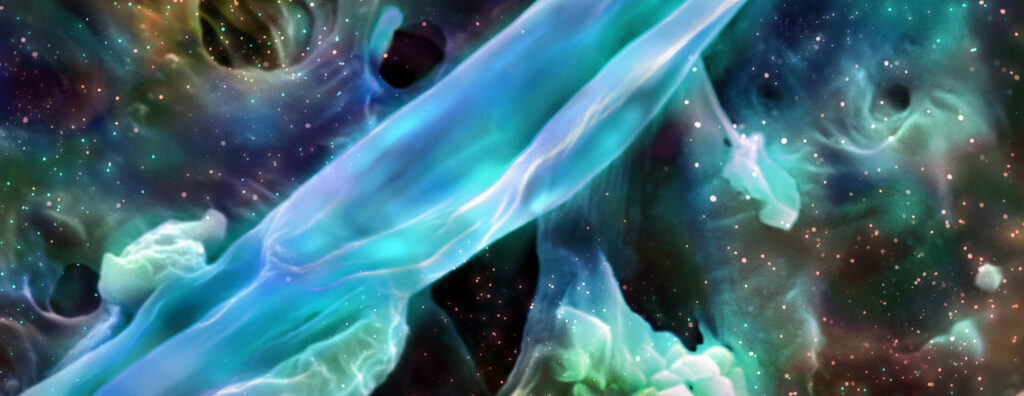
Civil and Environmental Engineering Ph.D. student Libin Yang was awarded second place in the Science as Art Competition at the 2021 Materials Research Society Fall Meeting.
Here is Yang’s description of the artwork- “The best way to know the world is to observe, and people throughout history have devoted themselves to observing and recording everything they see, just as Jean-Henri Fabre did 100 years ago, in a garden called Harmas de s érignan, trying to use watercolors to render this ingenious creature, the fungus. This figure is reproduced based on a Scanned Electronic Microscope image of Pleurotus Eryngii mycelium growing on a hardwood substrate. Pleurotus Eryngii belongs to the basidiomycetes has a unique structure of their mycelium called clamp connection ((L. Yang, D. Park, Z. Qin, Material Function of Mycelium-Based Bio-Composite: A Review, Frontier in Materials, 2021)). The logic behind the creation of this art piece is, through SEM, we can get infinitely closer to that tiny and fascinating world. As with the first discovery of a universe in a drop of water, there is always a romantic fantasy of what has never been seen which is to Imagine the universe not only diversification but also uniqueness. These microscopic structures, and the ideals that people seek, reflect the obscure but exact truth of nature.”
Introducing the Inaugural Patrick P. Lee Scholars in the College of Engineering and Computer Science
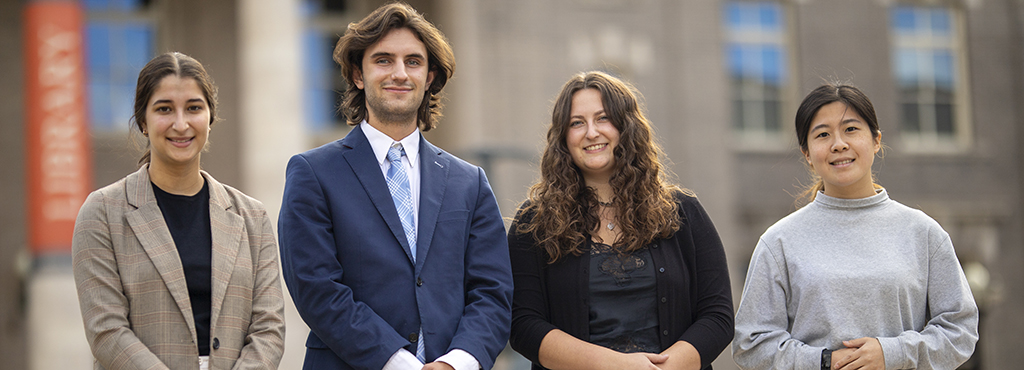
Syracuse University’s College of Engineering and Computer Science is honored to announce our inaugural Patrick P. Lee Scholars. The Lee Foundation’s largest scholarship program supports students at institutions of higher learning who are pursuing careers in engineering and other technical fields.
Joli Cacciatore is a fourth year Civil Engineering student from Niagara Falls, NY. Since arriving at SU she has been part of the ECS Ambassador Scholars program which conducts outreach to local middle schools to foster interest in STEM and provide positive educational role models. She is a member of the SU student chapters of the National Society of Professional Engineers, the Society of Women Engineers, and the American Society of Civil Engineers.
Stacy Kim is a fourth year Systems Information Science major from Staten Island, NY. She has several leadership positions in campus organizations including Vice President of the Society of Asian Scientists and Engineers and Community Service Chair for Kappa Theta Pi through which she conducted outreach to local high schools to help with the transition to online learning. Since 2019 she has worked for the Barnes Center in health promotion for her fellow students and during the pandemic has been helping administer and process COVID tests on campus.
Aymeric Destrée is a third year Civil Engineering major from San Marcos, CA. He is a member of the Ambassador Scholars program and enjoys working with children in the Syracuse public school system to introduce engineering concepts and problem solving skills through fun after school activities. He plans a career in public infrastructure and is particularly interested in transportation and urban design.
Olivia Kmito is a third year Bioengineering student from Bridgewater MA. She is a student athlete on the SU Gymnastics team and a member of the Alpha Xi Delta sorority and the Society of Women Engineers. She has a long term commitment to the March of Dimes organization inspired by a personal connection to their work. Following in the footsteps of her father, an SU engineering alum, she believes an engineer must value “integrity, leadership, and service” and most of all take seriously the trust that their colleagues, their clients, and the public place in them and their work.
Teng Zeng
Degrees:
- Ph.D. Civil Engineering, University of Minnesota, 2012.
- M.S. Environmental Science and Engineering, Singapore Stanford Partnership, 2007.
- B.S. Environmental Science, Tongji University, 2006.
Areas of Expertise:
- Occurrence and fate of organic micropollutants
- Environmental photochemistry of organic matter
- Formation and control of water treatment byproducts
- Wastewater surveillance for substance use assessment
Our group combines collaborative field sampling, organic trace analysis, and data analytics tools to study chemical processes in natural and engineered aquatic systems. Our research primarily focuses on the occurrence and fate of organic micropollutants in surface waters and groundwater, the impacts of harmful algal blooms and lake browning on organic matter photochemistry, and the formation and control of byproducts during water treatment and reuse. Our team also develops analytical methods based on high-resolution mass spectrometry to support substance use assessment through wastewater surveillance in New York.
Honors:
- Expanding Chemistry in SETAC Award, Society of Environmental Toxicology & Chemistry (2023)
- NSF CAREER Award, National Science Foundation (2022)
- Mentor of the Year, Center for Fellowship & Scholarship Advising, Syracuse University (2022)
- Meredith Teaching Recognition Award, Syracuse University (2020)
- North America New Chemist Travel Award, Society of Environmental Toxicology & Chemistry (2017)
- Ralph E. Powe Junior Faculty Enhancement Award, Oak Ridge Associated Universities (2017)
- ExCEEd Teaching Fellowship, American Society of Civil Engineers (2016)
Selected Publications:
- Vogel, E. J.; Neyra, M.; Larsen, D. A.; Zeng, T., Target and nontarget screening to support capacity scaling for substance use assessment through a statewide wastewater surveillance network in New York. Environmental Science & Technology 2024, 58 (19), 8518-8530.
- Wasswa, J.; Perkins, M.; Matthews, D. A.; Zeng, T., Characterizing the impact of cyanobacterial blooms on the photoreactivity of surface waters from New York lakes: A combined statewide survey and laboratory investigation. Environmental Science & Technology 2024, 58 (18), 8020-8031.
- Pu, C.; Zeng, T., Comparative evaluation of chemical and photolytic denitrosation methods for chemiluminescence detection of total N-nitrosamines in wastewater samples. Environmental Science & Technology 2023, 57 (19), 7526-7536.
- Wang, S.; Basijokaite, R.; Murphy, B. L.; Kelleher, C. A.; Zeng, T., Combining passive sampling with suspect and nontarget screening to characterize organic micropollutants in streams draining mixed-use watersheds. Environmental Science & Technology 2022, 56 (23), 16726-16736.
- Wang, S.; Wasswa, J.; Feldman, A. C.; Kabenge, I.; Kiggundu, N.; Zeng, T., Suspect screening to support source identification and risk assessment of organic micropollutants in the aquatic environment of a Sub-Saharan African urban center. Water Research 2022, 220, 118706.
The Future of Flying

Civil and environmental engineering Ph.D. students Parisa Sanaei and Michael Ammoury were selected for graduate research awards from Transportation Research Board’s Airport Cooperative Research Program (ACRP). The ACRP awards support research to improve the quality, reliability, safety, and security of the United States airport industry.
Ammoury’s research will focus on improving the resilience and sustainability of airports by combining artificial intelligence, internet of things, and other smart technologies.
Many airports already have facilities and sensors that monitor environmental functions, but Ammoury will explore how those existing and novel technologies can work together to improve the environmental and resilience aspects in airports.
“Airports are like small smart cities. The digital infrastructure in airports needs to communicate seamlessly with each other,” said Ammoury.
“Existing indoor air quality sensors can be combined with foot traffic sensors to optimize indoor air quality and reduce airborne disease transmission,” said Ammoury. “Working together, they can reduce the negative environmental impacts while also augmenting safety and mitigating the impacts of disruptions.”
Sanaei’s research will explore the use of emerging technology to improve airport runway safety. Current regulations require that airport runways be inspected at least once a day for debris, damage, or contamination. These are often visual inspections performed by airport maintenance staff.
“A minor crack or small piece of debris may seem insignificant, but each instance can be the beginning of serious pavement issues that have the potential to cause hazardous events to occur,” said Sanaei.
By taking advantage of evolving remote sensing technologies, such as digital photogrammetry and laser scanning, Sanaei believes airport authorities can not only create and implement a cost-effective runway operation and maintenance program but also improve overall safety.
“Runway inspection procedures could be more accurate and less time-consuming through automation, which may offer a great potential in prolonging the service life of runways and meeting the level of service requirements with greater efficiency,” said Sanaei. “My work will focus on developing an integrated automated system offered by emerging technologies for runway inspection procedure.”
The ACRP Graduate Research Award offers a $12,000 stipend as well as the opportunity for the student’s final research paper to be published in the Transportation Research Record journal and to present their work at the Transportation Research Board’s 2023 Annual Meeting.
Sanaei and Ammoury are grateful for the support they have received from their advisor Professor Baris Salman and the civil and environmental engineering department faculty and staff.
“We are extremely happy for receiving these prestigious awards. In total only nine winners were selected from all over the country, and it makes us proud to know that that both of our proposals were accepted. The American Society of Civil Engineers (ASCE) recently graded our nation’s aviation infrastructure with a “D+”. There is significant room for improvement when it comes to management and maintenance of airports. We anticipate that our projects will be helpful in addressing these gaps,” said Salman.
“The department is incredibly supportive and providing us with access to incredible facilities,” said Ammoury.
“Their support has given us this incredible opportunity to tackle practical real-world problems and design solutions for the airport sector,” said Sanaei.
Svetoslava Todorova
Degrees:
- PhD, Civil Engineering, Syracuse University
- MPA, Environmental Policy and Administration, Syracuse University
- MS, Environmental Engineering, Syracuse University
- BS/MS, Civil Engineering, University of Architecture, Civil Engineering and Geodesy, Bulgaria
Lab/ Center/ Institute affiliation:
- Center of Excellence in Environmental and Energy Systems (SyracuseCoE)
- Program for the Advancement of Research on Conflict Resolution (PARCC)
Areas of Expertise:
- Transport, cycling, and bioaccumulation of metals in aquatic environments
- Sustainable engineering practices in built and natural environments
- Urban stormwater management
- Smart sensing for monitoring water and air quality
- Science for policy formation and effective implementation
One aspect of my research focuses on using field and analytical approaches to study the fate and transport of mercury in aquatic ecosystems and develop technologies to mitigate mercury contamination. I am also working on creating low-cost sensors and passive sampling methodologies to help disadvantaged and underfunded communities, as well as developing countries, monitor water and air quality.
My previous engineering practice included designing urban water infrastructure, landfills, and assessing contaminated sites. I was part of a team addressing contaminant issues from the Deepwater Horizon incident in the Gulf of Mexico in 2010. Additionally, I am involved in international policymaking related to the sound management of chemicals and wastes through the UNEP Minamata Convention on Mercury.
Professional Registrations and Certifications:
- EnvisionTM Sustainability Professional (ENV SP), 2014
- Board Certified Environmental Engineering Member (BCEEM), 2024
Honors and Awards:
- Roster of Scientists (nominated and selected), UN Minamata Convention on Mercury, developing monitoring guidance for evaluation of the convention, 2022- current
- Member Scientists (nominated and selected), UN Environment (UNEP), Ad hoc Working Group on Future Science-policy Panel under the Basel, Rotterdam, Stockholm and Minamata Conventions, 2022- current
- Expert Member (nominated and selected), Working Group on Management of Contaminated Sites, UN Minamata Convention on Mercury, 2018-2019
- Teaching Excellence Award, College of Engineering and Computer Science, Syracuse University, 2015
- Member scientist, United Nations Environmental Program Mercury Partnership, 2011- current
- New York State Water Environment Federation, N.G. Kaul Memorial Award for achievements in water quality, 2011
Selected Publications:
Yoshimura, K., Todorova, S., and Biddle, J. 2020. Mercury geochemistry and microbial diversity in meromictic Glacier Lake, Jamesville, NY. Environmental Microbiology Reports, 12(2): 195-202.
UN Environment, Chemicals Branch, Guidance Document on Management of Contaminated Sites, Geneva, Switzerland, July 2019, Report, contributing author
Todorova, S. Using Simulation as an Experiential Learning Tool for Enhancing Students Learning in Environmental Engineering. Proceedings of the 2019 IEEE Global Engineering Education Conference (EDUCON), p. 1412.
Todorov, D., Driscoll, C. T., Todorova, S., and Montesdeoca. 2018. Water quality function of an extensive vegetated and an impermeable, high-albedo roof. Science of the Total Environment 625: 928-939.
Martinez, G., McCord, S., Todorova, S., Driscoll, C.T., Wu, S., Araujo, J., Vega, C., and L. Fernandez. 2018. Mercury contamination in riverine sediments and fish associated with artisanal and small-scale gold mining in Madre de Dios, Peru. International Journal of Environmental Research and Public Health 15(8).
Yilei Shi
Degrees:
- Ph.D. in Civil Engineering, Florida International University; Concentration: Structural Engineering, 2009
- Master of Science in Civil Engineering, Beijing University of Technology; Concentration: Structural Engineering, 2002
- Bachelor of Science in Civil Engineering, Southeast University; Concentration: Structural Engineering, 1999
Research Interests:
- Transportation resilience
- Sustainable construction materials
- Structural behavior under extreme loading conditions
Current Research:
- Improve transportation resilience by evaluation of structural performance of innovative construction materials, etc.
- Evaluation of structural performance of sustainable construction materials
- Design, construction and maintenance of structures under extreme loading and special construction conditions; for example, earthquake, wind, impact, and accelerated construction, etc.
Teaching Interests:
- Solid Mechanics and Materials
- Civil and Structural Engineering Design
- Capstone Design
- Bridge Engineering
- Earthquake Engineering
Honors:
- Fellow, ASCE
Selected Publications:
Shi, Y. (2021). “Structural Design and Construction of Linked Towers.” 2021 Architectural Engineering Institute Virtual Conference, Denver, CO, April 2021.
Shi, Y. (2019). “A Statistical Summary of Accelerated Bridge Construction Practice in Federal and State Transportation Agencies.” 2019 International Accelerated Bridge Construction Conference, Miami, FL, December 2019.
Hathaway, F., Heath, G., Shi, Y. (2019). “Application of Accelerated Bridge Construction of a Steel Arch Pedestrian Bridge: A Capstone Project Perspective.” 2019 International Accelerated Bridge Construction Conference, Miami, FL, December 2019.
Shi, H., Salim, H., Shi, Y., Wei, F. (2015). “Geometric and Material Nonlinear Static and Dynamic Analysis of Space Truss Structures.” Mechanics Based Design of Structures and Machines: An International Journal, Taylor & Francis, 43(1), 38–56.
Shi, Y., Zohrevand, P., Mirmiran, A. (2013). “Assessment of Cyclic Behavior of Hybrid FRP-Concrete Columns.” Journal of Bridge Engineering, ASCE, 18(6), 553–563.
Shi, Y., Li, B., Mirmiran, A. (2011). “Combined Shear and Flexural Behavior of Hybrid FRP-Concrete Beams Previously Subjected to Cyclic Loading.” Journal of Composites for Construction, ASCE, 15(5), 841–849.
Baris Salman
Degrees:
- Ph.D. in Civil Engineering, University of Cincinnati, 2010.
- B.Sc. (with honors) in Civil Engineering, Middle East Technical University, 2004.
Lab/Center Affiliations:
- Syracuse University Infrastructure Institute
- Transportation Research Board
- Institute of Asset Management
- Center for Advanced Infrastructure and Transportation (at Rutgers University)
Areas of Expertise:
- Infrastructure Asset Management
- Construction Engineering and Management
- Sustainable Development
- Resilience
- BIM for Infrastructure
Dr. Salman’s research interests lie in the broad area of infrastructure asset management and execution of sustainable repair, rehabilitation, and replacement practices. He has been involved in research projects that focus on various aspects of transportation systems (e.g., pavement, bridges, rail, airports) and management of water (drinking water, wastewater, stormwater) pipe networks. Some of his current projects focus on contractual provisions of accelerated bridge construction projects, geolocation of as-built record plans for transportation projects, and improving water utility asset management practices. His research is funded by various agencies including the Transportation Research Board, Water Research Foundation, and the New York State Department of Transportation.
Courses Taught:
- Construction Estimating and Scheduling
- Sustainable Development and Infrastructure Management
- Civil and Environmental Engineering Measurements
- Introduction to Geomatics and BIM
- Engineering Materials
- Transportation Engineering
- Construction Project Management
- Engineering Economics
Honors and Awards:
- Outstanding Reviewer Award. Journal of Infrastructure Systems (ASCE), 2013
Selected Publications:
*: Current or former graduate student co-author.
- Najafi, A., Salman, B., Sanaei, P.*, Lojano-Quispe, E.*, Wani, S., Maher, A., Schaefer, R., and Nickles, G. (2024). “Semi-Automated Geometric Feature Extraction for Railway Bridges” Journal of Civil Structural Health Monitoring. https://doi.org/10.1007/s13349-024-00830-9
- Ammoury, M.*, and Salman, B. (2024) “Advancing Sustainability and Resilience of Airports through Deployment of New Technologies in the Aftermath of the COVID-19 Pandemic” ASCE OPEN: Multidisciplinary Journal of Civil Engineering, ASCE. https://doi.org/10.1061/AOMJAH.AOENG-002
- Alqahtani, D.*, Salman, B., and He, S.* (2024) “An Integrated Sustainability Assessment Framework for Public-Private Partnerships in Highway Projects” Journal of Transportation Engineering, Part A: Systems, Vol. 150, Issue: 7, ASCE. https://doi.org/10.1061/JTEPBS.TEENG-8189
- Ammoury, M.*, Salman, B., Caicedo Bastidas, C. E., and Kumar, S. (2023) “Impacts of COVID-19 on bus ridership and recovery trends in Syracuse, NY.” Journal of Transportation Engineering, Part A: Systems, Vol. 149, Issue:2, ASCE. https://doi.org/10.1061/JTEPBS.TEENG-7498
- Salman, B. and Gursoy, B.* (2022) “Markov Chain pavement deterioration prediction models for local street networks.” Built Environment Project and Asset Management, Vol:12, No:6, pp. 853-870, Emerald. https://doi.org/10.1108/BEPAM-09-2021-0117
- AlTami, S. A.* and Salman, B. (2022) “Implementation of IoT-based sensor systems for smart stormwater management.” Journal of Pipeline Systems Engineering and Practice, Vol: 13, Issue: 3, ASCE. https://doi.org/10.1061/(ASCE)PS.1949-1204.0000647
- Keskin, B.*, Salman, B., and Koseoglu, O. (2022) “Architecting a BIM-based digital twin platform for airport asset management: an approach based on model based system engineering with SysML.” Journal of Construction Engineering and Management, Vol. 148, Issue: 5, ASCE. https://doi.org/10.1061/(ASCE)CO.1943-7862.0002271
Five Questions with IBM Senior Vice President Bob Lord ‘85

2021 Engineering and Computer Science convocation speaker Bob Lord ’85 is IBM’s Senior Vice President, Worldwide Ecosystems.
He is focused on ensuring the success of IBM customers, partners and developers using the company’s hybrid cloud and AI software as well as The Weather Company, which is an IBM business.
At the center of Bob’s work is a commitment to the open source community. He is responsible for IBM’s participation and leadership in dozens of open source communities; contribution and donation of open source code; and overall industry advocacy. A prime example is Call for Code, which Bob launched in 2018 to give developers and problem solvers access to IBM tools and technologies as a means to solve global, societal challenges. Since launch, over 400,000 developers and problem solvers from over 179 nations have built solutions for an immediate and lasting impact in society.
We asked Bob five questions about his experience at Syracuse and advice for current undergrads:
How did you know Syracuse University was the best place for your undergraduate degree?
From the moment I stepped on campus nearly four decades ago, I knew Syracuse was the place for me.
Without question it was the perfect undergraduate environment because it provided so many opportunities for me to discover what I was most passionate about. I wasn’t pigeonholed into one area of study at the tender age of 18, but rather was encouraged to take advantage of the many options available at SU. And without that breadth of exposure, who knows… maybe instead of speaking to new graduates of the College of Engineering and Computer Science this past weekend I might have become a dentist or criminal defense lawyer, which I explored as a freshman. SU helped me realize what I wanted to become, but more importantly allowed me to decide what I didn’t want to do.
What are some of your favorite memories from your time on campus as a student?
There are so many great memories. I’ll start at the beginning: move-in day my freshman year. My dad dropped me at Kimmel Hall alone for the first time in my life. But just as that reality began to set in, my new roommate arrived, followed by a slew of other new students. I quickly realized I was surrounded by people who were going through the same thing as me. That was the day I began to build some of the most enduring friendships of my life… friendships that remain strong to this day and I will be eternally grateful for.
It was also the day that I was first introduced to a population that was much more diverse than my Catholic neighborhood in Northern New Jersey. It was the beginning of my understanding of the power of diversity and inclusion. The more I learned from others, the more critical my thinking became and the more I grew as a human being.
How did your Syracuse experience help you in the early stages of your career?
I credit Syracuse for getting my career started. I was fortunate to be accepted into the engineering co-op program, so in the summers I would work at General Motors as a shift supervisor and engineer. Being immersed in that setting had a powerful effect on me. It validated that I was absolutely on the right career path, exposed me to a high-performance workplace, and gave me the relevant experience and confidence I needed to ultimately land a full-time position as an industrial engineer at Corning Glass Works.
I had countless experiences as an undergrad that equipped me to succeed in my first job and that I draw upon to this day. For instance, thanks to the rigorous and challenging course load that had me in Bird Library so much, I developed the skill of managing massive volumes of work, prioritizing what required immediate attention and developing a systematic approach to completing assignments.
What are some of the lasting influences Syracuse University has had on you?
That’s easy. I met my wife of 29 years, Robin, at Syracuse. Talk about a lasting influence! Both of my daughters also went to SU, and in fact my youngest graduated this weekend with a dual degree from the Falk and Whitman schools. I suppose you could say orange runs through the Lord family and I wouldn’t want it any other way.
I also attribute much of my development as a person and as a leader to what I learned during my formative years at Syracuse. It’s where the seeds of what I now refer to as a “growth mindset” were planted – something I strive to embrace in both my personal and professional life. It can be summarized by three core tenets:
First, be a problem solver, not a problem explainer. The world doesn’t need more people to talk about the problems we’re faced with; we need people who will take action. This was ingrained in me at the College of Engineering and Computer Science, where we were presented with problems and held accountable to finding solutions. And it’s why I’m so passionate now about initiatives like Call for Code.
Second, learn it all, don’t know it all. At Syracuse, I got a healthy dose of humility early on, and it became quickly apparent that I had SO much to learn. Once I accepted that, I experienced exponential growth, and I’ve committed myself to being a perpetual student to learn all that I can.
Third, be open and transparent. Some of the best development of my life has come from constructive criticism. It’s something I was no stranger to at Syracuse and I’ve found that accepting feedback as helpful guidance has gotten me a lot further than being defensive and viewing it as an attack. On the flipside, as a manager I take care to provide candid feedback to those around me so they may also grow.
What advice would you give to current engineering and computer science students?
I cannot emphasize enough to current students that they have a golden opportunity. They have the ability to take advantage of all this world-class institution has to offer, from renowned educators and facilities, to innovative programs and activities, and an array of courses and experiences. Seize that opportunity!
Go beyond your comfort zone, keep an open mind, and challenge yourself. Take electives that force you to learn something completely different and trigger another part of your brain. Explore ways you can get exposure to the industry’s best and brightest, like through the Blackstone LaunchPad & Techstars. Join clubs and pursue activities that pique your interest or that you’re even just mildly curious about because it may ignite a passion you didn’t know existed.
All of these things will contribute to the quest I encourage you all to pursue: to find your purpose, and to begin charting a path to develop skills you can apply in service of that purpose.
This is perhaps the only time in your life you’ll be able to partake in such a wide range of experiences in a condensed period of time. Don’t let it pass you by. Trust me, you’ll find yourself frequently drawing upon those experiences for years to come.
A Lifetime of Service: Remembering Dean Emeritus Bradley Strait ’58, G’60, G’65
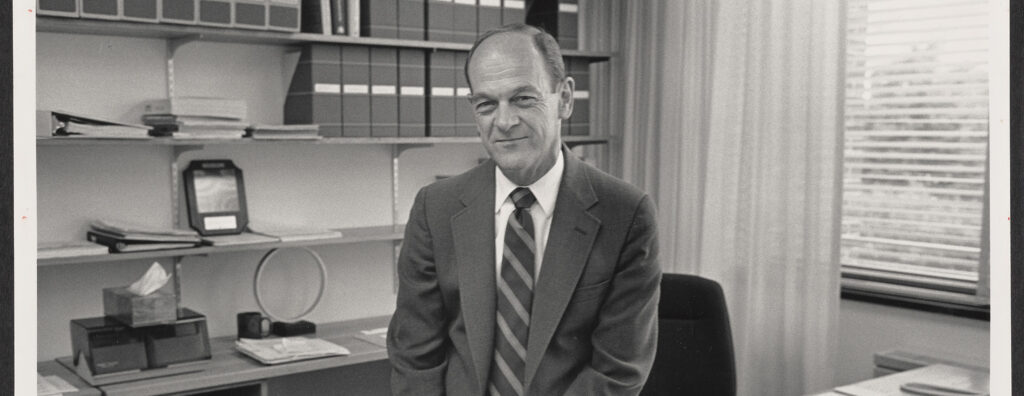
For many years Dean Emeritus Bradley Strait ’58, G’60, G’65 led the Syracuse University academic procession at Syracuse University’s commencement as the Mace Bearer. The Mace Bearer is a role that recognizes the importance of the University’s mission as an education institution. It was also a role that symbolized Strait’s relationship of more than 60 years with the College of Engineering and Computer Science, helping lead students, faculty, research and academic programs forward.
“Brad exemplified what it means to be Orange. I do not know anyone else who commanded such complete respect across campus than he did,” says electrical engineering and computer science Professor Shiu-Kai Chin ’75, G’78, G’86.
Strait passed away in his hometown of Canandaigua, NY on May 6th, 2021. He leaves behind an unparalleled legacy as a student, professor and as dean of the College from 1981-1984 and again from 1989-1992.
He came to Syracuse University after serving in the U.S. Navy from 1951-1955 as an electronics technician. After being discharged, he studied electrical engineering. Syracuse University Life Trustee Charles Beach ’58, G’67 was his roommate and fraternity brother in Phi Gamma Delta. They remained close friends for the next 67 years.
“He really bled orange. He loved Syracuse University, he loved teaching and loved his students,” says Beach.
While he was an undergraduate student, Strait met Nancy Brown, who was a student in the University’s College of Fine Arts. Brad and Nancy married in 1957 and graduated in 1958. They moved to the Syracuse suburb of Jamesville where they raised their children, Andy and Martha. Brad and Nancy later established the Jamesville Museum which collected important pieces of the town’s history and memories of its neighbors.
After graduation, Strait worked briefly at Eastman Kodak before returning to Syracuse for a master’s degree and his doctorate. He then became a faculty member known for taking extra time to work with students and young researchers and making sure they were successful in all aspects of their life, not just the classroom.
He was a member of the university’s world-renowned electromagnetics research group and became chair of the then department of electrical and computer engineering in 1974. One of his early hires was current electrical engineering and computer science Distinguished Professor Pramod K. Varshney.
“Brad did a marvelous job in his role as the leader of a premier department,” says Varshney. “As department chair, he established a close relationship with the Rome Air Development Center (now Air Force Research Laboratory) resulting in significant research funded by US Air Force at Syracuse University.”
“Brad was my first academic advisor when I came to SU in the Fall of 1971. He remained a near and dear mentor throughout my academic career,” says Chin. “His advice to me was always straightforward and direct. Always do what is best for the academic program, always teach a course even if you are in a leadership role and remember that the people you see on the way up are the same people you see on the way down.”
Strait went on to serve as the Dean of the College of Engineering and Computer Science from 1981-1984 and 1989-1992. He was a relentless advocate and recruiter for Syracuse University, always looking to bring the best students and faculty to Central New York.
“Brad was one of the main reasons why I came to Syracuse University as a faculty member,” says mechanical and aerospace engineering Professor Ed Bogucz. “Brad’s personality was a big factor.”
In addition to recruiting for academic roles, Strait was always recruiting for the College’s softball team and a weekly basketball league.
“Many of the players, including myself, were young people who looked at Brad as a role model of how to live an active and fulfilling life balancing family, employment, faith and active recreation,” says mechanical and aerospace engineering Professor Alan Levy. “On the court Brad was a fierce competitor and, like all of us, he liked to win. But he was gracious in victory and defeat. Brad played in the game until he was about 80 years-old and he never lost his spark racing up and down that full court.”
Strait took pride in building connections across the university through softball games played against other colleges and departments.
“A lot of relationships were cemented by getting to know people during those games,” says Beach.
Always looking forward, Strait expanded collaborations with industry partners and worked to connect them with current research activity at Syracuse University. During his tenure as Dean, New York State designed the Centers of Advanced Technology (CAT) program and under Strait’s leadership the University received one of the 6 CATS. To make sure the center got off the ground, he left his Dean position and became the Founding Director of the Computer Applications and Software Engineering Center (CASE).
“He was instrumental in getting state funds to build the Center for Science and Technology (CST). Without his vision of CASE and his leadership, CST would not be built,” says Varshney. “CASE continues to flourish even today as a preeminent center that champions economic growth in the state of New York via its outstanding research activities with New York State.”
“When I became Dean of Engineering and Computer Science, I developed the concept for the Syracuse Center of Excellence following the approach that Brad had pioneered for the CASE Center,” says Bogucz.
Strait retired but always remained an active member of the Engineering and Computer Science family, serving as Dean Emeritus. He and Nancy also established the Bradley J. and Nancy B. Strait Scholarship to assist future generations of Syracuse University students.
He leaves behind a legacy of supporting and mentoring generations of young engineers and computer scientists. During a devoted life of service to Syracuse University, he provided guidance and encouragement at a crucial point in countless lives.
“I am forever blessed because he was part of my life. Those of us who are left must do our best to help the others who come after us like Brad did,” says Chin “Every time I am in the Dome during Commencement. I can still see Brad faithfully leading the procession as Mace Bearer guiding us to where we need to be.”
A memorial service at for Bradley Strait at Hendricks Chapel is planned for June 17th, 2021 at 5:00pm. A livestream of the event will be available.
Wearable Dehydration Monitoring Device Takes First Place at Invent@SU 2021
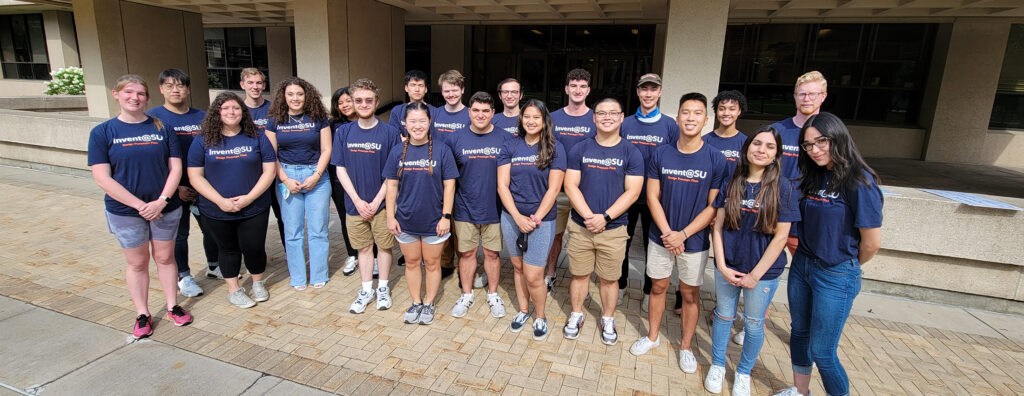
For the first few weeks of Invent@SU, physics major Paul Franco ’22, aerospace engineering student Zach Stahl ’23 and computer science student Anthony Mazzacane ’24 were not always sure their concept would work out. They had identified a clear problem – 80% of NCAA athletes had suffered from dehydration but finding a solution was not simple. They wanted to design a wearable device that could monitor an athlete’s hydration level so coaches and trainers would have better information and keep athletes safe – but would also need to prove their invention worked.
“We knew the scientific principle worked, but in the first few weeks we had logistical problems with the prototype,” said Franco.
As they pushed forward, they leveraged their different skill sets to solve problems with sensors, data collection and a prototype model.
“Being interdisciplinary forces you out of your comfort zone in a really good way,” said Mazzacane.
“Sweatration” was one of seven interdisciplinary teams of undergraduate inventors competing in the six week Invent@SU program. Before the first week of the program, faculty help form three-person interdisciplinary teams that balance different skill sets. Each team comes up with a concept for an original invention, research existing patents to make sure their idea is unique, develop a prototype and pitch it to weekly guest evaluators before “Shark Tank” style final judging at the end of week six.
The Sweatration team was concerned that initial evaluators were skeptical and knew they needed to back up their idea with hard data. They also met with a Syracuse University athletic trainer to gain their input.
“After every time we pitched, I wanted as much feedback as we could get,” said Franco.
The trainer was very supportive of the idea and didn’t believe there was anything like it that existed currently. As their pitch improved, the technical challenges were also being overcome. During a week five test of their prototype at the Barnes Center, the team saw it was collecting meaningful data – and their prototype could reliably show when the wearer was getting dehydrated.
“We had improved the prototype for a better fit and better connections for the technology inside,” said Stahl. “When I saw it was delivering data and consistently indicating dehydration I was thrilled.”
The notable alumni, entrepreneurs and innovators who served as final judges awarded the Sweatration first place and a $7500 prize. They plan on continuing with their invention and will work with both the Blackstone Launchpad in Bird Library and the Innovation Law Center as they move forward.
Second place at Invent@SU went to Ambiflux – a device that can both monitor asthma conditions and deliver medication.
“It felt good that we were rewarded for all the time and energy we put into this,” said bioengineering and neuroscience major Victoria Hathaway ’22. “It is an important device that is needed for a real cause.”
“To see that the judges saw what we saw – it was very gratifying,” said computer engineering student Aidan Mickleburgh ’23. Mickleburgh is also in the H. John Reilly Dual Engineering/ MBA program.
“It felt nice they appreciated the way all the concepts and elements came together,” said chemical engineering student Trinity Coates ’24.
The third place went to Sense-A, a monitoring and alert device that can help people caring for a family member with Alzheimer’s Disease.
“It was a great experience, different from anything else I have done in college,” said computer science student Hong Yang Chen ’22. “Building a physical prototype was a great challenge.”
“Good feedback from judges and evaluators was very helpful and they saw the difficulties caregivers currently face,” said chemical engineering student Simran Lakhani ’22.
“We are definitely going to move forward with this and work with Blackstone Launchpad,” said biomedical engineering student Gabriela Angel ’21 G’22.
Honorable mention at Invent@SU went to Glisten. They designed a device aimed at helping people monitor their dental health at home and provide pre-diagnostic information to a dentist.
“To be able to research, design and build a functioning prototype in six weeks is intense, but the expertise of the faculty and the evaluators made it possible,” said bioengineering student Bianca Andrada ’22.
“Our team was a good balance of different skills and perspectives,” said industrial and interaction design major Ahn Dao ’23.
“We have a passion to keep the world smiling,” said biology student Justin Monaco ’21 G’22.
Invent@SU was sponsored by Syracuse University Trustee Bill Allyn G’59 and Janet “Penny” Jones Allyn ’60, Dr. Deborah L. Pearce and William J. Sheeran ’60, G’63, G’66, Matthew Lyons ’86, Haden Land G’91 and Cathy Land, Ralph Folz ,90, Michael Lazar G’65 and Avi Nash G’77. For more information on the program, you can visit invent.syr.edu.
Spring 2021 Engineering and Computer Science Dean’s List
In recognition of superior scholarship, the following students have been entered on the Engineering & Computer Science Dean’s List for Spring 2021.
To be eligible for Dean’s List recognition, the minimum semester grade point average must be 3.40 or higher, must have earned a minimum of 12 graded credits and must have no missing or incomplete grades.
College of Engineering and Computer Science Spring 2021 Dean’s List
Aerospace Engineering
Zar Nigar Ahmad
Juanitta Acheampomah Bekoe
Justin Douglas Blowers
Madeline Constance Brooks
Richard L Bruschi
Jakob Samuel Bryant
Nishkreenchan Chowdhury
Owen P Clyne
Nicholas Daniel Crane
Brian James Cronin
Ryan Demis
Aleksandar Dzodic
Kaleb Jonah Eddy
Hans-Christian Esser
Jacob Fastov
Kassidy Fields
Christian Scott Fitzgerald
Benjamin Daniel Gerard
Alexandre J Gill
Sareta Rose Gladson
Jacob D Gomez
Hali Morgan Goodwin
Zachary William Haas
Aidan Hoff
Sydney F Jud
Hunter John Adam Knarr
Trevor Anthony Knight
Zachary Andrew Kubala
Thomas Matthew Lane
Isaac Alan Lehigh
Xinyu Liu
Powers Craig Lynch
Noah Martel
Maxwell Joseph Martin
William Armstrong Martin
Phillip Anthony Mazany
Mariana C McManus
Gian Ettore Mecca
Alexander T Metcalf
Romeo Michelson
John P Michinko
Vincent Anthony Miczek
Kendra Teresa Miller
Paul Robert Mokotoff
Evan Gregory Moore
Brendan Pierce Murty
Mark Namatsaliuk
Jarod I Okamura
Daniel Oluwalana
Randall McGinnis Osborn
David Dang Pham
Madeline G Phelan
Logan D Prye
Nicholas Christopher Richard
Brandon Walker Riley
Kip Risch-Andrews
Emily Muriel Rivard
Tracey Josephine Rochette
Andrew Douglas Rockafellow
Gregory Joseph Ruef
William J Saueressig
Fred Evan Schaffer
Justine John A Serdoncillo
Vraj Shah
Prabha Singh
Gregory C Slodysko Jr
Amanda Marie Stafford
Zachary Michael Stahl
Christopher Stawarski
Ethan J Stocum
Marco Svolinsky
Maria Tarulli
Richard A Tedeschi
Anthony R Tricarico
Cody Joseph VanNostrand
Nicklas M Vinci
Mason Alexander Weber
John T Whitney
Aliza Marie Willsey
Cameron M Woodbury
Melissa Yeung
Bioengineering
Samantha Abate
Jordyn Danielle Abrams
Bianca Louise Andrada
Gabriela Angel
Colin J Babick
Eric A Benaroch
Paige Bencivenga
Ailla Frances Bishop
Anna Mae Brunson
Zeynep Sue Cakmak
Britnie Jean Carpentier
Jade Ashlee Carter
Elizabeth Ann Clarke
Mya R Cohen
Lukas Cook
Shane A Corridore
Linzy M Dineen
Anthony Mark Dragone
Alejandro J Durand
Jillian P Durand
Bailey M Felix
Mia-Marie Fields
Akweshie A Fon-Ndikum
Gabriela Renee Gonzalez-Beauchamp
Skyla Gordon
Grace Haas
Lauren Elizabeth Hamilton
Victoria Li Rui Hathaway
Brenna Henderson
Avinash Jagroo
Madeline Jones
Simran Karamchandani
Gabriel Khan
Mohamed F Khan
Sara Anne Leonardo
Isabelle S Lewis
Trevor Daniel Amnott Liimatainen
Xinyan Lin
Alejandra Eugenia Lopez
Ethan L Masters
Aelish McGivney
Ian G McHugh
Caitlin R Mehl
Lindy M Melegari
Connor G Mulligan
Hannah V Murphy
Alexander Patrick Musselman
Jeffrey Ng
Jonathan Ngo
Mark Nicola
Nicole E Nielsen
Matthew Evan Orlando
Megan Isabel Perlman
Natalie Marie Petryk
Connor Preston
Beatrice Elizabeth Reilly
Lillian Kilmer Rhuda
Gavin David Richards
Rebecca A Schaefer
Brielle L Seidel
Alyssa Shelburne
Adam M Spadafora
Justin N Stock
Elizabeth Tarami Su
Bearett Ann Tarris
Kimberly Tlayaca
Zhuoqi Tong
Edgardo Velazquez
Carly J Ward
Royce Robert Weber-Pierson
Nathaniel D Wellington
Maximillian Meier Wilderman
Haven M Wittmann
Lauren Margaret Woodford
Rui Xie
Alina Zdebska
Julian Marcus Smucker Zorn
Samantha Zysk
Chemical Engineering
Daud Ansarovich Abdullayev
Paige O Adebo
Keerthivanan Annadorai
Adriana M Archilla
Athena Andrea Basdekis
Lilly Basgall
Sandy Ynhu Cao
Karley M Chambers
Trinity Joy Coates
Olushola Coker
Hao Dai
Dennis Dao
Samantha Esparza
David Anthony Fikhman
Edward Coleman Fluker
Priya S Ganesh
Brent Tadao Gosselin
Hannah Grossman
Avery Gunderson
Oduduabasi James Isaiah
Aiden A Jacobs
Stanley Jimenez
Jake Tyler Jock
Sayf Karim
Laxmi Khatiwada
Adam J Klinger
Simran Dharmendra Lakhani
Gabriel Lipsitz
Nicole Helene Llewellyn
Rawia F A M Marafi
Angela L Martinez
Oliver Mutu
Thomas A O’Brien Jr
Sean O’toole
Fabiana Nohelia Perez
Seth Reed
Ryan Gordon Ryersen
Ivan Yankov Sarbinov
Jacob Matthew Shellhamer
Dakota Alexander Story
Jason Tan
Spencer T Tardy
Megan Varcoe
Briana Nicole Vlacich
Elizabeth M Wall
Connor Andrew Wescott
Melita Zejnilovic
Civil Engineering
Orges Agolli
Cassie Agren
Anna Rose Arcaro
Nicole Ayora-Gonzalez
Lucas Bellandi
John Blum
Luke S Bonenberger
Arielle Bramble
Matthew Emmet Brewster
Emma Jane Brown
Alycia Joline Bruce
Joli L Cacciatore
Brett M Carney
Trevor Caviness
David Coghiel
Alejandro E Correa
Aymeric P Destree
Thomas Driscoll
Brendan Dwyer
Bradley Charles Frederick
Maraea K Garcia
Stephen Goffredo
Elliane Reut Greenberg
Alyssa Jeannine Griffin
Bensen Gu
Shawn G Gulamerian
Zelin Guo
Matthew Paul Hauser
Qifan He
Catherine E Henn
Maxwell J Karl
Joshua Michael Kaufman
Alexander Gregory Klee
Christopher J Klein
Adam Paul Landry
Abigail G Laschalt
Haben Legesse
Daniel Leyva
Emma Marie Liptrap
Emilija Alise Lizins
Erick Lojano-Quispe
Lluvia Margarita Lopez Garces
John M Mazza
Jessica M McGowan
Amira A Mouline
Mazin F Moya
Marissa R Nicole
Erin E O’Brien
Kevin B Ordonez
Gabriel Jacques Prepetit
Svetislav Radovic
Alexander David Ruppe
Isabella Salgado
Cassie Elizabeth Saracino
Stephanie D Schein
Emma Hayes Schoonover
Juha Wesley Schraden
Ravyn Smith
Caitlin Jane Spillane
Adrian Stiefelmann
Alec Spencer Thompson
Anand Veeraswamy
Christian Viola
Nathan Viramontes
Abigail Meghan Wischerath
Isabelle Wong
Paige H Yamane
Computer Engineering
Chikeluba K Anierobi
Malkiel Asher
Mergim Azemi
Gavin M Beaudry
Kyle J Betten
Jackson Thomas Bradley
Jinzhi Cai
Dynasty Da’Nasia Chance
Yifei Che
Dana Marie Castillo Chea
Guoliang Chen
Hossain Delwar
Xavier Evans
Elizabeth A Fatade
Aidan Robert Harrington
Mehak Jetly
Virkin Jimenez
Benjamin N Johnson
Bikash Khatiwoda
Nicholas Gerard Lee Landry
Jessica K Lat
Matthew B Leight
Jiaxiong Li
Nicholas Kent Magari
Kyle David Maiorana
Isabel M Melo
Nicholas J Mohan
Benjamin Hudson Murray
Jose L Olivera
Jiannuo Pei
Jessica A Reslan
Alfonso E Rivas
Brian Rodriguez
Daniel Rose
Samuel M Rosenthal
Hongyi Ruan
Alexander Segarra
Ritwik Takkar
Shu Wang
Ryan Wolff
Hanyi Xu
Renjie Xu
Ziyun Zhang
Andy Zheng
Computer Science
Aaron Alakkadan
Sajjad Abdullah Albadri
Kwaku Amofah-Boafo
Giovanna Elizabeth Barsalona
Brian H Belluscio
Dazhi Bi
Maxwell William Hans Bockmann
Joshua Jordan Boucher
Spencer H Bradkin
Bryan Bladimir Bueno Reyes
Bryce Cable
Christopher Manuel Calderon Suarez
Liam M Calnan
Megan J Campbell
Yuecheng Cao
Abby Chapman
Jackie Chen
Runzhou Chen
Siyu Chen
Yixing Chen
Yuhao Chen
Doung Lan Cheung
Season Chowdhury
Konstantinos Chrysoulas
Matthew Cufari
William Stuart Devitt
Ting Dong
Russell Carl Doucet
Nathan B Fenske
Evan Garvey
Grant Thomas Gifford
Brianna S Gillfillian
Brian J Giusti
Justin S Glou
Justin Gluska
Dayong Gu
Tighe Gugerty
Alexander Peter-Anthony Haas
Athanasios Hadjidimoulas
Erika R Hall
Andrew Hamann
Jillian Elizabeth Handrahan
Miranda Rose Heard
Wendy Hesser
Cameron Hoechst
Laurel Howell
Jacob Howlett
Natalie Huang
Xuanye Huang
Nathakorn Jitngamplang
Michael Wesley Jones
Jamed K Kamara
Jaehun Kim
Ekaterina Kladova
Gavin William Kline
Polina Kozyreva
Miksam Kurumbang
Rami L Kuttab
Eric C Lee
Andy Li
Jiaqi Li
Ruowen Li
Arvin Lin
Haochen Lin
Erxi Liu
Jiaming Liu
Jing Liu
Junzhang Liu
Steven Liu
Tiara I Logan
Vikas Gautam Lohana
Cayden Thomas Lombard
Yiheng Lu
Runzhi Ma
Hunter O’Neal Malley
Kanoa Matton
Ryan M May
Anthony Louis Mazzacane
Noah Mechnig-Giordano
Preston Mohr
Thomas J Montfort
Jacob Morrison
Jovanni Nicholas Mosca
Andi Muhaxheri
Paige C Mundie
Krutartha Nagesh
Zoe Anne Neale
Maduakolam Nicholas Onyewu
Maya Ostoin
Daniel Pae
William Anderson Palin
Xiaofeng Pan
Michael J Panighetti
Brian Joseph Pellegrino
Siwei Peng
Anthony Perna
Fiona Colleen Powers Beggs
Akshay Hari Prasad
Shane Michael Race
Lauryn Ashley Rivers
Eric Rodriguez
Sadikshya Sanjel
Jonathan Lee Schwenk
Benjamin William Smrtic
Louanges Essohana Marlene Takou-Ayaoh
Melissa Li Tang
Jonathan Richard Constantine Templeton
Jonathan Ezra Thomas
Kyra Danielle Thomas
Griffin E Timm
Courtney Patricia Tuozzo
Randy C Vargas
Bermalyn Maricel Vicente
Christopher Mark Vinciguerra
Puxuan Wang
Ruobing Wang
Xinyi Wang
Robert Ward
Daniel Weaver
Jonathan Williams
Ethan Wong
Yurui Xiang
Yujie Xu
Chen Yang
Jintao Yang
Jishuo Yang
Stella R Yaunches
Elin J Yaworski
Yian Yu
Yulun Zeng
Chengyuan Zhang
Liaotianbao Zhang
Rixiang Zhang
Weikun Zhang
Zhiyuan Zhang
Hang Zhao
Junjie Zheng
Liuyu Zhou
Xinqian Zhou
Raymond Zhu
Sida Zhu
Joseph Patrick Zoll
Engineering Undeclared
Olivia R Conlin
Michael J McElroy
Electrical Engineering
Minghao Ai
Rebecca Corrine Andino
Tianle Bu
Kevin E Buciak
Yushang Cai
Vincent Alec Camarena
Arianna Maxine Cameron
Yuang Cao
Brendan Robert Ciarlone
Eli Aiden Clark
Nicholas Shawn Connolly
Alex Lev Cramer
Trevonne Davis
Henry C Duisberg
Nicholas Fazzone
Justin P Geary
Matthew R Gelinas
Christopher Gill
Jose I Ginorio
Jack Orlando Guida
Emerson Iannone
Jemma Mallia
Liam Fuller Marcato
Tyler Sean Marston
Zixun Nian Nian
Kylie Elizabeth Nikolaus
Dylan D Palmer
Julia Pepin
Matthew Piciocchi
Stephen Joseph Rogers
Gilberto E Ruiz
Gabriel E Ruoff
Kayla Ann Saladyga
Jenna Mei Stapleton
Jaime S Sued Jr
Jared William Welch
Ernest C Whitbeck
Abigail Wile
Chongfang-James Xu
Zheyuan Zhang
Environmental Engineering
Ana Cristina Baez Gotay
Luke M Borden
Benjamin R Cavarra
Bessie Chen
Evan James Cibelli
Cambre Rae Codington
Elizabeth Bryant Cultra
Cameron Nicole Edwards
Anna Feldman
Allyson Greenberg
Jessenia Paola Guzman
Brady E Hartnett
Christopher Graham Harvey
Anna M Holdosh
Erica G Jenson
Eva Rose Kamman
Abigail Rose King
Nicholas Colin Axel Kohl
Birch Lazo-Murphy
Audrey B Liebhaber
Samuel Robert Livingston
Carleigh Ann Lutz
Kevin A Lynch
Jiayu Ma
Nicole A Mark
Molly M Matheson
Steph Ricky Millan
Sydney Mitchell
Matthew Edward Nosalek
Scott M Potter
Yongfang Qi
Kaura Yanse Reyes
Jacob Thomas Sardino
Mary H Schieman
Noah Michael Sherman
Husna M Tunje
Jacob M Tyler
Maria Antonia Villegas Botero
Anna Wojcik
Savannah Marie Wujastyk
Yifan Zhong
Qiuyu Zhou
Reilly Zink
Mechanical Engineering
Owyn Phillip Adams
Arfeen Armaghan
Joshua Carl Arndt
Arda Arslan
Rachael O Beresford
Charles Shaw Bowman
Arnaud Buard
Ryan G Burns
Adrian L Caballero
Alexander Joseph Callo
Joseph Timothy Capra
Caleigh J Casey
Rishov Chatterjee
Samuel Joseph Corrigan
Cooper P Crone
David Matthew Denneen
Madeline Doyle
Andrew J Esposito
Cameron Barry Frechette
Elan Fullmer
Clinton Edward Farina Garrahan
Samuel Ryan Getman
Emily Ann Greaney
David M Griffin
Connor Hayes
Zhao Jin
Dong Myeong Kang
Jeremy C Kang
Macauley J Kastner
Daniel Jacob Kenney
Finnian James Kery
Teagan L Kilian
Cherry Kim
Jason T King
Savannah Mae Kreppein
Elizabeth Marcy Kretzing
Trevor D Kroells
Lily Larkin
Peter Le Porin
Honorata Lubecka
Bei Luo
Katherine Elizabeth Macbain
Lauren Mack
Ryan Patrek Martineau
Sarah Ann Michael
Georgios Michopoulos
Leilah Miller
Nicholas Mink
Wiley Robert Moslow
Allison Mullen
Beau M Norris
Aidan T O’Brien
Nicholas Joseph Papaleo
Corey A Phung
Pei Ren
Aidan Riederich
Jeremy Vinton Rosh
Jeffrey Ryu
Colin Santangelo
Nitish Sachin Satpute
Nathan Schnider
Shane M Sefransky
William Kaspar Sherfey
Zachary Ryan Shuler
Eric Silfies
Nathaniel Slabaugh
Owen Nicholas Smith
Ian Storrs
Austin James Sumner
Yiyuan Sun
Matthew K Swanson
Ethan William Tracey
Evan R Tulsky
Taj Asim Whitney
Michael Wong
Tszho Wong
Sean T Wuestman
Maxwell James Yonkers
Xiaoqing Yu
Antony Zheng
Systems & Information Science
Yiyang Dai
Jonathan Richard Deiss
Rodcliff Hall
Skyler Marie Hall
Luke Gregory Hedges
Stacy Kim
Niara A Phoenix
Nadia Olivia Shelburne
Zachary Tyler Williams
Civil Engineering
The civil engineering minor is designed to give students the opportunity to learn and apply basic engineering knowledge to solve problems related to the analysis, design and construction of civil infrastructure. Students enrolled in this program have the option to focus on one specific discipline or explore several areas of civil engineering.
Enrollment Requirements
This minor is available to all University students who have the necessary prerequisites (see the section on restrictions) and have a cumulative GPA of 2.00 or above on a space-available basis. To be admitted to the program, students must submit a Declaration of Minor form signed by their academic advisor, the civil engineering minor coordinator, and the academic dean of their home school/college.
A maximum of 3 transfer credits allowed.
Zhao Qin
Degrees:
- Ph.D., Civil and Environmental Engineering, Massachusetts Institute of Technology, 2013.
- M.Eng., Engineering Mechanics, Tsinghua University, Beijing, China, 2008.
- B.Eng., Engineering Mechanics, Tsinghua University, Beijing, China, 2006.
Research interests:
- Development of advanced computational modeling methods for designing new materials of advanced material functions.
- Bottom-up modeling of the multi-scale structure-mechanics relationship of nano- and bio-materials. Fundamental understanding of the material behaviors of biological and synthetic polymeric materials from the most molecular scale to macroscopic length scale.
- Learn from nature and discover bio-inspired ideas to create and design materials with innovative material functions.
- Prototyping, optimization and characterization of synthetic composite materials with multiple advanced material functions, for efficient usage of engineering materials.
Current Research:
My research focuses on developing advanced computational modeling methods, using them to study fundamental mechanical properties of biological materials and applying the knowledge to design new materials of advanced mechanical functions. I have a broad background in mechanics and structure of materials, with specific training and expertise in the multi-scale structure-mechanics relationship in biological materials. My research focuses on the structure and mechanics insight of general natural materials as many of them, such as mussel glue, insect wings and membranes, have fascinating mechanical and biological properties built up from simple basic molecular building blocks. I am thus strongly motivated to develop tools that enable us to learn from nature to make material innovations more efficient. I have developed a multi-scale high-throughput computational modeling method that enables me to study materials from the most fundamental molecular scale to macroscopic length scale. I have applied the tool to the investigations of several different biological materials and have revealed new mechanisms hidden in their complex structures. Some of the findings contribute to fundamental understandings of diseases that take place from the molecular scale; others contribute to designs and prototyping of synthetic composite materials with multiple advanced material functions. I have developed principles to help to optimize the material functions through structures, making it feasible to rationally design the mechanics and longevity of composite materials, leading to better performance with less energetic and environmental cost than conventional engineering materials for industrial applications.
Courses Taught:
- CEE 325 – Mechanics of Materials
- CEE 676 – Multiscale Material Modeling and Simulations
Honors:
- National Science Foundation CAREER Award, NSF, May 2022
- 2021 Fellowship to 25th International Congress of Theoretical and Applied Mechanics (ICTAM 2020+1) from USNC/TAM.
- 2020 Collaboration for Unprecedented Success and Excellence (CUSE) Grant, Syracuse University
- Best paper award in Journal of Applied Mechanics (ASME) for the paper “Bioinspired Graphene Nanogut” among papers published during 2012-2013
- Outstanding Paper Award, ASME Global Congress on Nano Engineering for Medicine and Biology, Boston, MA, 2013
- Chinese Government Award For Outstanding Self-Financed Students Abroad, NY, 2011
- Best Paper Award, International Journal of Applied Mechanics (Imperial College Press) 2010
- Schoettler Graduate Fellowship, Civil and Environmental Engineering, MIT, 2010
- SAMSUNG Scholarship, Tsinghua University, China, 2007
- 2nd Rank National Scholarship, Tsinghua University, China, 2003
Recent Publications:
DA Qureshi, S Goffredo, Y Kim, Y Han, M Guo, S Ryu, Z Qin (2022) Why mussel byssal plaques are tiny yet strong in attachment, Matter, 5, 710-724
S Liu, K Duan, J Feng, L Li, X Wang, Y Hu, Z Qin (2022), The design of strongly bonded nanoarchitected carbon materials for high specific strength and modulus, Carbon, 195, 387-394
R Xu, L Yang, Z Qin (2022), Design, manufacture, and testing of customized sterilizable respirator, Journal of the Mechanical Behavior of Biomedical Materials, 131, 105248
L Yang, D Park, Z Qin (2021), Material Function of Mycelium Based Bio-composite: A Review, Frontiers in Materials, 8, 374
J Cui, M Jiang, M Nicola, A Masic, Z Qin (2021), Multiscale understanding in fracture resistance of bamboo skin, Extreme Mechanics Letters, 49, 101480
J-K Qin, C Sui, Z Qin, J Wu, H Guo, L Zhen, C-Y Xu, Y Chai, C Wang, X He, P D Ye, J Lou (2021), Mechanical anisotropy in two-dimensional selenium atomic layers, Nano Letters, 21, 8043-8050
J. L. Kessler, G. Kang, Z. Qin, H. Kang, F. G. Whitby, T. E. Cheatham, C. P. Hill, Y. Li, and S. Michael Yu (2021), Peptoid Residues Make Diverse, Hyperstable Collagen Triple-Helices, J. Am. Chem. Soc., 143, 29, 10910–10919
J Ni, S. Lin, Z. Qin, D. Veysset, X. Liu, Y. Sun, A.J. Hsieh, R. Radovitzky, K.A. Nelson, X. Zhao (2021), Strong Fatigue-Resistant Nanofibrous Hydrogels Inspired by Lobster Underbelly, Matter, 4, 1919–1934.
Q Huang, T Deng, W Xu, CK Yoon, Z Qin, Y Lin, Tengfei Li, Y. Yang, M Shen, S M. Thon, J B. Khurgin, D H. Gracias (2020), Solvent Responsive Self‐Folding of 3D Photosensitive Graphene Architectures, Adv. Intell. Syst., 2020, 2000195
K Tanuj Sapra, Z Qin, A Dubrovsky-Gaupp, U Aebi, D J Müller, M J Buehler, O Medalia (2020), Nonlinear mechanics of lamin filaments and the meshwork topology build an emergent nuclear lamina, Nature Communications, 11, 6205
X Guo, L Zhao, Z Qin, L Wu, A Shehu, Y Ye (2020), Interpretable Deep Graph Generation with Node-Edge Co-Disentanglement, Proceedings of the 26th ACM SIGKDD International Conference on Knowledge Discovery & Data Mining, 1697-1707
JL Zitnay, GS Jung, AH Lin, Z Qin, Y Li, SM Yu, MJ Buehler, JA Weiss (2020), Accumulation of collagen molecular unfolding is the mechanism of cyclic fatigue damage and failure in collagenous tissues, Science Advances, 6, eaba2795
G Grezzana, HC Loh, Z Qin, MJ Buehler, A Masic, F Libonati, Probing the Role of Bone Lamellar Patterns through Collagen Microarchitecture Mapping, Numerical Modeling, and 3D‐Printing (2020), Advanced Engineering Materials, 2000387
J Cui, Z Qin, A Masic, MJ Buehler, Multiscale structural insights of load bearing bamboo: A computational modeling approach (2020), Journal of the Mechanical Behavior of Biomedical Materials, 107, 103743
Z Qin, Q Yu, MJ Buehler, Machine learning model for fast prediction of the natural frequencies of protein molecules (2020), RSC Advances, 10, 16607-16615
B Azimi, M. Milazzo, A. Lazzeri, S. Berrettini, M.J. Uddin, Z. Qin, M.J. Buehler, S. Danti, Electrospinning piezoelectric fibers for biocompatible devices (2020), Advanced Healthcare Materials, 9, 1901287
Z Qin, L Wu, H Sun, S Huo, T Ma, E Lim, P-Y Chen, B Marelli, M J Buehler (2020), Artificial intelligence method to design and fold alpha-helix structural proteins from the primary amino acid sequence, Extreme Mechanics Letters, 36, 100652
J Liu, S Lin, X Liu, Z Qin, Y Yang, J Zang, and X Zhao (2020), Fatigue-resistant Adhesion of Hydrogels, Nature Communications, 11, 1071
J Wu, Z Qin, L Qu, H Zhang, F Deng, M Guo (2019), Natural hydrogel in American lobster: a soft armour with high toughness and strength, Acta Biomaterialia, Vol 88, pp. 102-110
Y Han, M-Y Li, G-S Jung, M A. Marsalis, Z Qin, M J. Buehler, L-J Li, D A. Muller (2018), Sub-Nanometer Channels Embedded in Two-Dimensional Materials, Nature Materials, Vol. 17, pp 129-133
Z Qin, G S Jung, M J Kang, M J. Buehler (2017), The mechanics and design of light-weight three-dimensional graphene assembly, Science Advances, Vol. 3, paper #: e1601536
Dawit Negussey
Degree:
- Ph.D. University of British Columbia
Research Interests:
- Geofoam geotechnics
- Sensors and grids
- Innovative infrastructures
Teaching Interests:
- Soil mechanics
- Geotechnical
- Transportation engineering
Select Publications:
Negussey, D., Andrews, L., Singh, S., and Liu, C. (2019). “Forensic Investigation of a Wide Culvert Reconstruction Failure.” ASCE Journal of Pipeline Systems, Vol. 10, No. 3.
Liu, C., and Negussey, D. (2018). “Effects of Installation of Different Density Geofoam and Continuous Vertical Gaps.” Proceedings of the 5th International Conference on Geofoam, Springer International, Switzerland.
Temesgen, E., Andrews, L., and Negussey, D. (2018). “Non-Destructive Testing for EPS Geofoam Quality Assurance.” Proceedings of the 5th International Conference on Geofoam, Springer International, Switzerland.
Birhan, A., and Negussey, D. (2014). “Effect of Confinement on the Creep Behavior of EPS Geofoam.” ASTM Geotechnical Testing Journal, Vol. 37, No. 6.
Stuedlein, A. and Negussey, D. (2013) “Use of EPS Geofoam for Support of a Bridge,” American Society of Civil Engineers, Geotechnical Special Publication No. 230.
Sinéad C. Mac Namara
Degree(s):
- MSE PhD from Princeton University
- BA, BAI from Trinity College, University of Dublin
Research interests:
- collaborative practice in architecture and engineering
- innovation and creativity in structural engineering education;
- structural engineering design and structural art;
- structural performance of shell structures.
- community engaged and public interest design
- design build education
Current Research:
Emerging Tools in Structural Engineering
The project Emerging Tools in Structure and Design, will focus on new and emerging design and construction methodologies that are making possible a new generation of structural form and form making. Generation and optimization software; rationalization and analysis tools; and fabrication methods, have all advanced considerably in recent years and are having huge influence on the cutting edge of collaborative practice between architecture and engineering. These tools facilitate ever more radical form making in ever more rational ways and make possible formal expressions and structural efficiencies and elegance that would have been prohibitively complex a mere handful of years ago. Although these tools are highly technical in nature, it can be argued that their development has been driven by speculative architectural design work, and that they are responding to the considerable and significant change in representation tools and construction capability in recent years.
The project will initiate a critical comparative analysis of these emerging tools. I want to trace the origin of the tools, the development, use in the design process, and ultimately the influence on contemporary design and design processes. Do these tools facilitate, or I dare say require, deeper and more rigorous collaboration between disciplinary specific technical experts and architects? How are these tools allowing for rapid testing of speculative designs? Do the tools make possible financial or material savings? In what ways do they impact the nature of the engineer/architect relationship? Does “authorship” enter into the equation? There is much to explore and
Courses taught:
- Structures II (ARC 311/ARC 612)
- Advanced Structural Resolution (ARC 500)
- CEED: Community Engaged Engineering Design (ARC 500)
- Structures and Innovation (HNR 360)
- Design of Concrete Structures (CEE 332)
- Thesis Prep (ARC 509)
- Thesis (ARC 510)
Honors:
- Chancellors Award for Public Engagement and Scholarship, ARC 500 Community Engaged Engineering Design Park Studio, Syracuse University, Spring 2014.
- AIA New York State Merit Award for Mir’aj with Julie Larsen and Roger Hubeli, April 2014.
- American Collegiate Schools of Architecture, 2014 ACSA National Design Build Educator Award for Play Perch.
- American Institute for Architecture Students Freedom By Design, National Community Inspiration Award for Play Perch, January 2014.
- Chancellors Award for Public Engagement and Scholarship, ARC 490 and 690 Design+Build Play Perch, Syracuse University, Spring 2013.
- American Society for Engineering Education, St. Lawrence Division, Outstanding Teacher Award. Spring 2013.
- Reinvent Payphones Design Challenge NYC Mayor’s Office, Selected Winner: Best Functionality, Spring 2013.
- Best Presentation, Architectural Engineering Division, American Society for Engineering Education, Annual Conference and Exposition, Vancouver BC, June 2011.
- Meredith Teaching Recognition Award, Syracuse University, Spring 2011.
- Princeton E-council Award for Teaching Excellence for CEE 366, Spring 2005.
Selected Publications:
S.C. Mac Namara. L. D. Bowne. Controlled Chaos: Modeling Interdisciplinary Practice for Architecture and Engineering Students in a Real World Community Engaged Design Project. Proceedings of the American Society for Engineering Education 2015 Annual Conference and Exposition, Seattle, WA, June 2015.
S.C. Mac Namara. J. V. Dannenhoffer, Scaling Up: The Design Competition as a Tool for Teaching Statics. Proceedings of the American Society for Engineering Education St, Lawrence Division Conference, Syracuse, April 2015.
S.C. Mac Namara. L. D. Bowne. Book Chapter “Play Perch” in Green, Hidden and Above – The Most Exceptional Tree-houses. Sibylle Kramer, Author. 2015. Braun Publishing.
S.C Mac Namara, C. J. Olsen. Collaborations in Architecture and Engineering. Albeena Magazine, Saudi Arabia. March 2013.
S.C. Mac Namara, C. J. Olsen. Collaborations in Architecture and Engineering . Routledge July 2014.
S.C. Mac Namara. L. D. Bowne. Controlled Chaos: Modeling Interdisciplinary Practice for Architecture and Engineering Students in a Real World Community Engaged Design Project. Proceedings of the American Society for Engineering Education 2015 Annual Conference and Exposition, Seattle, WA, June 2015.
S.C. Mac Namara. J. V. Dannenhoffer, Scaling Up: The Design Competition as a Tool for Teaching Statics. Proceedings of the American Society for Engineering Education St, Lawrence Division Conference, Syracuse, April 2015.
S.C. Mac Namara. L. D. Bowne. Book Chapter “Play Perch” in Green, Hidden and Above – The Most Exceptional Tree-houses. Sibylle Kramer, Author. 2015. Braun Publishing.
S.C Mac Namara, C. J. Olsen. Collaborations in Architecture and Engineering. Albeena Magazine, Saudi Arabia. March 2013.
S.C. Mac Namara, C. J. Olsen. Collaborations in Architecture and Engineering . Routledge July 2014.
S.C. Mac Namara. Expanding Expectations: A Community Service Accessible Design-Build Project as an Instigator of Curricular Change. Proceedings of the BTES Building Technology Educators Society Conference 2013 “Tectonics of Teaching” Bristol, R. I, July 2013.
S.C. Mac Namara. R. Svetz, Hidden in Plain Sight: Campus Scavenger Hunt to Teach Structures and Technology to Architects. Proceedings of the American Society for Engineering Education 2013 Annual Conference and Exposition, Atlanta, Georgia, June 2013.
S.C. Mac Namara. J. V. Dannenhoffer, First Encounters: Statics as the Gateway to Engineering Culture. Proceedings of the American Society for Engineering Education 2013 Annual Conference and Exposition, Atlanta, Georgia, June 2013.
S.C. Mac Namara. J. V. Dannenhoffer, Hands-On Learning for Statics in the Smaller Classroom and Potential Scale-Up to the Larger Lecture. Proceedings of the American Society for Engineering Education 2013 Northeast Section Conference. Norwich, VT. March 2013 .
S.C. Mac Namara. Structural Art in Contemporary Engineering Education Festschrift Billington. editors: Hines, Buonopane, & Garlock, International Network for Structural Art, Princeton 2012.
S.C. Mac Namara. Bringing Engineering into the Studio: Design Assignments for Teaching Structures to Architects. Proceedings of the American Society for Engineering Education 2012 Annual Conference and Exposition, San Antonio, Texas, June 2012
S.C. Mac Namara. Topology Optimization: The Use of Cutting Edge Numerical Methods in Teaching Structures to Architects. Proceedings of the American Society for Engineering Education 2012 Annual Conference and Exposition, San Antonio, Texas, June 2012 (abstract accepted).
S.C. Mac Namara. The Design Competition as a Tool for Teaching Statics. Proceedings of the American Society for Engineering Education 2012 Annual Conference and Exposition, San Antonio, Texas, June 2012 (abstract accepted).
C.J. Olsen, S.C. Mac Namara. In Support of Pre-Professional Relations: Guidelines for Effective Educational Collaborations between Architecture and Engineering. Proceedings of the 100th Annual ACSA Meeting, Boston MA, March 1-4, 2012.
S.C. Mac Namara, S.P. Clemence. The Value of Short Term Study Abroad for Civil Engineering Students. Proceedings of the 2011 ICEE Conference on Engineering Education, University of Ulster, Belfast, Northern Ireland, August 21-26, 2011.
C.J. Olsen, S.C. Mac Namara. The Value of Trans-disciplinary Design Education with Architects for Engineering Students. Proceedings of the 2011 ICEE Conference on Engineering Education, University of Ulster, Belfast, Northern Ireland, August 21-26, 2011.
S.C. Mac Namara. Trans-disciplinary Design Teaching for Civil Engineers and Architects – Lessons Learned and Future Plans. Proceedings of the American Society for Engineering Education 2011 Annual Conference and Exposition, Vancouver Canada, June 2011.
S.C. Mac Namara. Pedestrian Bridges – Structural Design by Masters of Architecture Students. Proceedings of the American Society for Engineering Education 2011 Annual Conference and Exposition, Vancouver Canada, June 2011.
S.C. Mac Namara. The Use of Historical Precedent in Teaching Structures to Architecture Students. Proceedings of the American Society for Engineering Education 2011 Annual Conference and Exposition, Vancouver Canada, June 2011.
S.C. Mac Namara. Are We Asking the Wrong Questions? A study of student familiarity with common textbook examples. Proceedings of the ASEE Global Colloquium on Engineering Education, Singapore, October 18-22, 2010.
S.C. Mac Namara. Statics 2.0 – Reimagining a core course for increased innovation and creativity. Proceedings of the ASEE Global Colloquium on Engineering Education, Singapore, October 18-22, 2010.
S.C. Mac Namara, C.J. Olsen, Scott L. Shablak, Carolina B. Harris. Merging Engineering and Architectural Pedagogy – A Trans-disciplinary Opportunity? Proceedings of the 2010 ICEE Conference on Engineering Education, Silesian University of Technology, Gliwice, Poland, July 18-22, 2010.
S.C. Mac Namara, C.J. Olsen, L. J. Steinberg, S.P. Clemence. Inspiring Innovation. Proceedings of the American Society for Engineering Education 2010 Annual Conference and Exposition, Louisville Kentucky, June 2010.
S.C. Mac Namara, M. Garlock, D.P. Billington. Structural Response of Nuclear Containment Shield Buildings with Construction Openings, ASCE Journal of Performance of Constructed Facilities, Vol. 21, No. 2, March/April 2007, pp. 152-156.
S.C. Mac Namara, M. Garlock. Delamination in Two Layer Thin Shell Dome with Unanticipated Construction Openings Proceedings of the 6th International Conference on Computation of Shell and Spatial Structures IASS-IACM 2008: “Spanning Nano to Mega”, John F. ABEL and J. Robert COOKE (eds.) Cornell University, Ithaca, NY, 28-31 May 2008.
S.C. Mac Namara, D.P. Billington. Delamination and the structural response of thin shell concrete in nuclear shield buildings with unanticipated construction openings. Proceedings of the 6th annual international conference on fracture mechanics of concrete and concrete structures, Catania, Italy, 17-22 June 2007.
S.C. Mac Namara, C. J. Olsen. Collaborations in Architecture and Engineering . Routledge July 2014.
Eric M. Lui
Degrees:
- Ph.D., Purdue University, IN.
- M.S.C.E., Purdue University, IN.
- B.S.C.E. (High Honors), University of Wisconsin at Madison, WI.
Research Interests:
- Steel structures, structural stability
- Structural dynamics, earthquake engineering
- Numerical modeling
- Damage identification and quantification
- Computer-aided analysis and design of structures
Areas of Expertise:
Dr. Lui’s current research is in the areas of nonlinear behavior and limit states design of steel structures, seismic analysis and performance-based design of structures, effect of nonlinear damping on structures, application of shape memory alloys in earthquake resistant design, passive magnetic negative stiffness dampers, energy dissipative segmented steel plate shear wall, seismic assessment using the endurance time method, damage identification and quantification using system dynamic properties.
Dr. Lui has authored/coauthored numerous journal papers, conference proceedings, special publications and research reports in these areas. He is also a contributing author to a number of engineering monographs and technical handbooks. In addition, he is the author/co-editor of the 2nd edition CRC Handbook of Structural Engineering, and is the co-author/co-editor of four books on the subject of steel design, structural stability, and earthquake engineering. He currently serves as editor-in-chief of two journals and serves on the editorial boards of several other scientific and engineering journals.
Honors:
- Bleyer Scholarship, University of Wisconsin (1979)
- Bates and Rogers Foundation Scholarship, University of Wisconsin (1980)
- David Ross Fellowship, Purdue University (1982, 1983)
- Nellie Munsion Award for Outstanding Teaching Assistant, Purdue University (1982)
- Coauthor of the AISC Higgins Award Paper (1985)
- Crouse Hinds Award for Excellence in Education, Syracuse University (1997)
- Nominated for the Munro Prize for Best Paper (2000)
- ASCE Committee on Student Services Certificate for Exemplary Services (2000)
- ASCE Faculty Adviser Reward Recipient (2000, 2001, 2002)
- Letter of Honorable Mention, SU ASCE Student Chapter, Faculty Advisor (2000, 2001)
- Certificate of Commendation, SU ASCE Student Chapter, Faculty Advisor (1999, 2003, 2005, 2006)
- Technology Alliance of Central New York (TACNY) College Educator of the Year Award (2007)
- Named one of two Recipients of the ECS Faculty Excellence Award (2009)
- Member of Honor Society Tau Beta Pi
- Member of Honor Society Phi Kappa Phi
- Member of Honor Society Sigma Xi
- Member of Honor Society Chi Epsilon
Selected Publications:
Shan, T. and Lui, E.M. “Energy-based design of buckling-restrained steel braced frames for concurrent occurrences of earthquake and wind,” CivilEng, 2024, 5, 343-377 (DOI: https://doi.org/10.3390/civileng5020018)
Majd, N.S. and Lui, E.M. “Analysis and design of a novel segmented energy absorbing steel plate shear wall system,” Advances in Structural Engineering, 2024, 27(1), 85-104. (DOI: https://doi.org/10.1177/13694332231213454)
Mamaghani, M., and Lui, E.M. “Use of continuous wavelet transform to generate endurance time excitation functions for nonlinear seismic analysis of structures.” CivilEng, 2023, 4(3), 753-781. (DOI: https://doi.org/10.3390/civileng4030043)
Zhou, Y., Shao, H.T., Lui, E.M., Zhong, G. and Li, Z. “Behavior of elliptical buckling restrained braces under cyclic axial load,” Structures, 2023, 48, 331-345. (DOI: https://doi.org/10.1016/j.istruc.2022.12.087)
Zheng, T. and Lui, E.M. “A variable stiffness energy dissipation device for drift control of steel frames,” Advances in Structural Engineering, 2023, 26(1), 183-202. (DOI: https://doi.org/10.1177/13694332221122535)
Tang, W.K. and Lui, E.M. “Analysis and design of a hybrid re-centring energy dissipation device for steel moment frames,” International Journal of Structural Engineering, 2022, 12(3), 209-239. (DOI: https://doi.org/10.1504/IJSTRUCTE.2022.123747)
Wang, Q.W., Liang, L., Lui, E.M., and Shi, Q.X. “Behavior of eccentrically loaded UHPC filled circular steel tubular short columns,” Journal of Constructional Steel Research, 2022, 193, 107282, 16p. (DOI: https://doi.org/10.1016/j.jcsr.2022.107282)
Zhou Y., Shao H.T., Cao Y.S. and Lui, E.M. “Application of buckling-restrained braces to earthquake-resistant design of buildings: A review,” Engineering Structures, 2021, 246(1), 112991, 20p. (DOI: https://doi.org/10.1016/j.engstruct.2021.112991)
El Masri, O.Y. and Lui, E.M. “Behavior and design of steel delta girders for flexure and shear,” Journal of Structural Engineering, ASCE, 2021, 147(9): 04021141, 13p. (DOI: https://doi.org/10.1061/(ASCE)ST.1943-541X.0003107)
Wang, F. and Lui, E.M. “Experimental investigation of post-fire residual stresses in Q690 welded I-sections,” Thin-walled Structures, 2021, 163: 107631, 14p. (DOI: https://doi.org/10.1016/j.tws.2021.107631)
Ma, H.W., Zheng, H., Zhang, W., Tang, Z.Z. and Lui, E.M. “Experimental and numerical study of mechanical behavior of welded steel plate joints,” Metals, 2020, 10: 1293, 16p. (DOI: https://doi.org/10.3390/met10101293)
Wang, F. and Lui, E.M. “Experimental study of the post-fire mechanical properties of Q690 high strength steel,” Journal of Constructional Steel Research, 2020, 167, Article 105966. https://doi.org/10.1016/j.jcsr.2020.105966.
Liu, W.-X. and Lui, E.M. “Mathematical modeling and parametric study of magnetic negative stiffness dampers,” Advances in Structural Engineering, 2020, 23(8):1702-1714.
Chen, Y.-L., Chen, Z.-P., Xu, J.-J., Lui, E.M., and Wu B. “Performance evaluation of recycled aggregate concrete under multiaxial compression,” Construction and Building Materials, 2019, 229, Article 116935. https://doi.org/10.1016/j.conbuildmat.2019.116935
Ma, H.W., Wang, J.W., Lui, E.M., Wan, Z.Q, and Wang, K. (2019) “Experimental Study of the Behavior of Beam-column Connections with Expanded Beam Flanges,” Steel and Composite Structures, 31(3), 319-327. (DOI: https://doi.org/10.12989/scs.2019.31.3.319)
El Masri, O.Y. and Lui, E.M. (2019) “Influence of Imperfections on the Flexural Resistance of Steel Delta Girders,” Advanced Steel Construction, 15(2), 157-164. (DOI:10.18057/IJASC.2019.15.2.5)
El Masri, O.Y. and Lui, E.M. (2019) “Cross-Section Properties and Elastic Lateral-Torsional Buckling Capacity of Steel Delta Girders,” International Journal of Steel Structures, 19(3), 914-931. (DOI: https://doi.org/10.1007/s13296-018-0175-y)
Wang, Q.W., Shi, Q.X., Lui, E.M., and Xu, Z.D. (2019) “Axial Compressive Behavior of Reactive Powder Concrete-Filled Circular Steel Tube Columns,” Journal of Construction Steel Research, 153, 42-54. (DOI: https://doi.org/10.1016/j.jcsr.2018.09.032)
Wang, X.W, Zhu, B., Cui, S.G., and Lui, EM. (2018) “Experimental Research on PBL Connectors Considering the Effects of Concrete Stress State and Other Connection Parameters,” Journal of Bridge Engineering, ASCE, 23(1), 14p. (DOI: https://doi.org/10.1061/(ASCE)BE.1943-5592.0001158)
Ataei, H., Mamaghani, M., and Lui, E.M. (2017) “Proposed Framework for Performance-Based Seismic Design of Highway Bridges,” ASCE Structures Congress, Denver, Colorado, April 6-8, 2017, 14p.
Yao, Z.L. and Lui, E.M. (2017) “Experimental and Numerical Investigation of the Seismic Performance of an A-frame-truss-column Hybrid Supporting Structure,” Advances in Structural Engineering, 20(9), 1277–1298, (DOI: https://doi.org/10.1177/1369433216674951)
Mezgebo, M. and Lui, E.M. (2017) “A New Methodology for Energy-based Seismic Design of Steel Moment Frames,” Earthquake Engineering and Engineering Vibrations, 16(1), 131-152. (DOI: 10.1007/s11803-017-0373-1)
Mezgebo, M. and Lui, E.M. (2016) “Hysteresis and Soil Site Dependent Input and Hysteretic Energy Spectra for Far-Source Ground Motions,” Advances in Civil Engineering, Volume 2016, Article ID 1548319, 10p. (DOI: http://dx.doi.org/10.1155/2016/1548319)
Liu, W.X and Lui, E.M. (2016) “Negative Stiffness Dampers for Structural Vibration Control,” Access Science, 9p. (DOI: https://doi.org/10.1036/1097-8542.446705)
Wang, F. and Lui, E.M. (2016) “Behavior of High Strength Steels under and after High Temperature Exposure,” Journal of Steel Structures and Construction, 2:2, 10p. (DOI:10.4172/2472-0437.1000123)
Chen, Z.P., Xu, J.J., Chen, Y.L., and Lui, E.M. (2016) “Recycling and Reuse of Construction and Demolition Waste in Concrete-filled Steel Tubes: A Review,” Construction & Building Materials, 126, 641-660. (DOI: https://doi.org/10.1016/j.conbuildmat.2016.09.063)
Woldegebriel, Z.T. and Lui, E.M. (2015) “Long-span hybrid suspension and cable-stayed bridges,” McGraw-Hill Yearbook of Science and Technology, 168-172.
Tang, W. and Lui, E.M. (2014) “Hybrid re-centering energy dissipative device for seismic protection,” Journal of Structures, Volume 2014, Article ID 262409, 17p. (DOI:10.1155/2014/262409)
Singh, R. and Lui, E.M. (2014) “Design of PR frames with top and seat angle connections using the direct analysis method,” Advanced Steel Construction, 10(2), 116-138.
Lui, E.M. and Zhang, X. (2013) “Stability Design of Cross-Bracing Systems for Frames,” Engineering Journal, American Institute of Steel Construction, 3rd Quarter, 50(3), 155-168.
Yang, Y. and Lui, E.M. (2012) “Behavior and design of steel I-beams with inclined stiffeners,” Steel and Composite Structures, 12(3), 183-206.
Oguzmert, M. and Lui, E.M. (2011) “Seismic design of inelastic structures using equivalent linear system parameters: part 1 – derivation and comparison,” The IES Journal Part A: Civil & Structural Engineering, 4(2), 89-102.
Oguzmert, M. and Lui, E.M. (2011) “Seismic design of inelastic structures using equivalent linear system parameters: part 2 – application and verification,” The IES Journal Part A: Civil & Structural Engineering, 4(2), 103-114.
Khanse, A.C. and Lui, E.M. (2010) “Pulse extraction and displacement response evaluation for long-period ground motions,” The IES Journal Part A: Civil & Structural Engineering, 3(4), 211-223.
Ge, M., Lui, E.M., and Khanse, A.C. (2010) “Non-proportional damage identification in steel frames,” Engineering Structures, 32, 523-533.
Chris E. Johnson
Degree(s):
- Ph.D. (Geology), University of Pennsylvania, 1989
- M.A. (Statistics), University of Pennsylvania, 1988
- B.S.E. (Civil and Urban Engineering), University of Pennsylvania, 1983
Lab/Center Affiliation(s):
- Center for Environmental Systems Engineering (CESE)
Areas of Expertise:
- Soil chemistry
- Biogeochemical processes in terrestrial ecosystems
- Chemistry of natural organic matter
- Trace metals in the environment
Professor Johnson is involved in a number of research projects in the broad area of environmental chemistry. He has ongoing research interests in the fate of trace metals (Pb, Zn, Cu, Ni) in forest soils and landscapes; the effects of clear-cut logging on soils and drainage waters; and the changing acid-base chemistry of soils historically affected by acid rain. His principal research sites are located in the Catskills and Adirondack regions of New York, as well as the White Mountains of New Hampshire.
Johnson is also actively involved in research on the chemistry of natural organic matter, which plays an important role in soil fertility, trace metal transport, and the acid-base status of soils and natural waters. He is particularly interested in the characterization of organic matter using advanced analytical tools such as nuclear magnetic resonance spectroscopy, liquid chromatography, and capillary electrophoresis. He is an Adjunct Professor at Griffith University in Brisbane, Australia, where he conducts research on soil chemistry in plantation forests in Southeastern Queensland.
Honors and Awards:
- Phi Beta Kappa
- Tau Beta Pi
- Fulbright Scholar, Czech Republic, 1994
- Excellence in Graduate Education, Faculty Excellence Award, 2012
Selected Publications:
Valipour, M., C.E. Johnson, J.J. Battles, J.T. Campbell, T. J. Fahey, H. Fakhraei, and C.T. Driscoll. 2021. Simulation of the effects of forest harvesting under changing climate to inform long-term sustainable forest management using a biogeochemical model. Science of the Total Environment. 767:144881.
Wieder, W.R., D. Pierson, S. Earl, and 27 others. 2021. SoDaH: the SOils DAta Harmonization database, an open-source synthesis of soil data from research networks, version 1.0. Earth System Science Data. 13:1843-1854.
Nieman, S.C. and C.E. Johnson. 2021. Net geochemical release of basic cations from 25 forested watersheds in the Catskills region of New York. Frontiers in Forests and Global Change. 4:667605.
Hamburg, S.P., M.A. Vadeboncoeur, C.E. Johnson, J. Atlee, and J. Sanderman. 2019. Losses of mineral soil carbon largely offset biomass accumulation 15 years after whole-tree harvest in a northern hardwood forest. Biogeochemistry. 144:1-14.
Gu, W., C.E. Johnson, C.T. Driscoll and S. Shao. 2017. Aluminum is more tightly bound in soil after wollastonite treatment to a forest watershed. Forest Ecology and Management. 397:57-66.
Clymans, W., D.J. Conley, J.J. Battles, P.J. Frings, M.M. Koppers, G.E. Likens, and C.E. Johnson. 2016. Silica uptake and release in live and decaying biomass in a northern hardwood forest. Ecology. 97:3044-3057.
Leys, B., G.E. Likens, C.E. Johnson, J.M. Craine, B. Lacroix, and K.K. McLauchlan. 2016. Natural and anthropogenic drivers of calcium depletion in a northern forest during the last millennium. Proceedings of the National Academy of Sciences. 113:6934-6938.
Shao, S., C.T. Driscoll, C.E. Johnson, T.J. Fahey, J.J. Battles, and J.D. Blum. 2016. Long-term responses in soil solution and streamwater chemistry at Hubbard Brook after experimental addition of wollastonite. Environmental Chemistry. 13:528-540.
Li, W. and C.E. Johnson. 2016. Relationships among pH, aluminum solubility and aluminum complexation with organic matter in acid forest soils of the northeastern United States. Geoderma. 271:234-242.
Gianfagna, C.C., C.E. Johnson, and D.G. Chandler. 2015. Watershed area ratio accurately predicts daily streamflow in nested catchments in the Catskills, New York. Journal of Hydrology: Regional Studies 4:583-594.
Balaria, A., C.E. Johnson, P.M. Groffman, and M.C. Fisk. 2015. Effects of calcium treatment on the composition of forest floor organic matter in a northern hardwood stand. Biogeochemistry. 122:313-326.
Johnson, C.E., T.G. Siccama, E.G. Denny, M.M. Koppers, and D.J. Vogt. 2014. In situ decomposition of northern hardwood boles: Decay rates and nutrient dynamics in wood and bark. Canadian Journal of Forest Research 44:1515-1524.
Johnson, C.E., C.T. Driscoll, J.D. Blum, T.J. Fahey, and J.J. Battles. 2014. Soil chemical dynamics after calcium silicate addition to a northern hardwood forest. Soil Science Society of America Journal. 78:1458-1468.
Dib, A.E., C.E. Johnson, C.T. Driscoll, T.J. Fahey, and K. Hayhoe. 2014. Simulating effects of changing climate and CO2 emissions on soil carbon pools at the Hubbard Brook Experimental Forest. Global Change Biology. 20:1645-1656.
Johnson, C.E. 2013. Chemical properties of upland forest soils in the Catskills region. Annals of the New York Academy of Sciences. 1298:30-42.
Johnson, C.E., T.J. Blumfield, S. Boyd, and Z. Xu. 2013. A 13C NMR study of decomposing logging residues in an Australian hoop pine plantation. Journal of Soils and Sediments. 13:854-862.
Charles T. Driscoll
Degrees:
- Ph.D., Environmental Engineering, Cornell University, 1980.
- M.S., Environmental Engineering, Cornell University, 1976.
- B.S. (with distinction), Civil Engineering, University of Maine 1974.
Lab/Center Affiliation:
- Center for Environmental Systems Engineering
Areas of expertise
- Biogeochemistry
- Climate change science and engineering
- Environmental quality modeling
- Ecosystem restoration
- Limnology
Current Research:
My scholarly work addresses the effects of disturbance on forest, urban, freshwater and marine ecosystems, including air pollution (acid, nitrogen and mercury deposition), land-use, and climate change. Current research focuses on recovery of eastern forest watersheds from acidic deposition; health and environmental justice co-benefits of decarbonization of the electricity sector; ecosystem restoration; ecosystem response to changing climate; mitigation of harmful algal blooms; and atmospheric deposition, watershed and surface water transport and transformations, and biotic exposure of mercury. The Driscoll laboratory has published more than 554 articles in peer-reviewed journals. According to Google Scholar, these works have been cited over 57,440 times, with an h-index of 119. I have been designated as a highly cited researcher by Clarivate Analytics. I am a member of the National Academy of Engineering, a fellow of the American Association for the Advancement of Science, and Clarke Prize Laureate.
Courses Taught:
- Aquatic Chemistry
- Climate Change: Law, Science, Perception and Policy
- Field methods in Environmental Science and Engineering
- Fundamentals of Engineering Review
I teach undergraduate and graduate-level classes in environmental engineering, sustainable civil and environmental systems, aquatic chemistry and biogeochemistry. Graduate students, undergraduate students and even some high school students who work in my laboratory. These students have a keen interest in research. They are encouraged to interpret their results in the context of environmental problems and issues, to interact with the research community beyond Syracuse University, present the findings of their research at professional meetings and publish in peer-reviewed journals.
Honors:
- 2025 Travel Fellowship Chinese Academy of Sciences
- Critical Review author, Air & Waste Management Association, 2024
- Clarke Prize Laureate, 2023
- Syracuse University Chancellor’s Lifetime Achievement Award, 2020.
- Lead author, United Nations Environmental Programme, Intergovernmental Panel on Biodiversity and Ecosystem Services report on Land Degradation and Restoration Assessment, 2016-2018.
- Fellow, American Association for the Advancement of Science 2018.
- Batsheva de Rothschild Fellowship, Israel Academy of Sciences and Humanities, Lectureship at Israel University, 2015
- Member, National Research Council, Board of Environmental Studies and Toxicology, 2011-2017
- Member, National Committee for Soil Science, The National Academies, 2008-2010
- Member, National Academy of Engineering, 2007
Selected Publications:
Driscoll, C., M. J. B., H. D. K. and M. D. and Bell. 2024. Atmospheric reduced nitrogen: Sources, transformations, effects, and management. Journal of the Air & Waste Management Association. 74(6):362-415. doi:10.1080/10962247.2024.2342765.
Marchese, M. J., J. R Gerson, A. J. Berky, C. T. Driscoll, L. E. Fernandez, H. Hsu-Kim, K. N. Lansdale, E. Letourneau, M. R. Montesdeoca, W. K. Pan, E. Robie, C. Vega and E. S Bernhardt. 2024. Human health risks of mercury exposure in gold mining regions of Peru depend on diet choices. Environmental Health Perspectives. doi: 10.1088/2752-5309/ad3d79.
Adams, E., J. E. Gulka, Y. Yang, M. E. Burton, D. A. Burns, V. Buxton, L. Cleckner, C. Desorbo, C. T. Driscoll, D. C. Evers, N. Fisher, O. Lane, H. Mao, K. R. Murray, G. Millard, R. Razavi, W. Richter, A. Sauer and N. Schoch. 2023. Distribution and trends of mercury in aquatic and terrestrial biota of New York, USA: a synthesis of 50 years of research and monitoring. Ecotoxicology, 32:959-976. doi: 10.1007/s10646-023-02704-0.
Brannon, M., A. C. A. Scholz, C. T. Driscoll. 2023. Shallow sediments as a phosphorus reservoir in an oligotrophic lake: Linkages to harmful algal blooms. Journal of Geophysical Research-Biogeosciences, 128:e2022JG007029. doi:10.1029/2022JG007029.
Caron, S., S. M. Garvey, J. Gewirtzman, K. Schultz, J. M. Bhatnagar, C. T. Driscoll, L. Hutyra, P. H. Templer. 2023. Urbanization and fragmentation have opposite effects on soil nitrogen availability in temperate forest ecosystems. Global Change Biology, 29:2156-2171. doi:10.1111/gcb.16611.
Contosta, A., J. Battles, J. L. Campbell, C. T. Driscoll, S. Garlick, R. T. Holmes, G. Likens, N. Rodenhouse, S. Rogers, P. Templer, M. Vadeboncoeur and P. Groffman. 2023. Early warning signals of change suggest declining resilience in the biology and biogeochemistry of a northern hardwood forest. Environmental Research Letters, 19(9):094052. doi: 10.1088/1748-9326/acf3fe.
E. B., S. Zhang, C. T. Driscoll and T. Wen. 2023. Human and natural impacts on the U.S. freshwater salinization and alkalinization: A machine learning perspective. Science of the Total Environment, 889:164138. doi:10.1016/j.scitotenv.2023.164138.
Gilliam, F., D. A. Burns, S. Watmough, S. Frey and C. T. Driscoll. 2023. Chapter 12 in Atmospheric nitrogen deposition to global forests spatial variation, impacts, and management implications. E. Du and W. Vries (Ed.). Academic Press, ISBN: 9780323911405.
Green, M. B, L. H. Pardo, J. L. Campbell, E. Rosi, E. S. Bernhardt, C. T. Driscoll, T. J. Fahey, N. LoRusso, J. Matthes, P. H. Templer. 2023. Combination of factors rather than single disturbance drives perturbation of the nitrogen cycle in a temperate forest. Biogeochemistry. doi:10.1007/s10533-023-01105-z
Marinos, R. E., P. M. Groffman, C. T. Driscoll, E. S. Bernhardt.2023. Accelerated soil nitrogen cycling in response to a whole ecosystem acid rain mitigation experiment. Soil Biology and Biochemistry. doi:10.2139/ssrn.4579996.
McDonnell, T. C., J. Phelan, A. F. Talhelm, B. J. Cosby, C. T. Driscoll, T. J. Sullivan and T. Greaver. 2023. Protection of terrestrial ecosystems in the Eastern United States from elevated atmospheric deposition of sulfur and nitrogen: A comparison of steady-state and dynamic model results. Environmental Pollution, 318:120887. doi:10.1016/j.envpol.2022.120887.
Miller, H. R., C. T. Driscoll and E.-L. S. Hinckley. 2024. Mercury cycling in the U.S. Rocky Mountains: a review of past research and future priorities. Biogeochemistry. 167(1):1-20. doi:10.1007/s10533-023-01108-w.
Ontman, R., P. Groffman, C. T. Driscoll and Z. Cheng. 2023. Surprising relationships between soil pH and microbial biomass and activity in a northern hardwood forest. Biogeochemistry, 163:265-277. doi:10.1007/s10533-023-01031-0.
Rindy, J. E., E. A. Pierce, J. Geddes, S. M. Garvey, J. Gewirtzman, C. T. Driscoll, L. R. Hutyra, P. H. Templer. 2023. Effects of urbanization and forest fragmentation on atmospheric nitrogen inputs and ambient nitrogen oxide and ozone concentrations in mixed temperate forests. Journal of Geophysical Research – Biogeosciences. doi:10.1029/2023JG007543.
Cliff I. Davidson
Degree(s):
- Ph.D., Environmental Engineering Science, California Institute of Technology, 1977.
- M.S., Environmental Engineering Science, California Institute of Technology, 1973.
- B.S., Electrical Engineering, Carnegie Mellon University, 1972.
Lab/Center Affiliation(s):
- Center of Excellence in Environmental and Energy Systems
- Director, Center for Sustainable Engineering
Areas of Expertise:
- Environmental transport and fate of air pollutants, especially lead and other toxic metals as well as sulfate and other inorganic acids
- Measurement and modeling of atmospheric dry and wet deposition of pollutants
- Human perceptions of energy use from day-to-day activities
- Assessment of performance of green infrastructure for stormwater management
- Protection of cities from extreme weather events due to climate change
Current Research:
Davidson is currently studying the performance of green infrastructure for stormwater management in Syracuse, focusing on the Convention Center Green Roof. At 0.56 hectares, this is one of the largest green roofs in New York State and also one of the best-instrumented green roofs in the country. Data are collected on temperatures at various depths in the roof structure, flow of drainage water during rainstorms, water storage in the soil, and several weather parameters. Leaf area index and other plant characteristics are measured for the six species of sedum growing on the roof. The data are used to adapt and validate computer models of water flow, storage, and evaporation from the roof. In other research, Davidson is studying how public and private organizations in the U.S. and Latin America decide on strategies to protect their city from the extreme events of climate change. The events include coastal flooding, droughts, extreme heat, and pluvial flooding at inland locations. The preferences for different strategies are examined through surveys.
Courses Taught:
- CEE 562 Air Resources I
- ECS 650 Managing Sustainability: Purpose, Principles, and Practices
- CEE 463/663 Introduction to Sustainable Engineering
- Professional development workshops for faculty around the country on developing sustainability content for engineering courses
Honors and Awards:
- 2024 Best Case Study Award for the paper “A diagnostic analysis of low-impact development simulations with SWMM”, by Lucie L. Worthen, Christa Kelleher, and Cliff I. Davidson, Journal of Sustainable Water in the Built Environment, Volume 8, Issue 2, May 2022 https://doi.org/10.1061/JSWBAY.0000976
- AEESP Distinguished Lecturer for 2022-2023, Association of Environmental Engineering and Science Professors
- Faculty Fellow, Syracuse Center of Excellence in Environmental and Energy Systems, Syracuse University, elected 2016.
- Fellow, American Society of Civil Engineers, elected 2016
- Fellow, Association of Environmental Engineering and Science Professors, elected 2015
- United Methodist University Scholar-Teacher Award, Syracuse University 2014
- William H. and Frances M. Ryan Award for Meritorious Teaching, Carnegie Mellon University, 2009
- 2009 Outstanding Paper Award, Literati Network Awards for Excellence, Emerald Group Publishing, for the paper “Transforming universities for sustainability: Seven case studies from around the world,” by D. Ferrer-Balas, J. Adachi, S. Banas, C.I. Davidson, A. Hoshikoshi, A. Mishra, Y. Motodoa, M. Onga, and M. Ostwald, International Journal of Sustainability in Higher Education, Vol. 9, pages 295-316, 2008
- Fellow, American Association for Aerosol Research, elected 2008
- Phillip Dowd Fellowship, College of Engineering, CMU, 2007
- Outstanding Educator Award, Association of Environmental Engineering and Science Professors, 2007
- Charles Beyer Distinguished Lecturer, Civil and Environmental Engineering, University of Houston, 2006
Select Publications:
Squier-Babcock, Mallory and Cliff I. Davidson, Hydrologic performance of an extensive green roof in Syracuse, NY, Water, Vol. 12, Number 6, May 28, 2020, https://doi.org/10.3390/w12061535.
Yang, Yige, Cliff I. Davidson, and Jianshun Zhang, Evaluation of thermal performance of green roofs via field measurements and hygrothermal simulations, Energy and Buildings, Vol. 237, Number 1:110800, April 15, 2021, https://doi.org/10.1016/j.enbuild.2021.110800.
Yang, Yige and Cliff I. Davidson, Green roof aging effect on physical properties and hydrologic performance, Journal of Sustainable Water in the Built Environment, Volume 7, Issue 3, August 2021. https://ascelibrary.org/doi/abs/10.1061/JSWBAY.0000949?af=R.
Worthen, Lucie L., Christa Kelleher, and Cliff I. Davidson, A diagnostic analysis of low impact development simulations with SWMM, Journal of Sustainable Water in the Built Environment, Volume 8, Issue 2, May 2022. https://doi.org/10.1061/JSWBAY.0000976.
Johnson, Alexander J. and Cliff I. Davidson, Estimating dry deposition of atmospheric aerosols to urban surfaces by rain washoff, Atmospheric Environment, Vol. 293, January 15, 2023, https://doi.org/10.1016/j.atmosenv.2022.119466.
Johnson, Alexander J., Cliff I. Davidson, Evan Cibelli, and Anna Wojcik, Estimating Leaf Area Index and Coverage of Dominant Vegetation on an Extensive Green Roof in Syracuse, NY, Nature-Based Solutions, Vol. 3, December 2023, https://doi.org/10.1016/j.nbsj.2023.100068.
Andria Costello Staniec
Andria Costello Staniec was named Associate Provost for Academic Programs for Syracuse University in July of 2012, becoming the senior leader in Academic Affairs charged with ensuring the quality and effectiveness of academic programs and the academic success of SU students, including the collaborative development of policies and programs that promote instructional quality, advising effectiveness and student success.
Costello Staniec joined the faculty at Syracuse University in January, 1999. She received a Bachelor of Science in Applied Biology from the Georgia Institute of Technology in 1992. Dr. Costello Staniec earned her Master’s and doctoral degrees in Environmental Engineering Science from the California Institute of Technology in 1995 and 1999, respectively. Her graduate study was performed in the broad area of applied environmental microbiology. As a graduate student, Dr. Costello Staniec was awarded a National Science Foundation Graduate Fellowship. Dr. Costello Staniec is a member of the American Society for Engineering Education, the American Chemical Society, the American Society for Microbiology, the Association of Environmental Engineering and Science Professors, and the Society of Women Engineers.
Costello Staniec teaches courses in the department of Civil and Environmental Engineering at both the undergraduate and graduate levels. Her classes are in the areas of environmental microbiology and biotechnological applications in engineering. Costello Staniec conducts multidisciplinary research aimed at elucidating the complex relationships between microbial diversity and function. Her research is focused on the development and application of molecular and microbiological tools to investigate both natural and engineered systems. Costello Staniec’s research interests include issues related to bioremediation, global biogeochemical cycles, and changes in microbial communities in response to anthropogenic disturbance.
Research Interests:
Costello Staniec is currently investigating the diversity of the methane oxidizing bacteria (methanotrophs) in soils in the northeastern United States. Methanotrophs are a group of bacteria that grow on methane as their sole source of carbon and energy. They can be isolated from a wide variety of environments and are believed to be ubiquitous in nature. Increased attention has been focused on the ecological implications of methane oxidation and the role of methanotrophs in both the global methane budget and the bioremediation of halogenated solvents. Research in the Costello Staniec lab has led to the development of tools designed to assess the microbial diversity and function of methanotrophs in natural and engineered systems. Costello Staniec is currently investigating the role of methanotrophs in the global carbon cycle at study sites in New York, Vermont, New Hampshire, and Maine.
In addition to her work with methanotrophs, Costello Staniec is involved with work relating microbial diversity to function at the Hubbard Brook Experimental Forest (HBEF). Her research at the HBEF addresses the factors controlling microbial diversity in a northern hardwood forest and the relationships between microbial diversity, community structure, and microbial function in the ecosystem. Recent work includes the study of the effects of an entire watershed manipulation (liming) on soil microbial populations as well as investigations into the effects of acidic deposition on belowground microorganisms.
Teaching Interests:
- Environmental Engineering
- Environmental Microbiology
- Bioremediation
- Biotechnology
Ruth Chen
Degree(s):
- MPH, Ph.D.
Lab/Center Affiliation(s):
- Building Energy and Environmental Systems Laboratory
Research Interests:
- Risk Assessment
- Environmental Regulation
- Injurious Effect of Environmental Chemicals
- Aerosol Delivery of Chemo-preventive Agents
- Alternative Energy
- Environmental Education
- Metabolism of Hepatotoxic Aliphatic Halogenated Hydrocarbons
Current Research:
I am in consultation and exploration with Biomedical, Chemical, and Environmental Engineering faculty members to form collaboration efforts.
Honors:
- NIH Grant in Aerosol Delivery of Chemopreventive Agents in the Treatment of Lung Cancer (2011)
- Center for Disease Control and Prevention Bio-monitoring Grant (2002)
- USEPA Pesticide Exposure Outreach Grant (2002)
- NIH Staff Fellowship (1984-87)
Courses Taught:
- Environmental Risk assessment methodology
- Environmental toxicology
- Alternative energy
- Human health impact of exposures to environmental toxins
- Education in global response to energy and environmental challenges
Selected Publications:
Jingjie. Zhang, Huijing Fu,, Jing Pan, Yian Wang, Ruth Chen, Da-Ren Chen, and Ming You (2013). Aerosolized Iressa Decreases Lung Tumorigenesis with Minimal Adverse Systemic Effect, to be submitted to Lung Cancer Research.
Jingjie Zhang, Huijing Fu, Jing Pan, Ruth Chen, Yian Wang, Da-Ren Chen, and Ming You (2013). Chemoprevention of Lung Carcinogenesis by the Combination of Aerosolized Budesonide and Oral Polyphenon E in A/J Mice, to be submitted to Molecular Carcinogenesis.
Madelyn Ball, Ruth Chen, and Yinjie J Tang (2012). The “Some Sense” of Biofuels. J. Petroleum.Environmental Biotechnology, 3:4.
Qi Zhang, Jing Pan, Jingjie Zhang, Pengyuan Liu, Yian Wang, Ruth Chen, Da-Ren Chen, Ronald Lubet, and Ming You (2011). Aerosolized Targretin Decreases Lung Tumorigenesis Without Increasing Triglyceride and Cholesterol Level in Serum, Lung Cancer Prevention, 4(2):270-276.
Huijing Fu, Jingjie Zhang, Jing Pan, Qi Zhang, Yan Lu, Weidong Wen, Ronald A. Lubet, Eva Szabo, Ruth Chen, Yian Wang, Da-Ren Chen, and Ming You (2011), Chemoprevention of Lung Carcinogenesis by the Combination of Aerosolized Budesonide and Oral Pioglitazone in A/J Mice, Molecular Carcinogenesis, 50(12):913-921.
H. Fu, J. He, F. Mei, Q. Zhang, Y. Hara, S. Ryota, R. A. Lubet, R. Chen, Da-Ren Chen, and M. You (2009). Anti-lung Cancer Effect of Epigallocatechin-3-gallate is Dependent on Its Presence in a Complex Mixture (Polyphenon E), Cancer Prevention Research, 2(6):531-537. (Cover page article)
Elizabeth Carter
Degrees:
- Ph.D. Environmental Engineering, Cornell University
- MSc. Environmental Information Systems, Cornell University
- B.S. magna cum laude, University of Massachusetts, Amherst
Research Interests:
- Disaster response and mitigation
- Hydrometerology and hydroclimatology
- Detection of water from space
- Space/time statistics
- Machine learning/artificial intelligence
- High-performance computing
- Algorithmic bias in water resources management and engineering ethics
Honors:
- NASA-USGS postdoctoral fellow
- USDA-AFRI predoctoral fellow
- Cornell University Graduate Dean’s scholar (2013-2019)
Current research:
Dr. Carter’s research in applied computational hydroclimatology attempts to fuse tools from modern data science with risk assessment in water resources engineering to mitigate social, environmental, and economic impacts of hydroclimatic extremes. Our success in utilizing our water resources infrastructure to reduce damages associated with the variable hydroclimate depends on our ability to diagnose and predict this hydroclimate variability at timescales which are relevant for adaptive management. This task is hampered by spatial and temporal sparsity of observations of hydrologic and hydroclimatic flux, complex patterns of space/time covariability in observations, and extremely low signal-to-noise ratio in hydroclimatic systems at the local scale. My research seeks to combat these obstacles by 1) integrating new sources of observational data, mostly from space-based assets, into diagnostic/predictive frameworks of hydrologic/hydroclimatic flux; 2) grounding data-driven analysis in a physical understanding of the hydrologic system through feature engineering and model diagnostics; 3) developing and utilizing data science algorithms which are appropriate for multivariate space/time systems, and 4) quantifying bias, error, and uncertainty in space/time models. Applications include automatic flood detection from multispectral and synthetic aperture radar (SAR) imagery for disaster response (NASA/USGS/NGA), developing custom hydrometeorological forecasts for adaptive reservoir management, detecting drivers of hydroclimatic variability of the Great Lakes, and quantification of evapotranspiration and groundwater flux from space (NASA/USDA).
Recent publications:
Carter, E., Herrera, D. A., & Steinschneider, S. (2021). Feature engineering for subseasonal-to-seasonal warm-season precipitation forecasts in the Midwestern US: towards a unifying hypothesis of anomalous warm-season hydroclimatic circulation. Journal of Climate, 1-67.
Sleeter, R., Carter, E., Jones, J.W., Eggleston, J., Kroeker, S., Ganuza , J., Dobbs, K., Coltin, B., McMichael, S., Shastry, A., Longhenry, R., Ellis, B., Jiang, Z., Phillips, J., and Furlong, P. M. (2021). Satellite-Derived Training Data for Automated Flood Detection in the Continental U.S.: U.S. Geological Survey data release, https://doi.org/10.5066/P9C7HYRV.
Tonitto, Christina; Woodbury, Peter; Carter, Elizabeth. (2020). Predicting greenhouse gas benefits of improved nitrogen management in North American maize. Journal of Environmental Quality 49 (4), 882-895.
Knighton, James; Pleiss , Geoff; Steinschneider, Scott; Carter, Elizabeth; Lyon,Steven; Walter, M. Todd. (2019). Reproduction of regional precipitation and discharge extremes with meso-scale climate products via machine learning: an evaluation for the Eastern CONUS. Journal of Hydrometeorology.
Carter, Elizabeth; Melkonian, Jeffrey; Steinschneider, Scott; Riha, Susan. (2018). Yield response to climate, management, and genotype: a large-scale observational analysis to identify climate-adaptive crop management practices in high-input maize systems. Environmental Research Letters, 13-11.
Carter, Elizabeth; Steinschneider, Scott. (2018). Hydroclimatological Drivers of Extreme Floods on Lake Ontario. Water Resources Research. 54: 4461-4478.
Carter, Elizabeth; Hain, Christopher; Anderson, Martha; Steinschneider, Scott. (2018). A water balance based, spatiotemporal evaluation of terrestrial evapotranspiration products across the contiguous United States. Journal of Hydrometeorology. 19: 891-905.
Carter, Elizabeth; Melkonian, Jeffrey; Steinschneider, Scott; Riha, Susan. (2018). Spatial gradients in management impact analysis of crop yield response to climate at large spatial scales. Agricultural and Forest Meteorology. 256: 242-252.
Carter, Elizabeth; Melkonian, Jeff; Riha, Susan; Shaw, Stephen. (2016). Separating heat stress from moisture stress: analyzing yield response to high temperature in irrigated maize. Environmental Research Letters. 11-9.
Shobha K. Bhatia
Degree(s):
- Ph.D., Civil Engineering, University of British Columbia, Vancouver, 1980.
- M.S., Civil Engineering, IIT Roorkee, India, 1973.
- Bachelor of Civil Engineering, IIT Roorkee, India, 1971.
Areas of Expertise:
- Use of synthetics and natural products in mitigating soil erosion and soil
- Dewatering and containment of dredged sediments and waste
- Use of recycle materials in civil infrastructures
- Women in science and engineering
Dr. Bhatia’s current research efforts focus on the testing, development, design, and innovative use of sustainable natural and polymeric materials for the protection of water quality. In the area of soil erosion, a significant issue that can negatively impact surface water quality, Dr. Bhatia has worked extensively to develop methods to reduce stream bank erosion, evaluate the properties and performance of erosion control products, and develop new, innovative products to minimize soil erosion. Using a multidisciplinary collaborative approach, Dr. Bhatia has worked closely with manufacturers, national and international agencies, and research centers in the development of sustainable solutions for soil erosion issues. Recently, Dr. Bhatia worked on a research project to assess stream restoration methods to reduce stream bank erosion in the Catskill Mountains. Dr. Bhatia has also performed research to evaluate the technical, political, and cultural aspects of the use of natural erosion control materials (coir and jute) in India and the United States. Dr. Bhatia has also established unique testing facilities at Syracuse University to test erosion control products.
Dr. Bhatia has also worked extensively on the development of sustainable materials and methods to dewater dredged sediment, a significant and urgent issue in the US and around the world. Dr. Bhatia is currently investigating the dewatering performance of twenty-five different dredged sediments from water bodies in the US using polymeric and natural flocculants and polymeric and natural fiber geotextiles. Bench-scale, pilot-scale, and large-scale tests will be conducted to evaluate the interaction between sediments, flocculants, and geotextiles. Unique testing facilities have been developed at Syracuse University to characterize the sediments and flocculants. A model will be developed incorporating the sediments, flocculants, geotextiles, and filter-cake characteristics to predict geotextile performance. The systematic study will explore the use of environmentally-friendly flocculants and geotextiles in dewatering and containing dredged sediments and also provide a framework for evaluating the effectiveness of chemically-conditioned sediment dewatering using geotextile tubes. The wealth of data that will be generated will allow for the thorough evaluation of existing test methods, the development of new test standards (in consultation with an industrial advisory board), and the creation of a model to verify results. Dr. Bhatia is also working extensively with industry and international researchers on the development of geotextile tubes for dewatering fly ash.
Dr. Bhatia has also been extensively involved in engineering education. She is co-director of the Women in Science and Engineering (WiSE) initiative at Syracuse University. She is a Co PI of the National Science Foundation funded project SUADVANCE.
Honors:
- Recognized as GeoLegend, Geo Institute, American Society of Civil Engineering, January 2020.
- Recipient of the Award of Appreciation from the ASTM in 2019 and 2014 for successfully completing more than ten studies and 31 one years of service to D 35 Committee.
- Appointed to the National Committee on Geological and Geotechnical Engineering of the National Academy of Science-Engineering-Medicine, 2016-2018.
- Woman in Engineering Proactive Network (WEPAN), 2015 University Agent Award, 2015.
- Invited and participated in an educational workshop on multi-scale soil-environment problems, to explore key challenges for future geo-engineers at University of Cambridge, England. Funded by the National Science Foundation, September 2014.
- Appointed member of the Diversity and Inclusion committee, Geo Institute, American Society of Civil Engineering, 2012 – 2015.
- YWCA Syracuse and Onondaga County, Diversity Achievers Award, Syracuse, New York, 2012.
- Chancellor’s Citations for Faculty Excellence and Scholarly Distinction, Syracuse University, February 2009
- Recipient of the Excellence in Graduate Education Faculty Recognition Award, the Graduate School, Syracuse University, March 2008
- Recipient of the Women of Influence Award – Division of Student Affairs, Office of Residence Life, Syracuse University, April 2007
- Recipient of the College Technology Educator of the Year award from the Technology Alliance of Central New York for her pronounced and consistent role in the community – beyond “the hill” of Syracuse University, March, 2004
- Recipient of the International Network for Engineering Education and Research (iNEER) Award for Excellence in Fostering Sustained and Unique Collaborations in International Research and Education, July, 2003
- Recipient of 2000 Laura J. and L. Douglas Meredith Professor of Teaching Excellence, Syracuse University, 2000-2003
Select Publications:
Bhatia, S. K., Lebster, G., and Khachan, M. (2021). “Dewatering Contaminated Slurries Using Geotextile Tubes,” GEOSTRATA, American Society of Civil Engineering, March/April Issue, 2021.
Fatema, N., and Bhatia, S. K. (2020) “Role of Geotextile Pore Opening on the Dewatering Tests,” Geosynthetics International, September, https://doi.org/10.1680/jgein.20.00029.
Fatema, N., and Bhatia, S. K. (2019). “Comparisons between Geotextile Pore Sizes Obtained from Capillary Flow And Dry Sieving Tests, “Geotechnical Testing Journal , DOI: 10.1520/GTJ20180203.
Gallagher, P., Bhatia, S. K., Alestalo, S., Soundarajan, S., and Athanasopoulos-Zekkos, A. (2019) “Increasing Collaboration among Geotechnical Engineering Faculty: A Case Study from the “Geotechnical Engineering Women Faculty: Networked and Thriving Project,” ASCE, Geotechnical Special Publication, GSP 314 ed., pp. 86-98.
Duggan, K. L., Morris. M., Bhatia, S. K., and Lewis, K. E. (2019). “Analyzing the Toxicity of Cationic Polyacrylamide and Cationic Starch on Aquatic Life,” Journal of Hazardous, Toxic, and Radioactive Waste, ASCE. Oct; 23(4): 10.1061/ HZ.2153-5515.0000467.
Fatema, N., and Bhatia, S. K. (2018). “Sediment Retention and Clogging of Geotextile with High Water Content Slurries,” International Journal of Geosynthetics and Ground Engineering, 4: 13. https://doi.org/10.1007/s40891-018-0131-0.
Ratnayesuraj C.R, Kiffle, Z.B., Bhatia, S.K., Lebster G. and Timpson, C. (2018).Tests and Analytical Model to Predict Geotextile Tube Performance in the Field: A Case Study. International Foundations Congress and Equipment Expo, March 5-10, 2018.
RatnaYesuraj, C.R. and Bhatia. S.K. (2018). Testing and Analytical Modeling of Two-dimensional Geotextile Tube Dewatering Process. Geosynthetics International, Volume 25, No. 2 April, pp.132-149. https://doi.org/10.1680/jgein.17.00038
Fatema, N., and Bhatia, S. K. (2018). “Sediment Retention and Clogging of Geotextile with High Water Content Slurries,” International Journal of Geosynthetics and Ground Engineering, 4: 13. https://doi.org/10.1007/s40891-018-0131-0.
Khachan, M. M., and Bhatia, S. K. (2017). The Efficacy and Use of Small Centrifuge for Evaluating Geotextile Tube Dewatering Performance. Geotextiles and Geomembranes, 45(4), 280-293.
Center for Environmental Systems Engineering (CESE)
Mission & Purpose
The Center for Environmental Systems Engineering (CESE) is a collaborative facility used by faculty, staff, students at Syracuse University and cooperators.
The mission of the CESE is to facilitate collaboration on research and analytical measurements pertaining to environmental problems and technologies.
The CESE is housed in Link Hall within the College of Engineering at Computer Science at SU. Collaborators and students across and beyond SU are encouraged to use the facilities and to interact with CESE faculty, staff, and students.
Current Research
- Climate change effects and mitigation on ecosystems, water systems and infrastructure.
- Use of spatial science data and global earth observations for water resource management and response to hydroclimatic disasters.
- Sources, transport, transformations, fate and remediation of nutrients and trace organic and inorganic contaminants
- The cost-effectiveness of approaches to decarbonize sectors and to promote carbon sequestration.
- Application and effectiveness of green infrastructure.
Capabilities/Services
The CESE includes 22,000ft2 of core and individual laboratories that have been designed with the versatility required for interdisciplinary studies and are furnished with sophisticated equipment for environmental research. Facilities allow for the characterization/analysis of biogeochemistry of complex ecosystems, microbial characterization, soil/sediment processing and analysis, major element analysis, organic and inorganic trace substance processing, and analysis, and a state-of-the-art, Class 1,000 clean room. Computer laboratories are available for data analysis, environmental modeling, visualization, and GIS.
Faculty
Syracuse Center of Excellence in Environmental and Energy Systems
The Syracuse Center of Excellence (CoE) is a collaborative organization that accelerates the development of innovations for a sustainable future. As New York State’s Center of Excellence in Environmental and Energy Systems, we engage more than 200 private companies, organizations, and academic institutions to create new products and services in indoor environmental quality, clean and renewable energy, and water resource management.
With a staff based at its headquarters in downtown Syracuse, the CoE has three specialized teams that focus on research, industry collaboration, and sustainable community solutions. In research, we are at the forefront of groundbreaking new clean technologies—leveraging world-class R&D facilities from the iconic, high-performance, LEED™ Platinum “living laboratory” that is the CoE headquarters to the state-of-the-art labs of our academic and industry partners. We drive and accelerate innovative research to the marketplace through strategic industry collaborations regionally, nationally, and internationally. We create sustainable community solutions by implementing new technologies and bringing the latest knowledge on environmental sustainability to the public through educational and training programs.
At our Syracuse site, we provide laboratory and office space for research and business collaborations involving new environmental and energy systems products and services. Research areas include systems that monitor and control comfortable air temperature, air quality, lighting, sound and water quality in built and urban environments, and innovative energy systems, including clean technologies and renewable fuel sources.
The work of the CoE and its members impacts the essentials of our human existence in harmony with nature. We improve the energy that powers our lives, the air we breathe, the water we drink, and the buildings in which we live, work, learn, and play.
Syracuse University Infrastructure Institute
The Syracuse University Infrastructure Institute focuses on bringing together public and private sector groups and companies to plan, design and suggest ways to implement new infrastructures.
Environmental Finance Center at the Institute for Sustainability Engagement
The Syracuse University Environmental Finance Center (SU-EFC) facilitates the development of sustainable and resilient communities throughout US EPA Region 2 (New Jersey, New York, Puerto Rico, the US Virgin Islands, and eight tribal nations), across the US, and internationally.
Located at the Syracuse University Institute for Sustainability Engagement, SU-EFC enhances the administrative and financial capacities of state and local government officials, nonprofit organizations, and private sectors to make changes toward improved environmental infrastructure and quality of life.
SU-EFC works with elected representatives and technical assistance providers to determine the level of community knowledge of, and support for, environmental improvement projects, including water and wastewater systems, drinking water protection, sustainable materials management, land use planning, agricultural infrastructure, and energy efficiency.
SU-EFC bridges the gap between elected officials and the public by presenting factual information from a neutral position. Outreach methods include public meetings, roundtable discussions, technical assistance and training, and conferences and summits. We have found that environmental improvement projects succeed more often when the public is engaged in decision-making processes.
